Contents
- Aadishakti Aai Ekvira Devi Mandir
- Aga Khan Palace
- Akra Maruti and Ram Mandir Complex
- All Saints’ Church
- Anandashram Sanstha
- Aryabhushan Bhavan
- Ashtabhuja Mandir
- Balaji Mandir
- Baneshwar Cave
- Bedse Caves
- Bhaja Caves
- Bharat Itihas Sanshodhak Mandal
- Bhimashankar Mandir
- Brother Deshpande Memorial Church
- Buddha Statue
- Chapekar Wada Museum
- Chavand Fort
- Church of the Holy Name of Panch-Haud
- Dagdi Nagoba Mandir
- Dagdusheth Halwai Ganapati Mandir
- Datta Dhyan Mandir
- Dharmaveer Chhatrapati Shri Sambhaji Maharaj Samadhi
- Dulya Maruti Mandir
- GovernmentPhoto ZincographicPress
- Gundacha Ganpati
- Gupchup Ganpati Mandir
- Gurudwara Guru Nanak Darbar
- Hanuman Mandir
- Hanuman Mandir, Nirgude
- Hanuman Mandir, Pashan
- Hazrat Babajan Dargah
- Holkar Chhatri
- Inamgaon
- ISKCON NVCC Mandir, Kondhwa
- Jambhaljai Mata Mandir
- Jangli Maharaj Samadhi Mandir
- Jivdhan Fort
- Joshi’s Museum of Miniature Railways
- Karla Caves
- Kasba Ganpati Mandir
- Kesariwada
- Khunya Murlidhar Mandir
- Killa-e-Hissar
- Koregaon Ranstambh
- Lal Mahal
- Limbraj Maharaj Vitthal Mandir (Zanjale Vitthal Mandir)
- Maharshi Karve Museum
- Mamledar Kacheri
- Mastani’s Grave
- Nana Wada
- Naneghat Pass and Caves
- Narayangad
- National War Memorial Southern Command
- Ohel David Synagogue
- Oldham Memorial Methodist Church
- Osho Ashram
- Parvati Hill Mandir Complex
- Pasodya Vithoba Mandir
- Pataleshwar Caves
- Phule Wada
- Poona Lodge Theosophical Society and Annie Besant
- Pune Archives
- Pune Tribal Cultural Museum
- Raj Bhavan
- Raja Dinkar Kelkar Museum
- Ranjangaon Ganpati
- Raste Wada
- Rokdoba Mandir
- Sant Devjibaba Samadhi Devasthan
- Sant Tukaram Maharaj Samadhi Mandir
- Sardar Shitole Wada
- Savarkar Smarak
- Shaniwar Wada
- A Haunted Fortress
- Shinde Chhatri
- Shivkalin Peshvekalin Amruteshwar Mandir Samuh
- Shivneri Fort
- Shree Adeshwar Maharaj Mandir (Gotiwala Dhada)
- Shree Balaji Mandir
- Shree Laxminarasinha Mandir
- Shree Siddhivinayak Mandir, Sarasbaug
- Shri Chattushringi Devi Mandir
- Shri Chhatrapati Sambhaji Maharaj Samadhi, Vadhu Budruk
- Shri Khandoba Mandir
- Shri Mrutyunjayeshwar Mandir
- Shri Sant Dnyaneshwar Maharaj Samadhi Mandir
- Sinhagad Fort
- The Battle of Sinhagad in 1670
- 18th-20th Century Conflicts
- Sir Jamsetjee Jejeebhoy Agiary
- Someshwar Mandir
- St Patrick's Cathedral
- St Xavier’s Church
- St. Crispin's Home
- St. Mary’s Church
- St. Matthew’s Tamil Church
- St. Paul’s Church
- Succath Shelomo Synagogue
- Thorla Sheikh Salla Dargah
- Torna Fort
- Trishund Mayureshwar Ganpati Mandir
- Tukai Mata Mandir
- Twashta Kasar Kali Mandir
- Vishrambaug Wada
- Wakeshwar Vitthal Devasthan
- Sources
PUNE
Cultural Sites
Last updated on 5 November 2025. Help us improve the information on this page by clicking on suggest edits or writing to us.
Aadishakti Aai Ekvira Devi Mandir
The Aadishakti Aai Ekvira Devi Mandir is located near the Karla Caves, around 8 km from Lonavala. It is dedicated to Ekvira Devi, regarded as another form of Renuka Devi and venerated as the kuldevi by the Koli, Agri, and several other coastal and agrarian groups in western Maharashtra. The Mandir stands on a hill adjacent to the ancient Karla Buddhist caves. Reaching it requires ascending roughly 500 steps. It is a site of tirtha yatra throughout the year, with particularly large gatherings during the Chaitra Yatra (March–April) and Ashwin Navratri Yatra (September–October). The ascent is often undertaken barefoot, carrying offerings of turmeric, coconuts, oil, and sarees as part of family vows or ritual observance.
Very interestingly, according to local tradition, the Pandavas built the Mandir during their exile. The story goes that Devi Ekvira appeared to them and asked that a Mandir be built in her honour. The Pandavas are said to have completed the structure in a single night. In return, the Devi is believed to have blessed them with the ability to remain hidden during the final year of their exile.
Aga Khan Palace
The Aga Khan Palace, located in Kalyani Nagar, was built in 1892 by Sir Sultan Muhammed Shah Aga Khan III, originally to aid those affected by famine. It later served as a seasonal residence for the Aga Khan, particularly during the monsoon, when the British administration temporarily moved to Pune to escape Bombay’s heavy rains.
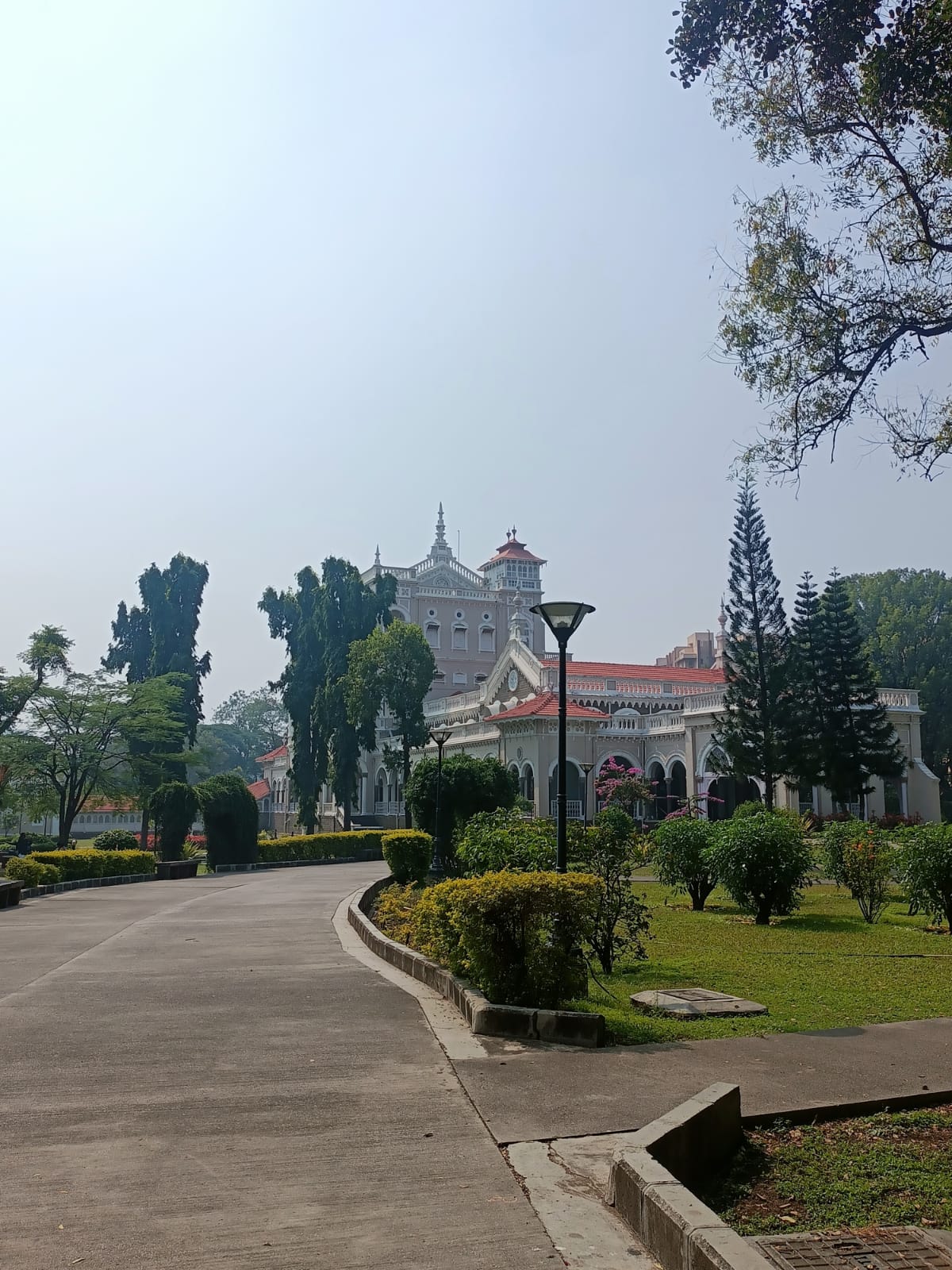
Spanning 19 acres, the palace is surrounded by landscaped gardens and holds significant historical and cultural value. It is best known as the site of Mahatma Gandhi’s imprisonment during the Quit India Movement in 1942. Kasturba Gandhi, his wife, and Mahadev Desai, his secretary, both passed away during their internment here. Their samadhis (memorials), along with one for Gandhi himself, are located within the palace grounds.

In 1969, the palace was donated to the Indian government and subsequently opened to the public. It has since been maintained as a museum, preserving artifacts, photographs, and personal belongings associated with Gandhi and the Indian independence movement. In 2003, it was declared a monument of national importance by the Archaeological Survey of India.

Architecturally, the palace reflects a ‘barrack’ style of architecture with barn-like chambers connected by verandas rather than internal corridors. Its exterior features intricate Indo-Saracenic designs with Victorian and Islamic motifs, while the interiors are more functional, except for the decorative iron arches and cantilevers supporting the roofs.

The northern section houses the main entrance hall and an adjoining porch. The hall features clerestory windows with Gothic tracery, rose windows on the gables, and a cornice supported by corbels and iron arches. The porch is marked by three round arches with ornate capitals and medallions engraved with “H.H.A.K.,” an abbreviation for His Highness the Aga Khan.
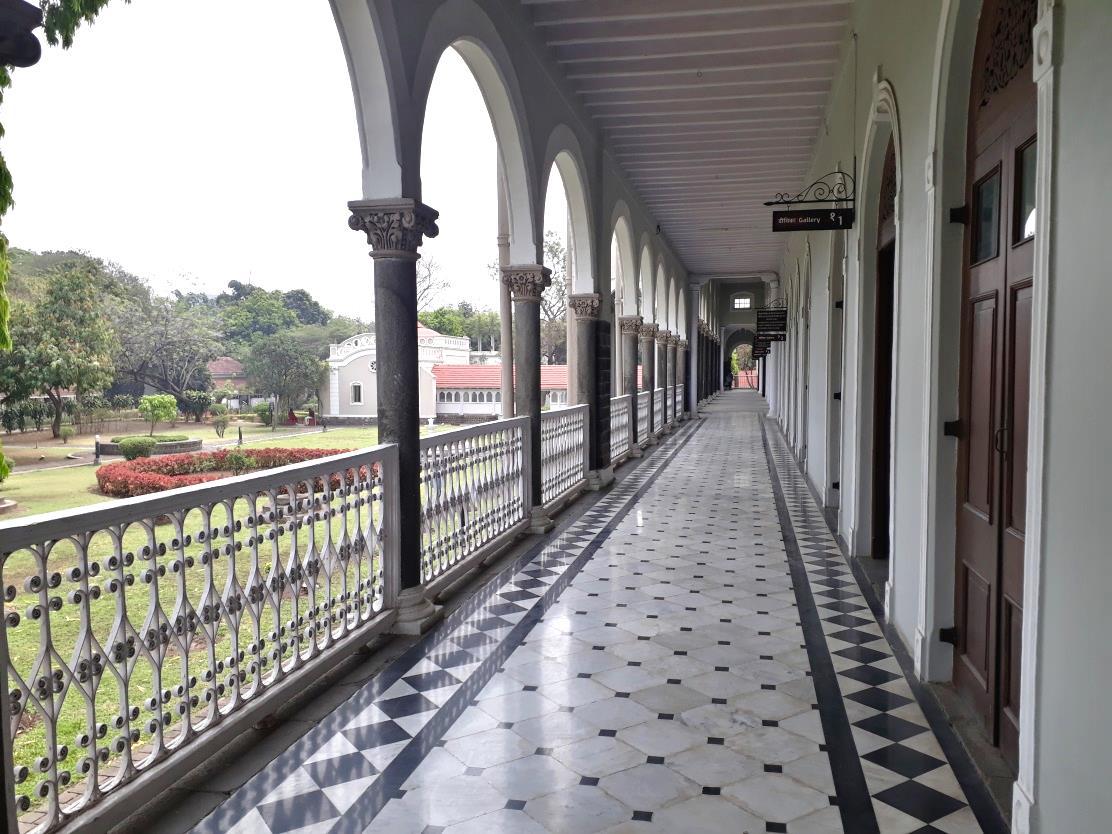
Today, the Aga Khan Palace functions as both a museum and a memorial. Its exhibitions highlight key moments from Gandhi’s life and the broader Indian freedom movement, in many ways, making it a prominent heritage site and a symbol of national history.
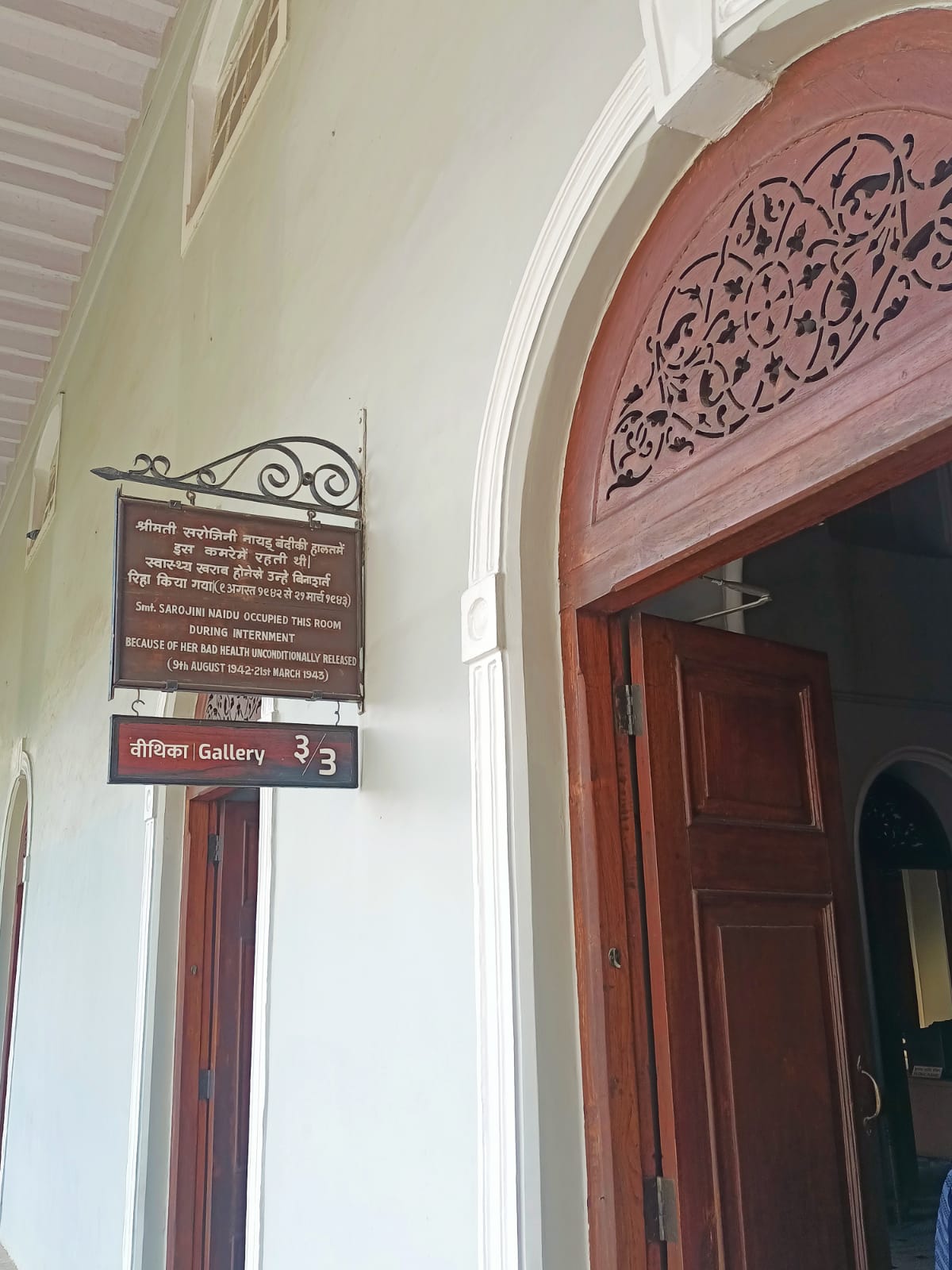

Akra Maruti and Ram Mandir Complex
![Devasthaninside the Ram Mandir, Shukrawar Peth, Pune.[1]](/media/culture/images/maharashtra/pune/cultural-sites/devasthaninside-the-ram-mandir-shukrawar-_pzWvDuR.png)
The Akra (eleven) Maruti Mandir is located in Shukrawar Peth and is said to be constructed in the 18th century by Bapu Gokhale, a Maratha army chief. This Mandir is a Grade II heritage site. While the Mandir is dedicated to Bhagwan Hanuman, it also houses 11 forms of Bhagwan Ganesh.
The Mandir is supported by wooden constructions on all sides with iron pillars, wooden doors, and tinted ceilings. It also houses the first Bhagwan Ganesh murti of the Shri Dagdusheth Halwai Ganpati Mandir which was made in 1893 with paper and sticky jaggery glue.
All Saints’ Church
![All Saints’ Church in Khadki, Pune that features black stone walls and a red sandstone roof.[2]](/media/culture/images/maharashtra/pune/cultural-sites/all-saints-church-in-khadki-pune-that-fea_GZgrcfR.png)
The All Saints’ Church is located in Khadki, Pune. It was consecrated by Bishop Thomas Carr in 1837, when it was initially built as a small chapel. However, in 1944 the chapel was enlarged due to an increase in worshippers and the present day church was constructed in 1866. The maintenance of the church was funded by the Crown and it was converted into a garrison church for soldiers stationed at Khadki.
The entire church is built of black stone and follows Gothic architecture of red roof and stained glass windows. These windows are the main attraction point of the church and were imported from Belgium during the British Raj. The red sandstone for the roof of the church was sourced from Rajasthan, while, the bell was brought over from England.
Anandashram Sanstha
The Anandashram Sanstha, located at Appa Balwant Chowk in Pune, was founded in 1887 by Mahadevrao Chimanaji Apte, a distinguished high court lawyer and scholar deeply devoted to Sanskrit learning. The institution is dedicated to the preservation, teaching, and publication of Sanskrit texts, and has played a vital role in promoting Indian philosophical, literary, and scriptural traditions.
One of its most significant contributions is the Anandashram Sanskrit Series (Anandashram Samskrita Granthavali), a landmark scholarly project that ran from 1888 to 1942. This collection comprises 144 meticulously edited volumes of rare Sanskrit texts, including works from the Vedasamhitas, Aranyakas, Brahmanas, Upanishads, Srautasutras, Grhyasutras, Mimasa, and Puranas. The series is widely respected for its textual accuracy and contribution to Sanskrit scholarship.
![Front view of the Ashram in the Sanstha, Bajirao Road, Pune.[3]](/media/culture/images/maharashtra/pune/cultural-sites/front-view-of-the-ashram-in-the-sanstha-b_YBfyxkv.png)
The institution is housed in a traditional wada-style building with a central courtyard. The campus includes a Sanskrit library, administrative offices, and a hostel for students. The library holds a collection of approximately 1,500 Sanskrit manuscripts, including rare texts. Among these, the oldest manuscript is the Jyotisaratnamala, dated to 1449 CE.
A peculiar aspect when it comes to architecture lies in the architectural and spatial arrangement of the place. Notably, the building was designed with a Shiv Mandir on the upper floor, positioned directly above the samadhi of Mahadevrao Apte. The structure allows water from the daily abhisheka (ritual bathing) of the Shivling to flow downward and symbolically anoint his resting place, linking daily worship with remembrance and reverence for the founder.
Aryabhushan Bhavan
![Entrance of the Aryabhushan Press, FC Road, Pune.[4]](/media/culture/images/maharashtra/pune/cultural-sites/entrance-of-the-aryabhushan-press-fc-road_tw3uzAH.png)
The Aryabhushan Press, a historic building on Fergusson College Road, was founded by social reformer Vishnushastri Chiplunkar in 1879. Aryabhushan Bhavan is one of the oldest press companies in India and the well-known Kesari newspaper was first printed here. When Aryabhushan Press was first established, it had a copper- and ivory-covered hall at Morobadada Phadnis Wada in Budhwar Peth. In the first two decades of the 20th century, the press was moved to its current location.
In a fire that damaged the press in 1926, N.R. Phatak's unpublished biography of G.K. Gokhale was among the materials that were lost. The building was renovated and inaugurated in 1928, and was renamed as the Printing Press and Publishing House of Servants of India Society. Until recently, the building housed offices of the Maharashtra Sahakari Mudranalaya (Printing Press).
Ashtabhuja Mandir
![Garbhagriha (sanctum) of the Ashtabhuja Mandir, Shaniwar Peth, Pune.[5]](/media/culture/images/maharashtra/pune/cultural-sites/garbhagriha-sanctum-of-the-ashtabhuja-man_n0DbkZ0.png)
The Ashtabhuja Mandir was established in the early 19th century by Chintamani Shet Diwekar in Shaniwar Peth. It is dedicated to an eight-armed form of Devi Durga, called Ashtabhuja. This Devi is also believed to be the kuldevi of the Daivadnya Brahmin community hailing from Konkani and Goan regions. This community is popularly known for handcrafting jewellery for Bhagwans in various mandirs.
Ashtabhuja durga is represented with eight arms holding various objects such as a lotus, conch, trident, and a sword, and riding a lion. Each of the objects represent a trait of the Devi. Due to its unique characteristics, PMC has deemed it a Grade II Heritage Site.
Balaji Mandir
Balaji Mandir, located on Sus Road in Pune City, was established by the Ahobila Mutt, a religious institution with origins in Andhra Pradesh. The Mandir is dedicated to Shri Venkateshwara (Balaji), and follows traditional South Indian Mandir architecture inspired from the famous Tirumala Tirupati Balaji Mandir.
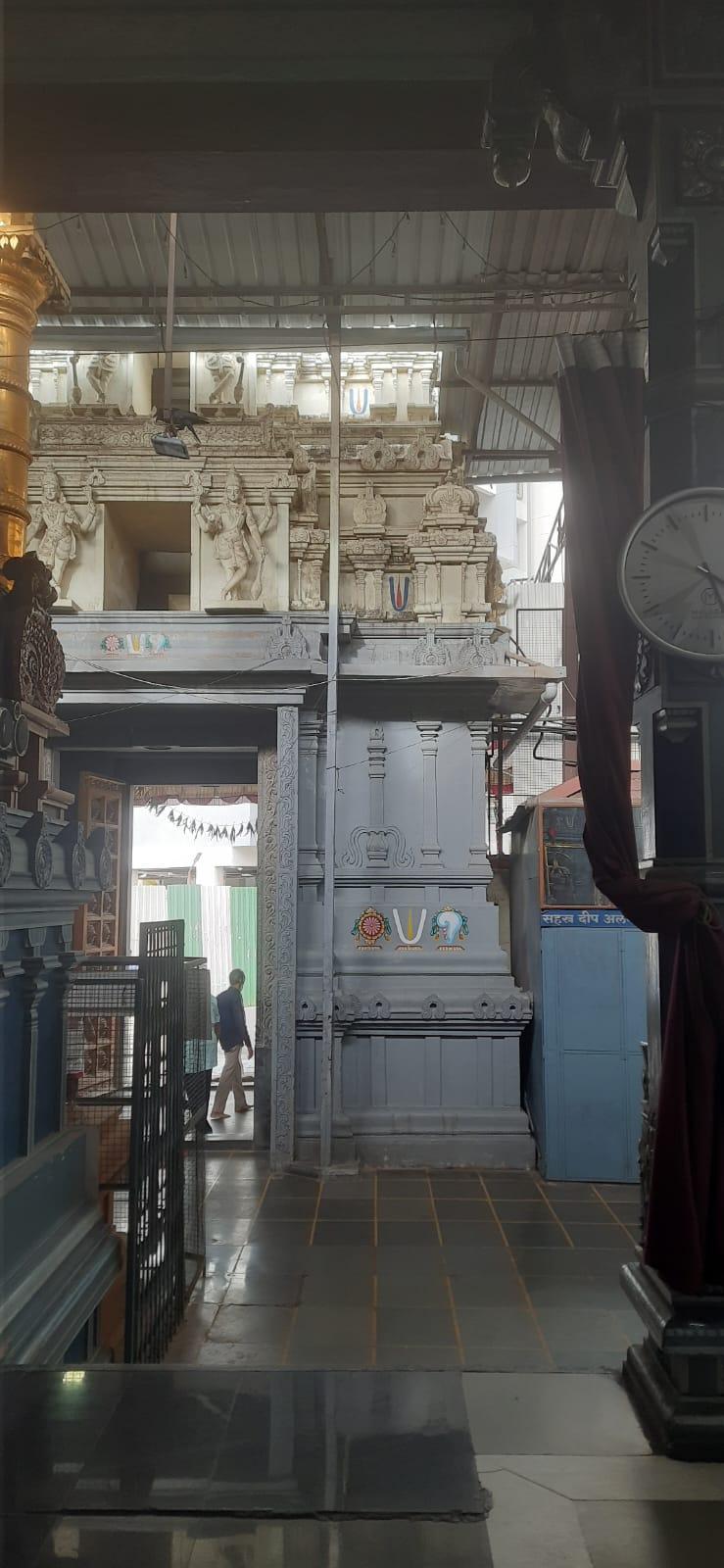
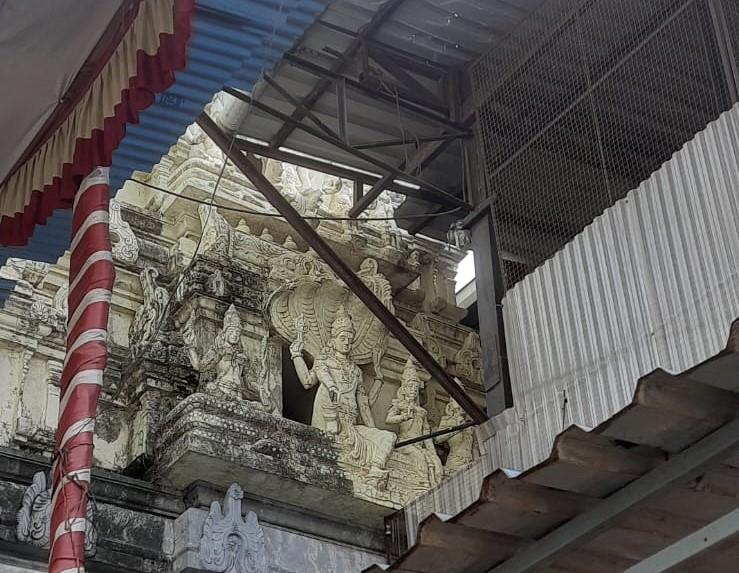
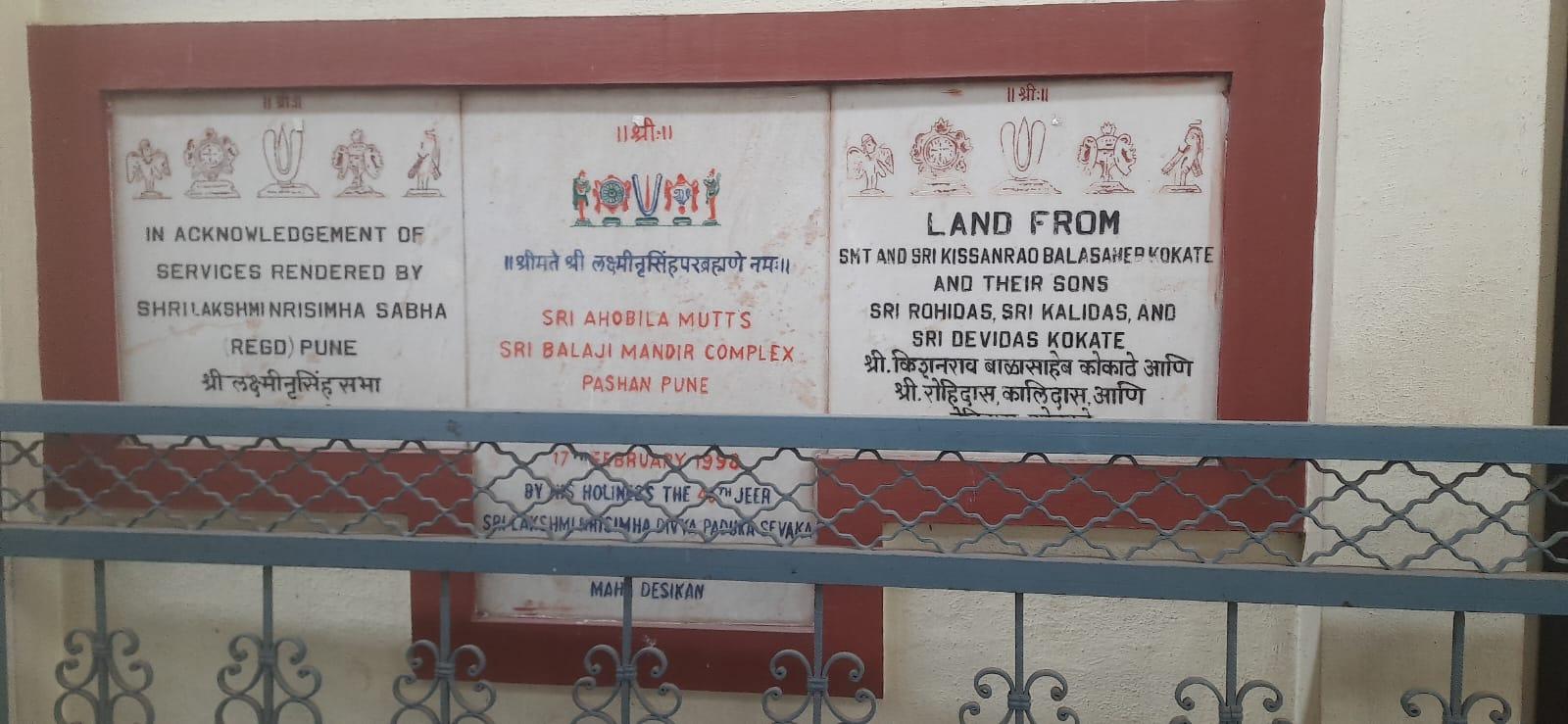
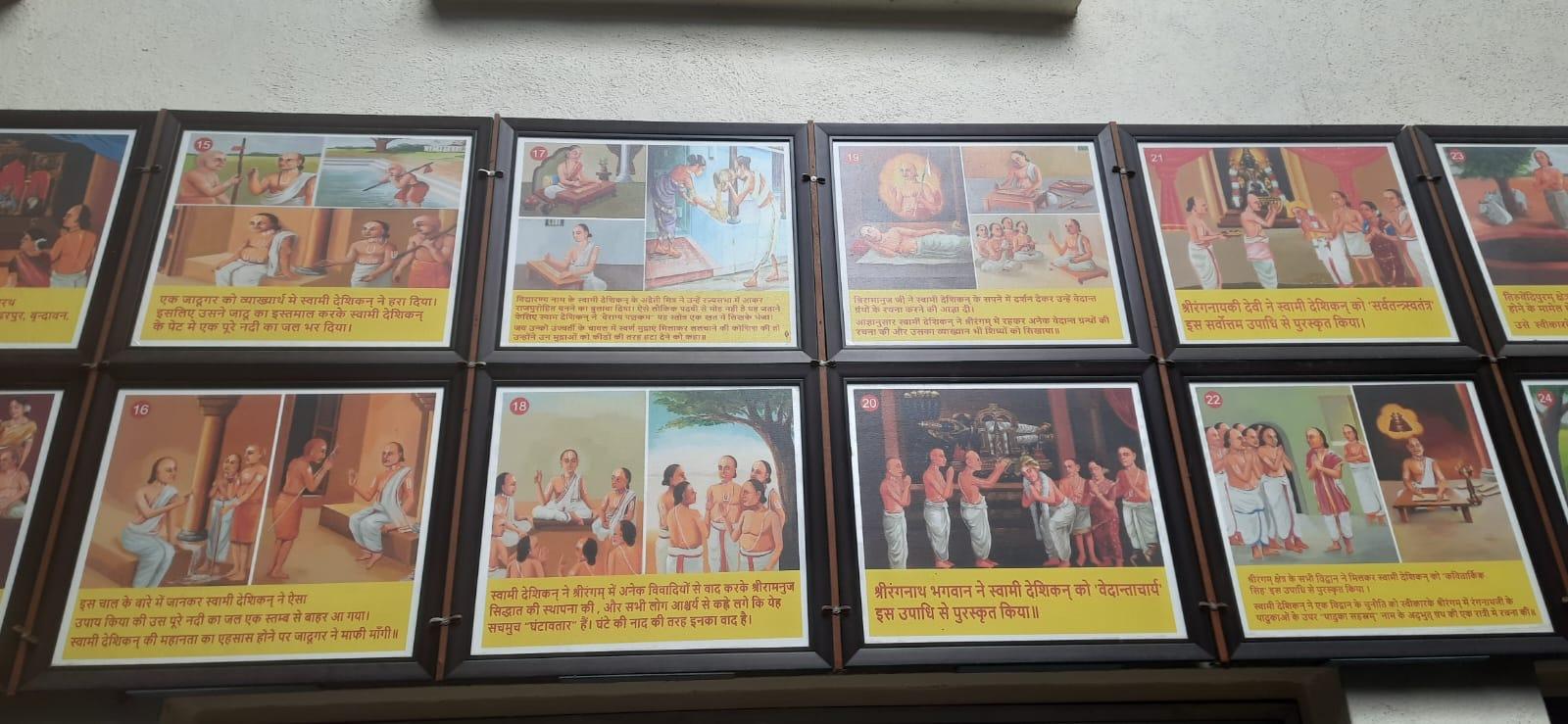
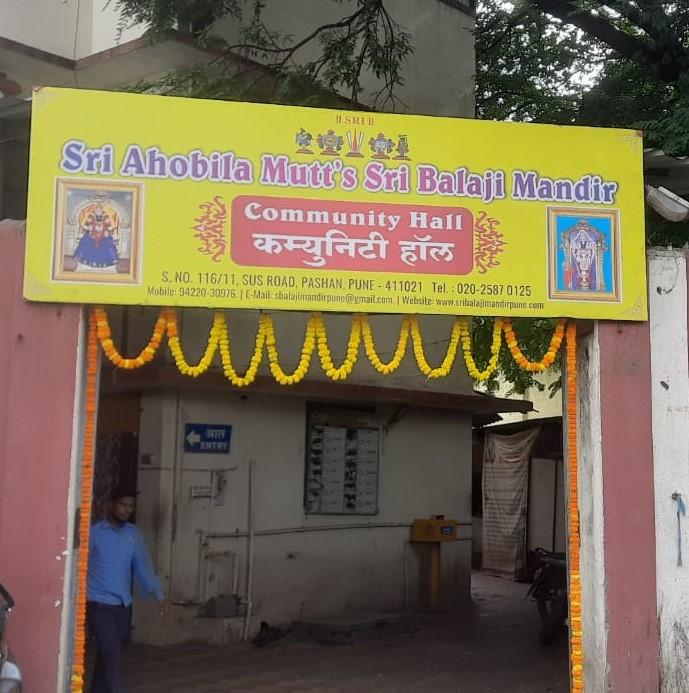
Baneshwar Cave
Baneshwar Cave is located on Tukai Mata Hill along the route to Baner Gaon in Pune City. The name “Baneshwar” is another designation for Shankar (Bhagwan Shiv). The caves are believed to be over 5,000 years old, with some legends suggesting that the Pandavas visited during their exile.
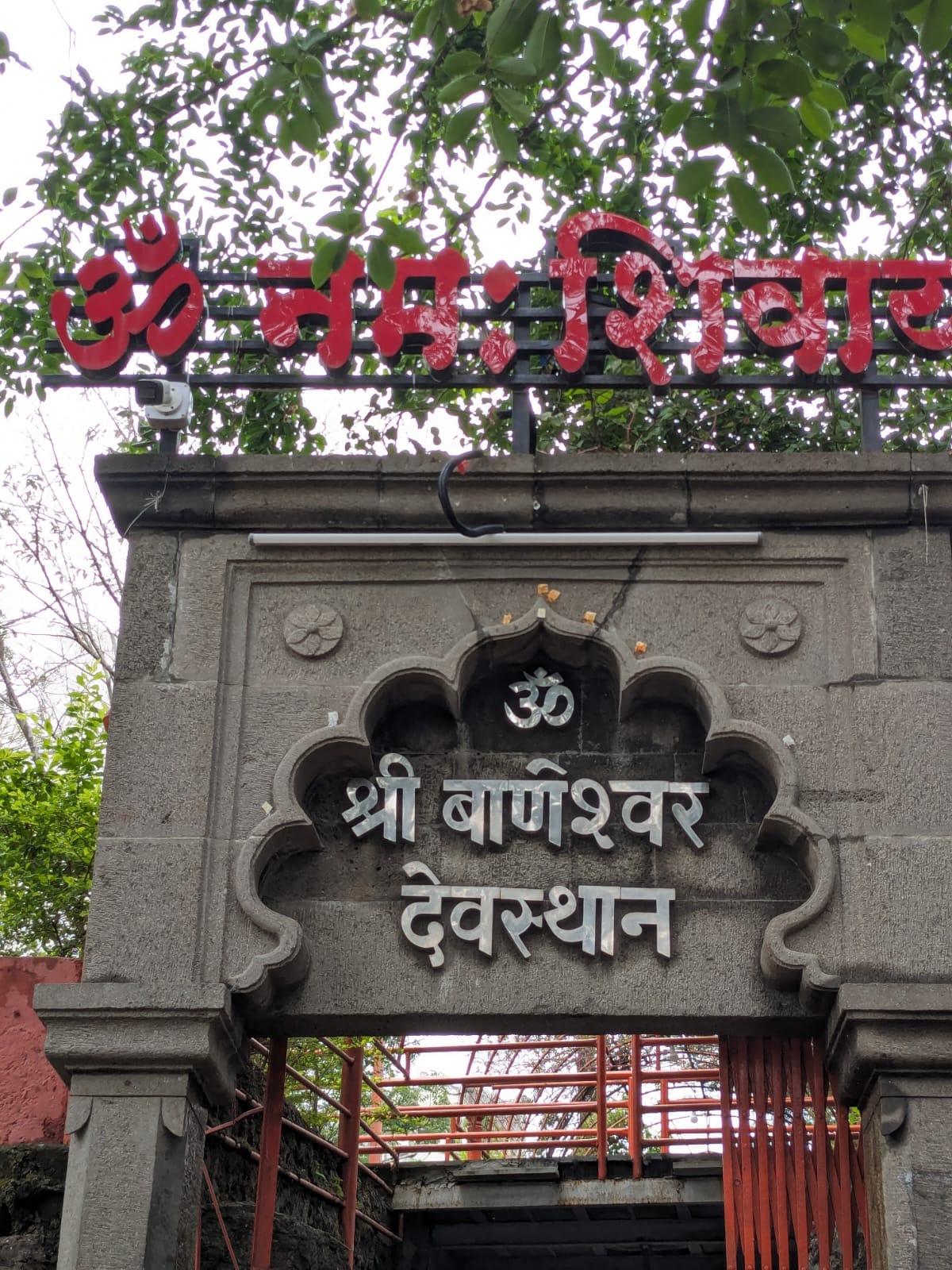
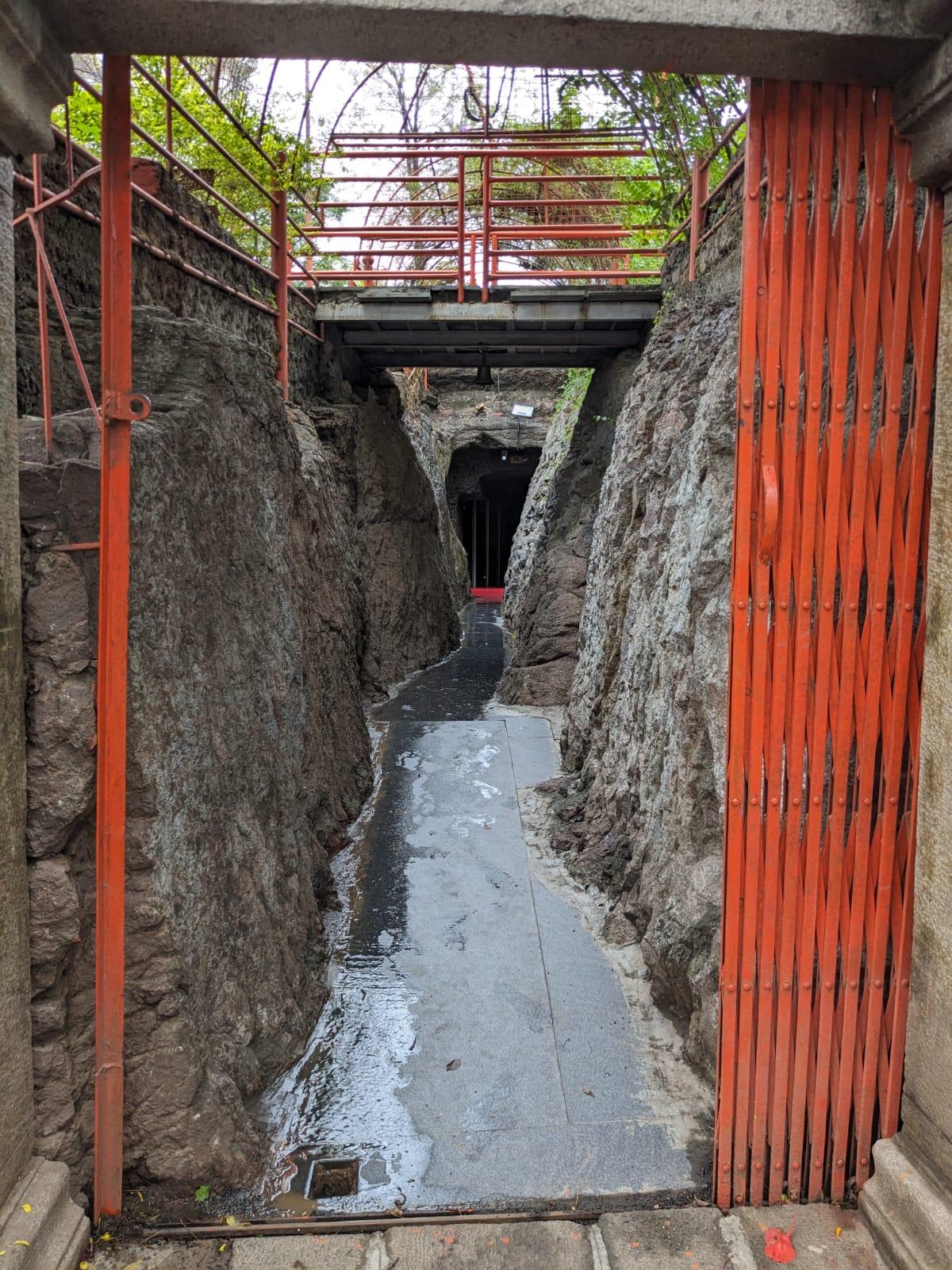
There are, interestingly, many veergals (hero stones) that lie within the caves. They are estimated to be around 700 to 800 years old, however, they are currently in poor condition. These stones depict scenes of warriors in battle, praying to Bhagwan Shiv, and ultimately entering Swarg (Heaven).
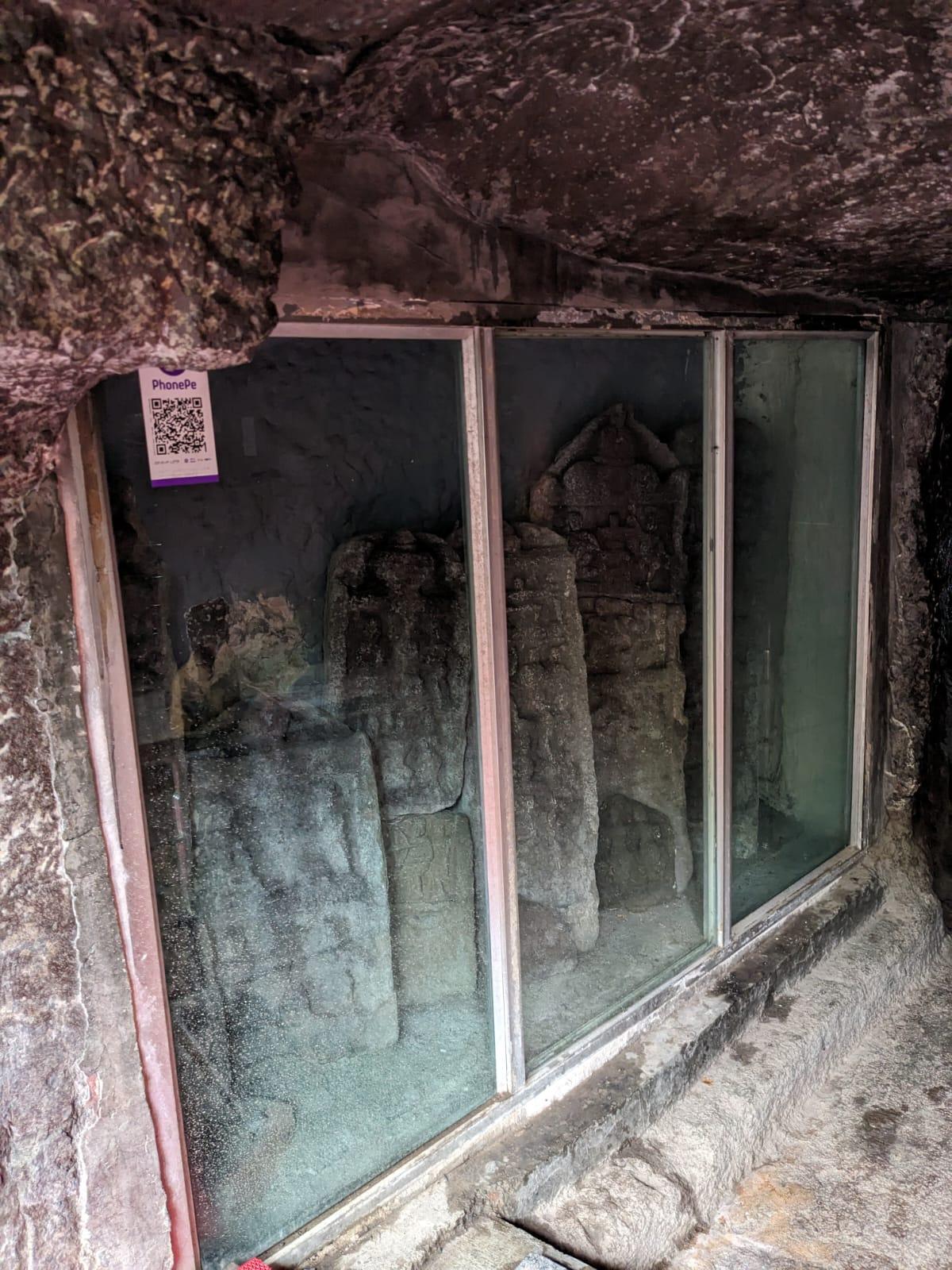
The cave lies along the path to the Tukai Mata Mandir, and those heading uphill from Baner often pass through it. Many visitors pause here for quiet reflection or simply to listen to the sound of flowing water before continuing their journey.
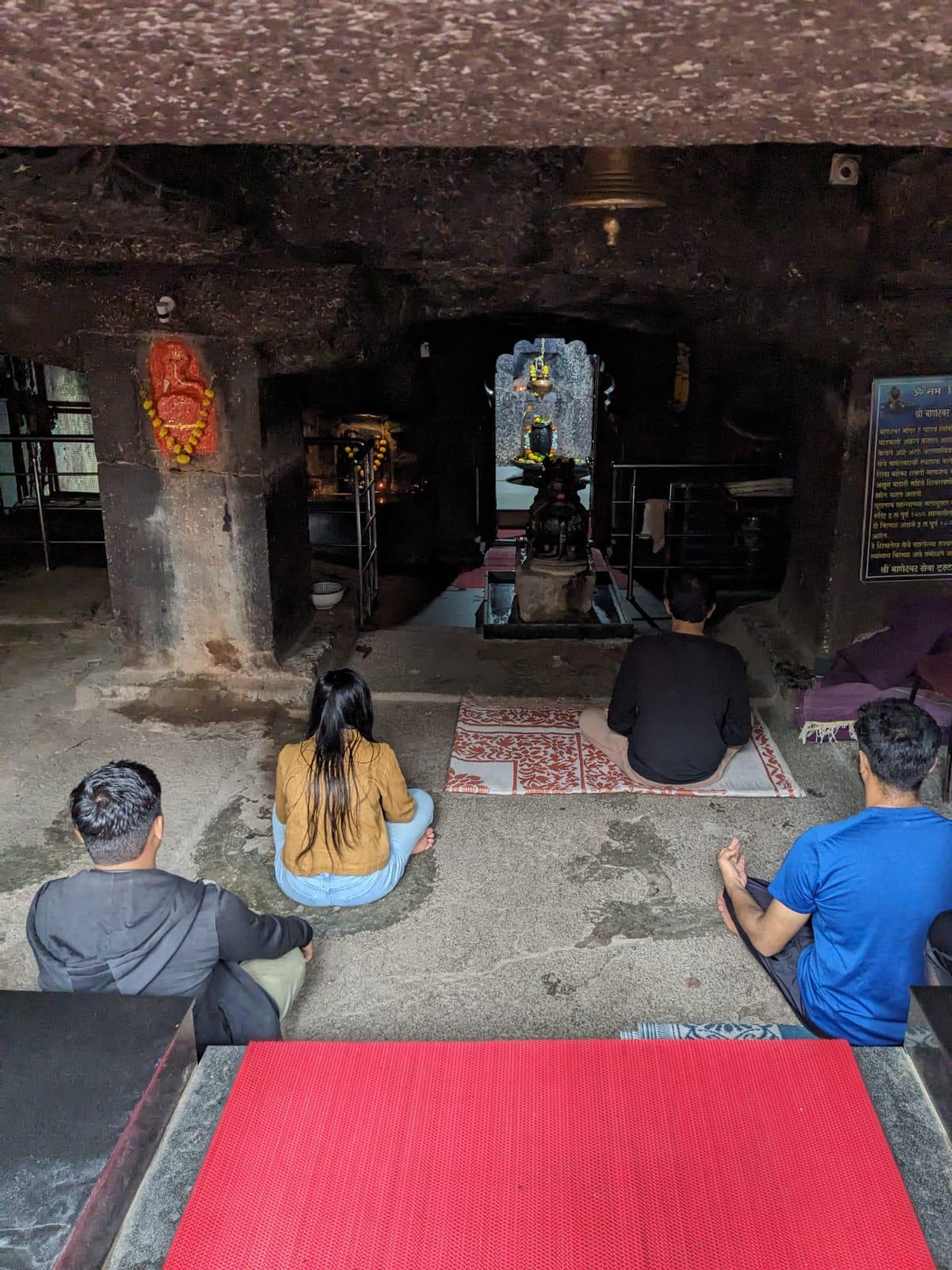
Bedse Caves
The Bedse Caves, located in the Maval taluka of Pune district, are believed to have been built in the 1st century BCE during the Satavahana reign. The caves are located at a significant height, requiring visitors to climb around 400 steps to reach them. These caves serve as a significant turning point in the evolution of Buddhist cave architecture in India. At Bedse, there are several caves but only two out of these are still intact.
![Chaityagriha (prayer hall) inside the Bedse Caves, Maval taluka, Pune district.[6]](/media/culture/images/maharashtra/pune/cultural-sites/chaityagriha-prayer-hall-inside-the-bedse_CcRu0Mv.png)
The most unique feature of the Chaitya cave is the large stupa outside. The doorway arch has beautiful floral carvings. A long, narrow corridor leads to the main rock. Four pillars, carved with animals, stand inside while the side walls have chandrashala designs. The Vihara (monastic dwelling) also has a similar structure to the Chaitya cave.
The rainy season is ideal for travellers to explore these caves because waterfalls may be observed then. Bedse is an essential part of the cave trio in the Maval region, along with Karla and Bhaje, making the set incomplete without it.
Bhaja Caves
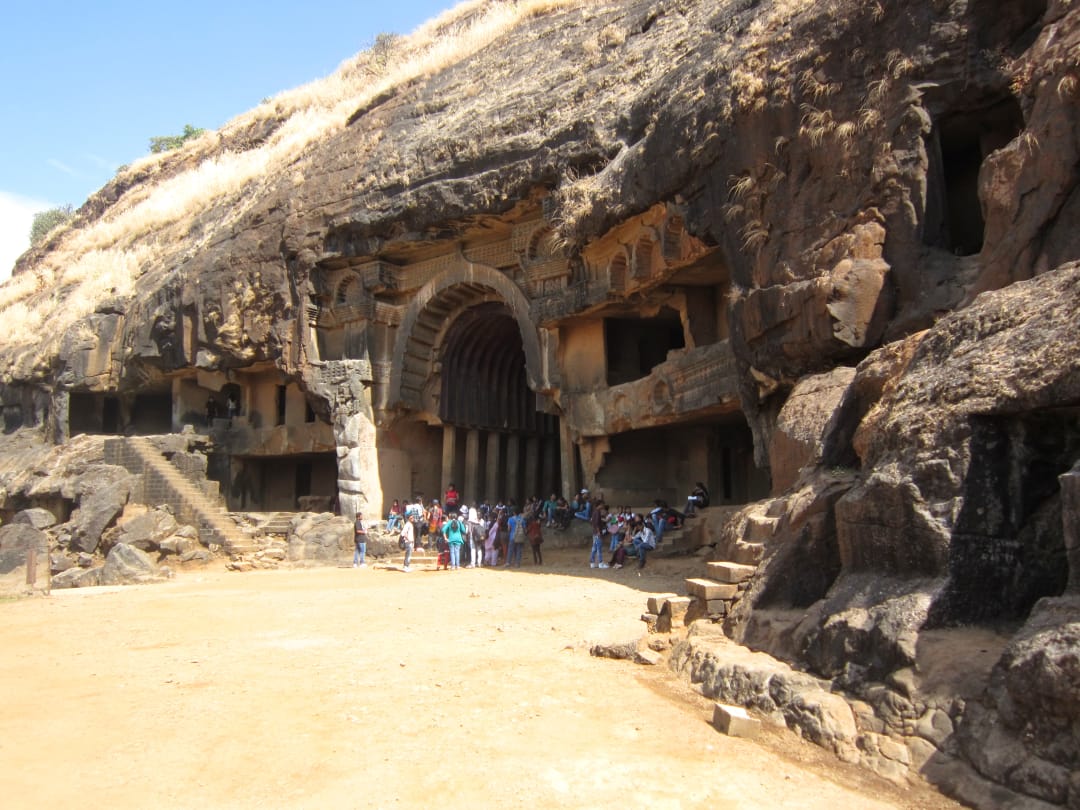
The Bhaja Caves are a group of 22 rock-cut caves located in the village of Bhaja, dating back to the 2nd century BCE. Positioned around 400 ft. above the village, the caves lie along an ancient trade route that once connected the Arabian Sea to the Deccan Plateau. These caves are among the earliest Buddhist monuments in Maharashtra and are protected as a Monument of National Importance by the Archaeological Survey of India. One of their most striking features is the large number of stupas found within the complex.
The most prominent structure at Bhaja is the chaityagriha, notable for its distinctive horseshoe-shaped entrance. Inside, one can find early carvings of the Buddha, while reliefs on the walls of other caves offer glimpses into the period's cultural and artistic practices. Local accounts suggest that one of the carvings depicts a tabla-like instrument, believed to have been introduced by Turkic or Arab travelers highlighting possible cultural exchanges.
A unique aspect of the site is a cluster of 14 stupas - five located inside a cave and nine placed outside along a rough excavation. Some of these stupas bear inscriptions, including the names and titles of monks who passed away at Bhaja. One such inscription reads "Stavirana Bhadanta," meaning "the venerable reverend," offering insight into the individuals who once lived and practiced at the site.
Bharat Itihas Sanshodhak Mandal
The Bharat Itihas Sanshodhak Mandal (BISM) is a historical research institution based in Pune, dedicated to the study and preservation of Indian history, with a particular focus on the Maratha period. It was founded on 7 July 1910 by historians Vishwanath Kashinath Rajwade and Sardar Khanderao D. Mehendale, with the aim of promoting scientific and critical approaches to the study of Indian historical sources.
![The anterior of Bharat Itihas Sanshodhak Mandal at Sadashiv Peth, Pune.[7]](/media/culture/images/maharashtra/pune/cultural-sites/the-anterior-of-bharat-itihas-sanshodhak-_90e59ls.jpg)
Initially housed in Mehendale’s residence at Appa Balwant Chowk, the Mandal later moved to its present location in Sadashiv Peth. The current premises include Rajwade Hall, a heritage structure recognized by the Pune Municipal Corporation, and Potdar Hall, named after the Mandal’s first secretary Datto Vaman Potdar. The campus also contains the Khare Museum, established in recognition of historian Dr. G.H. Khare, who contributed to the institution for nearly five decades.
In 1935, it hosted an All India Congress to mark its silver jubilee, an event that later contributed to the formation of the Indian History Congress.
![The interiors of the BISM, particularly the Rajwade Hall.[8]](/media/culture/images/maharashtra/pune/cultural-sites/the-interiors-of-the-bism-particularly-th_FyfknOz.jpg)
BISM is home to an extensive collection of historical resources, including documents, manuscripts, coins, copper plates, sculptures, arms, rare books, and early Marathi newspapers. Its archives also feature maps, including rare maritime ones, and an impressive gallery of approximately 1,200-1,500 watercolour paintings, of which 130 are displayed in Pune’s Chitrashala Gallery. Among its treasured collections is a 13th century Persian poetic composition titled Gulistan, alongside treatises on Ayurveda, horoscopes, agricultural science, and various fields of science.
The Mandal continues to serve as a research center for scholars both in India and abroad, including from countries such as the United States, Russia, and Belgium. Its facilities include a library, research sections, and a conservation laboratory. Marathi is the primary language used for instruction and publication.
Bhimashankar Mandir
Bhimashankar Mandir is located in the Khed taluka of Pune district, approximately 110 km from the city. It is considered one of the twelve Jyotirlingas of Bhagwan Shiv and is a significant site in both regional and broader Shaiva traditions.
![Bhimashankar Mandir in Khed taluka, Pune district. The Mandir is located in the Sahyadri hills, approximately 110 km from Pune, and is considered one of the twelve Jyotirlingas of Bhagwan Shiv.[9]](/media/culture/images/maharashtra/pune/cultural-sites/bhimashankar-mandir-in-khed-taluka-pune-d_iAwi6Cj.png)
According to local tradition, Bhimashankar Mandir is over a thousand years old. One legend associated with the site is recorded by M.S. Mate (1962) and centres around Tripura, a powerful asur who is said to have performed intense penance and pleased Bhagwan Brahma. In return, Brahma granted him three boons: (i) invulnerability against bhagwans, yakshas (nature-spirits or guardians of treasure), and gandharvas (celestial musicians); (ii) indestructible fortresses; and (iii) the ability to travel freely across the universe.
Armed with these powers, Tripura set out to conquer the three worlds (Lokas) and eventually defeated Indra, ruler of the heavens. In response, Indra turned to Bhagwan Shiv through deep penance. Shiv vowed to destroy Tripura, restoring cosmic balance. Notably, it is widely believed that this event took place at Bhimashankar, giving the site its cultural and historical significance.
The Mandir is built in the Nagara architectural style, with later additions reflecting different periods of patronage. The sabhamandap (assembly hall) was added in the 18th century by Nana Phadnavis during the Peshwa era. A large Portuguese bell, currently placed at the front of the complex, is attributed to Chimaji Appa (brother of Bajirao I), and is believed to have been brought from Vasai as a war trophy after the 1739 battle (referring to the Maratha siege and capture of the Portuguese-held fort at Vasai, then known as Bassein, during a campaign to push European colonial powers out of the Konkan coast).
Brother Deshpande Memorial Church
![Brother Deshpande Memorial Church, Kasba Peth, Pune.[10]](/media/culture/images/maharashtra/pune/cultural-sites/brother-deshpande-memorial-church-kasba-p_2auhhcf.png)
The Brother Deshpande Church is a Protestant church which is located in Kasba Peth, Pune. It is named after Ramchandra Pralhad Deshpande and is believed to have been constructed around 1960. In 1917, he arrived in Pune and joined the Christ Church where he learnt more about precepts of Christ. He also participated in various social upliftment programs initiated by the church.
Christianity was relatively new to many residents in the city, and there was some hesitation or skepticism about its teachings. Deshpande is widely credited with helping bridge the gap between orthodox Hindus and Christians. By explaining the basic tenets of Christianity in a simple and accessible way, he helped foster greater understanding and acceptance among locals.
Deshpande passed away in 1949. Subsequently, the members of the Christ Church converted an old structure in Kasba Peth and named it Brother Deshpande Memorial Church. What sets this church apart is its unexpected link to the Korean Christian community. The Sunday Mass is read out in Korean, a result of the Church being a significant place of worship for the community in the past.
Buddha Statue
A large Buddha statue has been installed atop a hill overlooking the Mumbai–Bangalore Highway, near Pune. The site is relatively new and is intended to represent Gautama Buddha’s moment of enlightenment, facing the city in a gesture of peace and contemplation. Although still under development, the site has gained popularity among both devotees and casual visitors.
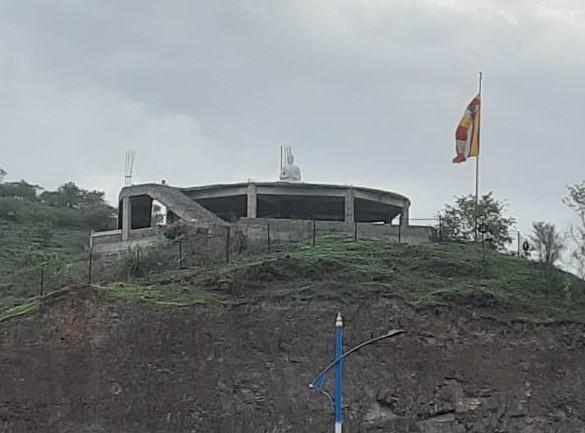

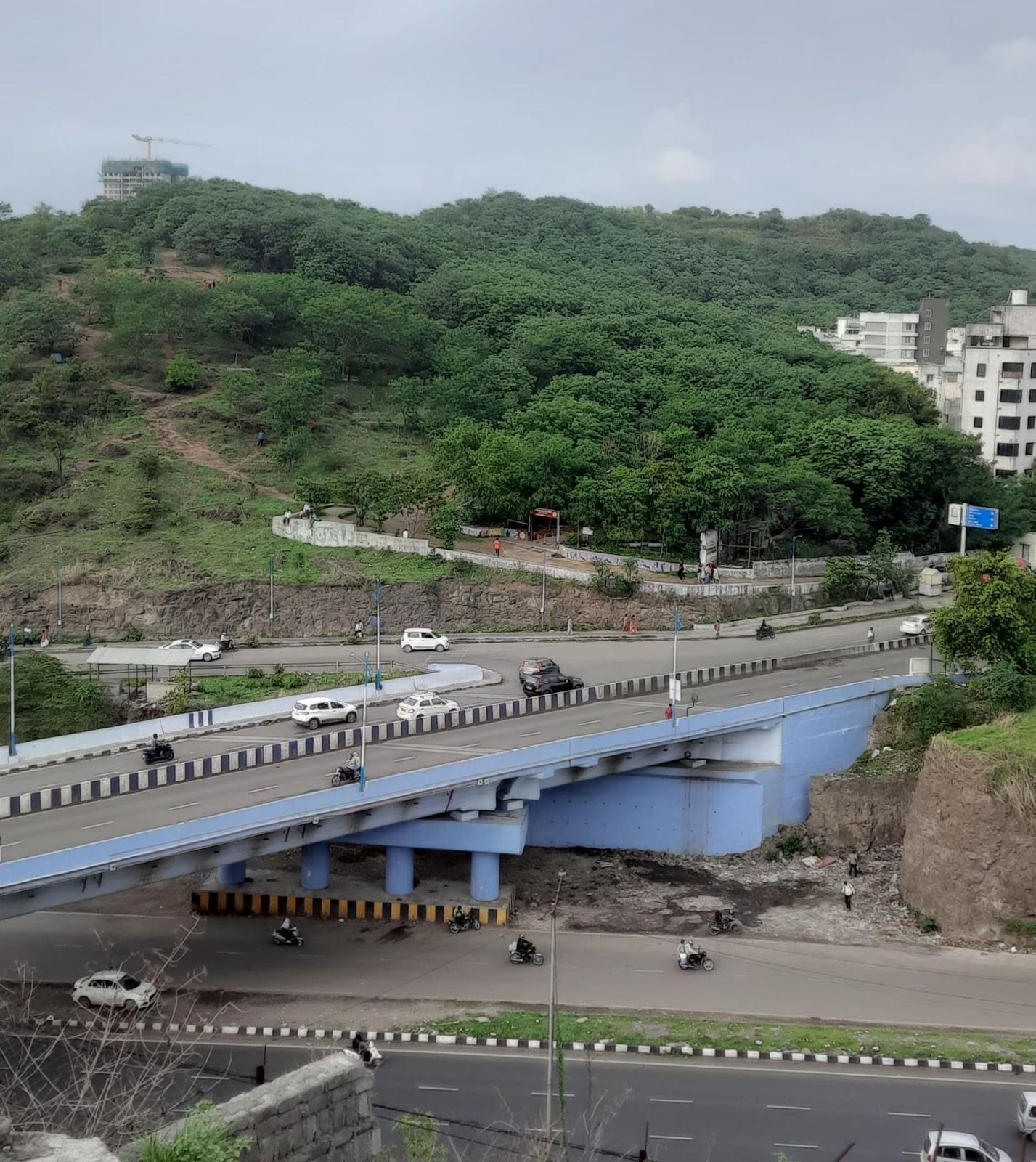

Chapekar Wada Museum
Chapekar Wada Museum is a historical museum located in Pimpri-Chinchwad. It is situated in the Chapekar Wada, the former residence of Damodar, Balkrishna, and Vasudev Chapekar, who were known for their revolutionary activities against British colonial rule in the late 19th century.
![Front view of theChapekarWada-Museum in Pimpri-Chinchwad, Pune[11]](/media/culture/images/maharashtra/pune/cultural-sites/front-view-of-thechapekarwada-museum-in-p_Zbbs42w.png)
The Chapekar brothers gained national attention following the assassination of British official W. C. Rand in 1897, an act carried out in protest against the colonial administration’s handling of the plague in Pune. The incident marked one of the early instances of armed resistance against British rule in India and led to increased repression of revolutionary groups by colonial authorities.
The museum was established in 2005 by the Pimpri Chinchwad Municipal Corporation in collaboration with the Chapekar Smarak Samiti. It was created to document the activities of the Chapekar brothers and their place within the broader context of the Indian independence movement.
In addition to materials related to the Chapekar brothers, the museum includes exhibits on other figures from Maharashtra associated with the nationalist movement, such as Bal Gangadhar Tilak, Vasudev Balwant Phadke, and Gopal Krishna Gokhale. The collection includes weapons, personal belongings, and historical documents. Subsequent renovations added a research centre and expanded the range of exhibits to include digital and interactive displays. These additions were intended to provide visitors with further historical context and access to primary source material.
Chavand Fort
Chavand Fort, a dismantled and ruined fortress, is located ten miles southeast of the Naneghat Pass and west of Junnar, near the Manikdoh Dam. Alongside Hadsar, Jivdhan, and Shivneri forts, Chavand once played a crucial role in guarding the Naneghat Pass, facilitating secure communication between Junnar and the Konkan region. The fort’s natural defences were its main strength, as its artificial fortifications were destroyed, and its access routes were blown up around 1820. Today, the hill on which the fort stands is largely inaccessible except to locals.
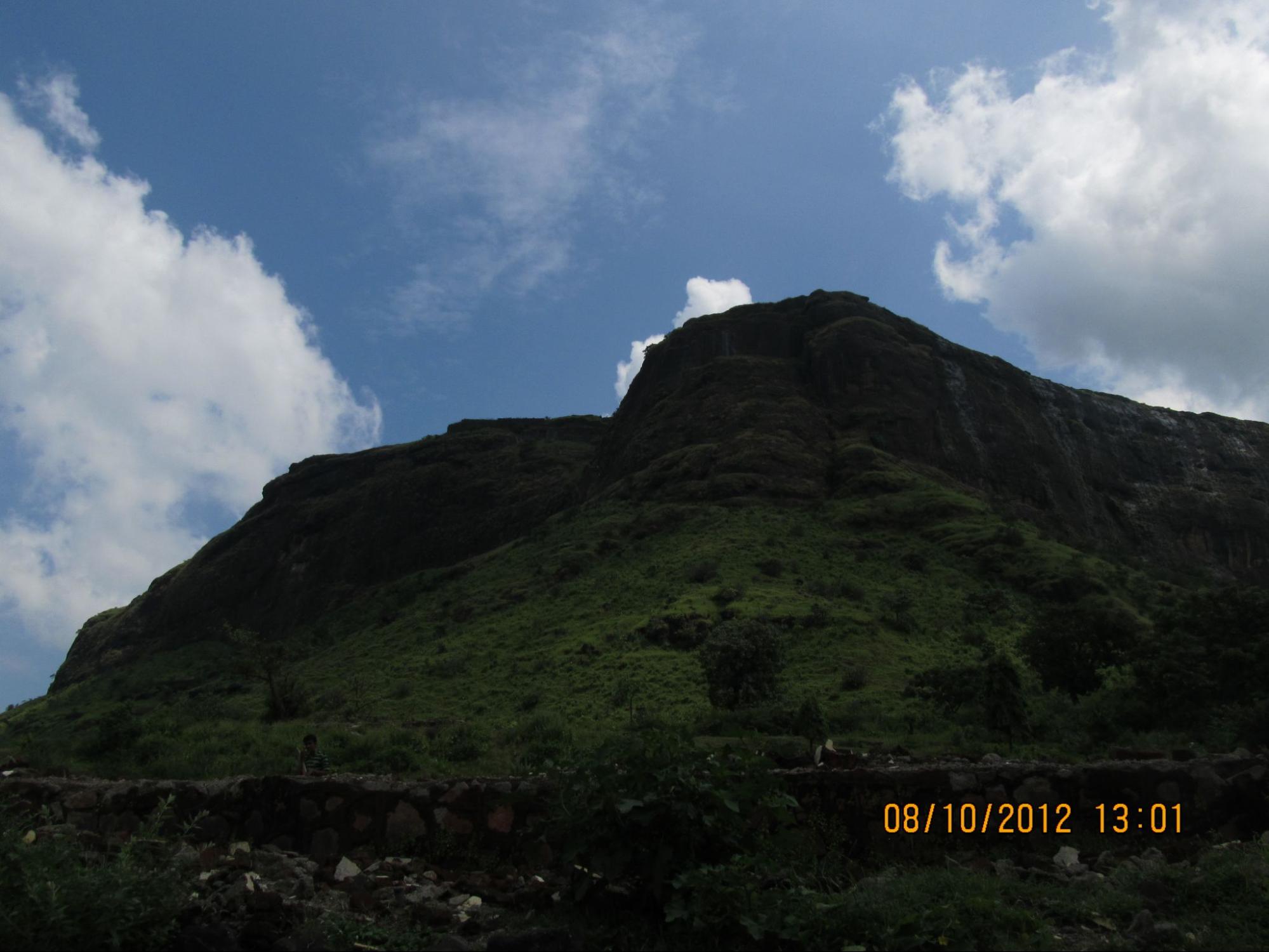
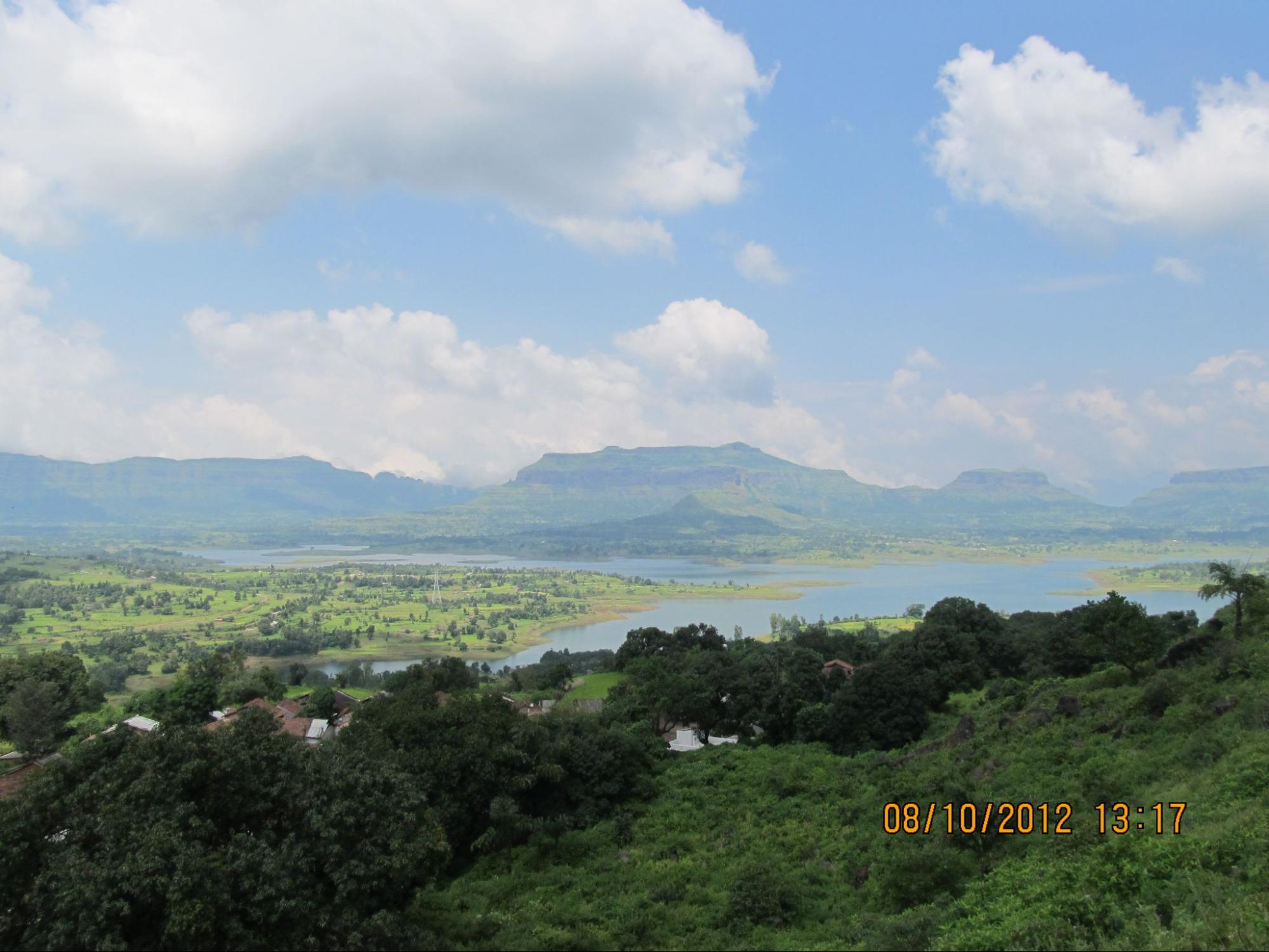
Chavand Fort has a rich and complex history, marked by control under multiple rulers. It is noted in the district Gazetteer (1954) that, in 1486, the fort was captured by Malik Ahmad and became part of the Bahmani Empire. Later, in 1594, the fort was used to confine Bahadur, the infant son of Burhan Nizam II. By 1637, Shahaji Raje Bhonsale, the father of Shivaji Maharaj, handed the fort over to the Mughals as part of a treaty. During the Maratha era, Shivaji renamed the fort ‘Prasannagad’, and it was also referred to as ‘Junnd’. Eventually, in 1818, following the Anglo-Maratha Wars, the fort surrendered to the British.
At the summit of the fort stands the Chamunda Devi Mandir, believed to be the origin of the fort’s name. The murti of the Devi is believed to have been installed by Mysore traders who used the Naneghat route.

A significant structure within the fort is the Saptamatrika tank, a water reservoir divided into seven sections, each named after one of the Saptamatrikas, a group of seven Matrikas or Devis in Hindu tradition: Brahmani, Maheshwari, Kaumari, Vaishnavi, Varahi, Indrani, and Chamunda.

Remains of a structure called Pushkarini, believed to have been a Mahadev Mandir, can also be found on the fort. Local lore suggests it was destroyed by the British in the 18th century. A man-made cave on the fort’s north side is believed to have been used for grain storage and is referred to locally as ‘kothar’ or ‘kothi’.
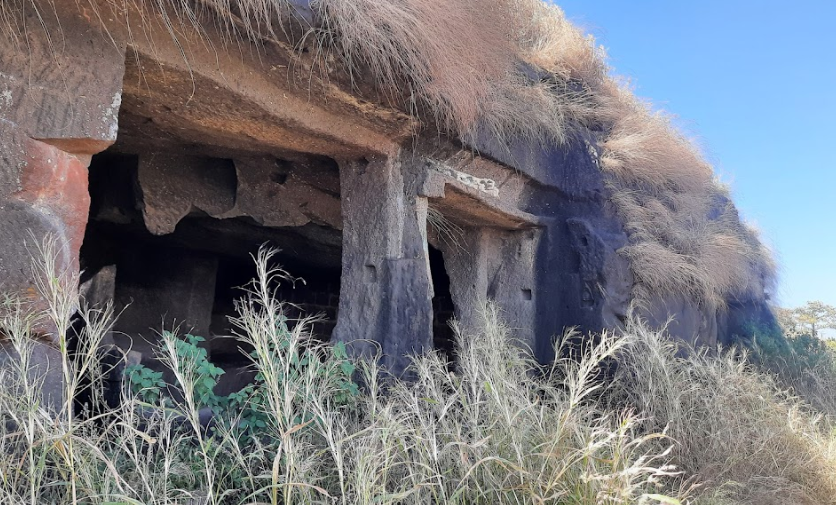
Church of the Holy Name of Panch-Haud
The Church of the Holy Name, located in Guruwar Peth, Pune, was established in 1870 and is affiliated with the Anglican tradition of Christianity. Its foundation is associated with Bishop Louis George Mylne of Bombay, who purchased a traditional house in Guruwar Peth that year. The site is said to have been constructed near five water tanks, referred to locally as panch haud, which influenced the naming of the church.
![The entrance to the Church of Holy Name, Guruwar Peth, Pune.[12]](/media/culture/images/maharashtra/pune/cultural-sites/the-entrance-to-the-church-of-holy-name-g_vDGYCrV.png)
The Church of the Holy Name was built during the late 19th-century plague epidemic, a time that saw widespread devastation in Pune. The associated mission not only managed the church itself but also ran additional facilities, including a shelter for children orphaned during the epidemic.
Architecturally, the church follows the form of a Roman basilica. It is constructed primarily of red bricks, interspersed with decorative bands of yellow and blue. A prominent feature of the structure is its 130 ft. tall bell tower, modelled after London’s Big Ben.
![The Bell Tower of the Church, with wooden planks instead of clocks.[13]](/media/culture/images/maharashtra/pune/cultural-sites/the-bell-tower-of-the-church-with-wooden-_TXyxjJV.png)
The bell tower is opened to the public on Christmas Eve and houses eight bells, each inscribed with the phrase “Holy Name of Jesus.” These bells chime four times a day on important occasions such as Easter, Independence Day, Republic Day, Christmas, New Year’s Eve, and New Year’s Day.
Dagdi Nagoba Mandir
Dagdi Nagoba Mandir is a historic religious site located in Ganesh Peth, in close proximity to the Sant Devjibaba Samadhi Devasthan. The Mandir is notable for its black stone representations of Nagas (male serpents) and Naagins (female serpents), which are central to the worship practices at the site. People from neighboring areas such as Ganesh Peth, Kasba Peth, and Raviwar Peth visit the Mandir regularly to offer prayers and maintain long-standing traditions.
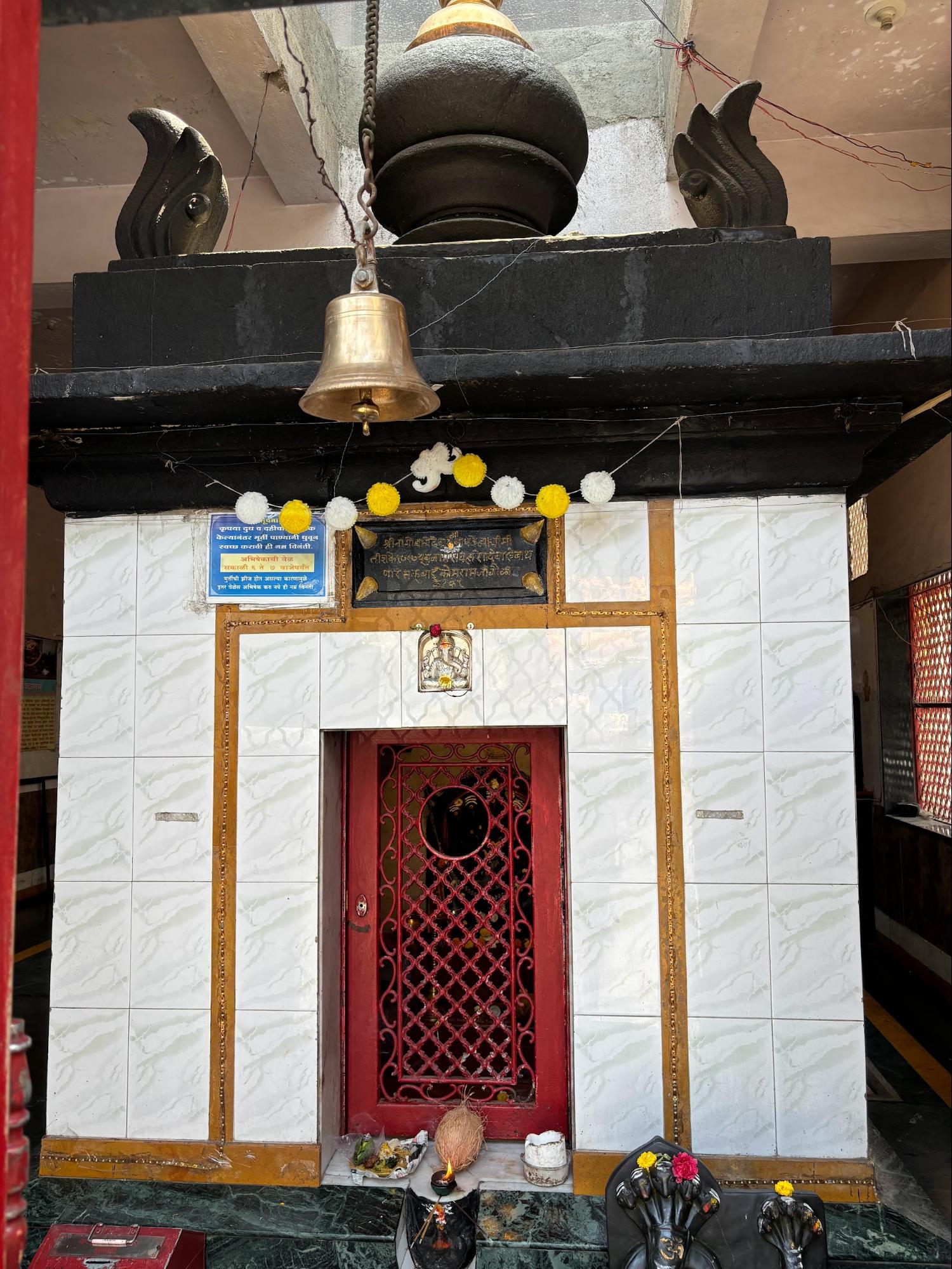
According to a Marathi inscription at the entrance, the Mandir was founded by Sakhubai Komramji Kadekar (Gavli) during Shaka Samvat 1797 (corresponding to 1895–96 CE). According to local tradition, Sakhubai received a divine revelation, prompting her to establish the Mandir at this location. The upkeep of the site continues to be managed by the Kadekar family.
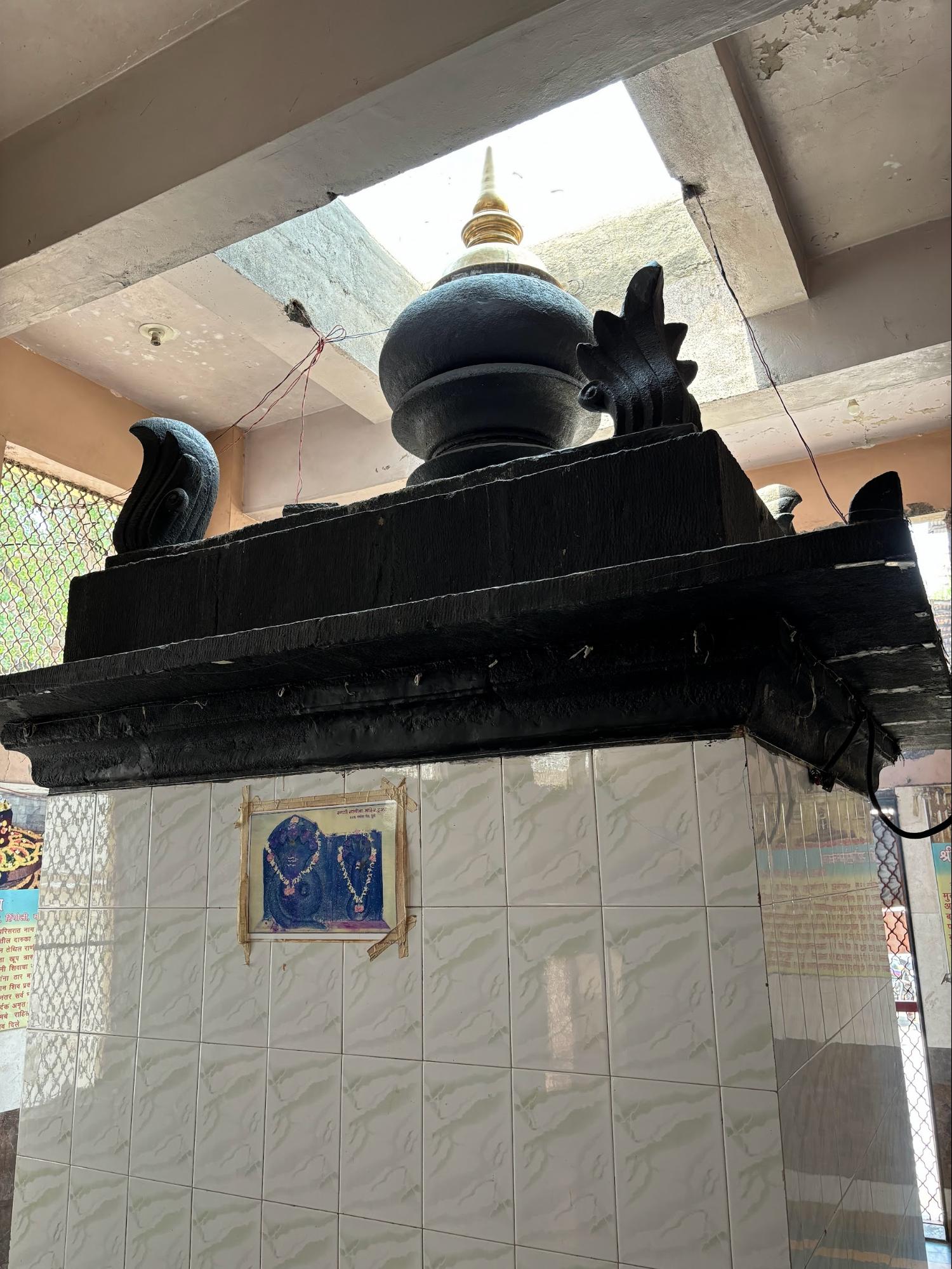
The Mandir is especially known for its Nag Panchami celebrations, held during Shravana, the fifth month of the Hindu calendar. Marked by vibrant rituals and large gatherings, the festival has been observed here since the late 19th century and continues to draw people from across Maharashtra.
Dagdusheth Halwai Ganapati Mandir
The Shrimant Dagdusheth Halwai Ganapati Mandir is a prominent landmark located in Budhwar Peth of Pune City. Established over 127 years ago, it is noted for its architectural grandeur and cultural significance. The Mandir is dedicated to Bhagwan Ganesh, who is revered here as Icchapurti Ganesh (the fulfiller of wishes). Its iconic murti, made of pure silver, stands 7.5 ft. tall and 4 ft. wide, adorned with intricate ornaments and a magnificent crown.
![An outside view of the Dagdusheth Halwai Ganapati Mandir at Budhwar Peth.[14]](/media/culture/images/maharashtra/pune/cultural-sites/an-outside-view-of-the-dagdusheth-halwai-_Ri1D7rN.jpg)
The Mandir was established by Dagdusheth Gadve, a trader from Karnataka who later became a confectioner in Pune. After losing their son to the plague of 1896, Dagdusheth and his wife Lakshmibai were advised by their spiritual guru, Shri Madhavnath Maharaj, to build a Ganapati Mandir as an act of devotion and healing. It later became a place of solace for the couple and a centre of worship for countless people.
In 1893, Lokmanya Tilak transformed Ganesh Chaturthi from a private household celebration into a public festival, Sarvajanik Ganesh Utsav, at this very Mandir, using it as a platform to unite people in the fight for India’s independence. Since then, the Mandir has been at the forefront of Ganesh Utsav celebrations, organizing vibrant rituals and pandals that draw people from across the world.
![The main murti at Dagdusheth HalwaiGanapatiMandir, Budhwar Peth, Pune.[15]](/media/culture/images/maharashtra/pune/cultural-sites/the-main-murti-at-dagdusheth-halwaiganapa_Gv1SWlg.jpg)
Managed by the Shrimant Dagdusheth Halwai Sarvajanik Ganapati Trust since 1952, the Mandir is not only a spiritual hub but also a centre for numerous social initiatives. These include educational and financial support for underprivileged children, micro-finance for entrepreneurs, and an old-age home named Pitashree, and rehabilitation efforts for labourers.
The trust has a history of crafting murtis with deep cultural and religious significance. Notably, the current murti created in 1968 incorporated a Ganesha Yantra within its structure after a year-long ritualistic process. The Mandir has continued to adhere to traditional Hindu customs and remains a symbol of unity, devotion, and community service. Today, the Dagdusheth Ganapati Mandir is not only a yatra site, but also an emblem of Pune’s rich cultural heritage, attracting locals and tourists alike.
Datta Dhyan Mandir
Datta Dhyan Mandir, situated in Pashan, is a space dedicated to Dattatreya (a combined form of Bhagwan Brahma, Vishnu, and Shiv). It is known for its intricate carvings and detailed stonework throughout. The cool marble flooring and quiet atmosphere make it a popular place for meditation and reflection.
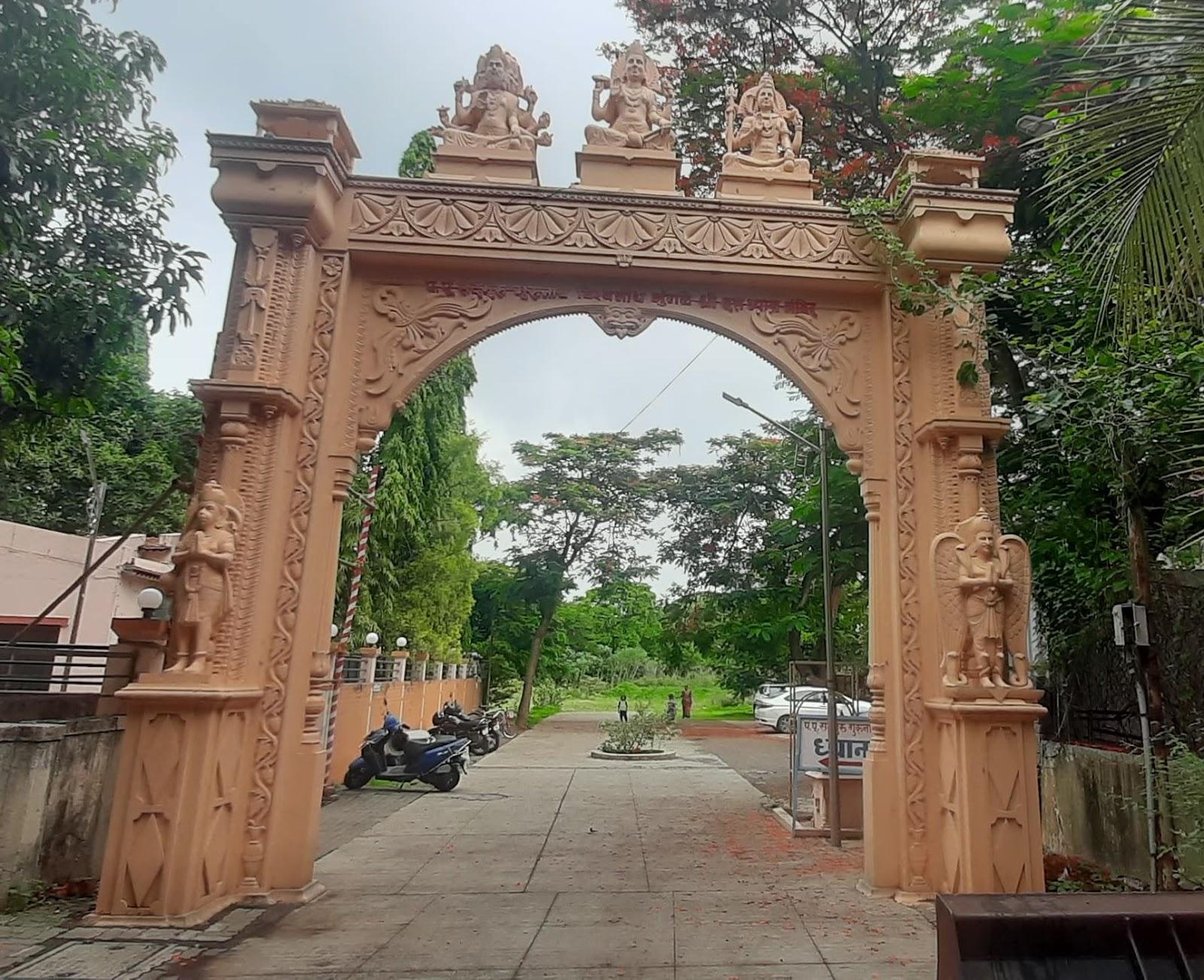
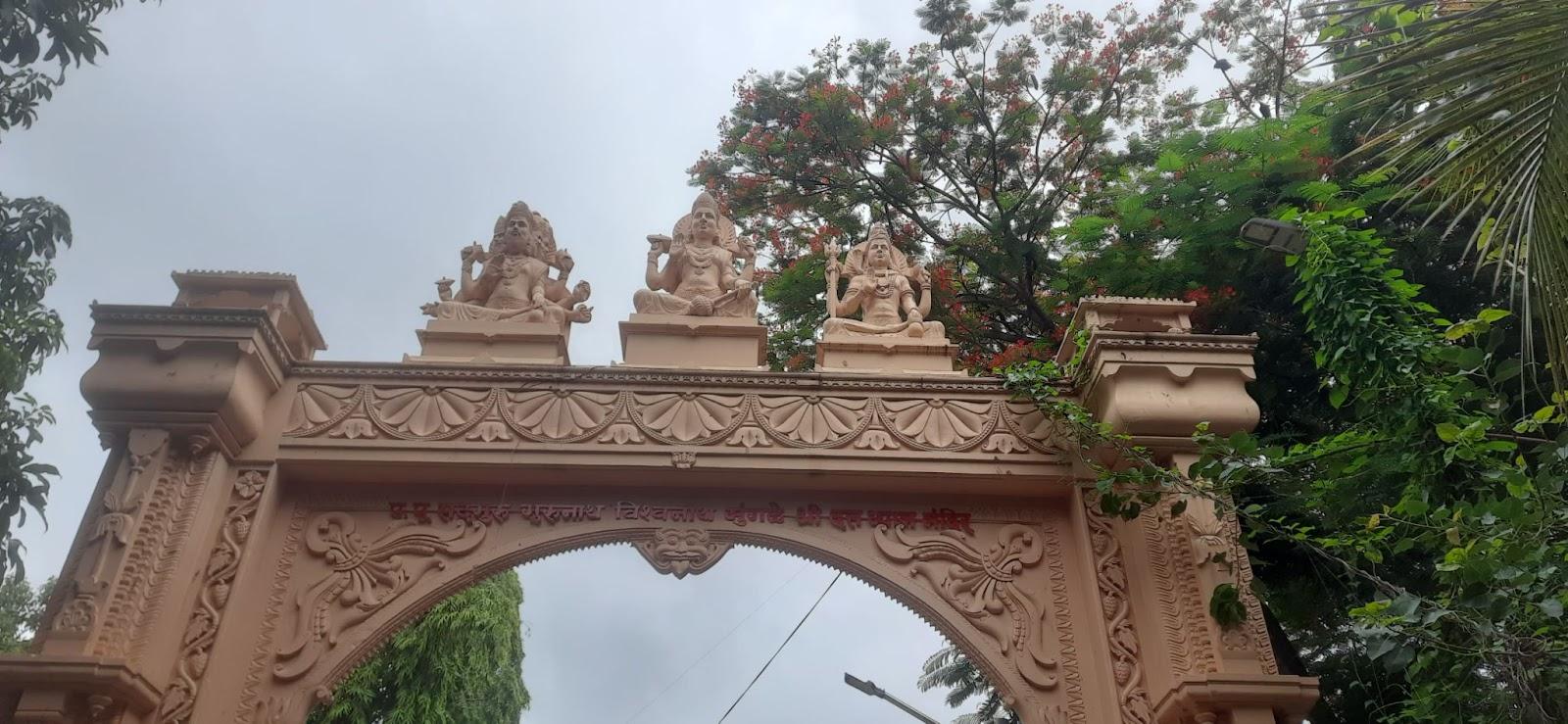
A recurring design feature is the elephant motif, which appears prominently in the structure’s carvings. The complex also includes a kund (water tank) that is home to turtles believed to be over a hundred years old.
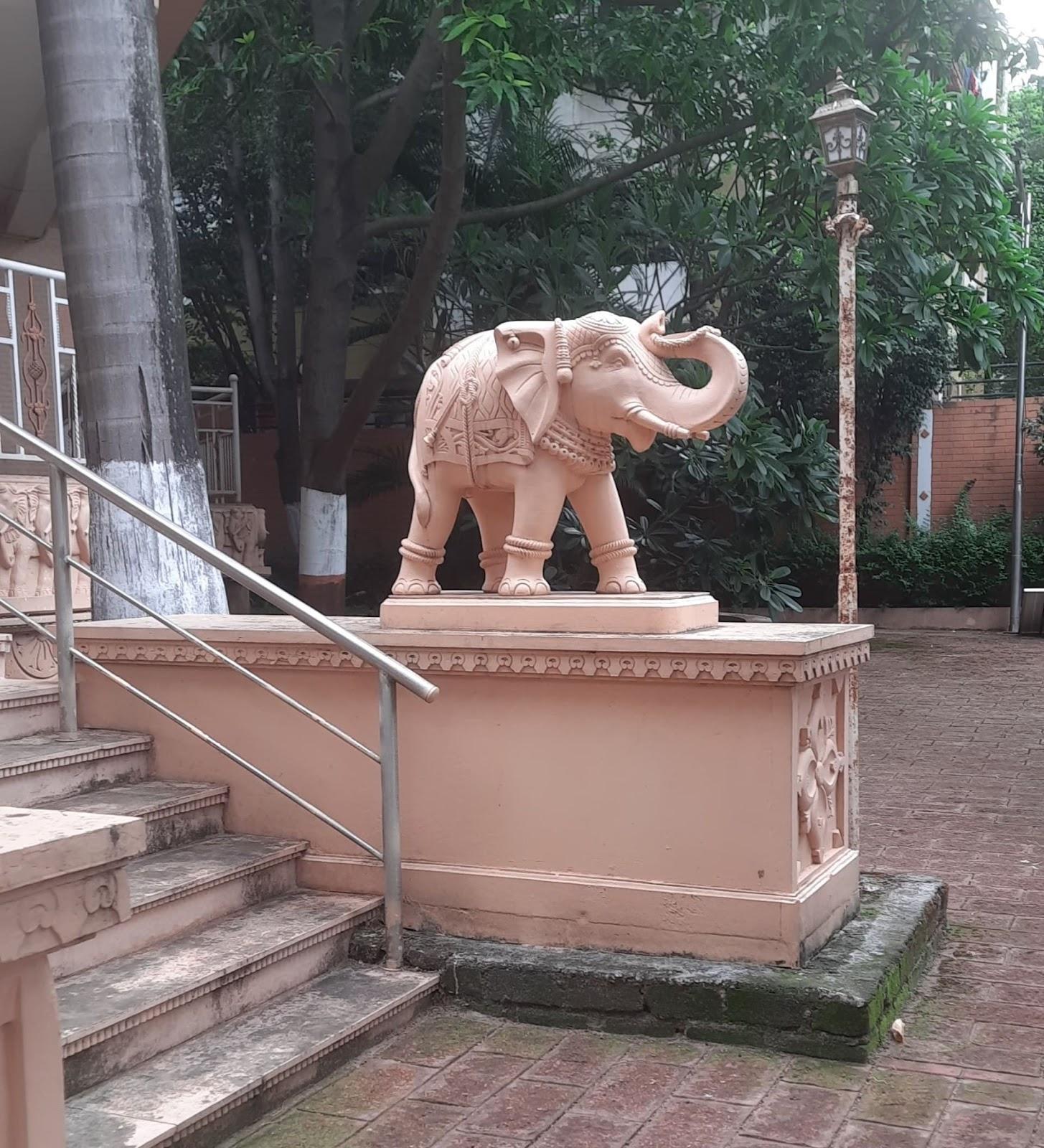
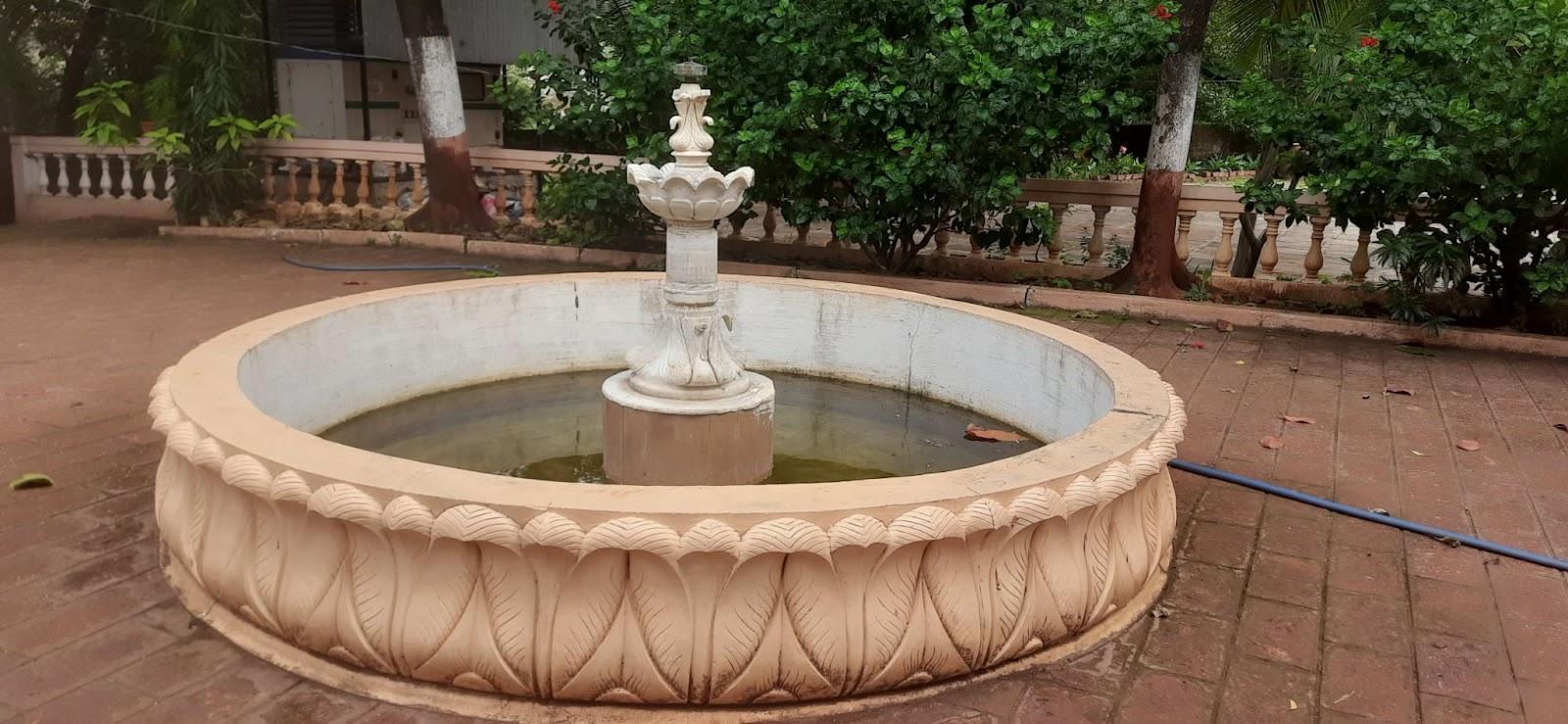

A nearby monument commemorates Subhedar Khandoji Mankar, remembered for leading the Peshwa army in campaigns against the Portuguese in Bombay.

Dharmaveer Chhatrapati Shri Sambhaji Maharaj Samadhi
The Dharmaveer Chhatrapati Sambhaji Maharaj Samadhi, located in the village of Tulapur, around 40 km northeast of Pune, marks the site where Chhatrapati Sambhaji Maharaj, the second ruler of the Maratha Empire, was executed by Mughal forces in 1689 during the reign of Emperor Aurangzeb. Sambhaji Maharaj, the son and successor of Chhatrapati Shivaji Maharaj, is remembered for his leadership during a critical period of Maratha resistance in the Deccan.
![The memorial samadhi of Chhatrapati Sambhaji Maharaj at Tulapur, where he was executed by Mughal forces in 1689.[16]](/media/culture/images/maharashtra/pune/cultural-sites/the-memorial-samadhi-of-chhatrapati-sambh_aKP8VMt.png)
According to the colonial district Gazetteer (1885), Chhatrapati Sambhaji Maharaj was captured by Mughal forces under Takarrib Khan in 1689 at Sangameshwar town (in present Ratnagiri district). He was brought to Tulapur where he was executed. A memorial samadhi stands here as a remembrance of this moment in history that took place here. Notably, Sambhaji Maharaj and Tulapur share a deeply connected history, it is believed that the village gets its name from an event in which Sambhaji Maharaj arranged for an elephant to be weighed in silver on a boat, allowing a ritual donation (tula-daan) by the Adil Shahi minister Murarpant. The act of weighing (tula) is said to have given rise to the name Tulapur.
Dulya Maruti Mandir
Dulya Maruti Mandir, located in the heart of Ganesh Peth, is one of the older mandirs in Pune. It was constructed in 1680 by Naro Anant Natu and is dedicated to Bhagwan Maruti (Hanuman). The structure is built from dark igneous stone, which notably is said to reflect the aesthetics of 17th-century Mandir architecture in this region. The murti is traditionally believed to have been installed by Shree Samarth Ramdas Swami (1608–1682), a sant-poet and spiritual teacher known for his devotion to Bhagwan Maruti. He is also credited with composing the Maruti Stotra, a series of verses in praise of Hanuman, which continues to be recited in akhadas (traditional gyms) by kustikars or pahilwaans before training.
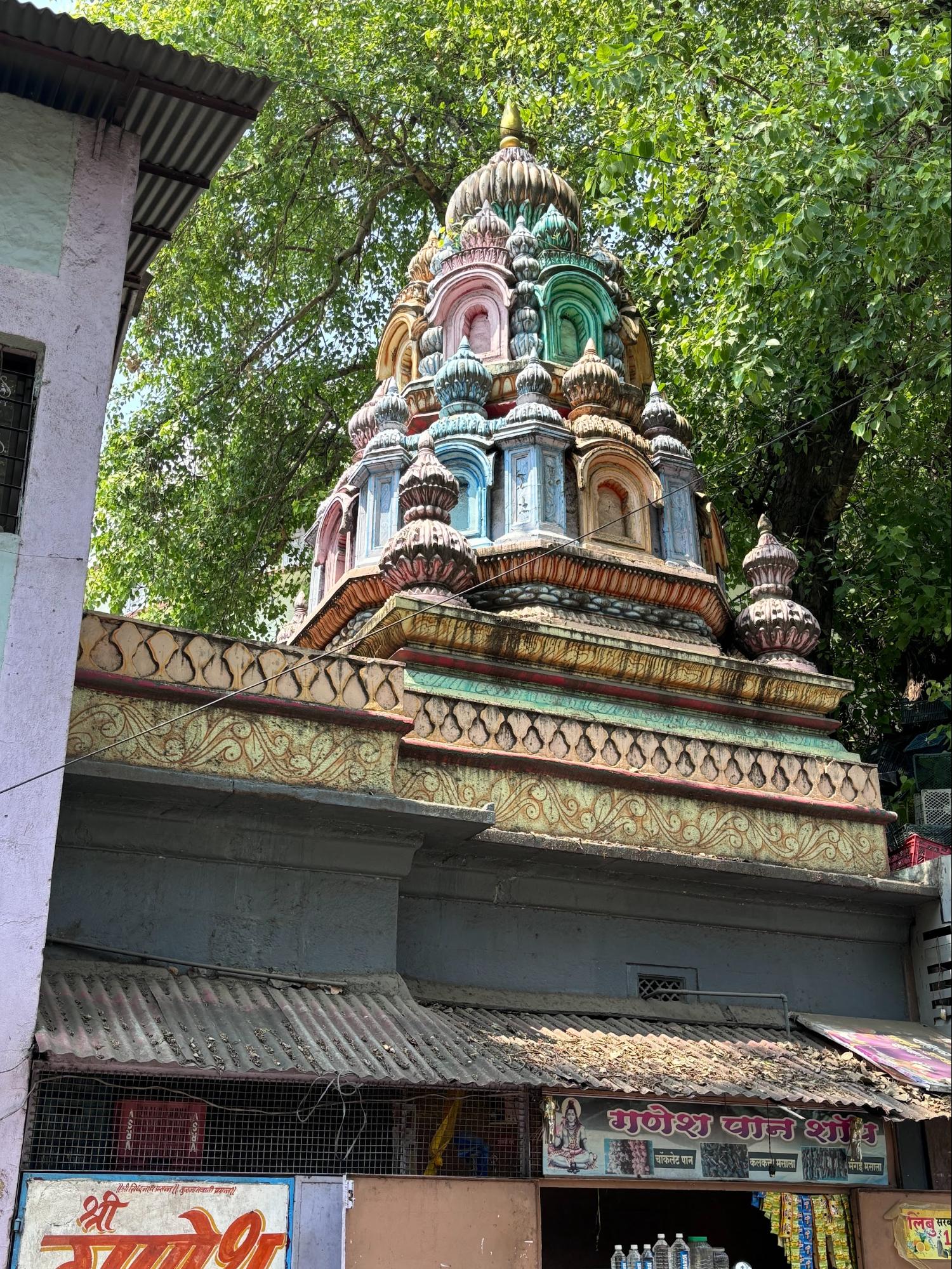
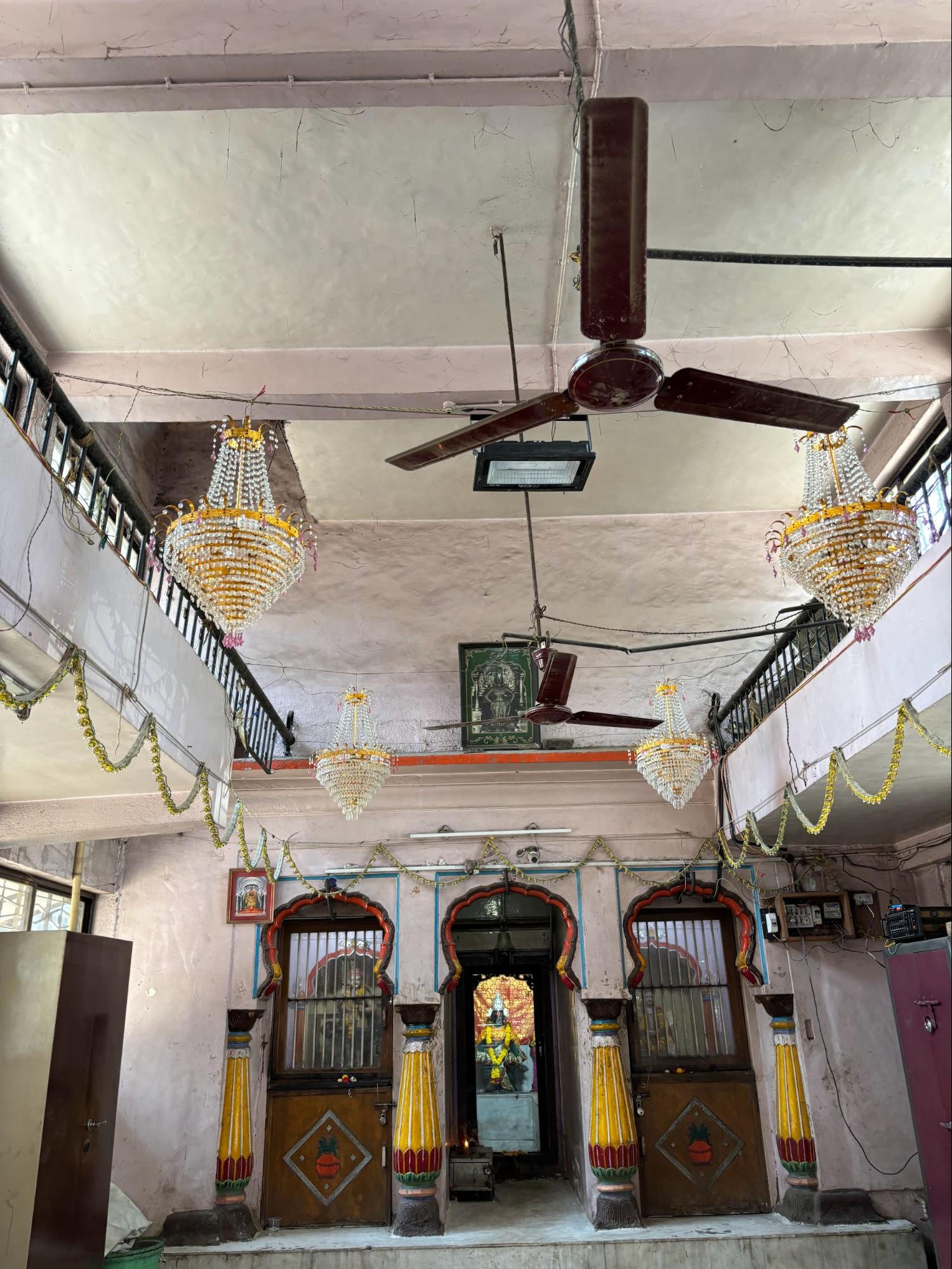
The name “Dulya Maruti” is unique among Pune’s Maruti mandirs. The word dulya comes from the Marathi verb dulne, meaning "to sway" or "to nod." This name is closely tied to a local legend which, notably, connects the murti to the Third Battle of Panipat in 1761, in which thousands of Marathas were killed during their campaign against Ahmad Shah Abdali (1722–1772). According to popular belief, the Maruti murti at this Mandir swayed gently, ‘dulne’ in Marathi, in grief, as if mourning the fallen. This act of divine empathy gave the Mandir its name. Another version of the story suggests the murti nodded in agreement with Peshwa Bajirao II (1775–1851) and his decision to leave Pune, once again invoking the sacred gesture of ‘dulne’.
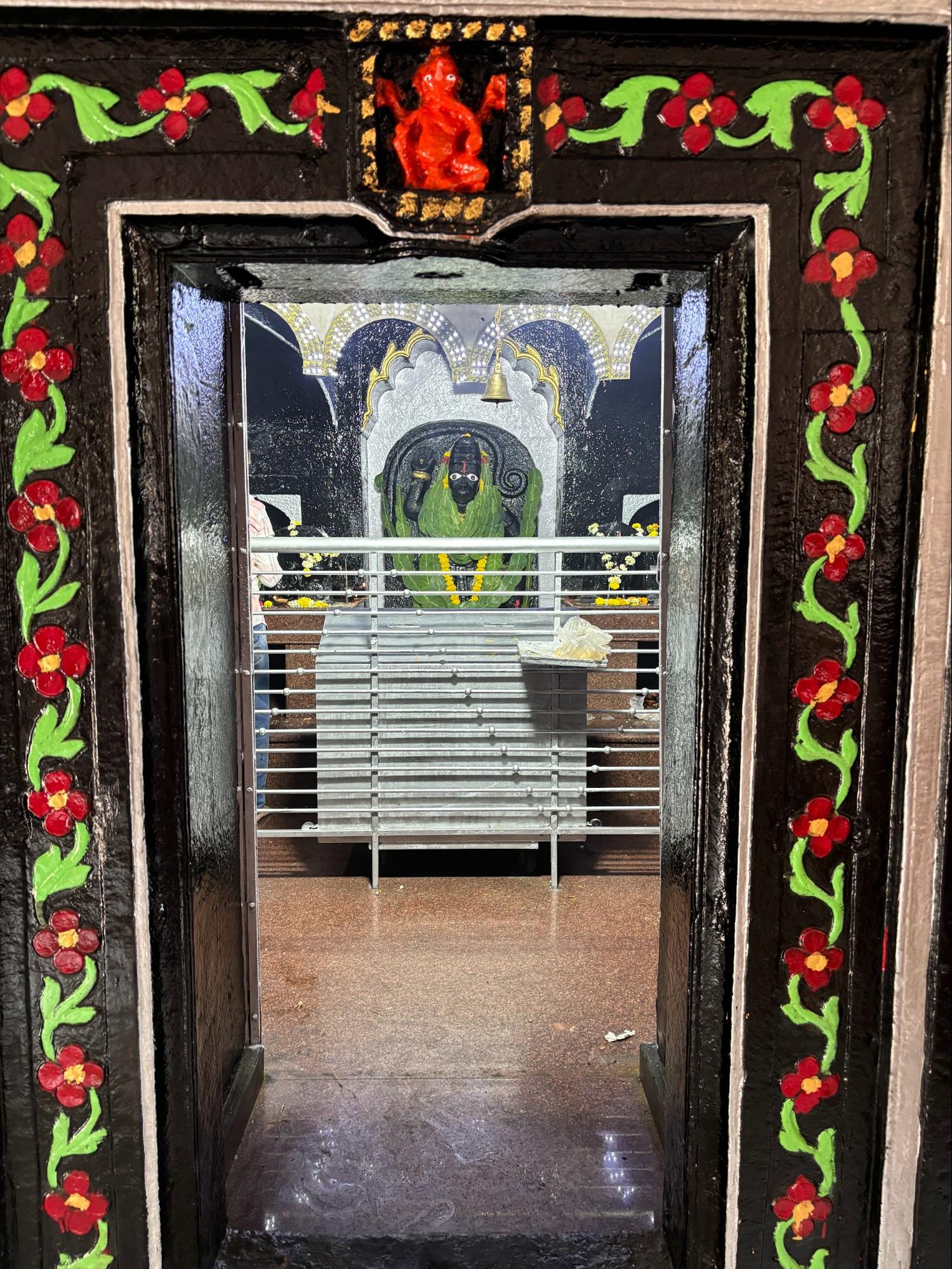
Even today, the murti’s white eyes and steady form hold a quiet intensity that draws in people, each pausing, if only for a moment.
GovernmentPhoto ZincographicPress
The Government Photo Zincographic Press, located on Agarkar Road in Pune, is a historic printing facility that dates back to the late 19th century. It was established in 1888 by the British administration as part of a broader effort to modernize the reproduction of official records, maps, and images in colonial India.
![ThePhoto ZincographicPress is located on Agarkar Road in Pune.[17]](/media/culture/images/maharashtra/pune/cultural-sites/thephoto-zincographicpress-is-located-on-_7SXZaJ3.jpg)
The press uses the process of photo zincography, a method developed in the 1860s by Sir Henry James. This technique involves transferring photographic images onto zinc plates, followed by etching with acid, allowing for accurate and large-scale reproduction. It played a key role in producing detailed maps and documents that were essential for governance, particularly in planning, land management, and administration.
As one of several such presses across India, the Pune facility was set up to support the growing demand for printed materials under British rule. Following India’s independence in 1947, the press came under the Government of Maharashtra and became part of the Directorate of Government Printing, Stationery and Publication. Today, it continues to operate, producing government publications, documents, and books. The use of zincographic techniques has persisted, valued for its precision in document reproduction.
The building housing the press has been recognized as a Grade II heritage structure by the Pune Municipal Corporation. Its architecture reflects the administrative and technological ambitions of the colonial period, designed to accommodate industrial printing operations. In many ways, it stands as a reminder of India’s transition from colonial-era printing practices to modern state publishing, continuing to serve both the government and the public.
Gundacha Ganpati
Gundacha Ganpati, also known as the Shree Siddhivinayak Ganpati, is situated in one of the narrow alleyways leading to Pune’s gramdaivat, the Kasba Ganpati Mandir. The Mandir’s name has an interesting origin; many believe it comes from Nagoji Gund, a prominent Maratha statesman from the Peshwa era, as it once stood near his residence. However, the Mandir’s uniqueness extends beyond its name; the Ganpati murti and carries a rich and storied past.
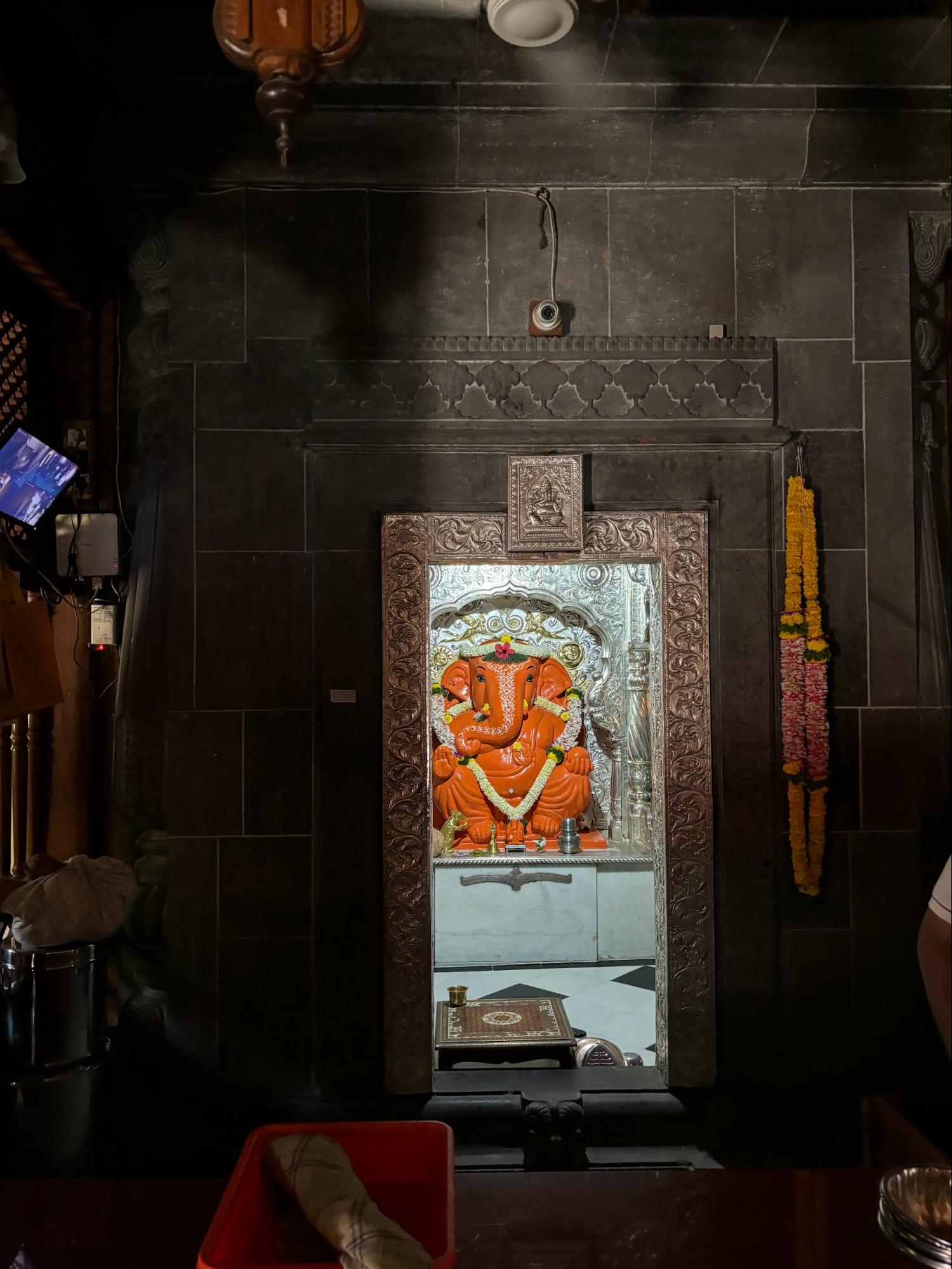
The Mandir was established in 1850 by Gopalrao Joshi. The Mandir has survived today through the craftsmanship and donations of many notable figures. In 1892, Master Krishnarao Phulambrikar’s grandfather, a renowned vocalist and Sangeetkalanidhi, donated the funds for the construction of the black stone garbhagriha. The Mandir’s architectural design, featuring abundant woodwork, reflects the traditional style of Pune’s Peth areas.
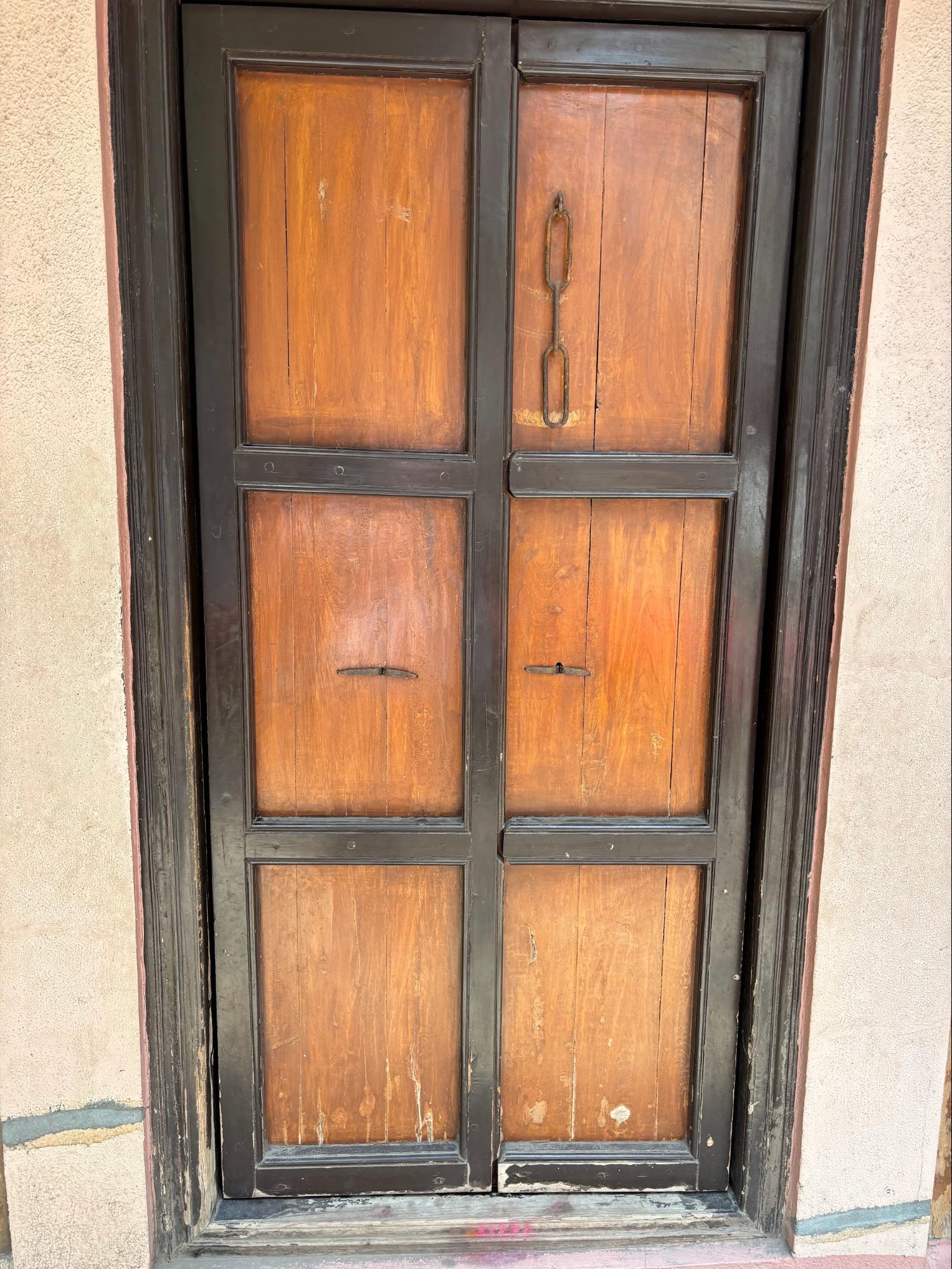
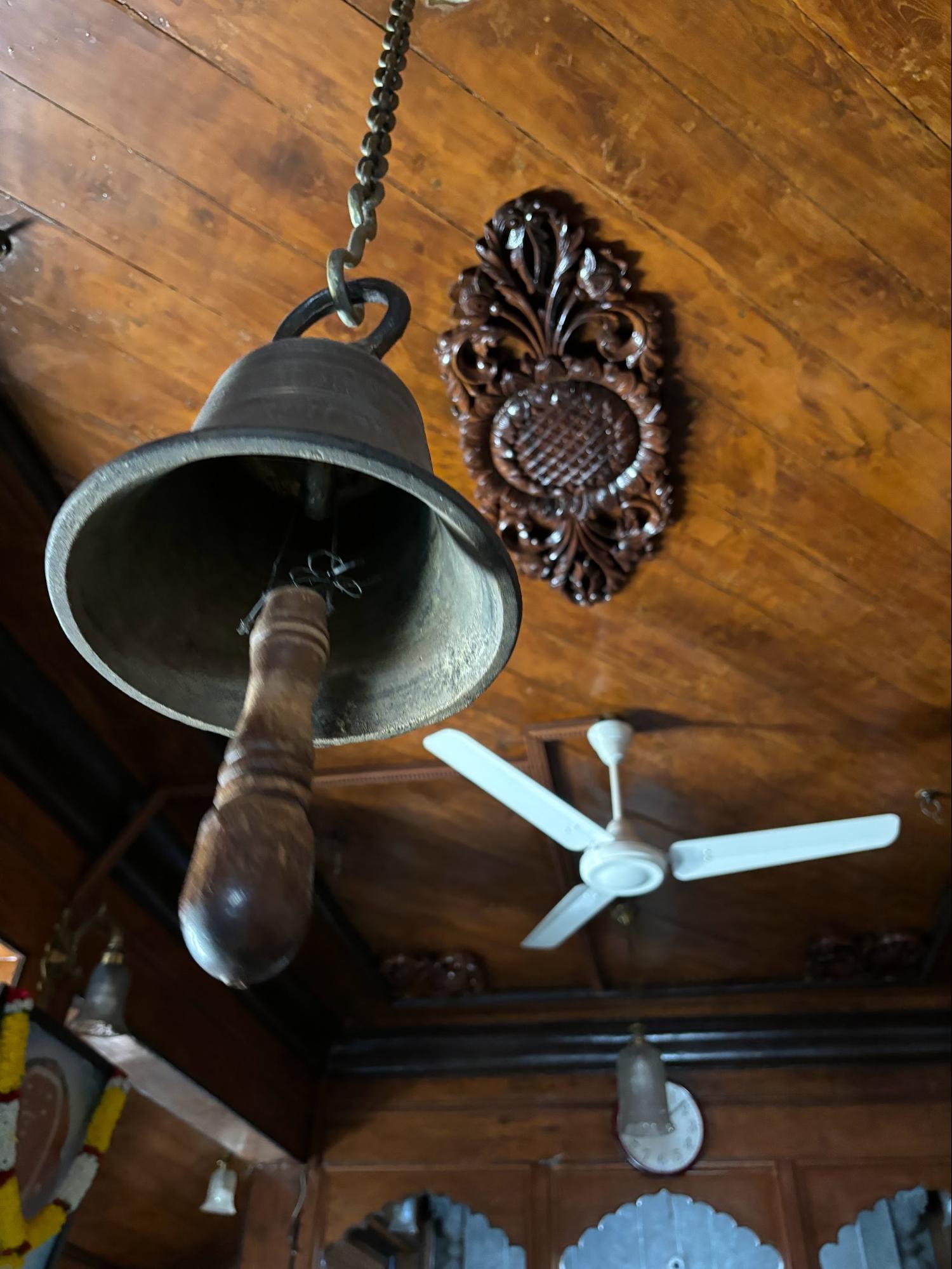

In the mid-19th century, Apparao Ganesh Vaidya led extensive restoration efforts that preserved the Mandir's architectural integrity and established much of its present-day structure. Gundacha Ganpati is one of the few mandirs where the murti is older than the Mandir itself. In 1975, the shell of the original murti was uncovered, and inside was an ancient murti, though damaged.
Since it couldn’t be restored, a new murti was installed on 4 February 1976, by Kaviswara Shastri. Notably, the mould of the pre-restoration murti was created by the renowned sculptor B.R. “Appasaheb” Khedkar (famous for his work on the set design of the iconic film Mughal-E-Azam [1960]) and is preserved at the Raja Dinkar Kelkar Museum in Sadashiv Peth.
Gupchup Ganpati Mandir
![Street View of the Gupchup Ganpati Mandir, Shaniwar Peth, Pune.[18]](/media/culture/images/maharashtra/pune/cultural-sites/street-view-of-the-gupchup-ganpati-mandir_40BhQef.png)
The Gupchup Ganpati Mandir, also known as Varad Ganpati Mandir, is located in Shaniwar Peth, adjacent to the historic Dixit Wada. Constructed in the latter half of the 19th century, the Mandir is dedicated to Bhagwan Ganesh, revered here in his aspect as Varad, or “the one who bestows blessings.” The Mandir was significantly damaged during the Panshet flood of 1969 and was subsequently reconstructed.
The Mandir is a typical Peshwa-style mud brick structure with a pinnacle and a front hall. Due to the Panshet flood, most of the Mandir except the stone garbhagriha and parts of the sabhamandaps were eroded. The sabhamandap is two storeyed and chandeliers hang from its timber ceiling. The hall is decorated with paintings depicting stories from epics. During the festival of Ganesh Chaturthi, the Mandir organises evening bhajans for its devotees. The residents near the Mandir also play ‘Dhol-Tashe’ (a form of Indian drums) for Bhagwan Ganesh.
Gurudwara Guru Nanak Darbar
![Front view of Gurudwara Guru Nanak Darbar, Camp, Pune.[19]](/media/culture/images/maharashtra/pune/cultural-sites/front-view-of-gurudwara-guru-nanak-darbar_JxpuSxy.png)
Shri Guru Nanak Darbar is situated on Pattinson Road in Hulshur, in Pune's Cantonment area. It was built around the 1980s by Rai Saab DC Kohly, a resident of Bangalore. Also known as the Hollywood Gurudwara, it stands on the same property as the Hollywood Club, an army entertainment venue active during the British era.
The Gurudwara has been built using a variety of architectural styles. The minarets reflect Mughal aesthetics while its chattris (domes) and oriel (a low window that does not touch the base of the structure) windows follow Rajput design. The exterior is embellished with fresco painting (painting on wet plaster), Pinjarra, elaborate inlay work, plaster-of-Paris work. A Sikh museum displaying paintings of all ten Sikh Gurus was opened on the Gurudwara grounds in 2010.
Hanuman Mandir
Hanuman Mandir is a small roadside Mandir located under a banyan tree (vad) along NDA Pashan Road in Pune. The Mandir features an image of Hanuman placed directly beneath the tree
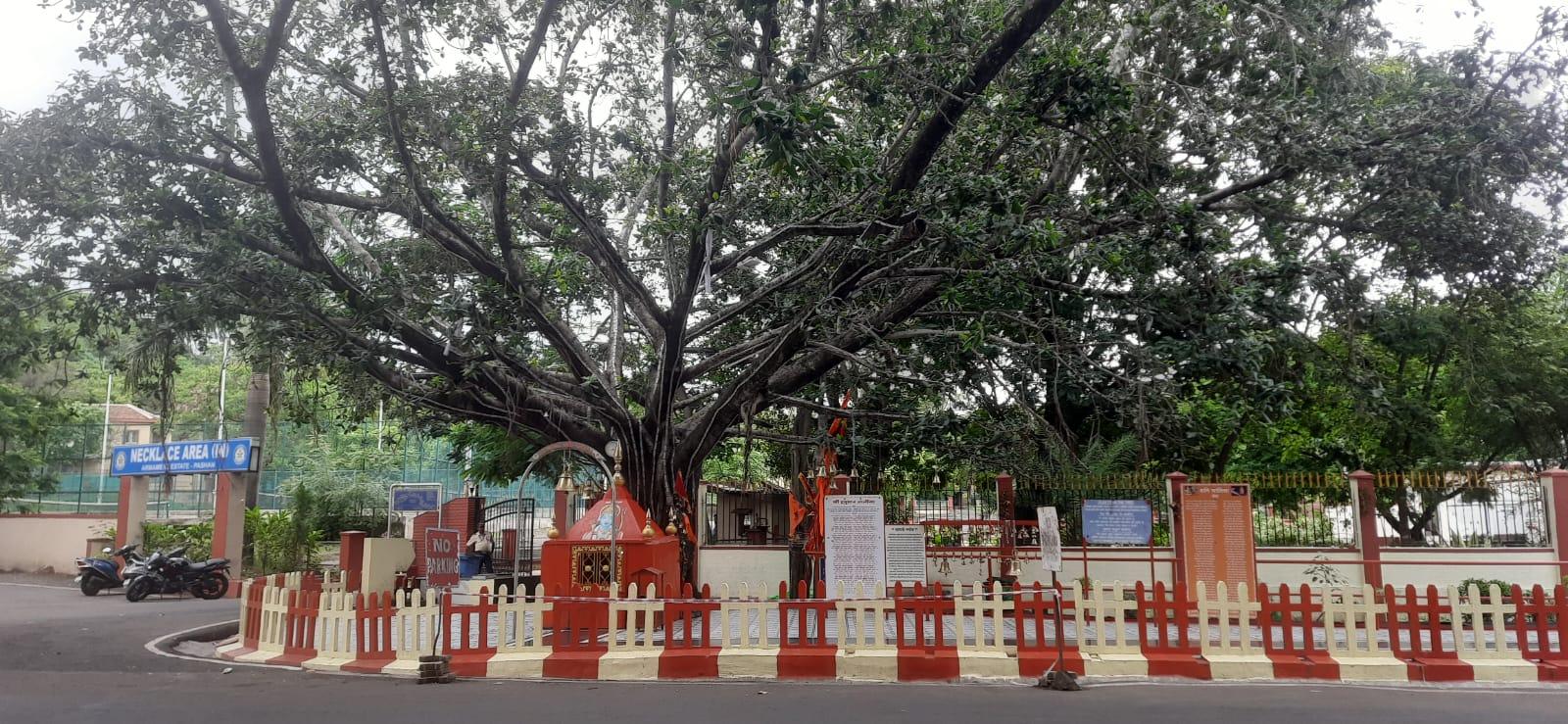
The Mandir receives a steady stream of visitors each day, many of whom visit to make a mannat (vow or wish). Interestingly, bhakts often tie bells on the branches of the tree and believe that doing so would grant their wish. It is said that if one asks for a wish at this place it will be granted.
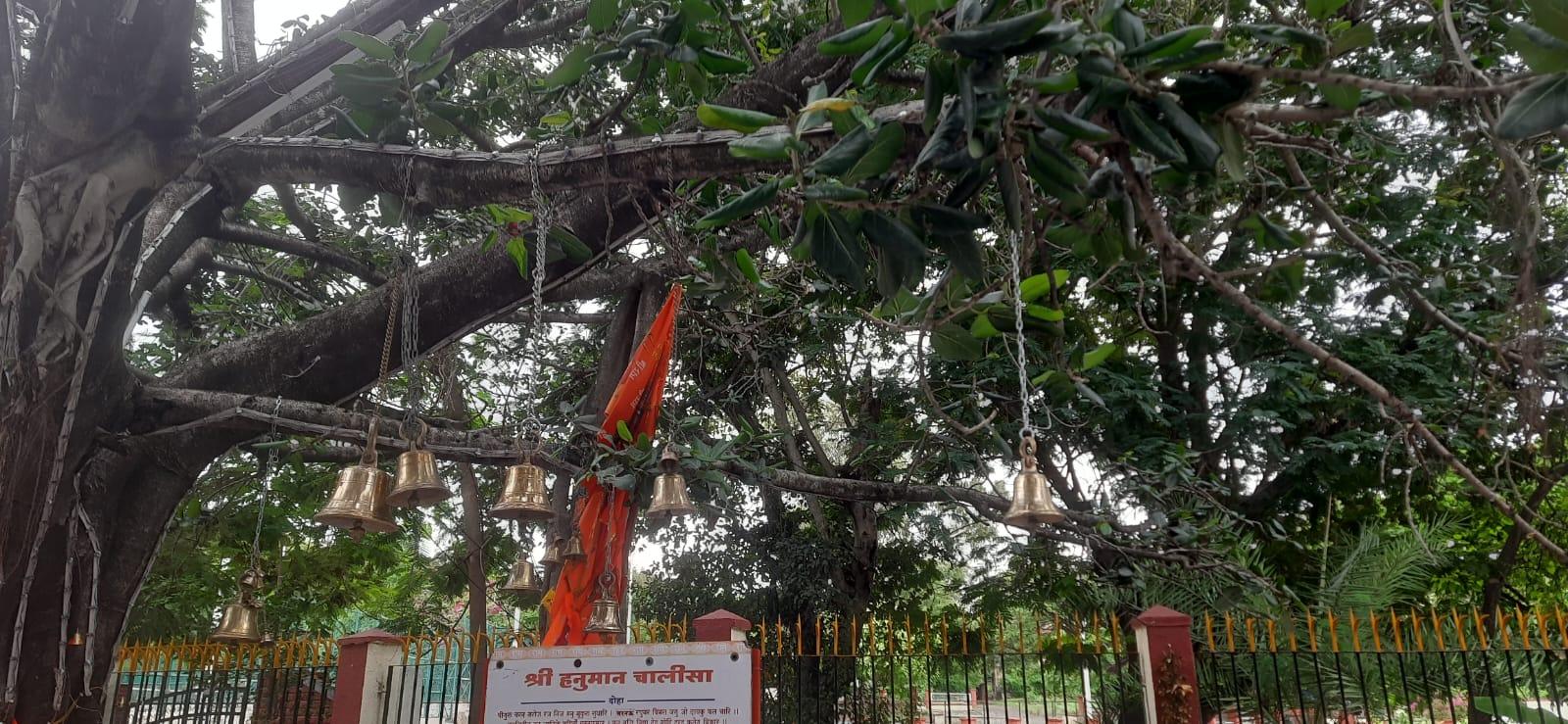

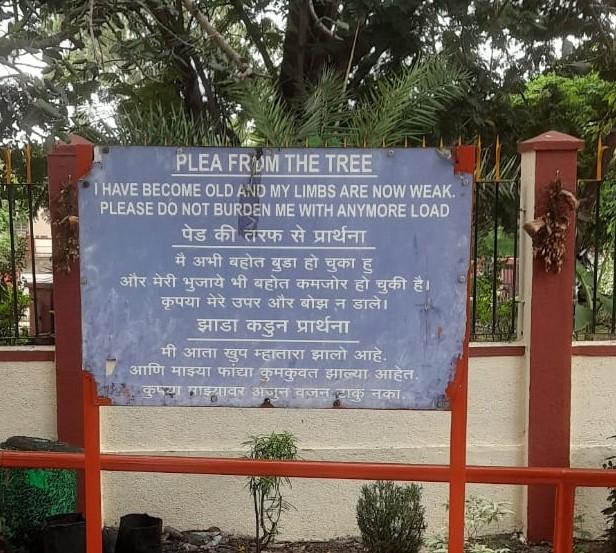
Hanuman Mandir, Nirgude
Hanuman Mandir, Nirgude is a Mandir located in Junnar taluka, Pune district, notable for two stone inscriptions from the 18th century. The first, dated 3 April 1742, is carved in Devanagari above the garbhagriha entrance. It records that Mahadev Yadav, a local scribe, built the garbhagriha.
The second inscription, dated 13 December 1766, is above the main entrance. It refers to a Kayastha scribe from the Sule family, who managed records and revenue collection for Nirgude, Kāle, Vadgaon Sahani, and Mahalungi, and used his earnings to fund the construction of the mandir’s hall and gateway. Together, the inscriptions show how, in many ways, scribes contributed to both administration and public religious life in the 18th-century Deccan.
Hanuman Mandir, Pashan
The Hanuman Mandir, situated in Pashan, as the name suggests is dedicated to Bhagwan Hanuman. Its origins are associated with a very interesting story.
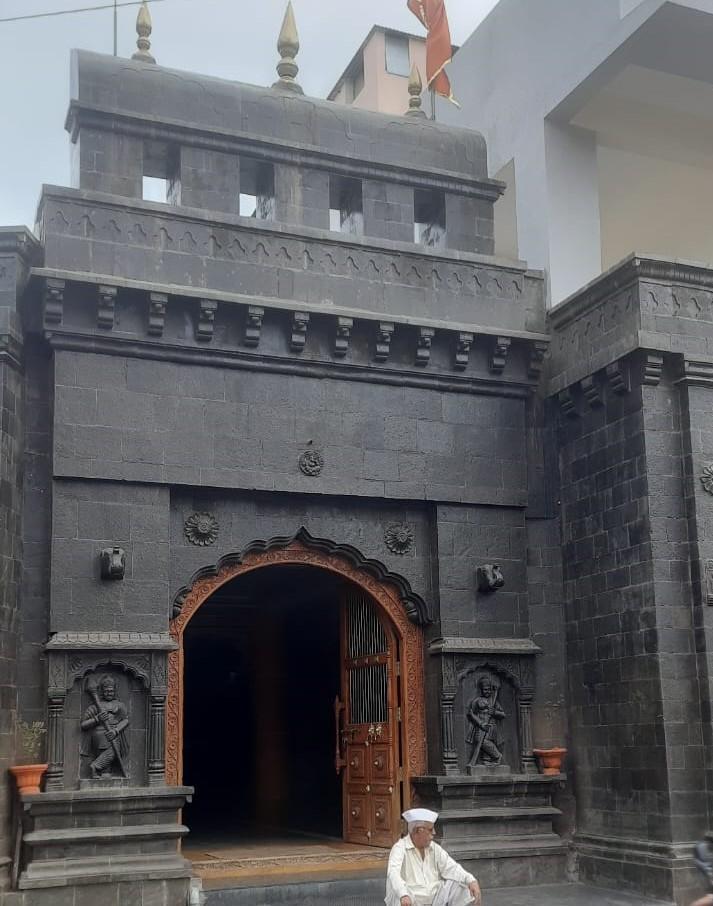
It is said that, many generations ago, a rock resembling the murti of Bhagwan Hanuman was found in the Ramnadi riverbed. It was painted and enshrined, and a Mandir was constructed at the site. Some decades later, the murti is said to have disappeared, causing anxiety among villagers who believed that the Devta had withdrawn due to their actions.
To seek forgiveness, the community performed a yajna and offered prayers. In time, the murti reappeared in the Mandir, an event understood locally as a sign of Bhagwan Hanuman’s restored presence.

The Mandir’s exterior has since been rebuilt to resemble a fort. A notable tradition continues here in which men visit the Mandir on their wedding day to seek blessings from the Devta as they mark the end of their brahmacharya (celibate) phase. In the same locality, interestingly, women visit the Shitaladevi Mandir on their wedding day to offer rice prasad and receive the Devi’s blessings.

Hazrat Babajan Dargah
Hazrat Babajan Sargah is estimated to have been built in 1931 and is situated in Babajan chowk, Pune. It is named after Hazrat Babajan, born Gulrukh, a Pashtun Muslim saint from Afghanistan. She is considered by many to have been a spiritually gifted figure. From a young age, she displayed remarkable abilities - reciting verses from the Quran by heart and spending long hours in prayer and meditation. She also mastered several languages, including Pashto, Urdu, Arabic, and Persian.
![Inside view of Hazrat Babajan Dargah, Babajan Chowk, Pune.[20]](/media/culture/images/maharashtra/pune/cultural-sites/inside-view-of-hazrat-babajan-dargah-baba_AaPsjTo.png)
In subsequent years, Hazrat Babajan travelled to Syria, Lebanon, Iraq, Iran, and Turkey. She visited Mecca and throughout her other journeys, she assisted yatris and preached philosophy to them. She came to India and settled in Pune in 1905. She came to Char Bawdi and took up a permanent spot there. She used to sit under the shade of a neem tree, and offered namaz from there. After a while, people started visiting her for blessings and it is believed that she even performed miracles. It is said that when Babajan first came to Char Bawdi, the area suffered from neglect and poverty; however, the area witnessed rapid growth once Babajan took residence there.
Hazrat Babajan continued to live under the shade of the neem tree until her death in 1931. After her death, her followers built a dargah for her in Char Bawdi. The dargah was constructed with white marble right next to the neem tree. Her grave is buried under the neem tree and the dargah has been built in such a way that the neem tree enters from the roof of the dargah.
Holkar Chhatri
![Holkar Chhatri in Khadki, Pune.[21]](/media/culture/images/maharashtra/pune/cultural-sites/holkar-chhatri-in-khadki-pune21-d1c8a5a9.png)
Holkar Chhatri is located near Khadki, to the south of Holkar Bridge. Built in 1730, the structure includes both a samadhi (memorial) and a Shiv Mandir. While the exact identity of the person the memorial is dedicated to remains unclear, the building’s estimated construction date is widely accepted as 1730. According to some accounts, the chhatri (dome-shaped pavilion) was built in honour of Malhar Rao Holkar, a Maratha noble from Indore’s ruling family in the 18th century. Other sources suggest it was constructed in memory of Sardar Vithoji Holkar, Malhar Rao’s younger brother, and his wife.
Inside the Shiv Mandir’s garbhagriha are two lingas, believed to represent Bhagwan Shiv and to symbolically honour Vithoji and his wife, who are said to have performed the sati ritual. Another samadhi in the complex is dedicated to Malhar Rao’s loyal soldier, Lakhya Bargir. It stands in front of Nandi in the Mandir’s sabhamandap.
Inamgaon
Inamgaon is an archaeological site located in Pune district, situated along the Ghod river. The site is associated with two major cultures of the Chalcolithic period (c. 2000–700 BCE), Malwa and Jorwe, and offers one of the most extensive settlement records for this time in western India.
It is believed that early settlers from the Malwa region (present-day Madhya Pradesh and parts of Rajasthan) migrated to the Deccan and occupied this area. These groups practiced a combination of agriculture, herding, and hunting. Around 1400 BCE, the Jorwe culture, known for its distinctive red pottery with black geometric designs, became prominent in the region. Over time, Inamgaon developed into one of the largest known settlements associated with this cultural phase.
![Reconstruction of the Inamgaon settlement on display at Deccan College. Based on findings from excavation, the model shows a Chalcolithic village with mud houses, open spaces, and storage pits, reflecting the material culture of the Jorwe phase.[22]](/media/culture/images/maharashtra/pune/cultural-sites/reconstruction-of-the-inamgaon-settlement_1WmRGTs.png)
Excavations conducted at the site have unearthed a large number of pottery objects, house remains, dwelling pits, etc. Based on these findings, many historians say that Inamgaon must have been one of the most populous sites of the Jorwe Culture.
ISKCON NVCC Mandir, Kondhwa
The ISKCON NVCC in Kondhwa was established in 1995 as part of ISKCON’s effort to bring Vedic knowledge and devotional practices into accessible, urban spaces. Rooted in the Gaudiya Vaishnava tradition that emerged during the Bhakti movement in Bengal, the Mandir promotes spiritual inclusivity through teachings drawn from the Bhagavad Gita and Srimad Bhagavatam. It emphasizes devotion to Krishna through various forms of service including chanting, cooking, study, and daily actions, irrespective of caste, gender, or background.
![Exterior view of the ISKCON NVCC Mandir in Kondhwa, Pune.[23]](/media/culture/images/maharashtra/pune/cultural-sites/exterior-view-of-the-iskcon-nvcc-mandir-i_U2FiU9q.png)
Spread across six acres, the Mandir is one of Pune’s largest and most visited spiritual and cultural landmarks. Culturally, the Mandir plays a significant role in Pune’s religious and community life. It distributes prasad to thousands daily, with numbers doubling on Sundays and during major festivals like Gaura Purnima (celebrated in the month of Phalguna, that is February-March), Ram Navami (celebrated in Chaitra, that is March-April), and Jagannath Snana Yatra (typically celebrated in May-June). In addition to devotional gatherings, the Mandir organizes public kirtans, youth outreach, women's cultural programs, and educational sessions across the city.
Jambhaljai Mata Mandir
Jambhaljai Mata Mandir is a small hilltop Mandir located off the Mumbai–Bangalore Highway. The Devi is regarded as a guardian deity and gramdevi for many and is associated with nature and fertility. It is known that she is revered in parts of Maharashtra, Goa, and northern Karnataka, particularly among rural and pastoral communities.
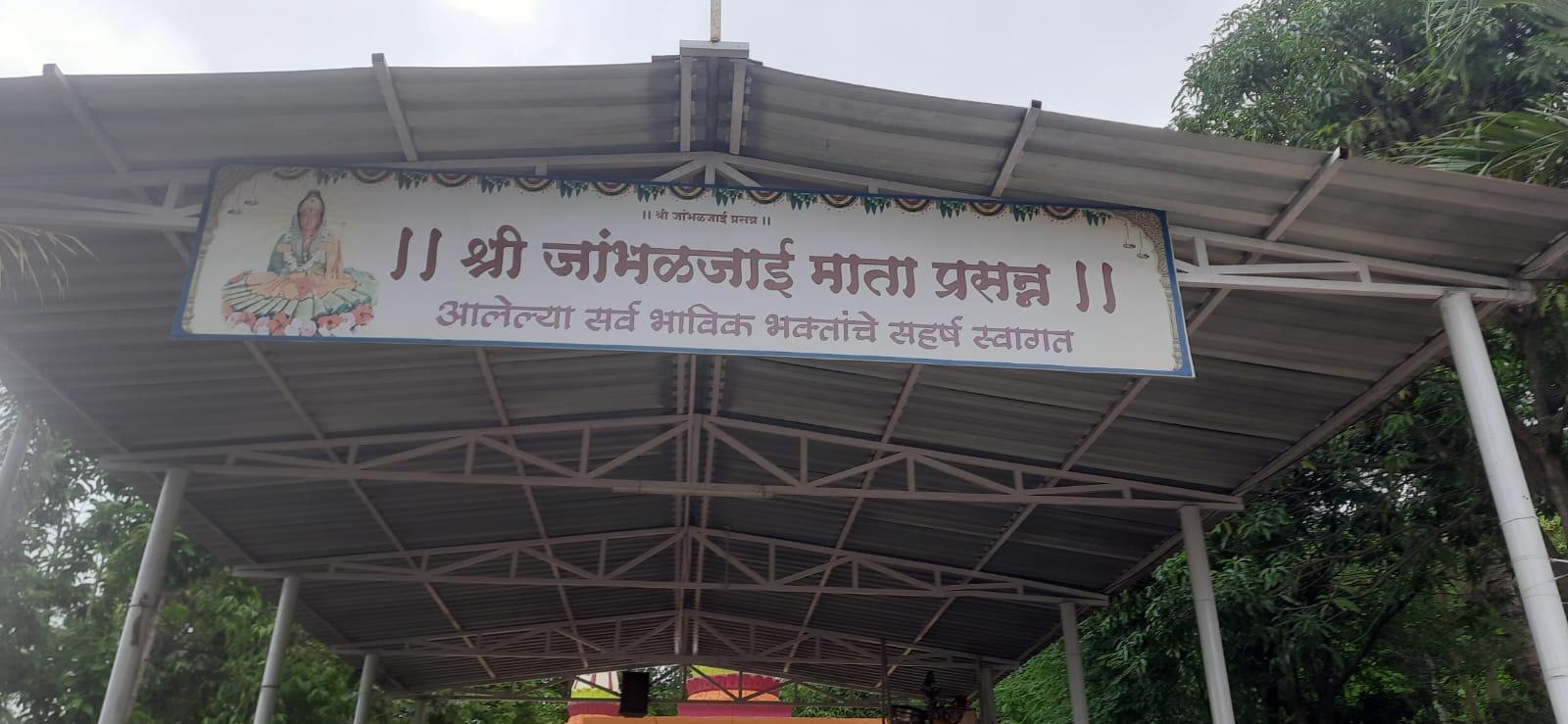
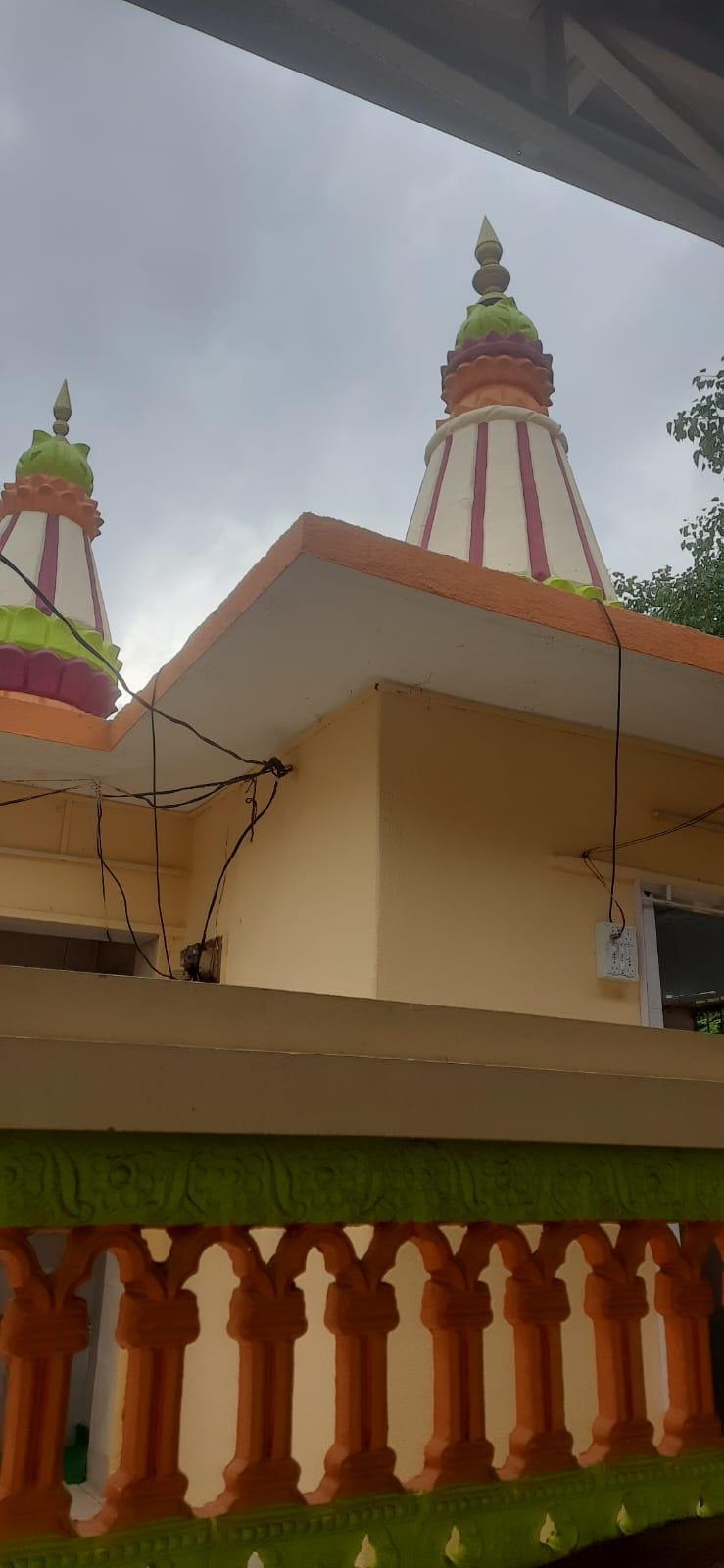
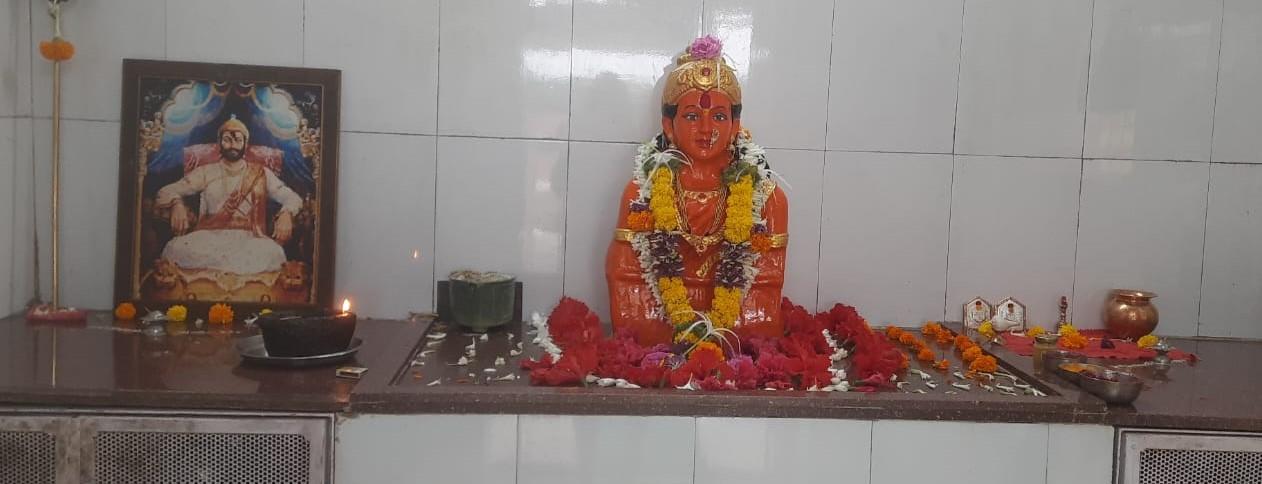
Before the murti was established, ten stone formations were discovered in the area and considered auspicious. According to local tradition, the person who found them later dreamt of Jambhaljai Mata, who gave her blessing to build a small devasthan at the site.
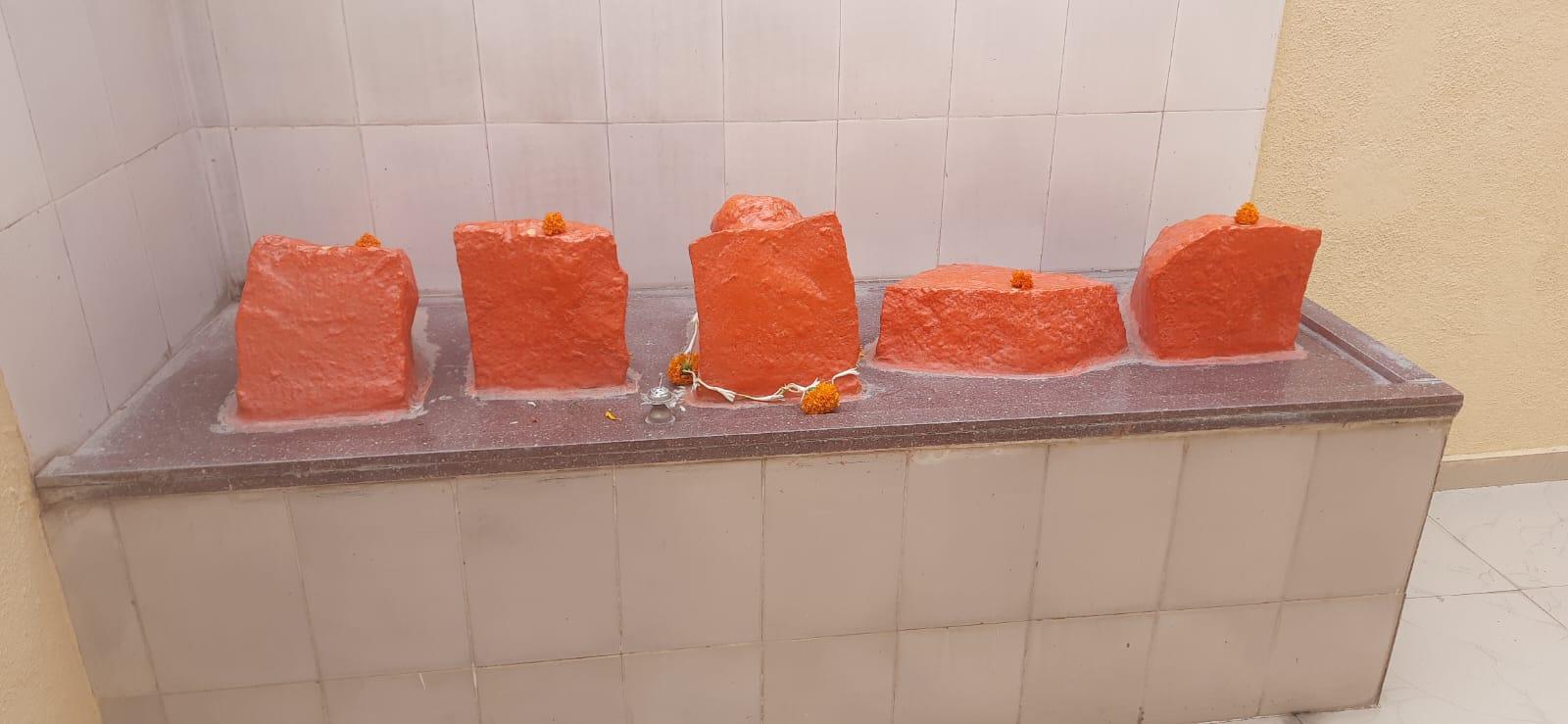
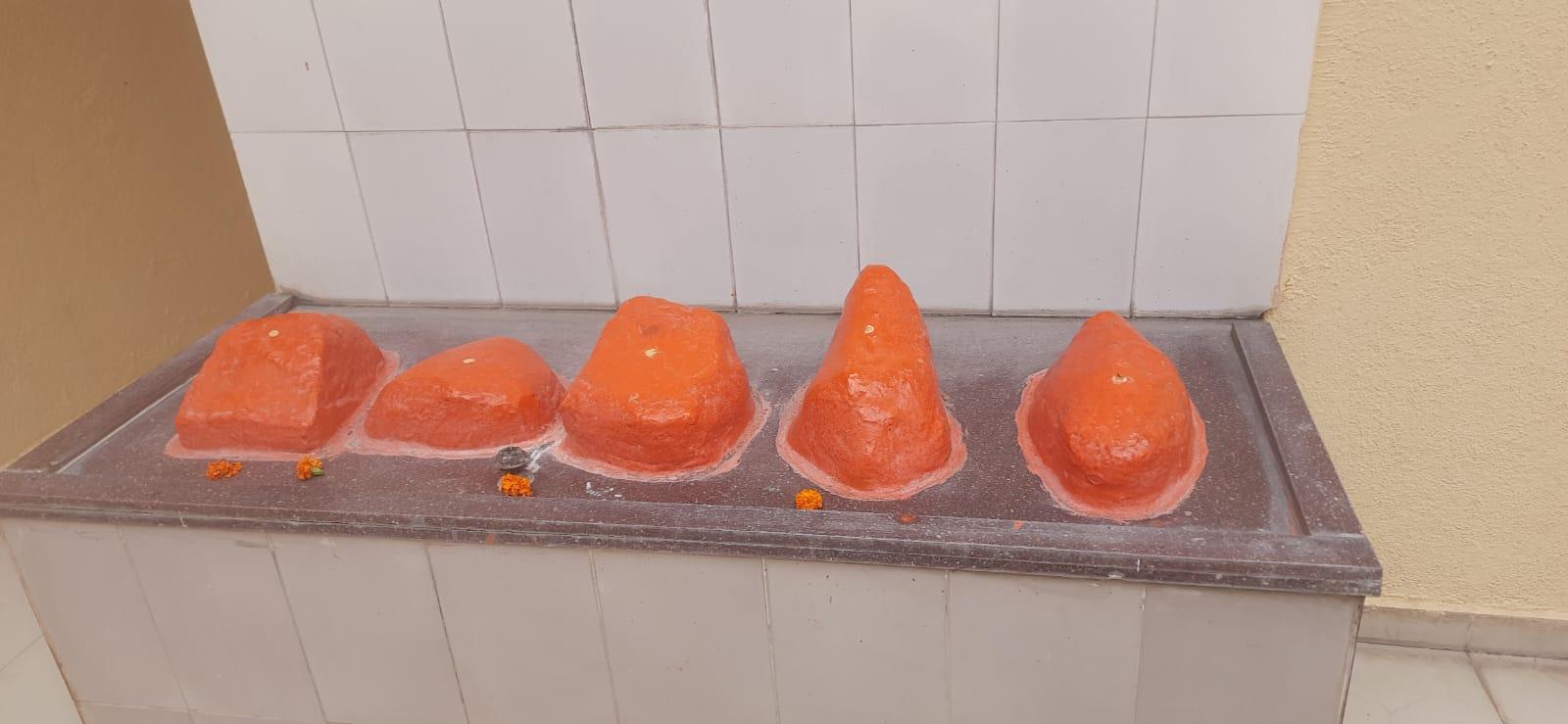
Tucked into the hillside, the Mandir can be difficult to locate. Its quiet setting makes it a place of rest and reflection. The surrounding hills are used for grazing, and the Mandir is frequently visited by livestock owners who stop here with their animals while passing through the region.
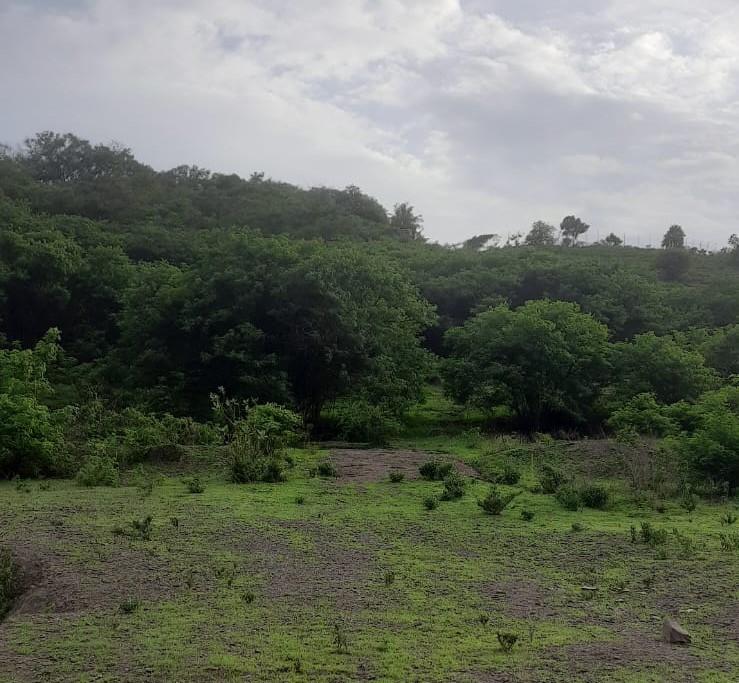
Jangli Maharaj Samadhi Mandir
![Front view of the Jangli Maharaj Mandir in Shivaji Nagar, Pune.[24]](/media/culture/images/maharashtra/pune/cultural-sites/front-view-of-the-jangli-maharaj-mandir-i_TNuprT3.png)
The Jangali Maharaj Samadhi Mandir was built in 1890 and is situated on JM (Jangli Maharaj) Road in Shivaji Nagar. It is devoted to Guru Maharaj, also known as Jangli Maharaj or Sadguru Jangli Maharaj. Following the sant's demise in 1890, his followers built this Mandir, next to the historic Pataleshwar Cave, on the site of his samadhi.
The Maharashtrian Pandit was a student of Swami Samarth of Akkalkot and lived in Pune. He meditated in Bhamburde jungles in Shivaji Nagar and hence was named Jangli Maharaj (King of the Jungle).
The primary festival observed here is Chaitra Shuddha Chaturdashi (March–April), which commemorates the death anniversary of Jangli Maharaj. The annual celebration begins on Gudi Padwa and concludes on Hanuman Jayanti. During the month of Kartik (usually falls in October–November), early morning kakad aarti is performed.
Jivdhan Fort
Jivdhan Fort, located near Junnar in Pune district, stands as a prominent example of hill fort architecture in the Sahyadri ranges. Overlooking the Naneghat Pass, the fort played a key role in securing ancient trade routes and has been linked to various dynasties and empires over time. Today, it stands in a dismantled state, but remains a prominent trekking destination and site of historical interest.
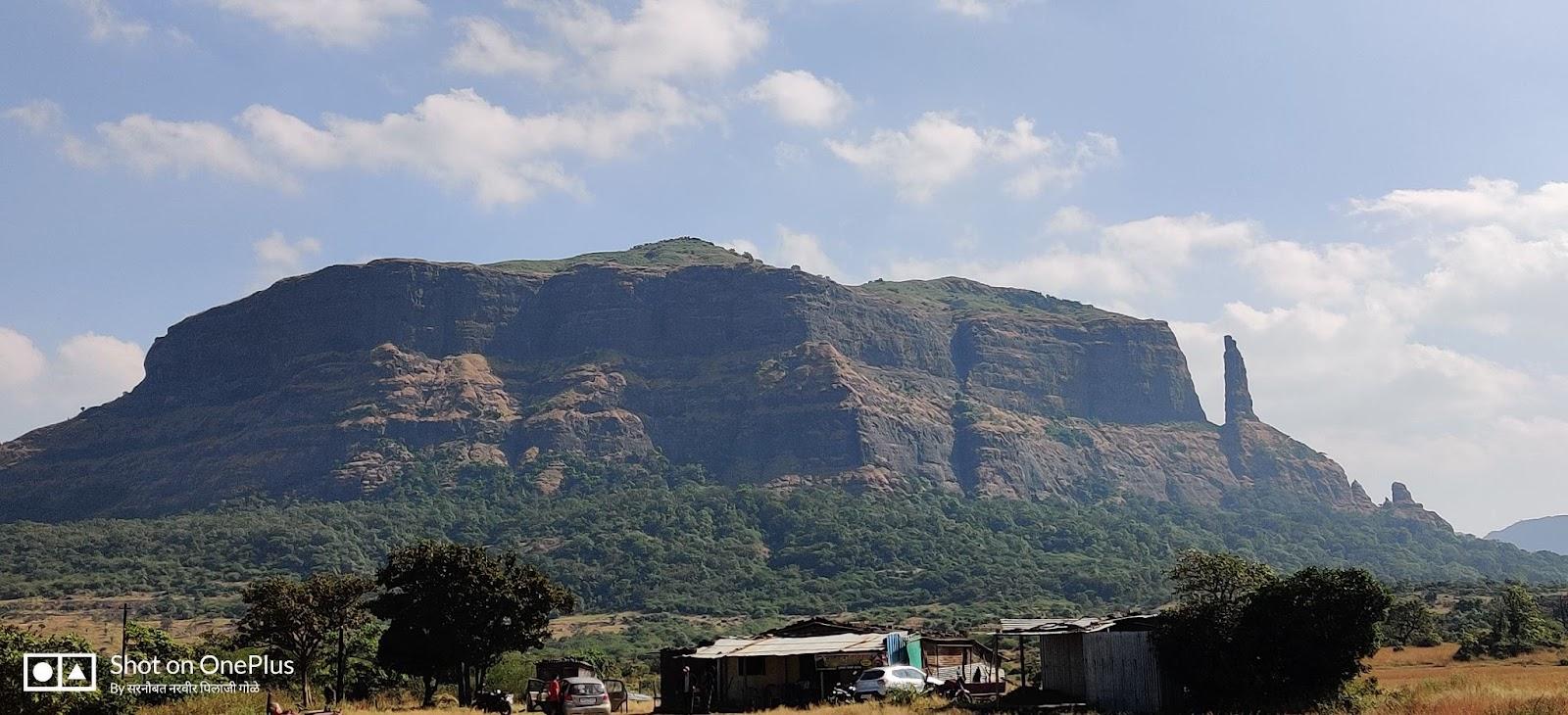
Its structure is considered architecturally similar to that of Shivneri Fort, another major fortification in the region. A motorable road from Junnar leads to the base of the fort, followed by a steep mile-long climb to the summit. Historically, the main gate faced west toward Naneghat and was accessed via a long stairway, partially built and partially rock-cut, which was later destroyed.
Jivdhan Fort traces its origins to the Satavahana period, regarded as Maharashtra’s earliest ruling dynasty. Gautamiputra Satkarni, a prominent Satavahana ruler, is believed to have fortified this region while developing trade routes across the Sahyadri ranges. The nearby Naneghat Pass, active as early as the 1st century BCE, served as a key trade corridor linking the Konkan ports with the Deccan plateau.
In the medieval period, the fort came under the Bahmani Sultanate, followed by the Nizam Shahi dynasty. It was captured by Ahmad I in 1487, and remained under Nizamshahi control until the dynasty’s decline. The fort is notable as the prison of Murtaza Shah III, the last Nizam Shahi ruler, who was later rescued by Shahaji Raje Bhonsale, father of Chhatrapati Shivaji Maharaj. In 1637, Shahaji handed over Jivdhan Fort along with five other forts to the Mughals as part of a negotiated settlement. During the Third Anglo-Maratha War, the fort was captured by the British on 3 May 1818.
The fort’s strategic importance led to its partial dismantling by the British in 1820. The stairway was destroyed, and the tunnel to the main gate was filled in, rendering it unusable. Despite the damage, many features of the original fort remain. These include rock-cut water reservoirs, a granary, and a stone shelter, which provide insights into the fort’s historical infrastructure and use.
Jivdhan Fort contains two primary entrances: the Kalyan Darwaza, which faces Naneghat, and the Junnar Darwaza, located on the route from Ghatghar. Both gates are built at right angles to the steps and are concealed by bastions, making the fort difficult to spot even upon nearing its summit.

Joshi’s Museum of Miniature Railways
Joshi’s Museum of Miniature Railways is located in Kothrud and features a collection of miniature railway models curated and built by B. S. Joshi, popularly known as Bhau Joshi. The museum reflects Joshi’s lifelong interest in mechanical models and railway systems, developed from an early age when he constructed miniature forts (killas) during Diwali. Over time, his interest expanded to include moving mechanical models such as fire engines and cars, eventually culminating in an extensive collection of miniature trains assembled over four decades.
![Bhau Joshi (L) created a permanent museum for miniature railway models after the success of his initial exhibitions in Pune and Mumbai.[25]](/media/culture/images/maharashtra/pune/cultural-sites/bhau-joshi-l-created-a-permanent-museum-f_a19jnzH.jpg)
Following a series of exhibitions held in Pune and Mumbai, Joshi initially planned to create a mobile layout to display his railway models across Maharashtra. However, due to logistical limitations, he established a permanent facility. The museum is housed in a dedicated hall built in 1991 on the premises of Soudamini Instruments, a company Joshi founded in 1962. It was officially opened to the public on 1 April 1998, and in 2004, it was listed in the Limca Book of Records as the only museum in India to feature operational miniature railway systems representing models from around the world.
The centrepiece is a rotating miniature city on an 18 ft. diameter platform, featuring working models of 15 types of trains, including old steam engines and Japan’s bullet train. These scale models are displayed through a theme-based light-and-sound show, which includes intricate details like residential buildings, business centres, highways, a moving restaurant, a circus with a rotating tent, tiny animals, people, and mountains. The models, 87 times smaller than their actual size, are complemented by 65 signals, fences, lamp posts, and flyovers, all created using chemical etching techniques. A unique scene in the show depicts the transition from day to night, complete with illuminated buildings, adding a realistic touch.
![The Joshi’s Museum of Miniature Railways in Kothrud showcases detail oriented miniatures forming an entire city.[26]](/media/culture/images/maharashtra/pune/cultural-sites/the-joshis-museum-of-miniature-railways-i_6nf1weo.jpg)
The museum’s control panel allows for both manual and computer-operated demonstrations, reflecting Joshi’s interest in combining creative presentation with technical precision. The facility draws an estimated 30,000 visitors annually and has become a popular tourist attraction in Pune.
The museum also highlights the multidisciplinary aspects of railway modelling, which involve elements of architecture, engineering, physics, chemistry, and mathematics. It has been visited by students, hobbyists, and researchers interested in the technical and design aspects of miniature railway systems.
Karla Caves
The Karla Caves are located in Karla village near Lonavala and form part of a larger network of cave complexes along an ancient trade route in western Maharashtra. This group includes 16 rock-cut caves, believed to be among the oldest in the region, built between the 2nd and 5th centuries BCE. These structures were commissioned by rulers of ancient India to serve as residential quarters for Buddhist monks and merchants, who often engaged in trade with outsiders. The caves typically included prayer halls, assembly spaces, and shrines.
The chaityagriha at Karla is considered to be one of the finest and best-preserved examples of its kind in India. Its wooden ceiling, remarkably intact over centuries, is considered an architectural marvel. It is also the largest rock-cut chaitya hall in the country. A long corridor leads to a central dagoba (stupa), flanked by intricately carved rock-cut panels on either side.
![The chaityagriha of Karla Caves, Lonavala, Pune district, which is considered by many to be among the finest and best-preserved examples of its kind in India.[27]](/media/culture/images/maharashtra/pune/cultural-sites/the-chaityagriha-of-karla-caves-lonavala-_2qVSKaD.png)
In front of the chaityagriha stands a stone stupa known as the Lion Stupa, crowned with four lions facing different directions. Two octagonal pillars mark the entrance, and the rear of the chaitya opens to a Mandir whose outer walls are adorned with carvings of men, women, and animals such as elephants. The architectural design of the chaityagriha closely resembles features seen in the viharas of the Nashik Caves and the Chaityas of the Kanheri Caves.
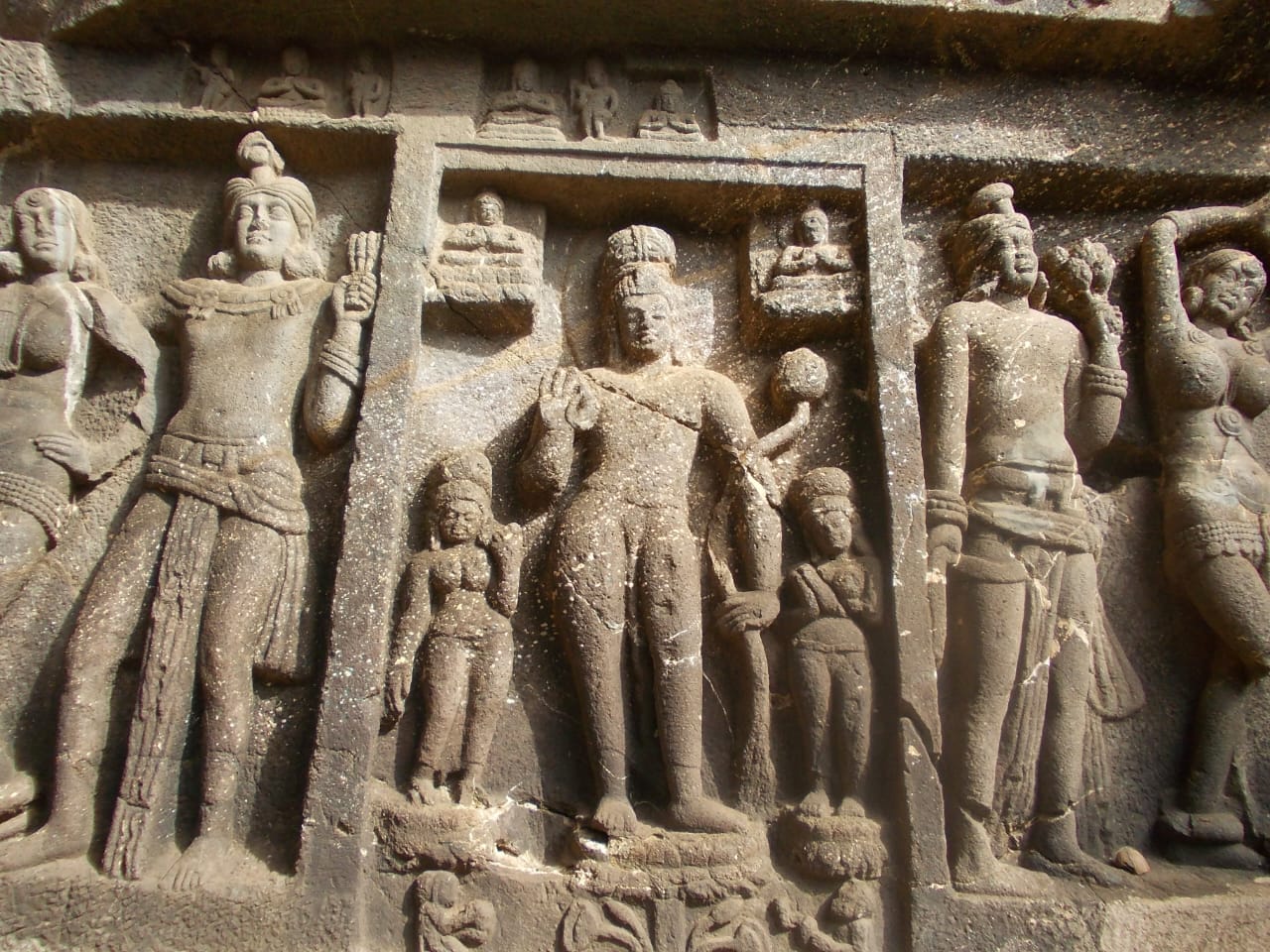
Kasba Ganpati Mandir
Kasba Ganpati Mandir, located in Kasba Peth, is dedicated to Bhagwan Ganpati, the gramdevta of Pune. The Mandir holds a central place among the city’s Manache Ganpati, a group of five revered Ganpati mandals that lead the Ganesh Chaturthi immersion procession each year.
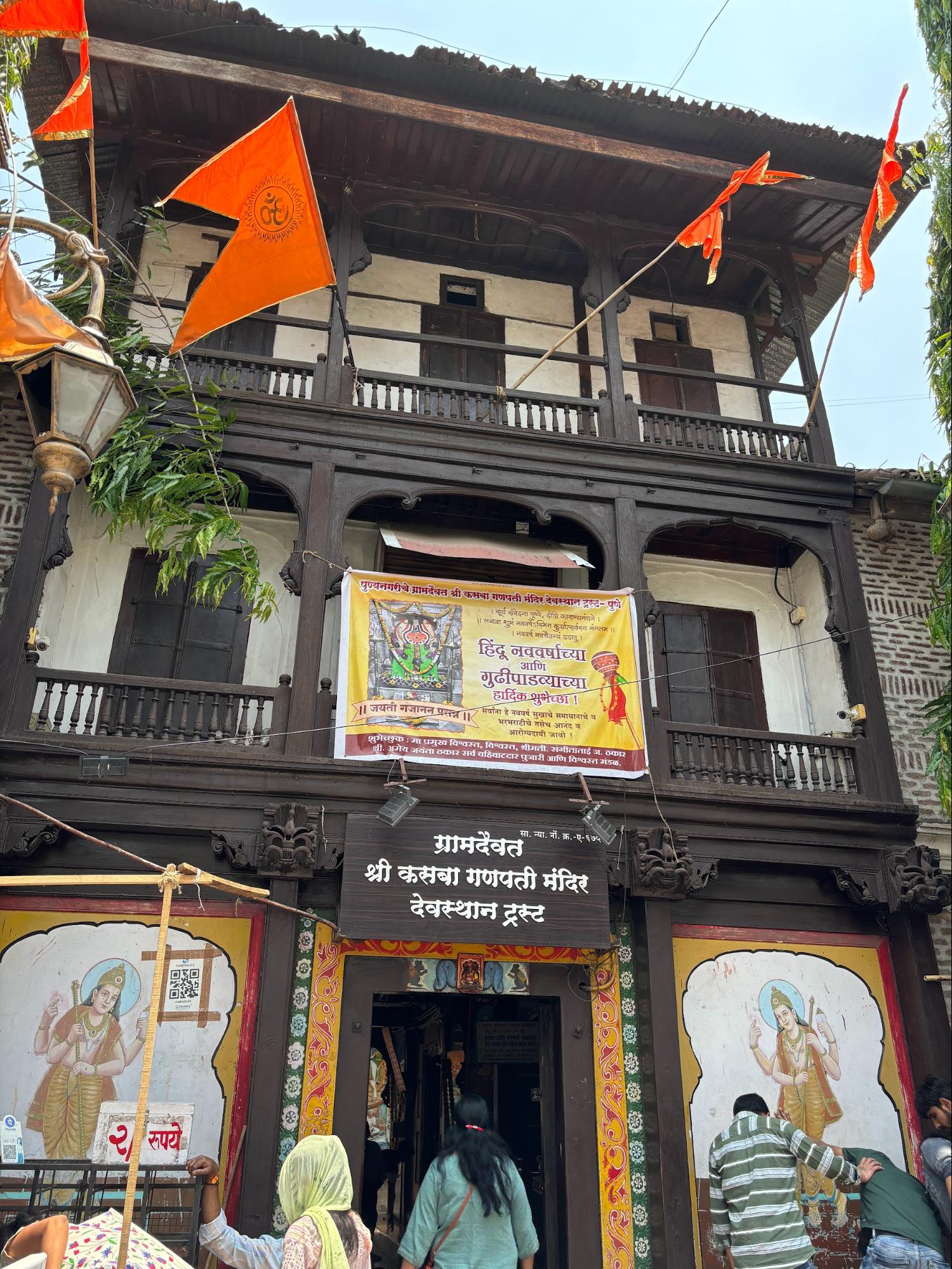
The origins of the Mandir are closely linked to Chhatrapati Shivaji Maharaj (1630–1680, founder of the Maratha Empire) and his mother Rajmata Jijabai Bhonsale (1598–1674). In the 17th century, following damage caused by Adilshahi forces, the Mandir was reconstructed under Jijabai’s initiative. During this period, Dadoji Konddeo (administrator and guardian to young Shivaji) oversaw Shivaji’s early training in governance, while worship of Bhagwan Ganpati at this site was revived and brought into the public sphere.
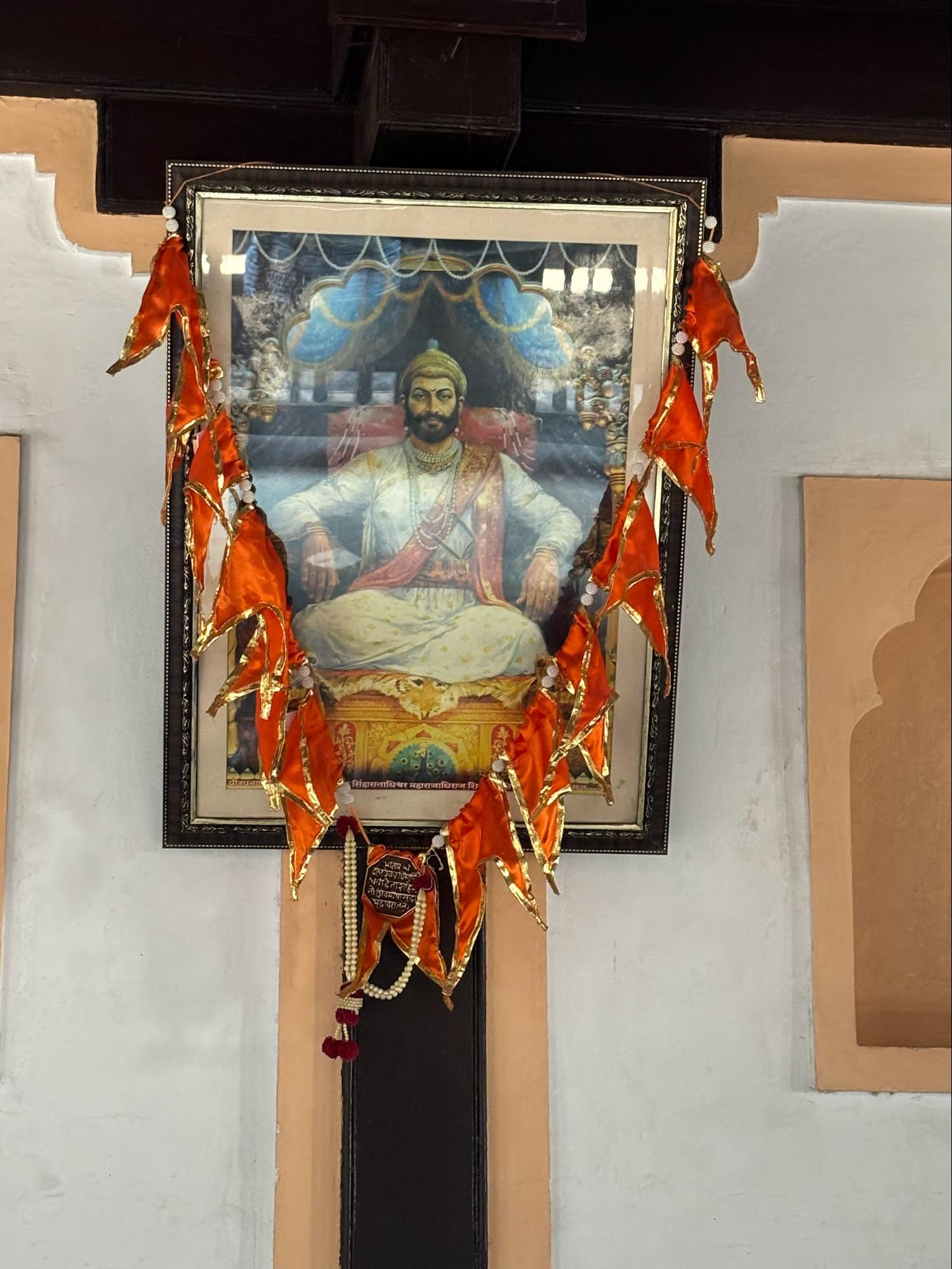
The Mandir gained further importance in the late 19th century. In 1893, during the formation of public Ganeshotsav celebrations in Pune, a dispute arose regarding the order of processions. Bal Gangadhar Tilak (1856–1920, nationalist leader and social reformer), who promoted Ganeshotsav as a vehicle for public unity and resistance under colonial rule, declared Kasba Ganpati as the Manacha Pahila Ganpati (first revered Ganpati). Since then, the Mandir has held the honour of leading the annual immersion procession in Pune.
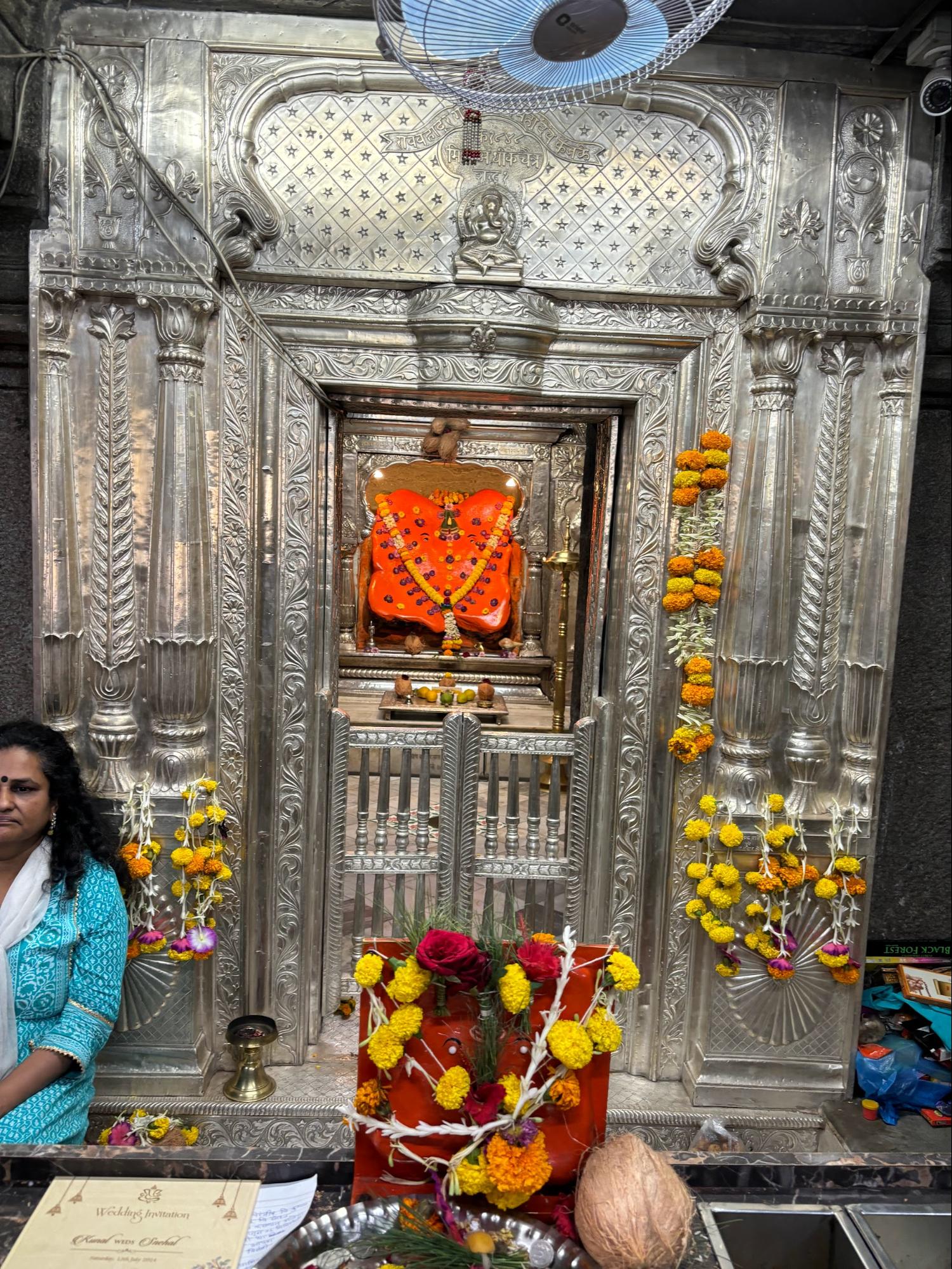
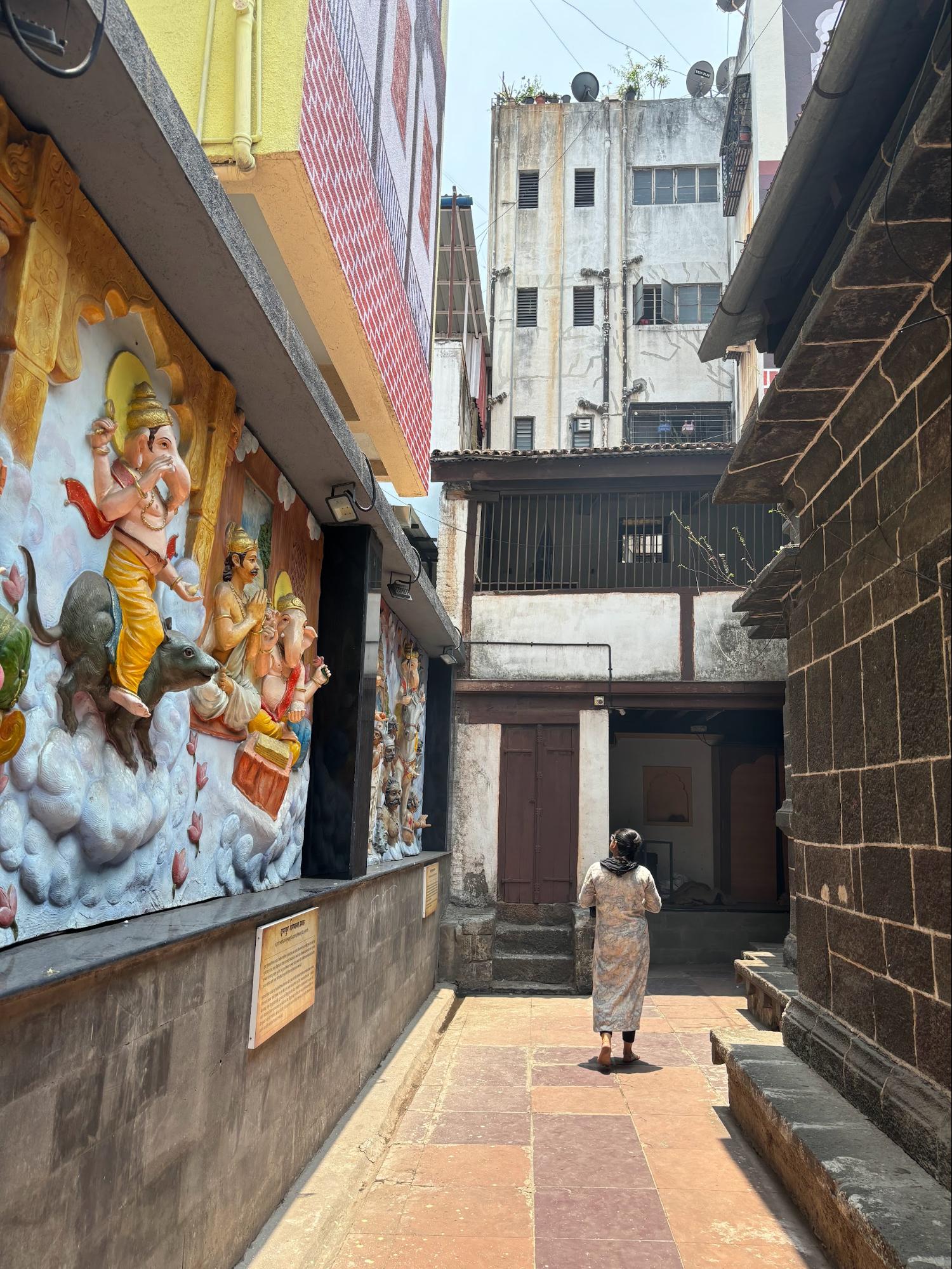
The priesthood of the Mandir has remained with the Thakar family, originally migrants from Karnataka, who were entrusted with its care and granted annual support. This hereditary stewardship, notably, continues even today.
Kesariwada
Kesariwada, once known as Gaekwadwada, is located in Narayan Peth, Pune. Its story begins with Maharaja Sayajirao Gaekwad III of Baroda (1863-1939), the building’s first resident and a known reformer. In 1905, the wada was bought by the Indian nationalist and freedom fighter Lokmanya Bal Gangadhar Tilak (1856-1920), who turned it into both his home and a hub of political activity.
After the purchase, the space was divided for two purposes. Tilak lived in the eastern section, while the western wing became the printing office of Kesari, his influential Marathi newspaper that played a major role during India’s freedom struggle.
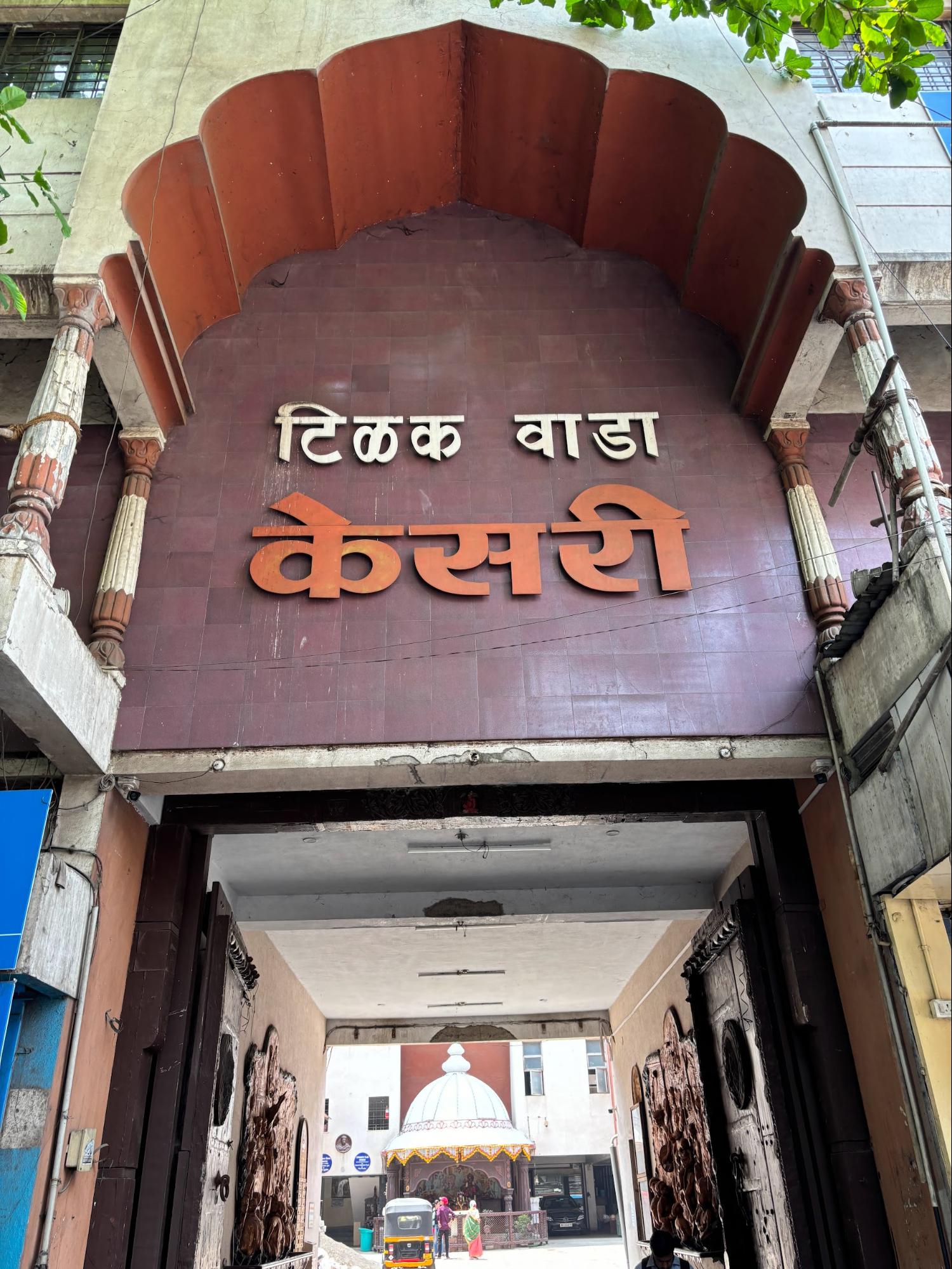
Just inside the entrance is a plaque showing Tilak leading a Ganesh procession. This visual symbolises one of Tilak’s most influential legacies, transforming the Ganesh Chaturthi celebration from a private religious ritual into a public, collective event. In 1893, he popularized the Sarvajanik Ganeshotsav, using it as a vehicle for political awareness and social unity during the colonial period when public gatherings were otherwise restricted.
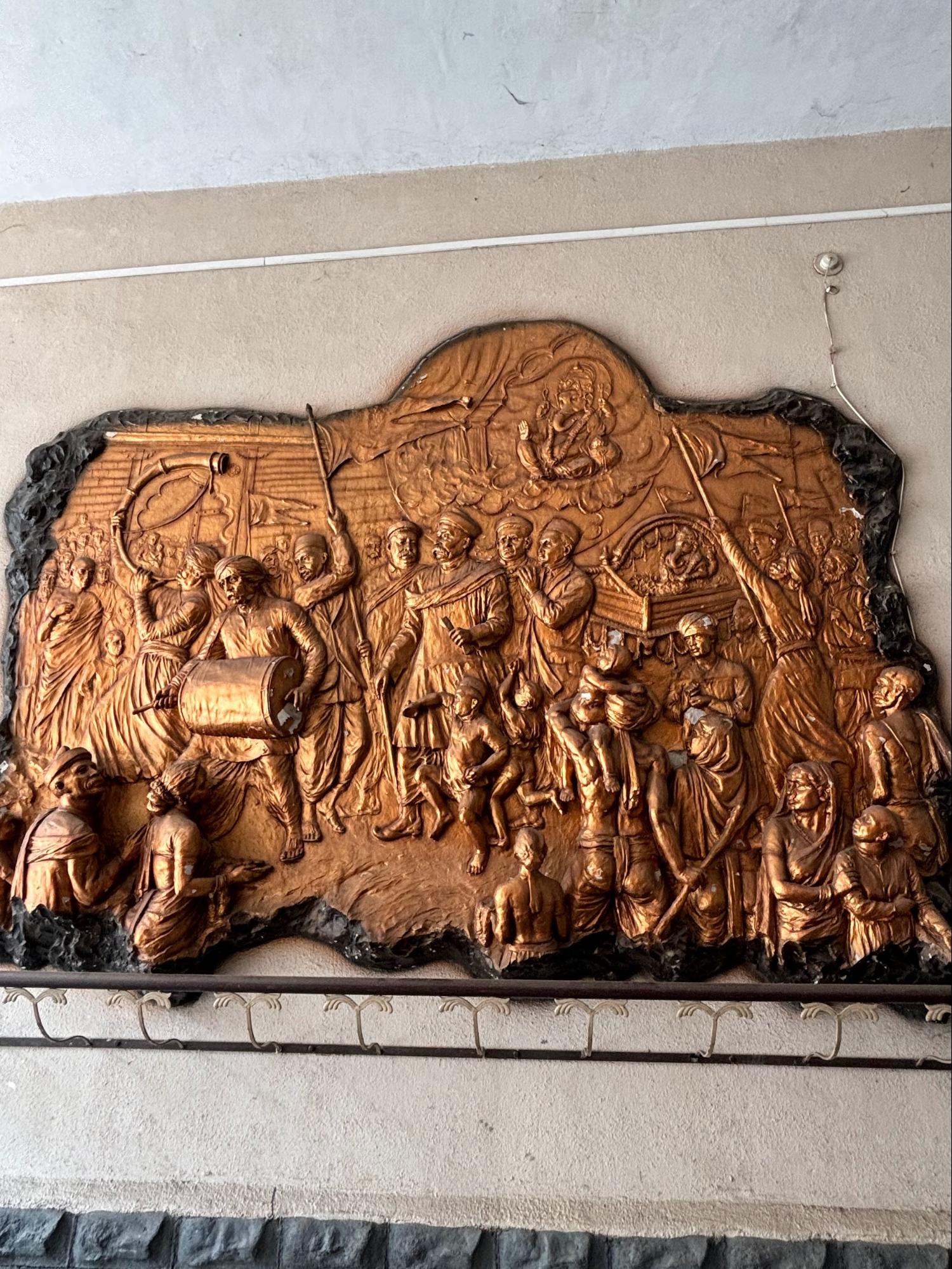
As visitors enter the central courtyard, they are greeted by the Ganpati murti enshrined by Tilak himself. The Kesari Wada Ganpati is regarded as the “Manacha Pachva Ganpati” (The Fifth Respected Ganpati) among the 5 “Manache Ganpati” in Pune.
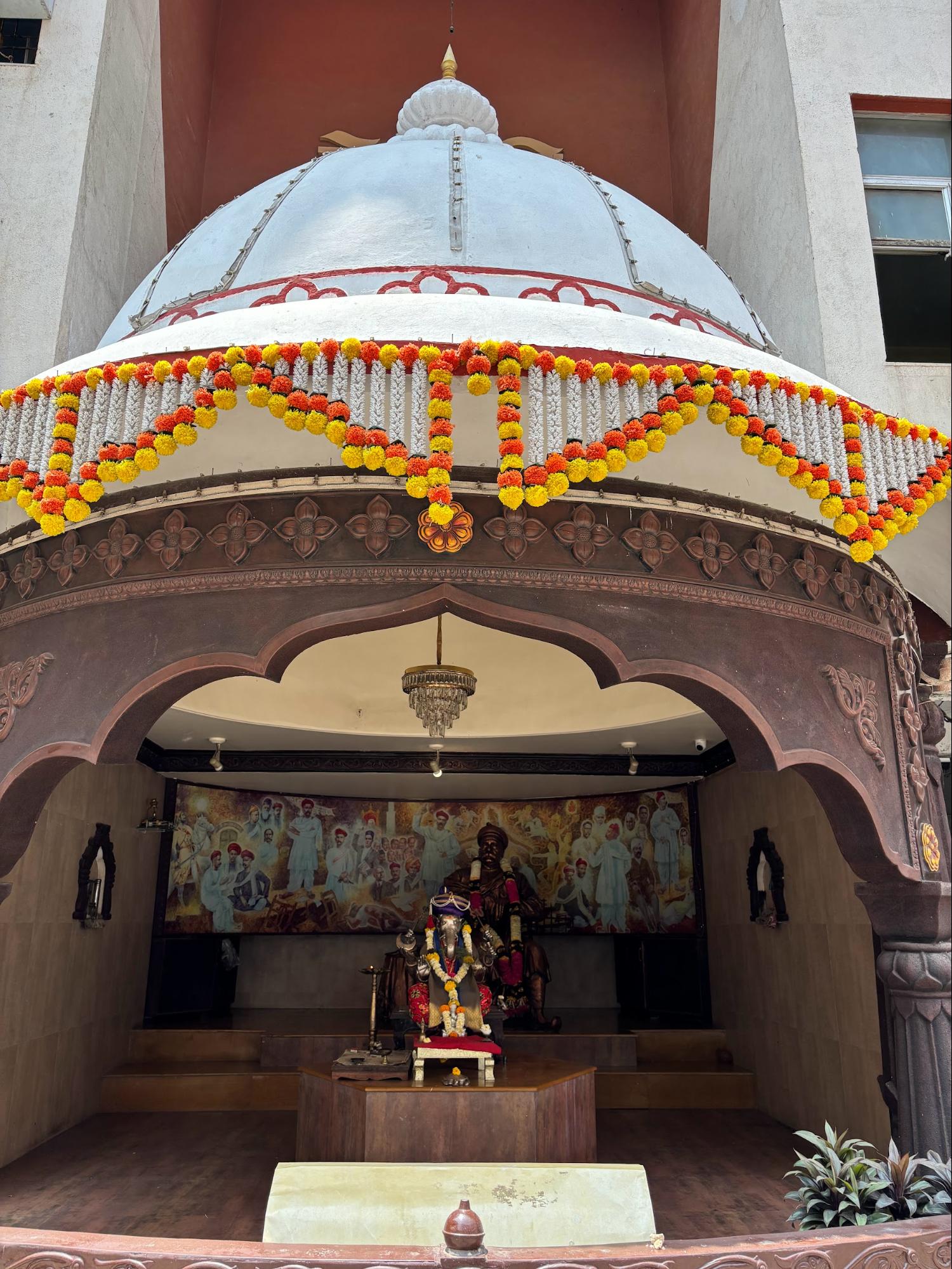
Positioned directly behind the murti is a bust of Tilak, honouring his role in shaping both the festival and the broader nationalist movement.

Inside the wada, Tilak’s residential quarters have been carefully preserved, particularly his study, which still holds his desk, shelves, and personal effects. Adjacent to it is a museum that offers a deeper look into his life and legacy. On display are letters, photographs, and the original press that printed Kesari.
One of the museum’s highlights is a replica of Tilak’s cell in Mandalay Prison, where he was held by British authorities from 1908 to 1914. During his imprisonment, he wrote Gita Rahasya, a philosophical work on duty and righteousness, grounded in the Bhagavad Gita. Another rare exhibit is the first Indian tricolour, hoisted by Madam Bhikaji Cama at the International Socialist Conference in Stuttgart in 1907. Notably, a dedicated archive preserves every edition of Kesari from its founding in 1881 to the present, stored in microfilm format.
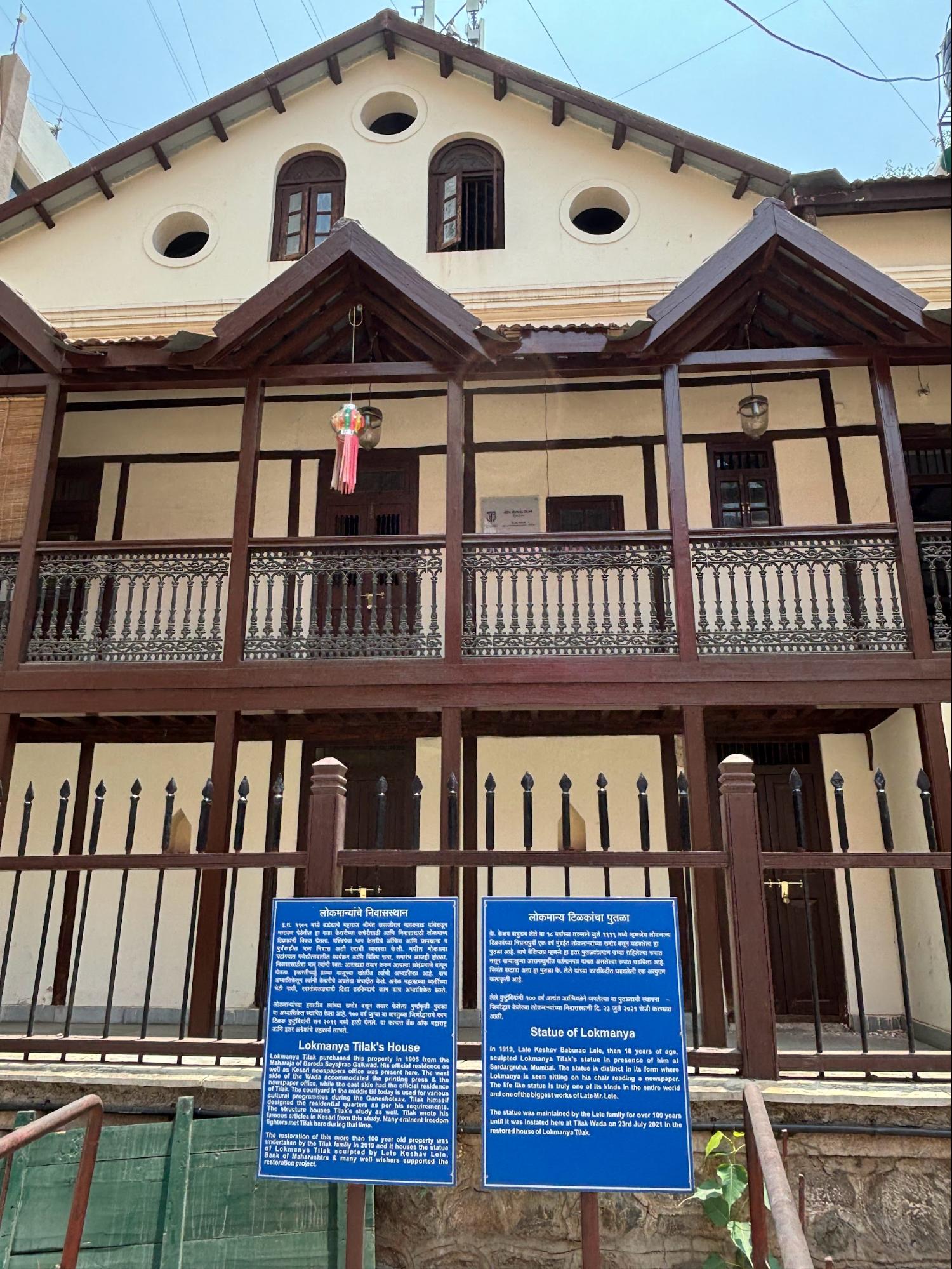
To this day, Tilak’s descendants reside in Kesariwada. Many have remained connected to journalism, public life, politics, and education. The Kesari Maratha Trust, founded in 1881, continues to publish the newspaper and maintain the premises.
Khunya Murlidhar Mandir
![Front view of the Khunya Murlidhar Mandir, Sadashiv Peth, Pune.[28]](/media/culture/images/maharashtra/pune/cultural-sites/front-view-of-the-khunya-murlidhar-mandir_igFXJk4.png)
Khunya Murlidhar Mandir is a Mandir dedicated to Bhagwan Krishna, and is located in Sadashiv Peth. The Mandir was built by Dada Gadre in 1798. It is said that Dada Gadre who was a merchant and money lender to the Peshwas, had a dream that supposedly Bhagwan had ordered him to build a Mandir. Thus, he constructed a Mandir in Karkolpura, to the east of his garden.
‘Khunya’ seems to be a peculiar adjective to the Mandir. Khunya in marathi, (the local language in Pune) means murderer. The atypical name alludes to its bloody past. It is said that Gadre had commissioned a renowned Jaipur sculptor Bakhatram, to create marble statues of Tandav Murlidhar, dancing Krishna, Radha, and two cows with calves. He intended to place these sculptures in the Murlidhar Mandir. However Bajirao II, the Peshwa, was enamoured by the grace and elegance of the dancing Krishna and desired to have it installed in Shaniwar Wada. Gadre refused to honour Bajirao’s wishes.
In the early hours of 6 May 1797, Gadre decided to shift and install the sculptures. He deployed 200 Arab soldiers outside the Mandir because he anticipated conflict with the Peshwa monarch. To block the shifting of sculptures, Bajirao had assigned his army under the command of British chief Boyd. The two sides engaged in a brutal combat during which 50 to 100 troops are estimated to have been killed. Gadre was held captive for 23 years by Bajirao II and only released when the British took control in 1820. Thus it is known as the Khunya Murlidhar Mandir.
The Mandir was built in Peshwa architectural style. The garbhagriha is built from white marble. Mandirs for other Bhagwans including Radha and Garuda (Bhagwan Vishnu's eagle-borne vehicle) are also situated in the larger Mandir complex. Chandeliers, handis, and surface embellishments adorn the wooden sabhamandap. The room's walls and columns are beautifully decorated with carvings and paintings from that era.
Killa-e-Hissar
Killa-e-Hissar is a medieval fort located in Kasba Peth, Pune, and serves as an early marker of the city’s urban and administrative development. The fort was constructed in 1290 CE by Bariyah Arab (13th-century Arab military commander under the Khalji Dynasty) and functioned as both a residential and administrative structure along the banks of the Mutha River.
Around the same period, Bariyah Arab also established one of Pune’s earliest markets in the area. This artisan settlement was referred to in Persian as ‘Kasbah’, meaning a fortified town or marketplace. Home to potters, bangle makers, gardeners, and cultivators, this early settlement formed the nucleus of what would later be known as Kasabe Pune, now recognised as Kasba Peth, one of the oldest areas in the city.
![The staircase believed to have once led to the western gate of Killa-e-Hissar, known as Konkan Darwaja. Though now paved, historians note that the alignment and layout remain largely unchanged. These steps are thought to have been used for centuries, connecting the fort to surrounding settlements that eventually formed Kasabe Pune, what is now Kasba Peth.[29]](/media/culture/images/maharashtra/pune/cultural-sites/the-staircase-believed-to-have-once-led-t_46YVUF7.png)
During the 14th and 15th centuries, Junnar Pargana, which included Pune, was a prominent region under the Bahmani Sultanate. It was initially overseen by Mahmud Gawan (1411–1481, vizier and military strategist of the Bahmani Sultanate), also known by the title Malik-ut-Tujjar, who constructed Sangramdurg Fort in Chakan.
After his death, Kasam Beig Shafaat Khan, popularly known as Bariyah Arab (d. 1480, successor to Mahmud Gawan and ruler from Chakan), continued to govern the region. In 1460, he is believed to have commissioned a fort in Pune on an archaeological mound known locally as gaon-pandhar.
Today, Killa-e-Hissar stands as a tangible link to Pune’s early political and urban history, marking its transformation from a fortified artisan settlement into the city’s historical core.
Koregaon Ranstambh
The Koregaon Ranstambh is a memorial pillar located in Bhima Koregaon, a village in Shirur taluka, on the eastern bank of the Bhima River. The pillar was erected in 1851 by the British to commemorate the soldiers who fought in the battle that took place at this site on 1 January 1818, during the Third Anglo-Maratha War.
![An archival photograph of Dr. B.R. Ambedkar at Bhima Koregaon, Pune. Dr. Ambedkar visited the Koregaon Ranstambh annually on 1 January to honour the Mahar soldiers who fought in the 1818 battle. His visits transformed the site into a place of collective memory and a symbol of resistance against caste-based oppression.[30]](/media/culture/images/maharashtra/pune/cultural-sites/an-archival-photograph-of-dr-br-ambedkar-_G3dn7H8.png)
The stone memorial records the names of many soldiers from the Mahar regiment who were part of a British detachment sent to defend Koregaon. Although the Peshwa army, led by Peshwa Baji Rao II (1796–1818), greatly outnumbered the British forces, the village remained under British control by the end of the day. The names inscribed on the Ranstambh are among the earliest known instances of Dalit soldiers being publicly commemorated in stone.
Over time, the pillar has come to carry layered meanings. Since the 20th century, the site has been a place of gathering and remembrance for members of the Dalit community. Followers of Dr. B.R. Ambedkar began observing the battle’s anniversary, now known as Koregaon Bhima Shaurya Din, who saw the event as a day of historical significance in the struggle against caste-based discrimination.
Unfortunately, violence broke out during the annual gathering on 1 January 2018 at Koregaon Bhima, held to mark the 200th anniversary of the Battle of Koregaon. The 2018 Koregaon Bhima riots resulted in several incidents of unrest and received widespread national attention.
Lal Mahal
Lal Mahal, located in Kasba Peth, Pune City, is a historic structure of cultural and political significance in Maratha history. The original palace was constructed in the 16th century under the supervision of Dadoji Kondadeo (c. 1570–1647, administrator and guardian of Shivaji Maharaj) on land donated by the Zhambre-Patils (a prominent local landowning family). Built using wood and red bricks, the structure exemplified the construction techniques of its time. The present-day building reflects elements of medieval Maratha architecture and serves as a popular destination for residents and tourists exploring its rich heritage.
![The anterior of Lal Mahal at Kasba Peth, Pune.[31]](/media/culture/images/maharashtra/pune/cultural-sites/the-anterior-of-lal-mahal-at-kasba-peth-p_SVrLHBd.jpg)
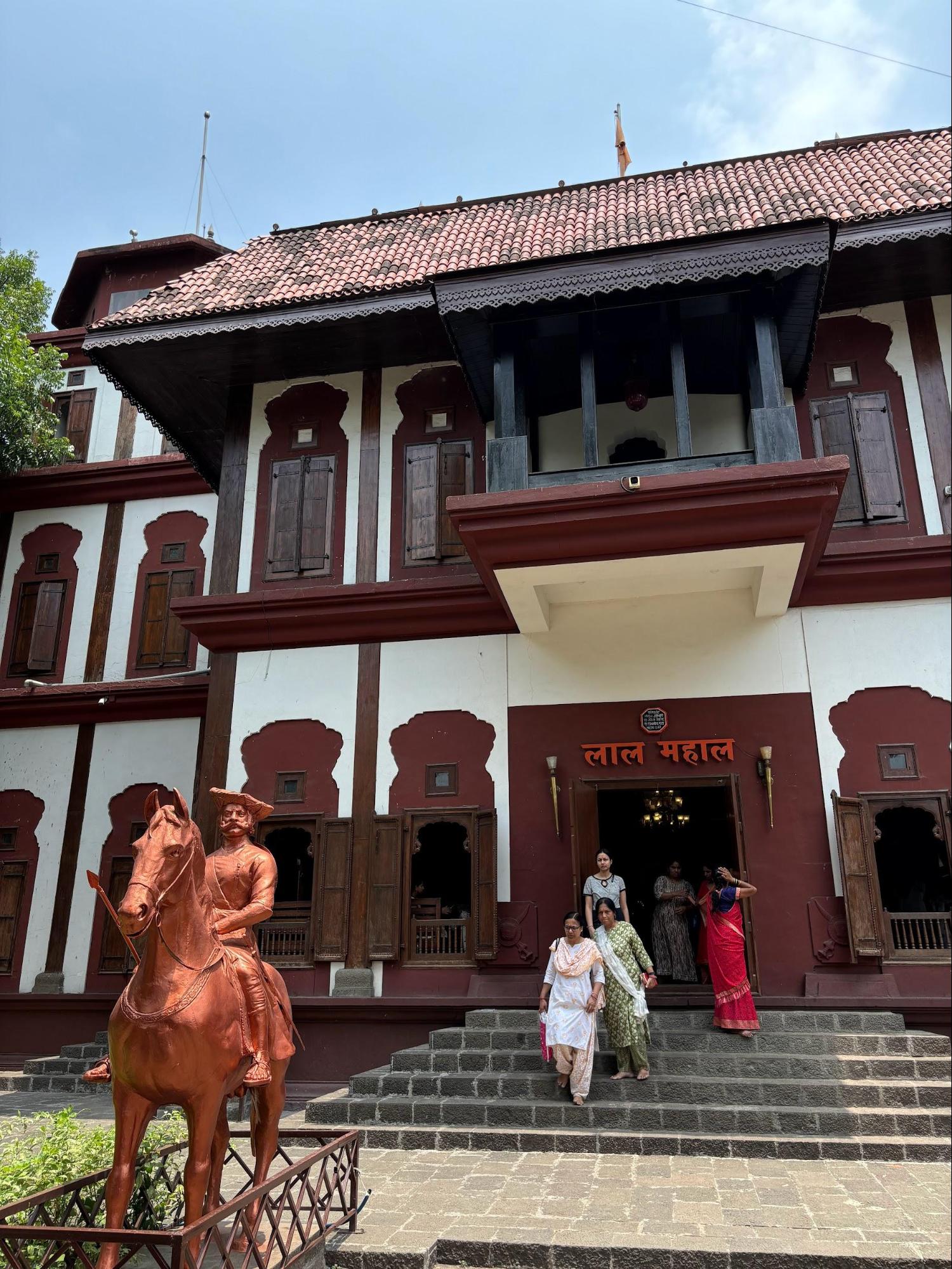
![The bust of Rajmata Jijabai within Lal Mahal.[32]](/media/culture/images/maharashtra/pune/cultural-sites/the-bust-of-rajmata-jijabai-within-lal-ma_YImdGrJ.jpg)
The palace was home to Shivaji Maharaj during his formative years, where he received early education under the guidance of his mother Rajmata Jijabai and Kondadeo as his mentor. The palace now functions as a museum, featuring exhibits related to Shivaji’s life and Maratha history. Key displays include a bust of Jijabai, a sculpture of Shivaji holding a golden plough (symbolising prosperity and agrarian reform), a map of forts associated with Shivaji, and an oil painting depicting the 1663 raid by Mughal general Shaista Khan.
Lal Mahal is closely associated with a significant event in Maratha history that took place in 1663, during the Mughal campaign in Pune. At the time, Shaista Khan (c. 1600–1694, Mughal general and maternal uncle of Emperor Aurangzeb) had occupied the palace as a military base. In a well-planned night raid, Shivaji Maharaj (1630–1680) led around 400 Mavala soldiers (Maratha infantry from the Sahyadri hills) in an assault on the fort. The Marathas used their knowledge of the local terrain to infiltrate the palace undetected. In the attack that followed, Shaista Khan was injured, losing three fingers, while his son and several members of his household were killed. The incident is widely regarded as a turning point in Maratha resistance, illustrating Shivaji’s tactical brilliance and command over guerrilla warfare.
![The oil painting at Lal Mahal depicting Shaista Khan’s narrow escape from Shivaji Maharaj.[33]](/media/culture/images/maharashtra/pune/cultural-sites/the-oil-painting-at-lal-mahal-depicting-s_IInR7VG.png)
Lal Mahal is also associated with the foundation of Shaniwar Wada, the seat of the Peshwas. It is said that soil and stones from Lal Mahal were used in laying the foundation of Shaniwar Wada, a symbolic gesture believed to bring prosperity. By 1730, the original structure had deteriorated. In recognition of its historical value, Peshwa Bajirao I commissioned Ranoji Scindia (founder of the Scindia dynasty) and Ramchandra Pant Amatya (1650–1716, senior Peshwa administrator and author of the Adnyapatra) to oversee its restoration.
Today, Lal Mahal remains a significant heritage site in Pune, reflecting the formative period of Shivaji Maharaj’s life and the early Maratha resurgence.

Limbraj Maharaj Vitthal Mandir (Zanjale Vitthal Mandir)
![Limbraj Maharaj Vitthal Mandir, Budhwar Peth, Pune.[34]](/media/culture/images/maharashtra/pune/cultural-sites/limbraj-maharaj-vitthal-mandir-budhwar-pe_0JiW7Hq.png)
The Limbraj Maharaj Vitthal Mandir in Budhwar Peth is an 18th century Mandir dedicated to the Marathi Sant Limbaraj Maharaj. The Mandir contains a garbhagriha, a pradakshina path and a prayer hall. Interestingly, the hall comprises a gallery which is common in church and synagogue architecture but rarely found in a Hindu mandir. The primary materials used in its construction are stone and wood.
The Mandir mainly celebrates festivals related to the Hindu Bhagwan Vishnu, such as Ashadhi Ekadashi (celebrated in the Hindu month of Ashadh, that is during June-July), Kartiki Ekadashi (celebrated in the Hindu month of Kartik, usually around October-November), and Vaikunth Ekadashi (celebrated in December or January). Additionally, devotees look forward to the three-hour bhajans every Saturday which are conducted by singers trained in Hindustani classical music. Some well-known singers who perform here are Anande Bhate, Ashwini Tilak, and Atul Khandekar.
Maharshi Karve Museum
The Maharshi Karve Museum, located on Karve Road in Pune, is dedicated to the life and work of Dhondo Keshav Karve (1858–1962), popularly known as Maharshi Karve. A prominent social reformer, educator, and activist, Karve is widely recognised for his pioneering efforts in advancing women’s education and promoting self-reliance for widows during the late 19th and early 20th centuries.
A professor of mathematics at Fergusson College, Karve established the Maharshi Karve Stree Shikshan Samstha (MKSSS) in 1896 with the aim of empowering women through access to education and vocational training. He promoted a model of education that supported both learning and earning, commonly described as the ‘earn and learn’ approach. Today, MKSSS has grown into a major educational organisation, operating 64 institutions and educating over 30,000 women annually.
![A bronze statue of Maharshi Dhondo Keshav Karve in the middle of his samadhi.[35]](/media/culture/images/maharashtra/pune/cultural-sites/a-bronze-statue-of-maharshi-dhondo-keshav_skXioPn.jpg)
To commemorate Karve’s 150th birth anniversary, the Maharshi Karve Memorial was established by MKSSS in 2007. The museum takes visitors through various phases of Karve’s life, offering insight into the social challenges he faced and his contributions to transforming women’s education in India.
The museum’s permanent collection includes personal items, family records, and academic documents, including his Bachelor of Arts degree from Bombay University. Among the honours displayed is the Bharat Ratna, India’s highest civilian award, conferred in recognition of his contributions to social reform and women’s education. The exhibition also features documents and memorabilia from Karve’s international tours, which he undertook to raise awareness and secure funding for his vision of a university for women. Notably, a photograph of Karve with Albert Einstein at Princeton University is displayed in the third gallery.
![Maharshi Karve was awarded the Bharat Ratna, the highest civilian honour in India, in 1958.[36]](/media/culture/images/maharashtra/pune/cultural-sites/maharshi-karve-was-awarded-the-bharat-rat_xPE9l8M.jpg)
The museum is divided into three main galleries, surrounded by open grounds and an amphitheatre. A memorial to Maharshi Karve is located nearby. Exhibits are arranged in chronological order, with information available in Marathi and English, allowing for independent viewing. A documentary on Karve, produced by the Government of India, is screened for visitors.
![Inside the Maharshi Karve Museum on Karve Road.[37]](/media/culture/images/maharashtra/pune/cultural-sites/inside-the-maharshi-karve-museum-on-karve_dkkYfCq.jpg)
Mamledar Kacheri
Mamledar Kacheri (tax administrator’s office) is located on Shivaji Maharaj road. This building is culturally and historically significant because of renowned Indian revolutionary Umaji Naik’s samadhi. Umaji Naik led a small but significant uprising against the British government in 1831. He belonged to the Ramoshi community, who were traditionally Killedars or those who guard forts.
![Entrance to the Mamledar Kacheri, Chhatrapati Shivaji Maharaj Road, Pune.[38]](/media/culture/images/maharashtra/pune/cultural-sites/entrance-to-the-mamledar-kacheri-chhatrap_vHcXq8R.png)
Naik encouraged Indians to revolt against the British government by not paying taxes, raiding government wealth and rejecting government jobs. In December 1831, he was caught by the British government and imprisoned at the site that would later become Mamledar Kacheri. Before the British turned it into a jail, the premises were likely used by the Marathas for storing ammunition. In February 1832, Umaji Naik was publicly hanged from a large peepal tree on the same premises. His body was left hanging for three days as a warning to others. In his memory, a samadhi was later constructed at the site. The location eventually came to be known as Mamledar Kacheri, which now houses offices of the revenue department, the settlement commissioner, and a local police station.
Mastani’s Grave
Mastani’s grave is located in the village of Pabal, around 60 km from Pune city. The site is a small courtyard enclosed by a boundary wall with three entrances. At its centre lies a stone tomb believed to be the final resting place of Mastani, the second wife of Peshwa Bajirao I. A diya kund (lamp niche) stands next to the tomb and is lit daily by the caretaker.
The site holds significance for both Hindus and Muslims in the region. Hindus in Pabal refer to it as Mastani’s samadhi, while local Muslims call it Mastani chi masjid. The grave has been maintained by the Inamdar family for generations, who are said to have accompanied Mastani to the Deccan from Bundelkhand.
Mastani was the daughter of Maharaja Chhatrasal and Ruhaani Bai, a Persian-Muslim woman. Initially housed in Shaniwarwada, Mastani was later moved to Kothrud, and eventually to a palace built for her in Pabal. Though the palace no longer exists, local accounts mention that revenue from three nearby villages - Pabal, Tendur, and Loni - was used for her maintenance.
The grave was vandalized in 2009 by miscreants searching for a diamond Mastani was believed to have swallowed. Following this, the state archaeology department restored the site, with support from Umar Ali Bahadur, a descendant of Mastani’s son Shamsher Ali Bahadur. The restoration involved both Islamic and Hindu rituals, reflecting the site’s shared legacy.
Mastani’s grave continues to attract visitors from both communities. A painting of Mastani is displayed on one of the courtyard walls, and the platform at one end was historically used for namaz. The village remembers Mastani in other ways as well: a sword found nearby is preserved by the gram panchayat, and Padmani Jain Mahavidyalaya in Pabal publishes an annual magazine and organises a state-level Bajirao-Mastani debate competition in her memory.
Nana Wada
![Front view of Nana Wada, Shaniwar Peth, Pune.[39]](/media/culture/images/maharashtra/pune/cultural-sites/front-view-of-nana-wada-shaniwar-peth-pun_P0Zqs9f.png)
Nana wada is one of the oldest heritage monuments in the city and stands next to Shaniwar Wada in Shaniwar Peth. It is said to have been constructed in 1780 by Nana Phadnavis, who was the main administrative officer of the Peshwas. It occupies a space of almost 20,000 sq. ft. and offers a glimpse of the Peshwa era.
Nana wada is one the most striking examples of Peshwa architecture. It is made of ‘sagwan’ wood. Its wooden structure is replete with elaborate carvings and floral designs. The walls inside Nana wada depicted several paintings, most of which cannot be seen clearly now. The first storey of Nana wada has a diwan khana from where the Peshwa used to address his ministers. Diwankhan employs the use of black polished wood. Nana wada also has an emergency exit stairway which directly opens outside the palace. Much of the earlier construction was replaced with a new stone building and was constructed in British Gothic (revival) architectural style. Thus, it differs from the rest of the structure in appearance and style.
The site was acquired by the Pune Municipal Corporation (PMC) from the Deccan Education Society in 1953. Conservation efforts were started in 2010. Today, there is a municipal school and government records office inside Nana wada. A new museum named “Swarajya—Journey of Freedom Fighters” has also been established within Nana wada’s premises.
Naneghat Pass and Caves
Naneghat, located in the Junnar region of Pune, is an ancient mountain pass in the Western Ghats that historically connected the Konkan coast with the Deccan plateau. Today, it is known both as a trekking destination and a significant archaeological site.
The name ‘Naneghat’ literally means ‘coin pass’ (nane meaning coin in Marathi). Near the pass is a large 2,000-year-old stone urn believed to have been used to collect tolls from traders passing through. This unique feature suggests that Naneghat once functioned as a toll collection point, possibly one of the earliest documented in the Indian subcontinent.
![Naneghat Pass in Junnar, Pune.[40]](/media/culture/images/maharashtra/pune/cultural-sites/naneghat-pass-in-junnar-pune40-5822f3b3.jpg)
Naneghat was a vital part of a major trade route that connected the Satavahan capital at Paithan with the port city of Sopara on the Arabian Sea. Goods, traders, and caravans regularly moved through this corridor, helping the Satavahana dynasty finance its empire through inland and maritime trade, including links with Rome. The rock-cut caves at Naneghat, carved during the early Satavahana period, served as rest stops for traders and spaces for Buddhist worship and meditation.
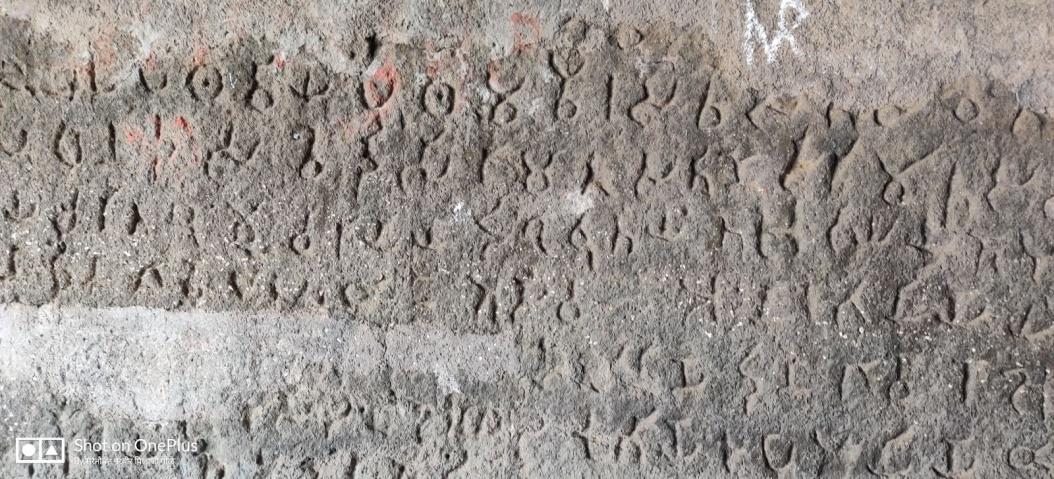
One of the most remarkable discoveries in the caves is the Naneghat inscription, found in 1970 and dating back to the 2nd century BCE. Written in the Brahmi script, this inscription sheds light on the cultural and historical significance of Naneghat. It mentions the name of Queen Naganika, the wife of Satavahana King Satakarni, offering valuable insights into the life and traditions of the Satavahana Dynasty.
In the present day, Naneghat remains popular with trekkers, historians, and nature enthusiasts. The trail passes through forested slopes, streams, and rock formations, with the caves offering a glimpse into India’s early historic period. The site is valued not only for its natural beauty but also as a lasting reminder of the economic and cultural legacy of early Deccan rule.
Narayangad
Narayangad Fort is located approximately five km east of Narayangaon, in the Junnar taluka of Pune district. Perched atop a detached hill that rises steeply on three sides, the fort historically relied more on its natural topography for defense than on man-made fortifications. It is described in the colonial district Gazetteer (1882) that “its artificial fortifications, which were never very strong, were almost completely dismantled in 1820.” The origins of Narayangad are associated with the Maratha era. It is said that Peshwa Balaji Vishwanath (c. 1662–1720, first hereditary Peshwa of the Bhatt Peshwa family) initiated its construction.

It is believed that the fort was granted as saranjam (a military land grant) to Sayaji Pawar for administrative and military oversight. It later became a hub for revenue collection from villages east of Junnar and came under the stewardship of Udaji Pawar (18th century military officer under Peshwas).
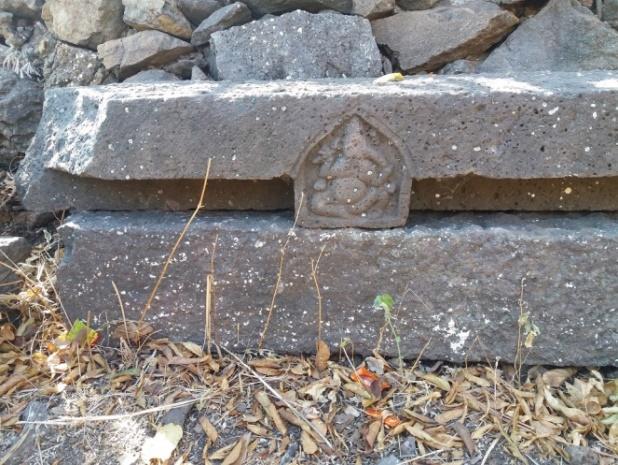
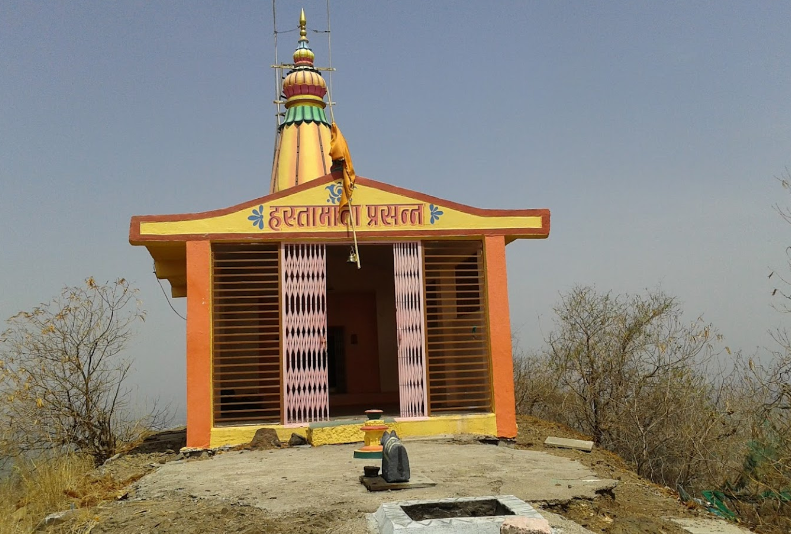
Historical records indicate that during the reign of Chhatrapati Shahu Maharaj (1682–1749, Maratha emperor-reformer), the fort’s final construction phase was overseen by Peshwa Nanasaheb (Balaji Bajirao), son of Balaji Vishwanath. In 1741–42, Antaji Katkar (18th century fort constable and administrator) was appointed as the fort’s killedar (fortress commander).
During the Third Anglo-Maratha War, Narayangad came under siege by British forces in 1818. Following bombardment, Ramrao Narsingh (19th century Maratha officer and fort commander) surrendered the fort on 14 June to Captain Boit (19th century British military officer), under orders from Henry Pottinger (1789–1856, British administrator and diplomat), the then Collector of Ahmednagar (currently Ahilyanagar). Later that year, Captain Eastner (19th century British army engineer) was dispatched to demolish the site, resulting in the destruction of fort pathways, tanks, and remaining defenses.
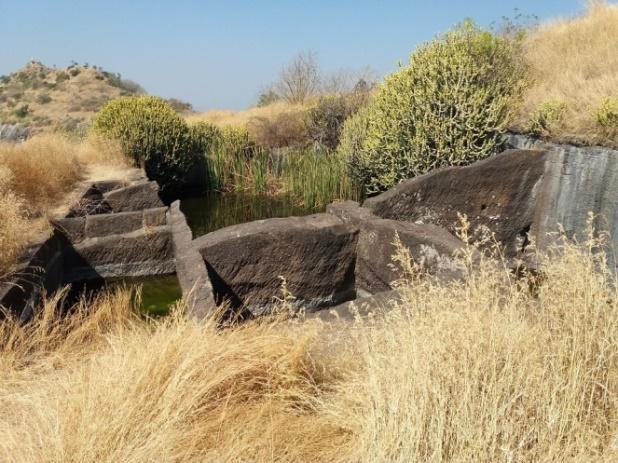
Despite its present-day ruin, Narayangad continues to attract visitors for its panoramic views, spiritual sanctity, and its historical importance as a Maratha-era military outpost.
National War Memorial Southern Command
![National War Memorial in Camp, Pune.[41]](/media/culture/images/maharashtra/pune/cultural-sites/national-war-memorial-in-camp-pune41-1cc42d5f.png)
The National War Memorial Southern Command, also known as the National War Memorial is situated in the Pune Cantonment area and was built in 1998. It is a military memorial that commemorates the sacrifices of soldiers who fought and died in wars involving India after its independence in 1947. This revered memorial is regarded as the only war memorial in South Asia that was entirely built using donations from the public. It stands tall as a symbol of patriotism and courage, representing the unwavering spirit of the Indian Armed Forces.
The National War Memorial Southern Command was unveiled on 15 August 1998, by Lieutenant General S.R. Joshi. The memorial showcases a MiG-23BN fighter jet that was used during the Kargil War, which stands as a testament to the efforts of the Indian Air Force. The memorial also features a replica of the INS Trishul frigate, which was a crucial component of the Indian Navy's efforts during the 1971 Indo-Pakistani War and the liberation of Goa. These displays offer a glimpse into the military history of India and serve as a reminder of the valiant sacrifices made by the country's soldiers. The National War Memorial Southern Command is a significant tourist attraction in Pune and is often visited by both locals and tourists.
Ohel David Synagogue
The Ohel David Synagogue, popularly known as Lal Deval due to its distinctive red-brick façade, is a historic place of worship located on Moledina Road in Pune. Completed in 1867, it stands as one of the largest synagogues in Asia outside Israel and serves as a cultural and religious hub for the city’s Baghdadi Jewish community.
Construction of the synagogue was initiated in 1863 by David Sassoon (1792–1864; philanthropist and trader), a prominent figure in 19th-century Indian commerce and civic development, often referred to as the Merchant Prince of Bombay. After Sassoon’s passing in 1864, the work was continued and completed by his sons, Sir Albert Sassoon (1818–1896) and Elias Sassoon (1820–1880). Notably, the compound of the synagogue houses the mausoleum of David Sassoon.
![The red-brick façade of the Ohel David Synagogue, on Moledina Road, Pune, that earned it the local name “Lal Deval”.[42]](/media/culture/images/maharashtra/pune/cultural-sites/the-red-brick-facade-of-the-ohel-david-sy_PhLRzbK.jpg)
![The beautiful interiors of the Ohel David Synagogue.[43]](/media/culture/images/maharashtra/pune/cultural-sites/the-beautiful-interiors-of-the-ohel-david_2fNeeh0.jpg)
Designed by Henry St. Clair Wilkins, a British military engineer, the synagogue reflects the English Gothic Revival style. The structure combines Deccan Trap stone with imported bricks, and its most iconic feature is the 90 ft. high clock tower, topped with a spire and modeled after a Gothic obelisk. The clock itself was manufactured in London and remains a landmark on Moledina Road.
Oldham Memorial Methodist Church
The Oldham Memorial Methodist Church, a Protestant Methodist Church, is situated on General Thimayya Road in the Camp area. It was built in 1872 and is one of the only two Methodist churches in Pune. The church was constructed under the guidance of Father William Taylor, an American Methodist missionary.
![Pillarless Prayer Hall of Oldham Memorial Methodist Church, Camp, Pune.[44]](/media/culture/images/maharashtra/pune/cultural-sites/pillarless-prayer-hall-of-oldham-memorial_bIdNewr.png)
In 1971, the structure was completely renovated, with only the pastor’s bungalow and the servant’s quarters remaining untouched. A very interesting historic tradition is followed here during Easter, which involves carrying of a wooden cross to Baker’s Hill. The congregation starts before dawn and the service ends with a benediction just before the sun rises.
Osho Ashram
The Osho Ashram, officially known as the Osho International Meditation Resort, is located in Koregaon Park, Pune. It was established in 1974 by Acharya Rajneesh, later known simply as Osho, a spiritual teacher whose discourses combined elements of Vedanta, Zen, Sufism, and Western psychology.
![Main entrance to the Osho International Meditation Resort in Koregaon Park, Pune, founded by Osho in 1974.[45]](/media/culture/images/maharashtra/pune/cultural-sites/main-entrance-to-the-osho-international-m_xT3SCM1.png)
Spread across approximately 28 acres, the ashram functions as a modern retreat space offering daily meditation schedules, residential programs, wellness therapies, and workshops. The facility includes Osho Auditorium, meditation halls, landscaped gardens, a spa, a swimming pool, a library, and guest housing. The space is managed by the Osho International Foundation.
Osho developed a set of active meditation techniques such as Dynamic Meditation, Kundalini Meditation, and Nataraj Meditation, which are practiced daily in guided sessions. These techniques emphasize movement, breath, and observation of thought as a path to self-awareness.
The resort attracts visitors from across the world and operates as a secular space welcoming individuals from different backgrounds. Activities range from silent meditations to therapy-based workshops and themed residential programs. It is managed by the Osho International Foundation, a trust that continues to publish Osho’s recorded discourses and writings.
Parvati Hill Mandir Complex
Parvati Hill, located in the Sahyadri range, is regarded to be the second-highest point in Pune, rising to about 640 meters above sea level. The hill is known for its historic Mandir complex, a Peshwa-era wada, and a museum, and offers a clear view of the Pune cityscape.
![Parvati Hill stands tall amidst the city of Pune.[46]](/media/culture/images/maharashtra/pune/cultural-sites/parvati-hill-stands-tall-amidst-the-city-_GpugPXL.jpg)
The Mandir complex atop the hill is dedicated to multiple Devis and Devtas such as Bhagwan Shiv, Devi Parvati (also revered in the form of Bhavani), Shri Ganesh, Bhagwan Kartikeya, Bhagwan Vishnu (as Janardhan), and Suryadev. The main Mandir, Devadeveshwar, was built in 1749 by Peshwa Balaji Baji Rao (known as Nanasaheb, Peshwa from 1740–1761). The original silver and gold murtis of Shiv, Parvati, and Ganesh were installed by him in fulfillment of a vow made by his mother, Kashibai (wife of Peshwa Bajirao I), after she was believed to have recovered from a foot ailment due to Devi Parvati’s blessings.
![The Devadeveshwar Mandir is the main mandir in the Parvati Hill mandir complex.[47]](/media/culture/images/maharashtra/pune/cultural-sites/the-devadeveshwar-mandir-is-the-main-mand_w4k7aVA.jpg)
Nanasaheb also contributed to the development of the surrounding area, including the creation of Parvati Lake, Saras Baug, and the Peshwa Palace. The palace has since been converted into the Peshwa Museum, which houses a collection of artefacts from the Peshwa era, such as jewellery, weapons, household items, manuscripts, coins, and paintings. Adjacent to the museum is the Samadhi of Peshwa Nanasaheb, who died following the Third Battle of Panipat in 1761. A nearby sabhamandap features paintings depicting notable battles involving the Marathas.
![The Peshwa museum within the complex of Parvati Hill.[48]](/media/culture/images/maharashtra/pune/cultural-sites/the-peshwa-museum-within-the-complex-of-p_OMHOLMR.jpg)
Among the structures within the complex, the Kartikeya Mandir stands out for its rarity. Built by Raghunathrao, brother of Peshwa Nanasaheb, it is one of the few mandirs dedicated to Bhagwan Kartikeya, adding to the site's distinctiveness.
Parvati Hill also holds much historical importance. Peshwa Narayanrao is believed to have visited the mandir on the day of his assassination at Shaniwar Wada, and Baji Rao II is said to have observed the Battle of Kirkee from the hill in 1817. The hill can be reached by climbing around 108 to 110 steps. Today, it remains both a religious site and a popular spot for visitors and locals, offering views over Pune and a link to its Maratha past.
Pasodya Vithoba Mandir
Pasodya Vithoba Mandir, located in Budhwar Peth, Pune, is dedicated to Vitthal Deva (Vithoba) and his consort Rukmini, who are revered by Warkaris as incarnations of Bhagwan Vishnu and Devi Laxmi. Established in the 14th century, it is one of the older devotional sites in the city and holds both religious and cultural importance.
The Mandir is traditionally associated with Sant Tukaram (1608–1649), a prominent Varkari sant and poet, who is believed to have performed kirtans (devotional singing) at this location. These gatherings are said to have drawn large groups of devotees.
There are many stories associated with the site, and the walls of the Mandir are adorned with pictures that illustrate these various legends and tales. One such story centers around Chhatrapati Shivaji Maharaj (1630–1680, founder of the Maratha Empire) and his mother Rajmata Jijabai Bhonsale (1598–1674) attending a kirtan by Tukaram Maharaj. The shikhara of the Mandir includes statues of Shivaji Maharaj receiving blessings from the sant, further connecting the site to this revered narrative.
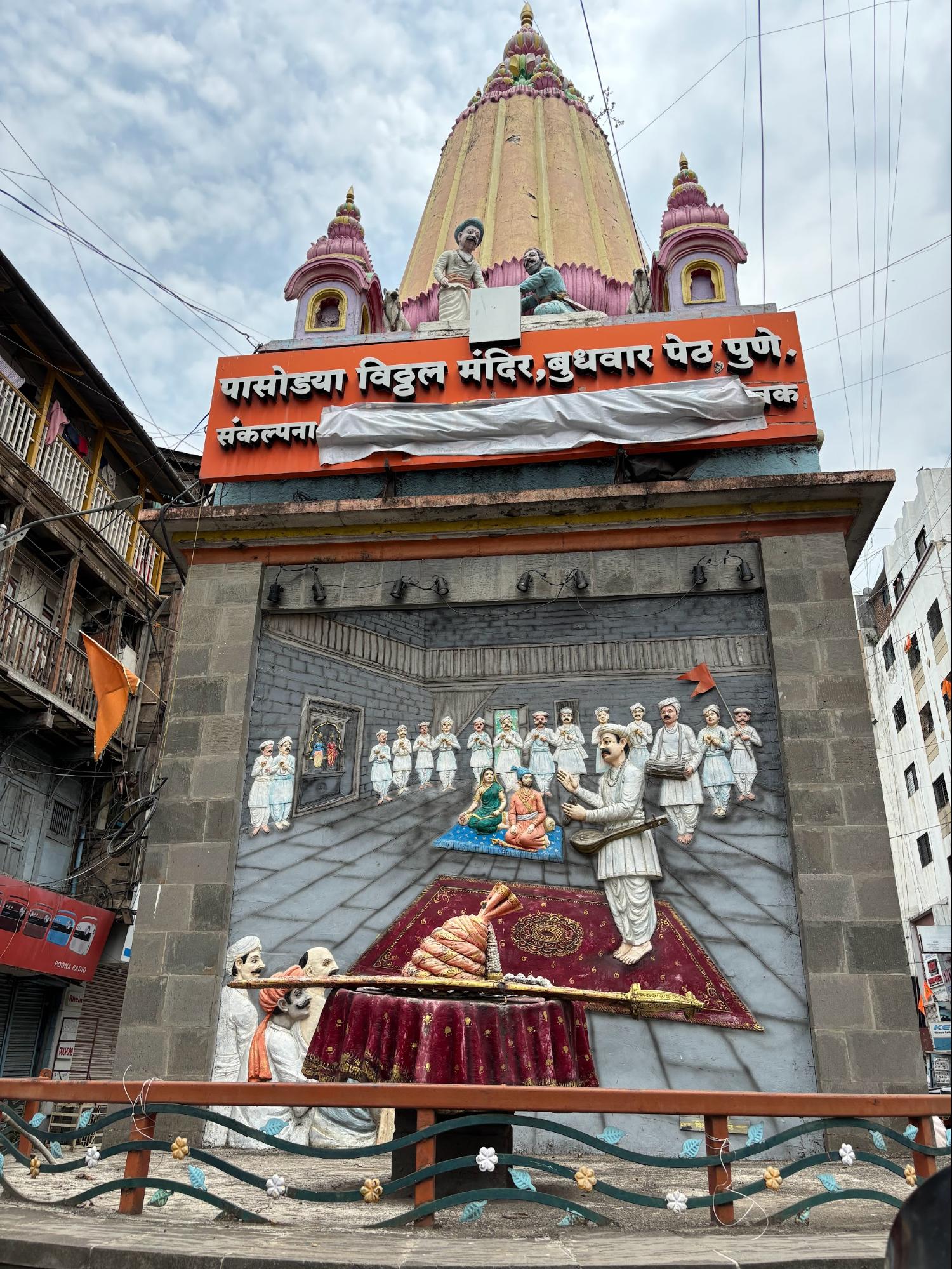
The origins of the Mandir’s name is very interesting. It is derived from the term “pasodya,” referring to the bags that were believed to have been sold around the Mandir area, which along with ghongadis (woolen blankets) played a significant role in the local economy. Today, the Mandir remains a key stopover for Warkaris, the bhakts of Vitthal Deva, during the annual Palkhi yatra held in June and July.
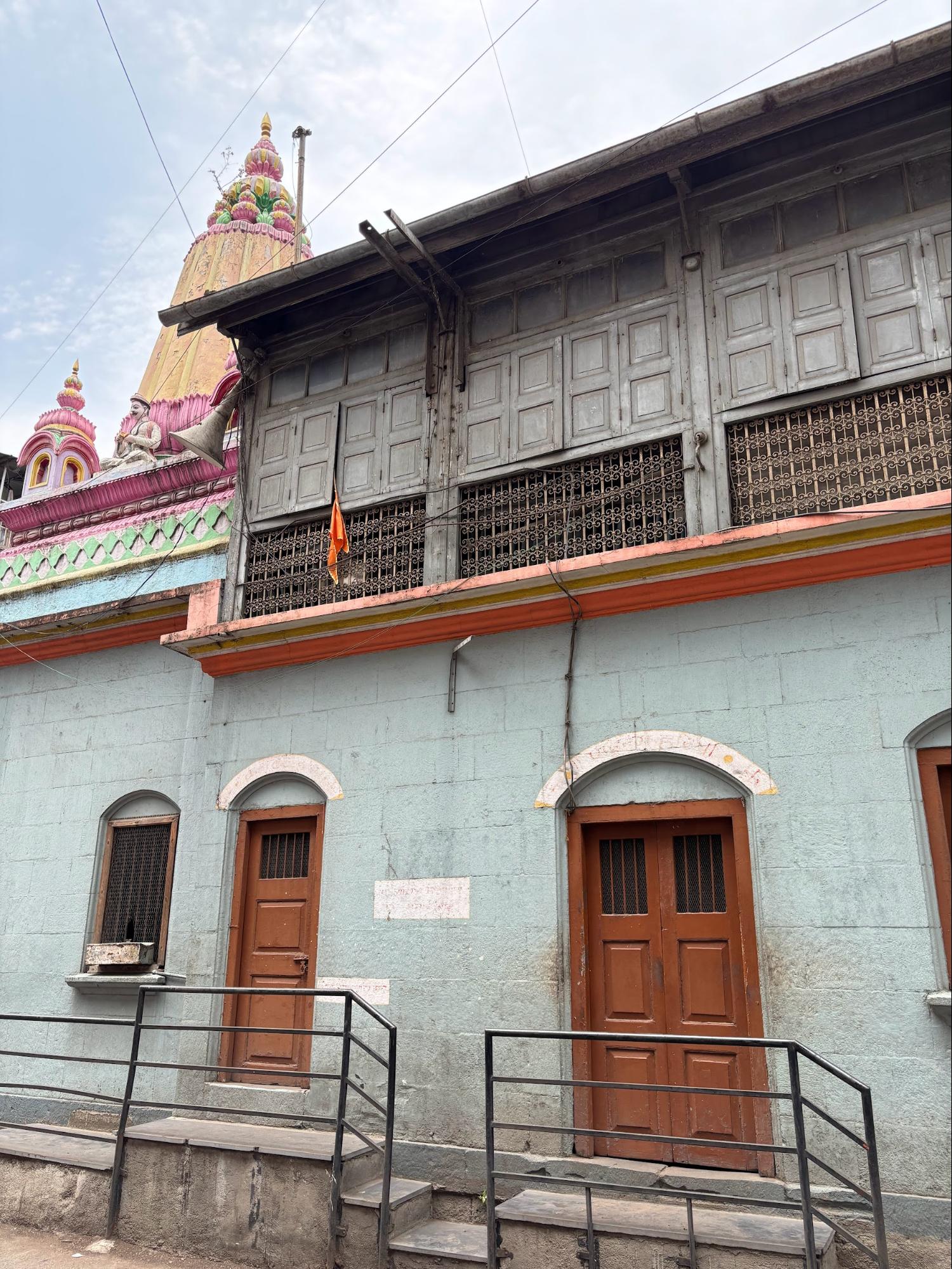
Pataleshwar Caves
The Pataleshwar Caves, also known as the Panchaleshvara Cave, Bhamburde Caves, or Pandoo Caves, is an 8th-century rock-cut Mandir located in Shivajinagar. Carved entirely from a single basalt formation of the Deccan Traps, the site is widely believed to have been built during the Rashtrakuta period (whose rule roughly spanned from the 8th to the 10th centuries CE). However, local traditions associate the Mandir with the Pandavas, suggesting it was excavated during their exile. When originally built, it is said that the site stood within the territory historically known as Punya Vishaya, which later evolved into present-day Pune.
![The Pataleshwar Cave Mandir in Shivajinagar, Pune, an 8th-century rock-cut Mandir believed to have been built during the Rashtrakuta period.[49]](/media/culture/images/maharashtra/pune/cultural-sites/the-pataleshwar-cave-mandir-in-shivajinag_i3USGPM.png)
The etymology of Pataleshwar is especially striking. The name is believed to come from the Sanskrit words Patala (underworld) and Ishwar (lord or god). In Hindu cosmology, Patala refers to the netherworld, and the name is often interpreted as “Lord of the Underworld.”
Notably, one might find the location of this cave to be very peculiar as it lies amidst the dense urban landscape of modern Pune. This contrast is notable given that, according to 19th-century colonial records, the cave complex was once part of a community garden. Over time, as the city expanded around it, the caves became enveloped by the urban infrastructure that surrounds it today.
Much of the original structure has been lost, but what remains is revealing. The Nandi, Shiva’s sacred mount, and its pedestal are carved from the same stone as the cave itself, that are, in many ways, indicative of the site’s Shaiva origins.
![Nandi, Shiva’s sacred bull mount, positioned in front of the gabhara (inner sanctum) at Pataleshwar.[50]](/media/culture/images/maharashtra/pune/cultural-sites/nandi-shivas-sacred-bull-mount-positioned_tkUuirp.png)
The central gabhara houses a swayambhu Shivling which is believed by many to have emerged on its own. Though much of the original relief work has been lost, surviving carvings depict figures like the Saptamatrikas (seven mother goddesses associated with protection and war), Gajalakshmi (a form of Lakshmi flanked by elephants, symbolizing prosperity), Tripurantaka (Shiva as the destroyer of three cities which were infested by asurs), Anantasayana (Vishnu reclining on the serpent Ananta), and Lingodbhava (Shia emerging from a fiery linga), illustrating the presence of both Shaiva and Vaishnava iconography within the Mandir.
Curiously, the cave remains unfinished. There are many different explanations that one might find in local legends that are tied to this aspect of the site. Some say that political conflict caused the loss of patronage, bringing construction to a halt. Others believe that flaws discovered in the garbhagriha made the structure unstable, forcing builders to abandon it mid-way.
Today, the caves have been designated as a protected monument and are managed by the Archaeological Survey of India. The site remains a place of both devotional practice and historical interest, drawing visitors for its religious significance and architectural legacy. It is also noted in the Guinness Book of World Records for preserving a single grain of rice inscribed with 5,000 miniature characters, which is kept within the precincts of the cave. In many ways, Pataleshwar offers a rare glimpse into the rock-cut Mandir traditions of early medieval Maharashtra, quietly enduring amid the modern landscape of Pune.
Phule Wada
Phule Wada, presently referred to as Samtabhumi, is a historic and commemorative site located in Ganesh Peth, Pune. It houses the samadhi of Mahatma Jyotirao Phule, one of India’s foremost social reformers, and commemorates the lives and work of both Jyotirao and Savitribai Phule.
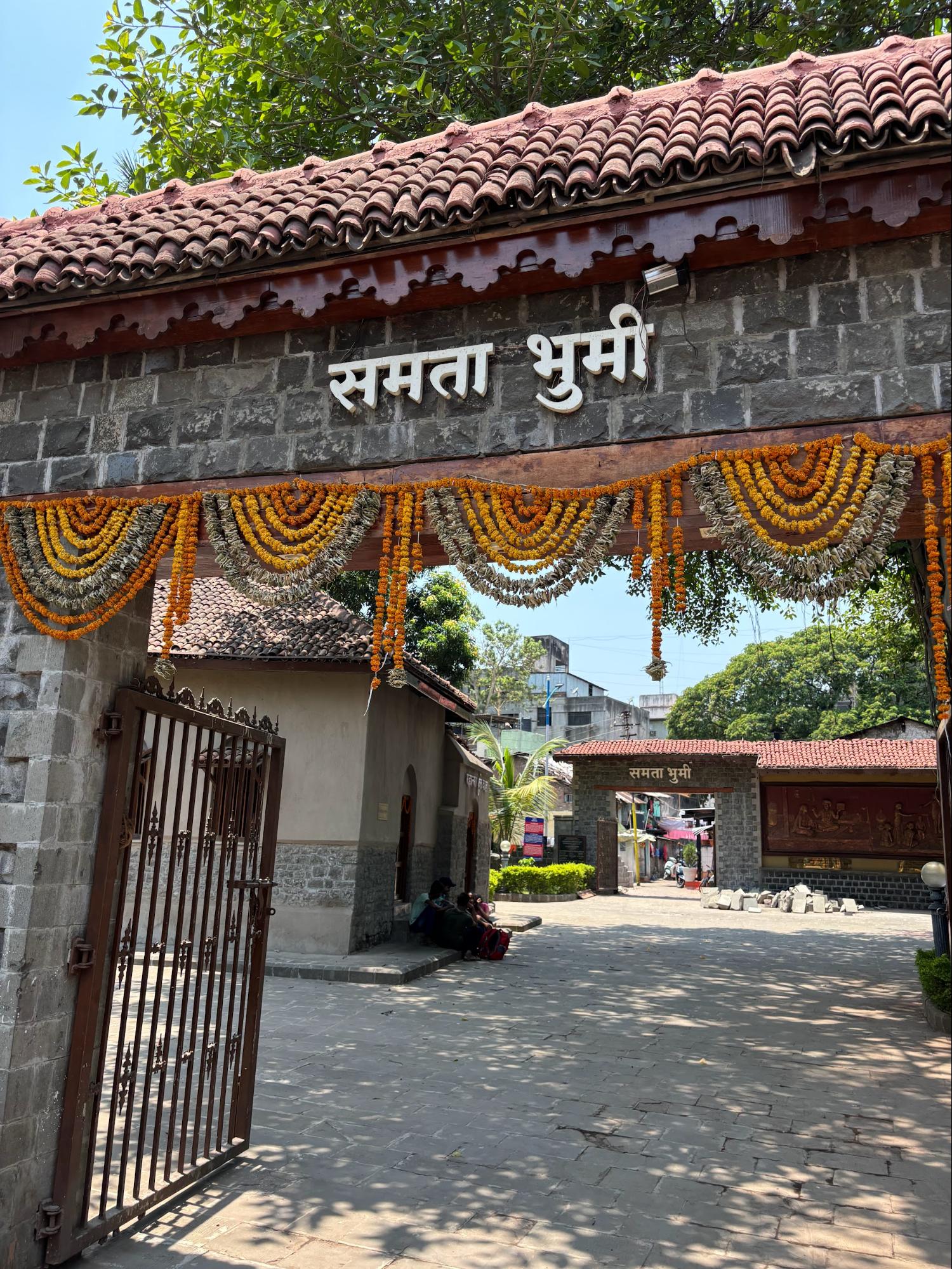

Originally constructed in the mid-19th century, Phule Wada was not just a residence but a center of radical thought and activism. Jyotirao and Savitribai Phule, hailing from the Mali caste, lived here as they launched pioneering efforts to dismantle caste discrimination and promote education for women and marginalized communities. Their efforts, particularly in education, were revolutionary; after Jyotirao's schooling at a missionary institution, he encouraged and taught Savitribai, who went on to become one of India's first female teachers.
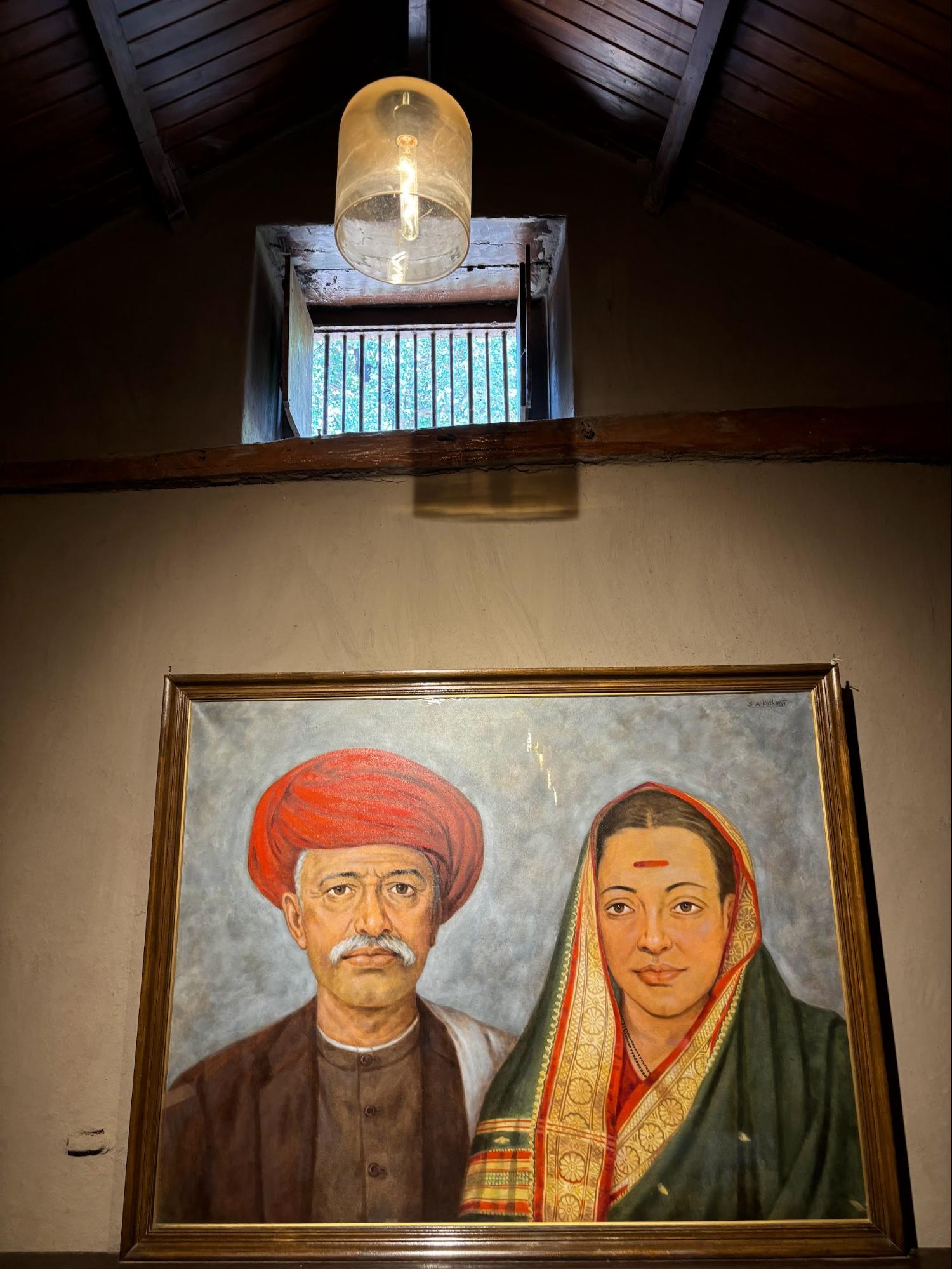
The journey that brought them here began earlier. In 1848, while still living at Jyotirao’s family home, the Phules opened the first school for girls at Bhidewada. Savitribai, who had trained to teach, took charge of the school despite facing daily harassment. Stones and insults followed her walk to work. The family's outrage at these activities led to the Phules being forced out of their ancestral home the next year.
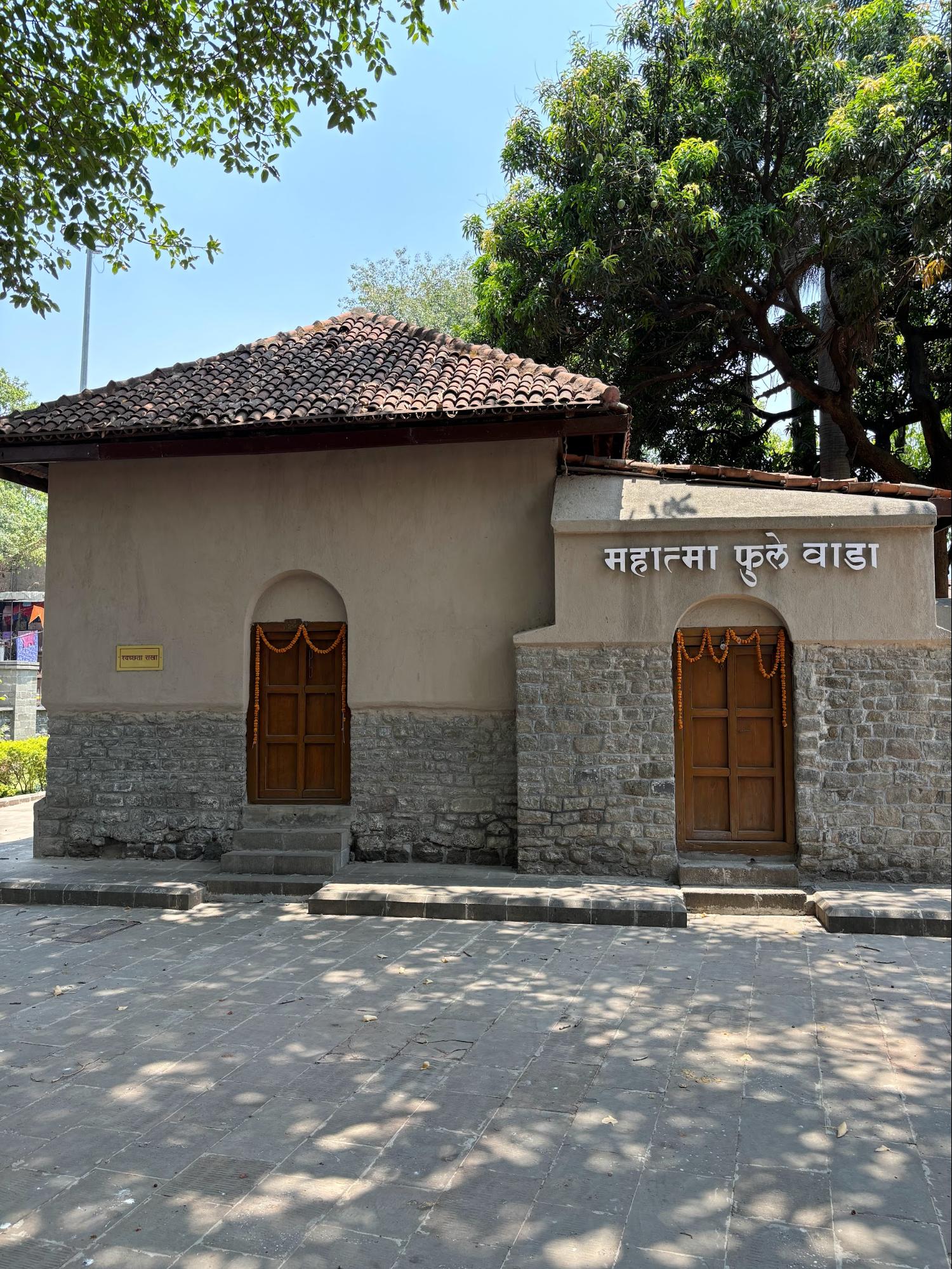
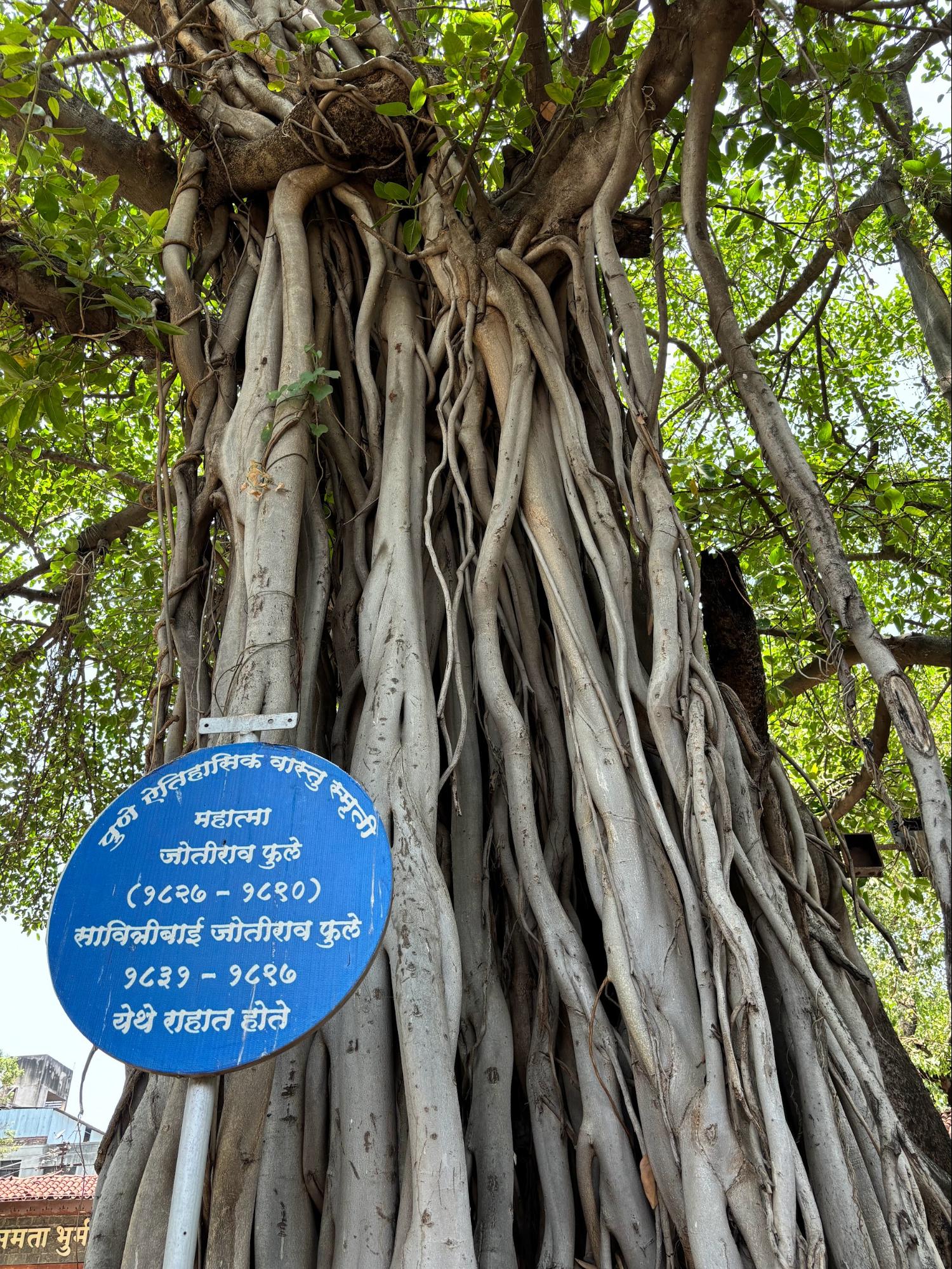
Their new home at Phule Wada became more than just a shelter. Over time, it grew into a base for a wide range of social reforms. In 1868, Jyotirao built a water tank (haud) inside the Wada, opening it to the "untouchable" communities who were barred from public wells. It was a practical act of rebellion against caste rules and a rightful demand for equality.

Over time, the social reform campaign expanded to reform the agrarian economy, scientific study of the caste system, establishing the “Satyashodhak Samaj” (Society for Truth-Seekers) in 1873, urban planning, and related issues. The two most notable works of Jyotirao are “Gulamgiri” (Slavery) in 1873 and “Shetkaryacha Asud” (Cultivator’s Whipcord) in 1883. For his seminal contributions to society, Jyotirao was conferred the title of “Mahatma” by Vitthal Krishnarao Vandekar in 1888. Mahatma Phule died in 1890 and Savitribai died in 1897 while serving the victims of the catastrophic plague that had struck Pune.
In 1860, Phule emphasized the importance of widow remarriage and toured the region advocating for the same, establishing an ashram for widows and their care. Infanticide was next on the agenda and they ran a child care in 1863 in their home. The couple adopted Yashwant, son of a Brahmin widow, and raised him as their own.
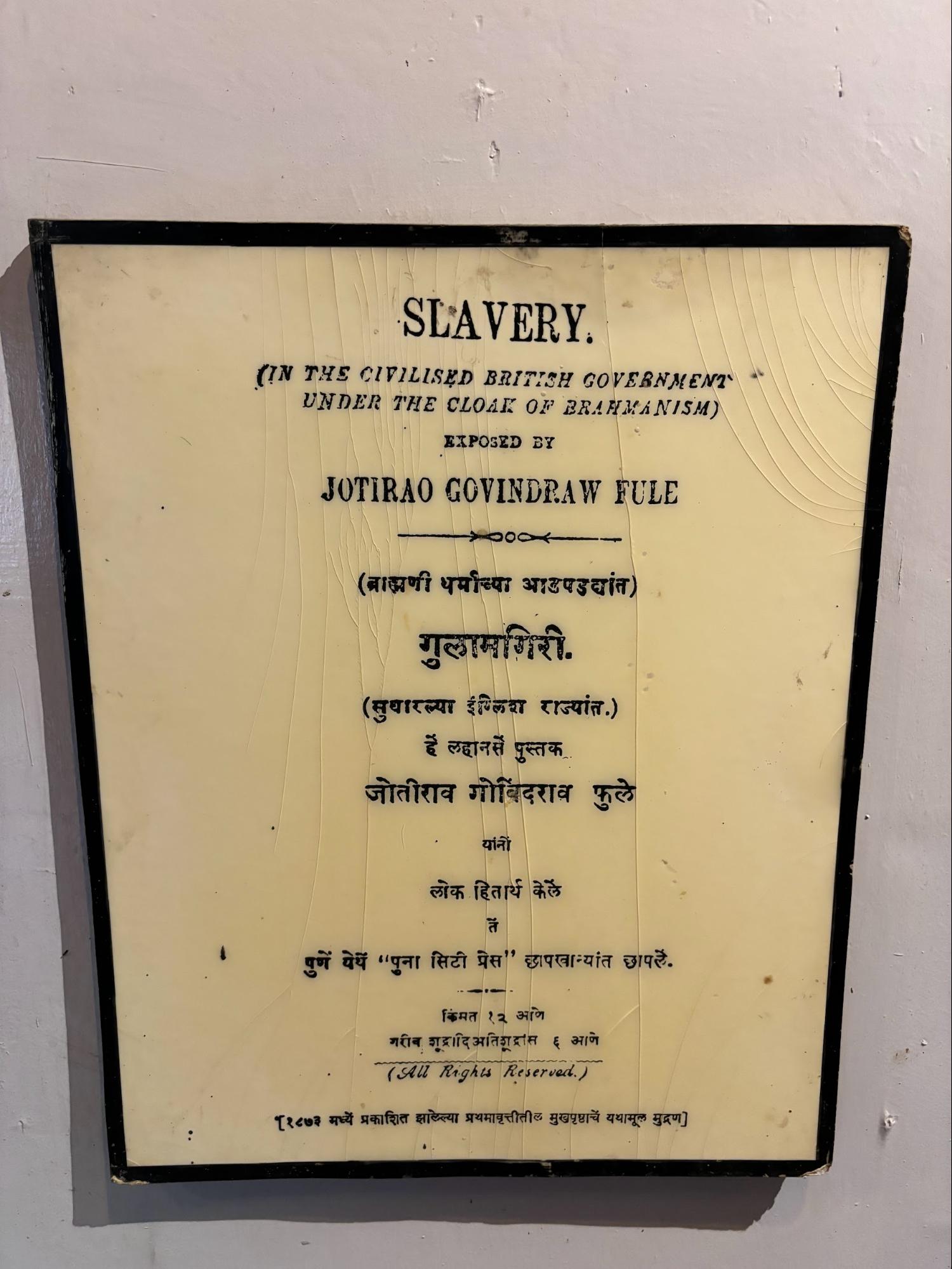
Today, the Phule Wada stands as a heritage site where visitors can explore its preserved wooden architecture, view exhibitions of personal letters and photographs, and stand before the Tulsi plant that marks Jyotirao’s Samadhi.
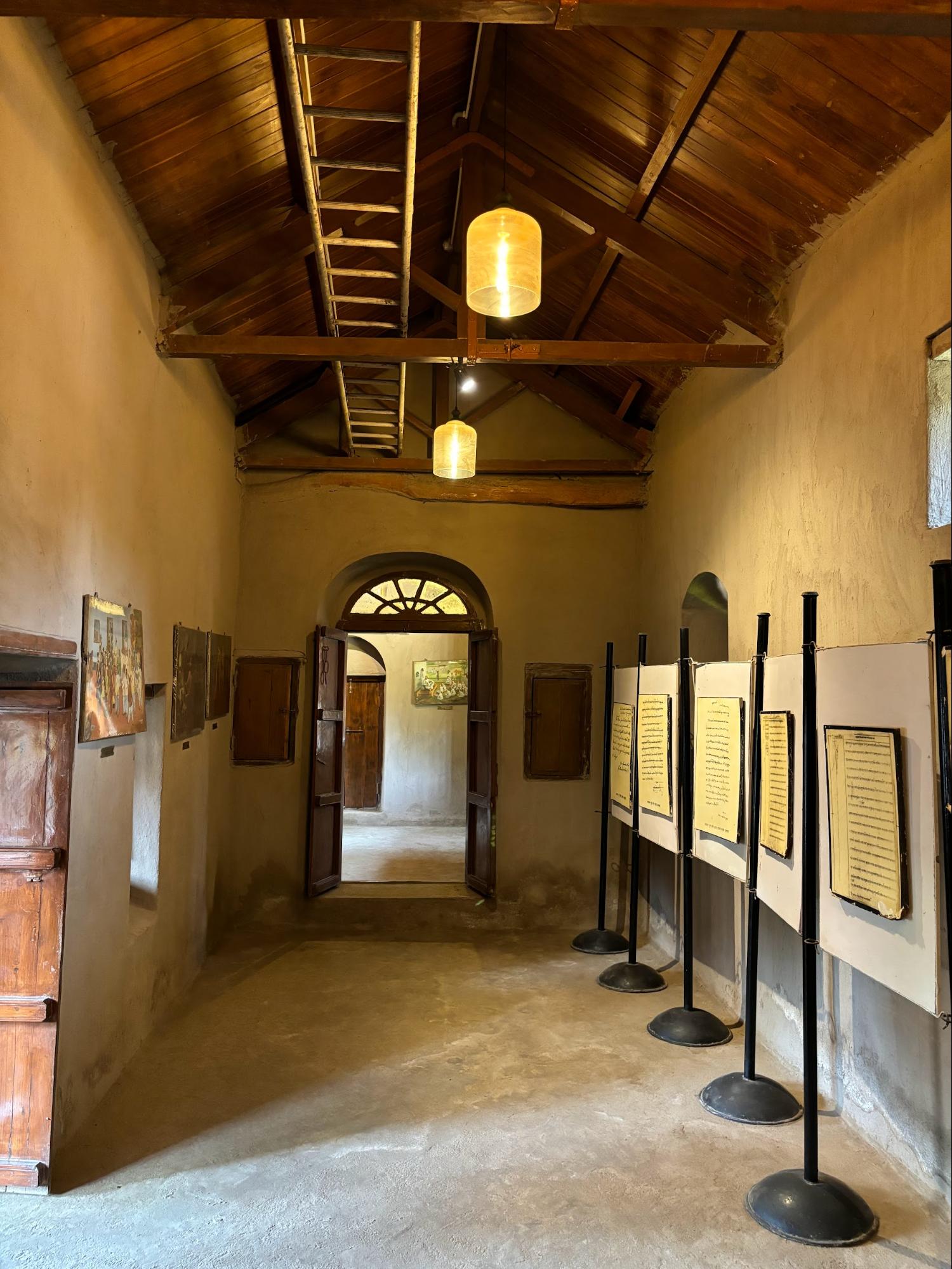
Poona Lodge Theosophical Society and Annie Besant
In Deccan Gymkhana, near Fergusson College, the Poona Lodge Theosophical Society, established in 1882 by Colonel Henry Steel Olcott, stands as a historic branch of the global Theosophical Society. This site holds significance in Pune’s history due to its connection with Annie Besant, a prominent thinker, social reformer, and advocate for Indian independence.
Theosophy, founded in 1875 in New York by Helena Petrovna Blavatsky, Olcott, and William Quan Judge, blends concepts from Hinduism, Buddhism, and esoteric traditions. The Poona Lodge, among India’s earliest theosophical centers, began on land leased from L.R. Gokhale, acquired from the Shirole family. Initially operating in Pune’s Cantonment and Peth areas, it found a permanent home in 1927 with a two-story stone bungalow, designed by architect Talim and initiated by Annie Besant in 1926. The building, briefly hosting Freemasons on its upper floor, became a hub for philosophical discussions, with its tranquil courtyard and extensive library still attracting visitors, though fewer today.
Annie Besant’s influence on the Poona Lodge is profound. A British socialist, feminist, and theosophist, she joined the society in 1889 and led it from 1907 until 1933. Her visits to Pune and initiation of the lodge’s construction solidified her impact. Beyond theosophy, Besant championed India’s self-governance, launching the All India Home Rule League in 1916 with Lokmanya Tilak and becoming the first woman president of the Indian National Congress in 1917. Her newspaper, New India, critiqued British rule, and her book, The Future of Indian Politics, noted the Theosophical Society’s role in inspiring the Congress and India’s dominion vision. In Pune, a hub of independence activists, the lodge likely served as a venue for such discussions.
Today, the Poona Lodge remains active, though modern distractions have reduced visitors. Its grey-brick bungalow, shaded by trees, preserves a legacy from when Theosophy inspired thinkers and activists.
Pune Archives
The Pune Archives, established in the late 19th century, is a major repository of historical records located on Bund Garden Road, opposite Council Hall in Pune. Initially known as the Peshwa Daftar and the Alienation Office, the institution was constructed in phases beginning on 7 July 1877, with the final building completed on 1 September 1891.
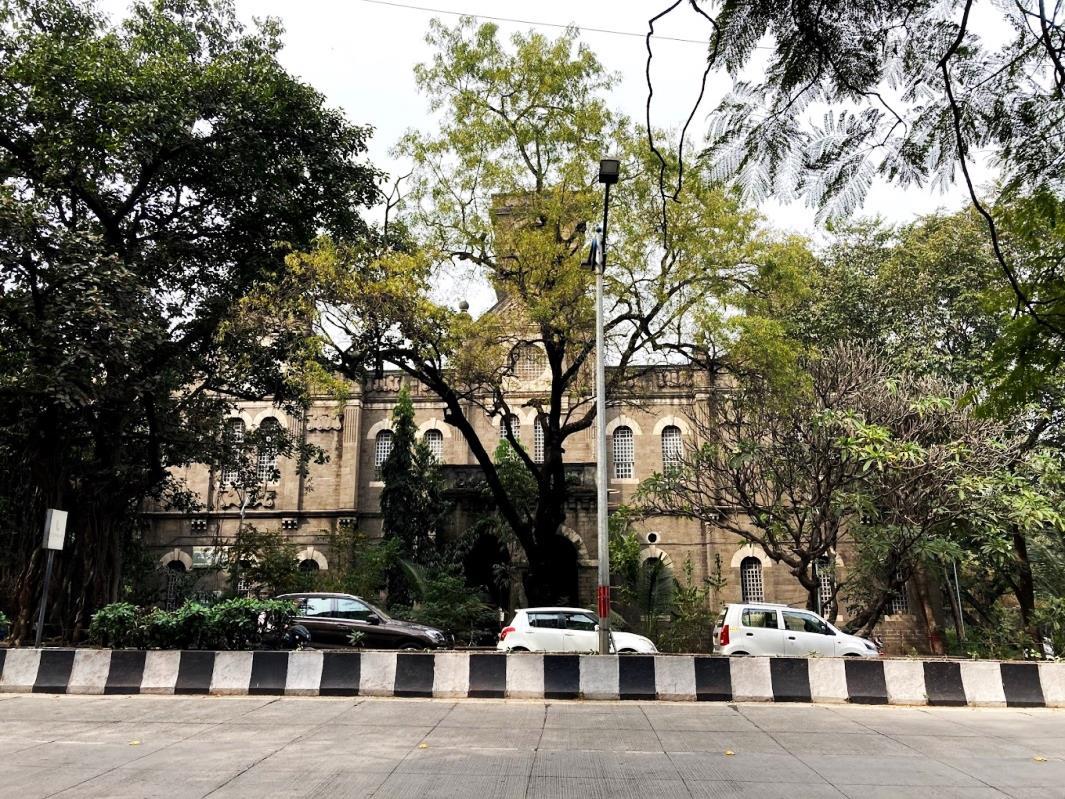
The archives house approximately five crore documents, with holdings that span the Peshwa period (1666–1890) and the era of the British East India Company. Its establishment followed a fire at Shaniwar Wada, which resulted in the loss of significant historical records. To reduce the risk of similar incidents, the archive complex was built using fire-resistant materials and equipped with a water tower and firefighting hoses. Notably, it has a panoptic layout which was said to be designed primarily for fire prevention rather than surveillance.
Architecturally, the Pune Archives building is designed in a mix of Mannerist and Baroque styles, different from the Gothic style often used in other archives of the time. It has two storeys and is built from local trap stone, with the stones carefully cut and fitted together in regular patterns.
![The front porch of the archival building.[51]](/media/culture/images/maharashtra/pune/cultural-sites/the-front-porch-of-the-archival-building-a87b2eeb.png)
![The façade of the archival building.[52]](/media/culture/images/maharashtra/pune/cultural-sites/the-facade-of-the-archival-building-68b4ef3c.png)
Documents within the archives are preserved in more than 39,000 cloth bundles (known as rumals) each containing between 1,800 and 2,000 individual records. Most of the documents are written in the Modi script, with some translated into English, Gujarati, and Persian. Interestingly, several rooms within the building are named after Peshwa rulers.
![Inside Pune Archives, historical records date from the early Maratha period to the early colonial period.[53]](/media/culture/images/maharashtra/pune/cultural-sites/inside-pune-archives-historical-records-d_7Rs2C4t.png)
The Pune Archives also holds important land records, including documents linked to the Deccan Riots Commission of 1875. The commission was set up to examine the causes of farmer unrest during that period, and its work eventually led to the passing of the Agriculturists’ Relief Act of 1879, which aimed to protect farmers from imprisonment over unpaid debts.
Today, the archives continue to support research on the administrative and historical changes in Pune from the Peshwa era through the British period.
Pune Tribal Cultural Museum
The Tribal Cultural Museum, established in 1965, is part of the Tribal Research and Training Institute in Pune and is managed by the Government of Maharashtra. Located near Bund Garden, the museum focuses on the documentation and display of the traditions and material culture of approximately 45 indigenous communities from Maharashtra and western India.
![A life-sized exhibition in the Pune Tribal Cultural Museum depicting everyday life and culture of the Warli community.[54]](/media/culture/images/maharashtra/pune/cultural-sites/a-life-sized-exhibition-in-the-pune-triba_eBbsCij.jpg)
The museum displays artefacts from around 45 Scheduled Tribe groups such as the Warlis, Bhil, Pawara, Kokana, Gond, Thakar, Madia, Korku, and Mavchis. The exhibits are arranged across two indoor galleries and an outdoor space, where life-sized models of traditional houses depict the living environments of different communities.
The collection includes everyday objects such as utensils, agricultural tools, hunting equipment, and household articles. Ritual and ceremonial items are also featured, including jewellery, masks, handicrafts, and traditional clothing. A notable highlight is a set of 54 ceremonial masks from the Bohada festival of the Thane and Nashik districts, representing ancestral spirits, clan deities, and figures from local folklore. The museum also houses a reference library that supports academic research into their cultures.
![The masks, also called Songas, displayed in the Pune Tribal Cultural Museum represent ancestral spirits, kuldevis/kuldevtas, evil spirits and rakshasas according to indigenous folklore.[55]](/media/culture/images/maharashtra/pune/cultural-sites/the-masks-also-called-songas-displayed-in_mVJNdNM.jpg)
The Tribal Research and Training Institute, which oversees the museum, regularly organises cultural festivals, handicraft exhibitions, art competitions, and traditional dance performances. It has also produced over 90 documentaries documenting the art forms, daily life, and development efforts among Maharashtra’s indigenous groups.
In 2018, the institute introduced a virtual reality installation at Pune Airport, enabling travellers to explore the museum’s exhibits remotely and access a curated selection of traditional crafts. The initiative aimed to raise broader awareness of indigenous cultural traditions in the region.
Raj Bhavan
Raj Bhavan in Pune, originally known as Dharapoore House, served as the monsoon residence of the Governor of Bombay Presidency and later Maharashtra for nearly 180 years. Its construction was closely tied to Pune’s role as the monsoon capital of the Presidency, a status it held from the mid-19th century.
![Raj Bhavan at Ganeshkhind, Pune.[56]](/media/culture/images/maharashtra/pune/cultural-sites/raj-bhavan-at-ganeshkhind-pune56-284f3a61.jpg)
The development of the estate at Ganeshkhind began in 1864 and was completed by 1871. The main building, a two-storey mansion set within landscaped grounds, combines elements of Italian, Roman, and Indo-Saracenic architectural styles. Key features included a six-storey tower, a ballroom, and residential quarters designed to accommodate the Governor and visiting officials during the monsoon months.
Notably, following Indian independence, the administrative role of the site changed. In 1948, the main Government House buildings were leased to the newly established University of Pune (now Savitribai Phule Pune University). A new Raj Bhavan residence, ‘Punya Bhushan’, was later constructed nearby for the Governor’s use, along with guest houses such as ‘Punya Lakshan’ and ‘Punya Chintan’. Portions of the original estate were also allocated to public institutions, including the Yashwantrao Chavan Academy of Development Administration.
Today, Raj Bhavan remains a significant site, reflecting Pune’s historical role in colonial governance and its continued importance in Maharashtra’s administrative landscape.
Raja Dinkar Kelkar Museum
The Raja Dinkar Kelkar Museum in Pune was founded in 1962 by Dr. Dinkar G. Kelkar, who dedicated it to the memory of his son, Raja. The museum grew out of Dr. Kelkar’s personal collection, built over decades through travels across India, and focuses on the everyday art and craftsmanship of the country.
![The exterior of Raja Dinkar Kelkar Museum, Shukrawar Peth, Pune.[57]](/media/culture/images/maharashtra/pune/cultural-sites/the-exterior-of-raja-dinkar-kelkar-museum_tfJYZ5r.jpg)
The collection includes over 20,000 artefacts, with about 2,500 on display. It highlights objects from daily life, such as carved doors, windows, lamps, musical instruments, kitchen utensils, and weapons, showcasing the skill and creativity found in ordinary settings. Decorative items and ritual objects also form a significant part of the exhibits.
One of the museum’s unique attractions is the Vanita Kaksha or Women’s Chamber, which offers a glimpse into the conventional lives of Indian women, from their morning routines to their ornate adornments. Another highlight is the recreation of a typical Gujarati home, complete with traditional pillars, decorations, and artefacts, evoking the warmth and charm of a bygone era.
![The Gujarat Gallery is one of the main attractions of the Raja Dinkar Kelkar Museum.[58]](/media/culture/images/maharashtra/pune/cultural-sites/the-gujarat-gallery-is-one-of-the-main-at_3BKVwLz.jpg)
The museum also boasts an impressive textile collection, including Paithani sarees from Maharashtra, Parsi garas, Banarasi brocades, Rabari embroidered sarees from Gujarat, Bengali kantha embroidery, and Kashida sarees from Karnataka. Additionally, it is home to the largest collection of lamps in India, some of which are still lit with ghee or oil.
A particularly captivating feature is the rebuilt Mastani Mahal, which tells the romantic legend of Peshwa Bajirao I and Mastani, showcasing the grandeur of their era.
![The Mastani Mahal in the Raja Dinkar Kelkar Museum captures the grandeur of Peshwa history, as well as the romanticloreof Bajirao and Mastani.[59]](/media/culture/images/maharashtra/pune/cultural-sites/the-mastani-mahal-in-the-raja-dinkar-kelk_5BqosEg.png)
Dr. Kelkar’s extensive collection is the result of years of dedicated travel across rural and urban India, during which he acquired objects reflecting the diversity and richness of Indian folk and decorative arts. In 1975, he donated the collection to the Government of Maharashtra to ensure its preservation for future generations. Today, the Raja Dinkar Kelkar Museum remains a major centre for the study and appreciation of India’s material culture and artisanal traditions.
Ranjangaon Ganpati
Shree Mahaganapati Mandir is located in Ranjangaon, around 50 km from Pune, and is part of the Ashtavinayak circuit (a group of eight sites in Maharashtra dedicated to Bhagwan Ganesh). The site is associated with the form of Mahaganapati, considered a powerful manifestation of Ganesh, depicted with multiple arms and a commanding posture.
![Shree Mahaganapati Mandir in Ranjangaon which is one of the eight sites in the Ashtavinayak yatra that is dedicated to Bhagwan Ganesh.[60]](/media/culture/images/maharashtra/pune/cultural-sites/shree-mahaganapati-mandir-in-ranjangaon-w_S924tbP.png)
The murti enshrined in the garbhagriha is considered swayambhu (self-manifested) and is distinct from the outer murti seen by most visitors. The inner image, which is kept concealed for most of the year, is described in local accounts as having ten trunks and twenty arms, and is revealed to the public only during specific rituals and festivals. There is a very interesting legend that is tied to the murti and Mandir. According to local tradition, the asur Tripurasura obtained a boon from Bhagwan Ganesh that no one except Bhagwan Shankar could defeat him. Emboldened by this, Tripurasura overpowered the Devis and Devtas and demanded Mount Kailash.
Shankar is believed to have taken the form of a Brahmin and impressed Tripurasura with his knowledge. Later, before the final battle, Shankar recited the verse Pranamya Shirasa Devam in praise of Ganesha and defeated Tripurasura with a single arrow. This event is linked to Tripuri Pournima, observed on the full moon of Kartik. The place where Shankar is said to have invoked Ganesh came to be known as Ranjangaon and it is believed by many that during this time he enshrined a murti of Bhagwan Ganesh here.
The original structure at Ranjangaon is believed to date back to the 9th or 10th century, though the current layout includes additions from the 18th century, particularly during the time of Madhavrao Peshwa, who is said to have contributed to the renovation and expansion of the site. Ganesh Chaturthi is the most important festival celebrated here. For five days around the festival (usually in August or September), devotees are allowed to enter the inner sanctum for close darshan. This period draws large crowds from across the region.
Raste Wada
Raste Wada is a historic residence located in Rasta Peth, Pune. It was built in the late 18th century by Anandrao Bhikaji Raste, the sarsenapati (commander-in-chief) of the Maratha Empire’s cavalry. Construction took place between 1779 and 1784, during the tenure of Peshwa Madhav Rao II. Today, it remains one of the largest surviving wadas in the city.
![Front view of Raste Wada, Rasta Peth, Pune.[61]](/media/culture/images/maharashtra/pune/cultural-sites/front-view-of-raste-wada-rasta-peth-pune6_6bgy3rJ.png)
Rokdoba Mandir
![The entrance to the Rokdoba Mandir in Shivaji Nagar, Pune.[62]](/media/culture/images/maharashtra/pune/cultural-sites/the-entrance-to-the-rokdoba-mandir-in-shi_PRKNjsT.png)
The Rokdoba Mandir was constructed in the 17th century which was situated in Bhamburda village. The village today is located in the Shivaji Nagar area, near Jangli Maharaj road. The Rokdoba Mandir is dedicated to Devta Rokdoba, who is believed to be an avatar of Bhagwan Hanuman. Interestingly, many local accounts state that the Mandir is named after ‘rokda’ (cash in Marathi) that workers in the Mandir were paid, rather than the Devta. In the Mandir complex, there is a samadhi of Shirole Patil who was headman of the village during Peshwa rule. Jangli Maharaj spent his final days in this Mandir in the 19th century and it is said that he rebuilt some part of it.
The architecture of the Mandir consists of a hall and an open courtyard. The giant iron pillars adorn the garbhagriha while the inside contains ornate devasthans dedicated to Bhagwan Ganpati and Nagoba. The auspicious festivals celebrated here are Hanuman Jayanti and Purnima. The Pandits conduct Aartis every morning and evening. Bhajans are sung by the members of the Jangali Maharaj Bhajani Mandal during festivals and instruments such as the harmonium, pakhawaj (barrel drum), taal (small cymbals), and chaughada (drums) are played.
Sant Devjibaba Samadhi Devasthan
Sant Devjibaba Samadhi Devasthan is located in Ganesh Peth, Pune. The site is dedicated to Sant Devjibaba Maharaj, an ascetic yogi revered as “Yogiraj,” who is believed to have taken Sanjeevan Samadhi here in 1848.
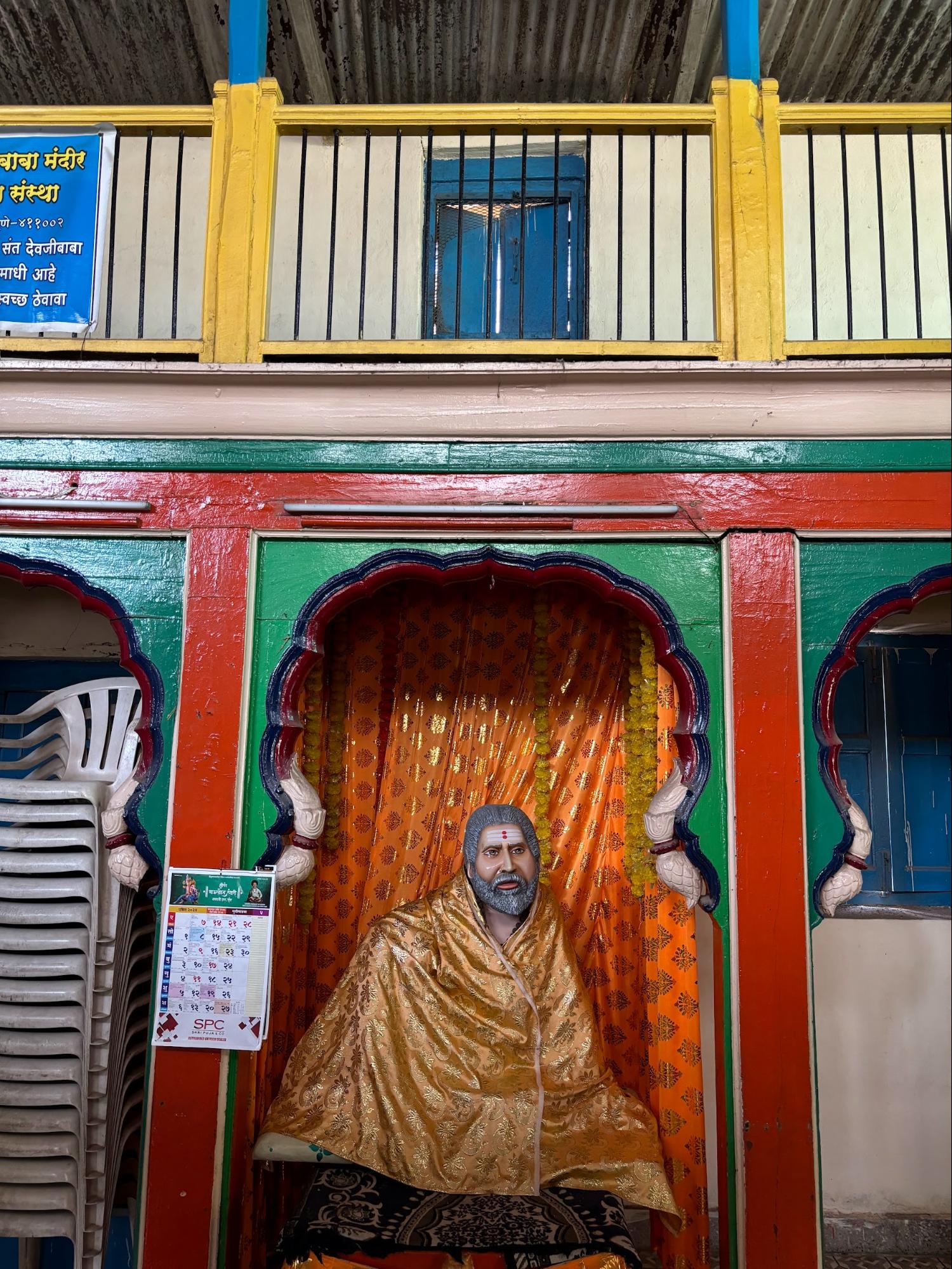
Alongside the Samadhi, the complex also houses a Mandir dedicated to Vitthal and Rukmini.
Sant Tukaram Maharaj Samadhi Mandir
The Sant Tukaram Maharaj Samadhi Mandir, also called the Dehu Gatha Mandir, is located in Dehu village near the Indrayani river. It marks the samadhi site of Sant Tukaram, a 17th-century Sant and poet of the Bhakti movement. Sant Tukaram is known for composing devotional songs called abhangas in praise of Vitthal. These abhangas are considered an important part of Marathi literature and devotional practice.
![A view of the Sant Tukaram Maharaj Samadhi Mandir, Dehu, Pune.[63]](/media/culture/images/maharashtra/pune/cultural-sites/a-view-of-the-sant-tukaram-maharaj-samadh_Evepi0g.png)
The Mandir includes a marble statue of Sant Tukaram sitting on a rock with a veena in his hand. According to local tradition, it is believed that Sant Tukaram attained moksha at this site by boarding a celestial chariot that took him to Vaikuntha. Near the Mandir is his ancestral house, where he lived with his family and composed many abhangs. The house remains a part of the site and is visited by devotees throughout the year.
The Mandir is significant as the starting point of the Sant Tukaram Maharaj Palkhi procession, which is a central part of the annual Pandharpur Wari. Every year, thousands of warkaris gather in Dehu and walk to Pandharpur with the padukas (symbolic footprints) of Sant Tukaram in a palkhi. Festivals observed at the Mandir include Tukaram Beej (his death anniversary which is usually celebrated in February-March), Ashadhi Ekadashi (celebrated in the Hindu month of Ashadh, that falls between June-July), and Guru Purnima (celebrated in the Hindu month of Ashadh, that falls between June-July). On these occasions, bhakts sing abhangs, offer prayers, and participate in rituals at the Mandir.
Sardar Shitole Wada
Sardar Shitole Wada is a historic residential complex located in Kasba Peth, Pune, situated a short distance from the Gundacha Ganpati Mandir. This wada is currently owned by Raje Rajendra Shitoleraja Deshmukh, a descendant of the Sisodia Rajputs who are believed to have migrated to the region around 1200 years ago.
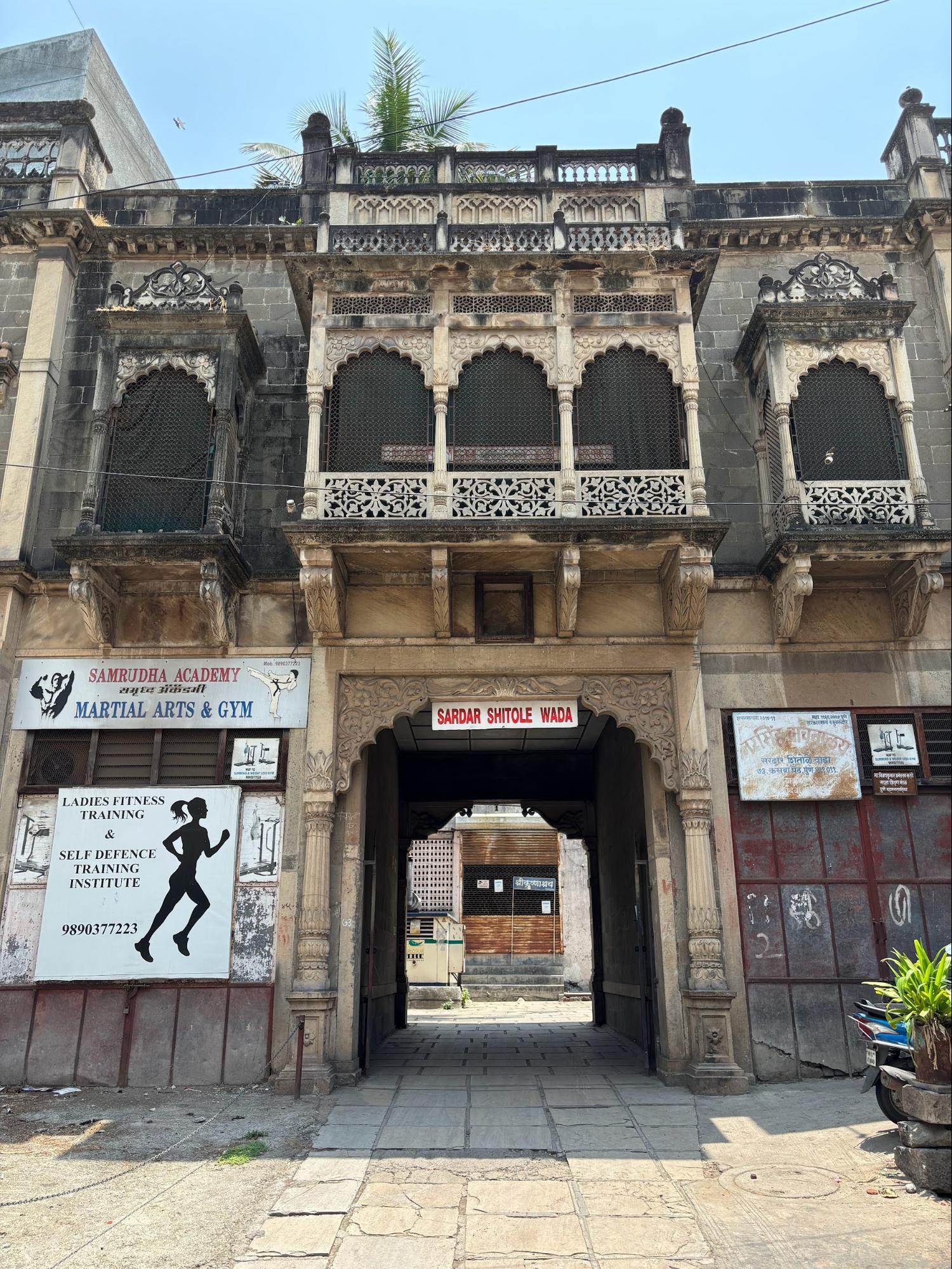
The Shitole family historically held the title of Deshmukh, a role involving revenue collection and local administration. Later, the title of Inamdar was conferred upon Raje Shitoleraja, along with land grants in present-day Pashan, Lavale, Wanowrie, Hadapsar, Manjari, and Moshi. The family also held jagirs in parts of Maharashtra and Madhya Pradesh.

A Mandir dedicated to Bhagwan Narasimha and Devi Lakshmi is located within the premises of the wada. Notably, the Mandir was created after one of the family members had a divine vision in which Bhagwan Narasimha, revered as the fourth form of Vishnu appeared.
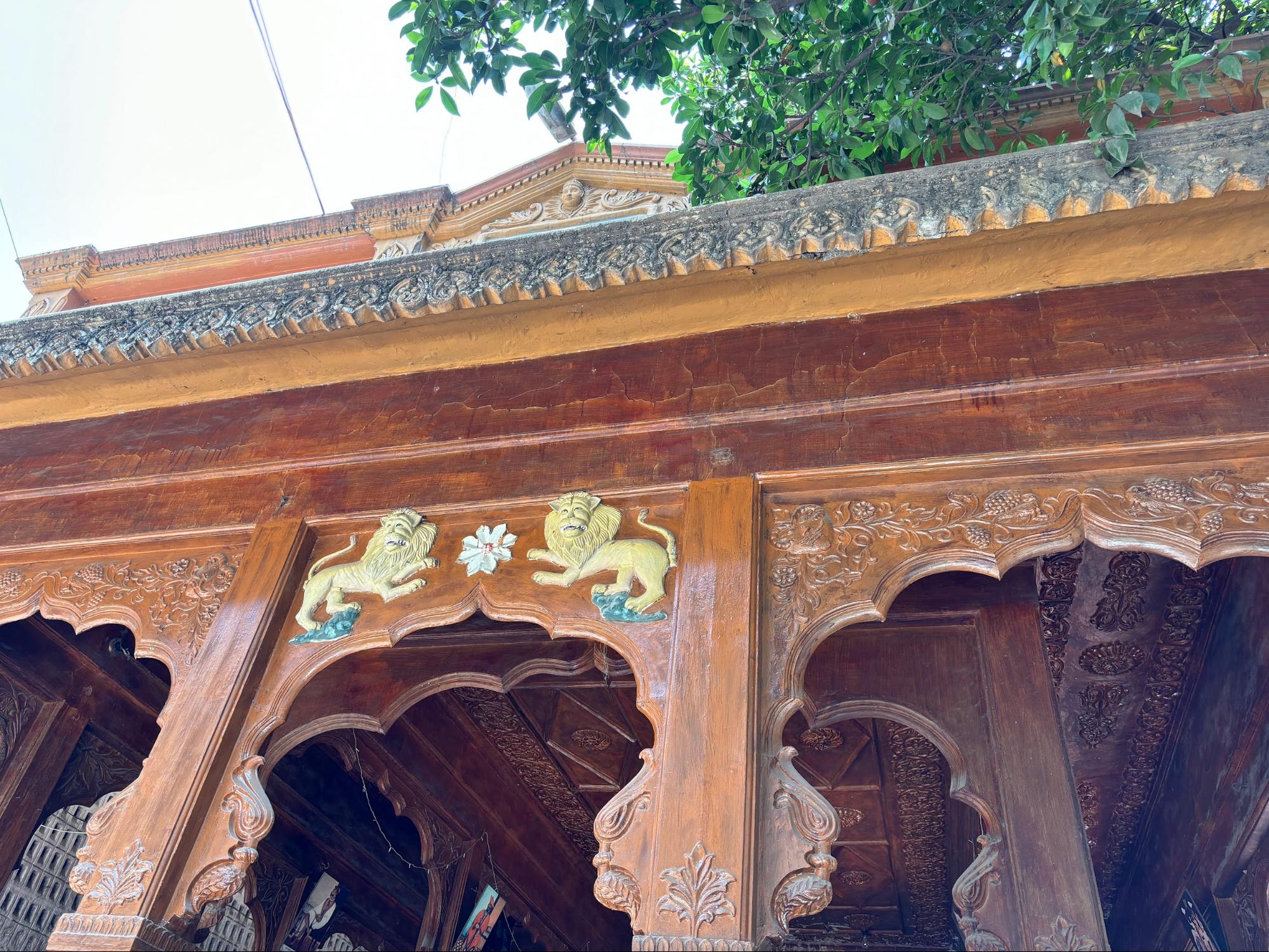
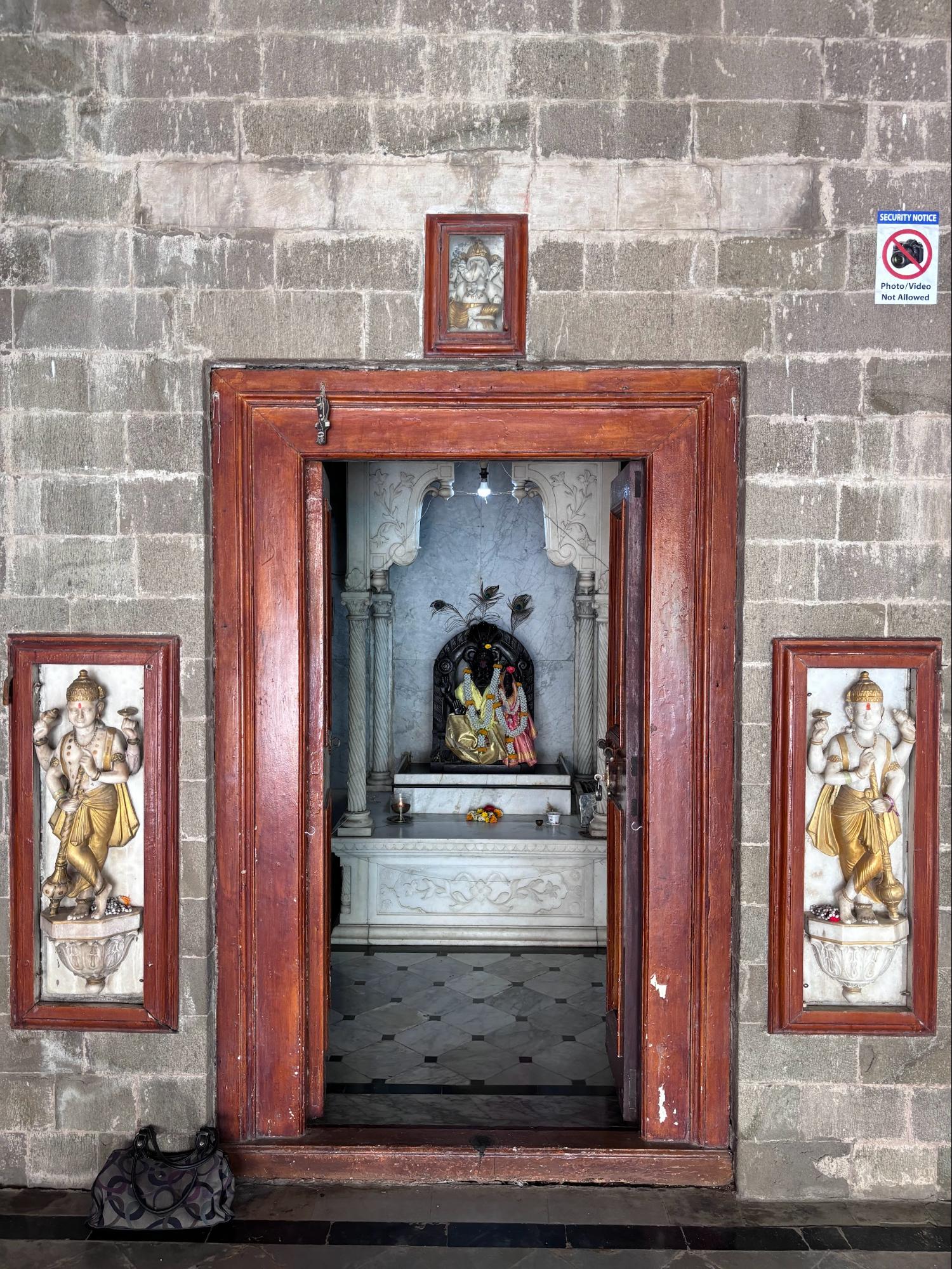
The Mandir has undergone various renovations over the years but has still managed to retain its original wooden features. Adorning the pillars leading to the garbhagriha are portraits and photographs of the ancestors of the Shitoles, further illuminating the Mandir’s historical significance and connection to the family.
In addition to the Mandir, the wada also houses the Narasimha Library, Reading Room, and the Yashodatta Housing Society, where the Shitole descendants continue to reside.
Savarkar Smarak
![Front view of the Savarkar Smarak, Karve Road, Pune.[64]](/media/culture/images/maharashtra/pune/cultural-sites/front-view-of-the-savarkar-smarak-karve-r_7t5JGqT.png)
The Vinayak Damodar Savarkar Memorial, also known as Savarkar Smarak, is a significant landmark on Karve Road. It was constructed between 2010 and 2011 by the Pune Municipal Corporation. This memorial pays tribute to the life and legacy of Veer Savarkar, a prominent political leader and philosopher who played a vital role in India's struggle for independence. The site of the memorial was chosen due to its historical significance, as it was once the location of Savarkar's family home.
The centerpiece of the Savarkar Smarak is a 10 ft. tall bronze statue of Savarkar, which is a striking representation of his life and works. The statue portrays Savarkar holding a book in one hand and a pen in the other, symbolizing his contributions to literature and politics. The statue is a representation of Savarkar's commemorates his role in India’s freedom movement and political thought. In addition to the statue, the memorial features a museum that showcases various artefacts related to Savarkar's life and works. The museum has a collection of photographs, documents, and personal belongings of Savarkar.
Apart from the museum, the Savarkar Smarak also houses a library that is open to the public. The library contains a vast collection of books on Savarkar, Indian politics, and history.
Shaniwar Wada
Shaniwar Wada is a historic fortification located in Shaniwar Peth, Pune. It served as the seat of the Peshwas of the Maratha Empire between 1730 and 1818, and during that period it came to symbolise the power and prestige of the Marathas. Construction began under Peshwa Bajirao I in 1730, with successive additions made by his descendants. The ceremonial laying of the foundation took place on 10 January 1730, a Saturday, which gave the structure its name; derived from the Marathi words Shaniwar meaning Saturday and Wada meaning residential complex. The official inauguration was held on 22 January 1732.
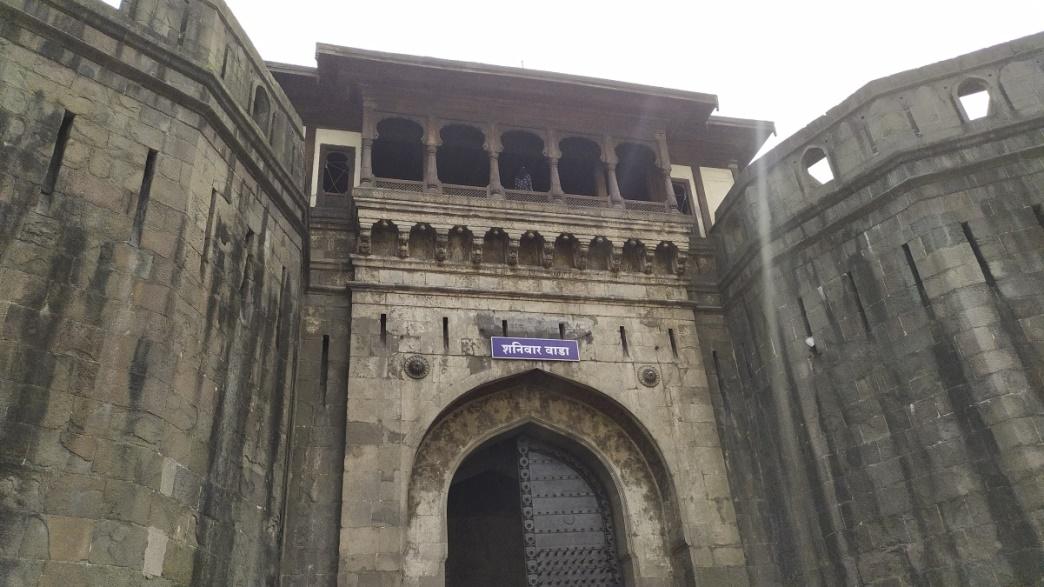
It is said that Bajirao I personally selected the site, considering its strategic position favourable for defence against siege. The original structure was a two-storeyed mansion. Over the following decades, the complex was gradually expanded. Fortified walls, bastions, gates, reservoirs, fountains, and public halls were added, reflecting both the administrative needs and ceremonial grandeur of the Peshwa court. Interestingly, at its peak, it is said that Shaniwar Wada was a seven-storeyed structure with four large courts and several smaller ones, each serving specific purposes.
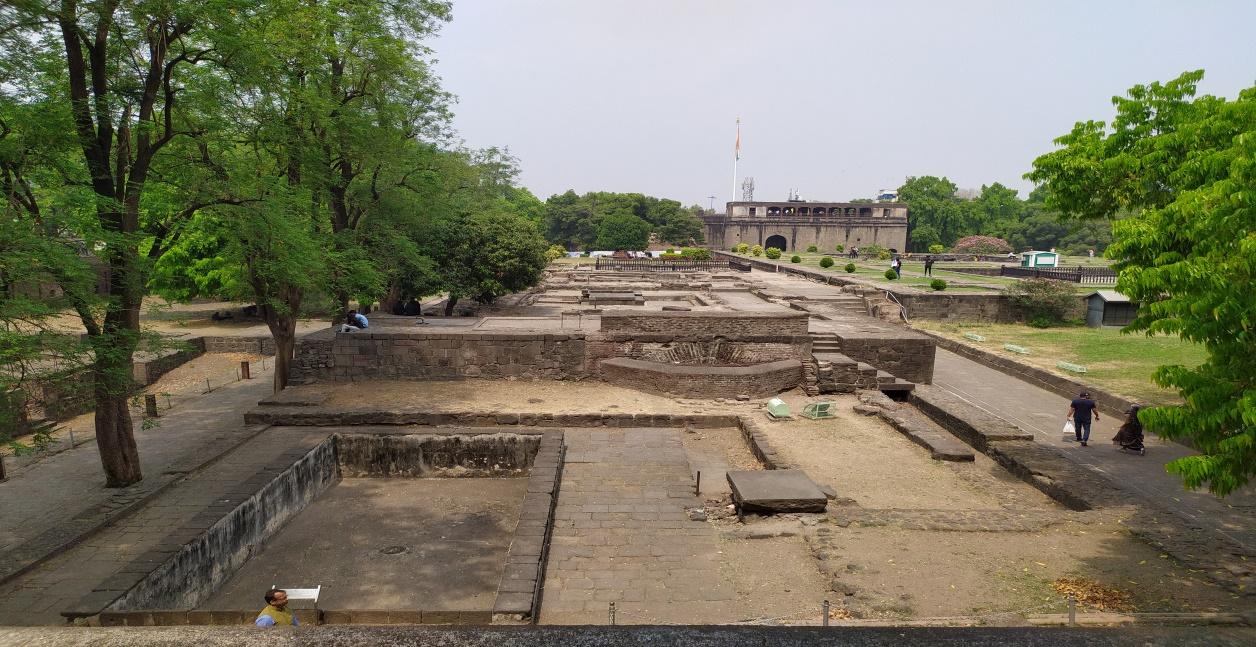
The outer walls of the Wada rise to approximately 20 ft., with the lower section built from stone and the upper from brick. The fort features nine bastions and five gateways. The principal entrance, the Delhi Darwaza, is notably fortified with thick wooden doors studded with iron spikes, and unusually, it faces north towards Delhi. Other entrances include the Narayan Darwaza, also known as the Jambhula Darwaza, the Khidki Darwaza, the Ganesh Darwaza, and the Mastani Darwaza. Above the main entrance is the Nagarkhana, a ceremonial hall from which drums and shehnais would be played to mark daily events and important occasions.
Within the enclosure, the remnants of palaces, fountains, and water reservoirs can still be seen. Among these, the Hazari Karanji, a lotus-shaped fountain designed with a thousand water jets, stands out as a testament to the craftsmanship of the time. The original layout of the Wada was based around a series of interconnected courtyards, with the main residential and administrative buildings positioned around these open spaces.

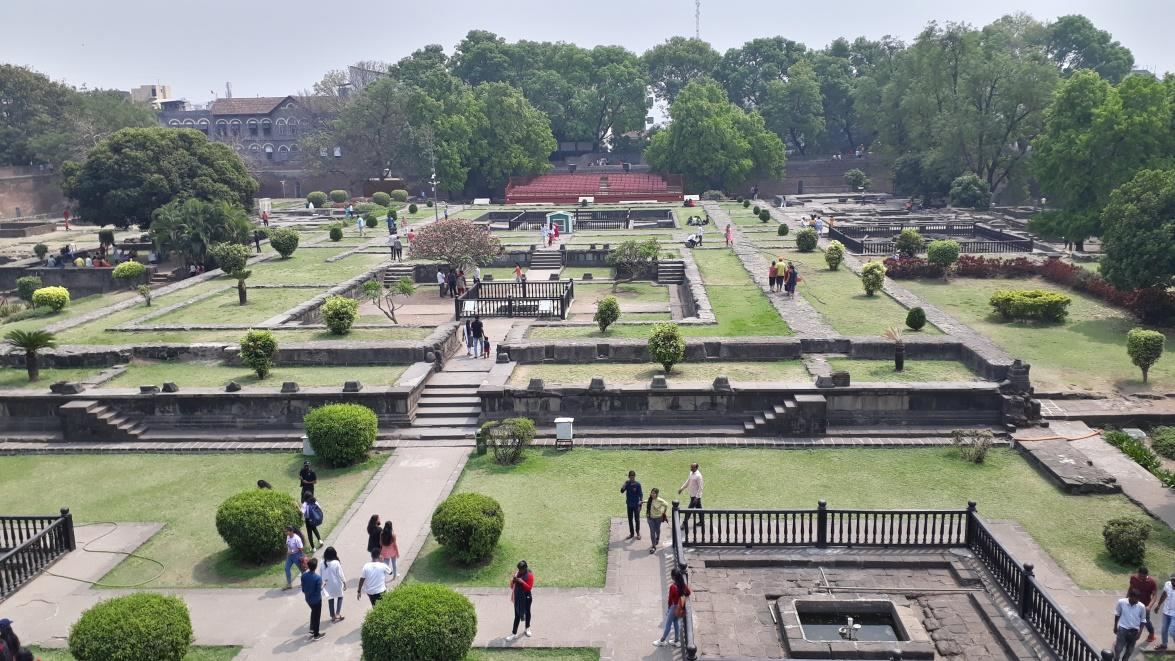
The complex included several notable structures, such as the Ganapati Rangmahal, used for Ganesh Chaturthi celebrations, and the Nachacha Diwan-khana, or Dancing Hall. The interiors were richly decorated with carved wooden panels, inlaid enamel work, and gilded detailing. Shaniwar Wada also housed a treasury, an armoury, a library containing manuscripts in multiple languages, and an art gallery featuring many paintings.
Following the Battle of Kirkee in 1817, the British East India Company took possession of Shaniwar Wada, using it for various administrative and military purposes, including a brief period as a military hospital. In 1828, a major fire swept through the complex, destroying much of the wooden structures, with only the outer fortifications and Nagarkhana surviving. Historian N.V. Joshi recorded the burning of Shaniwar Wada as a deeply affecting event for the citizens of Pune. The fort is said to have suffered at least four major fires in its history.
In the later days of the fort, a Batatya Maruti Mandir was built within the premises of the fort. According to locals, before the city expanded to its modern form, this courtyard was home to a bustling market. Vendors would sell a variety of vegetables, including potatoes, onions, and other produce from surrounding villages. The Mandir’s name, Batatya meaning “potato”, reflects this historical use, commemorating the bustling trade in produce that once took place there.
![An 1860 anonymous photograph of Shaniwar Wada and the thriving market.[65]](/media/culture/images/maharashtra/pune/cultural-sites/an-1860-anonymous-photograph-of-shaniwar-_TWSWexi.jpg)

Today, Shaniwar Wada is a preserved historical site managed by the ASI; it is the most iconic tourist spot of Pune, visited by residents and tourists.
A Haunted Fortress
Shaniwar Wada is associated with enduring local legends. Chief among these is the story of Peshwa Narayanrao, who was assassinated here in 1773. According to many residents, Shaniwar Wada is believed to be haunted by the spirit of this young Peshwa, who was brutally assassinated as a result of familial treachery. After the death of Peshwa Madhavrao I, the young Narayanrao, only seventeen years old, was named his successor. As he had not yet come of age, the regency passed to his uncle, Raghunathrao, also known as Raghoba. Over time, tensions grew between them, fuelled by Raghoba and his wife Anandibai’s ambition for power.
Anandibai, Raghoba’s wife, was said to be jealous and desired the throne for her husband; as a result, she sought the help of the Gardis, a community of highly trained guerrilla soldiers. Popular versions of the legend suggest that she forged a letter sent by her husband. The original order, which read “Narayanravana dharaa”, meaning “seize Narayanrao” intending abduction, was altered to “Narayanravana maara”, meaning “slay Narayanrao”. Acting on this forged command, the Gardis entered Shaniwar Wada on the eve of Ganesh Chaturthi to assassinate the young Peshwa. It is said that Narayanrao cried out desperately to Raghoba, “Kaka, malaa vachva!” meaning “Uncle, save me!”, but his pleas went unanswered as the Gardis brutally murdered him, mutilated his body, and dragged it out of the Wada premises.
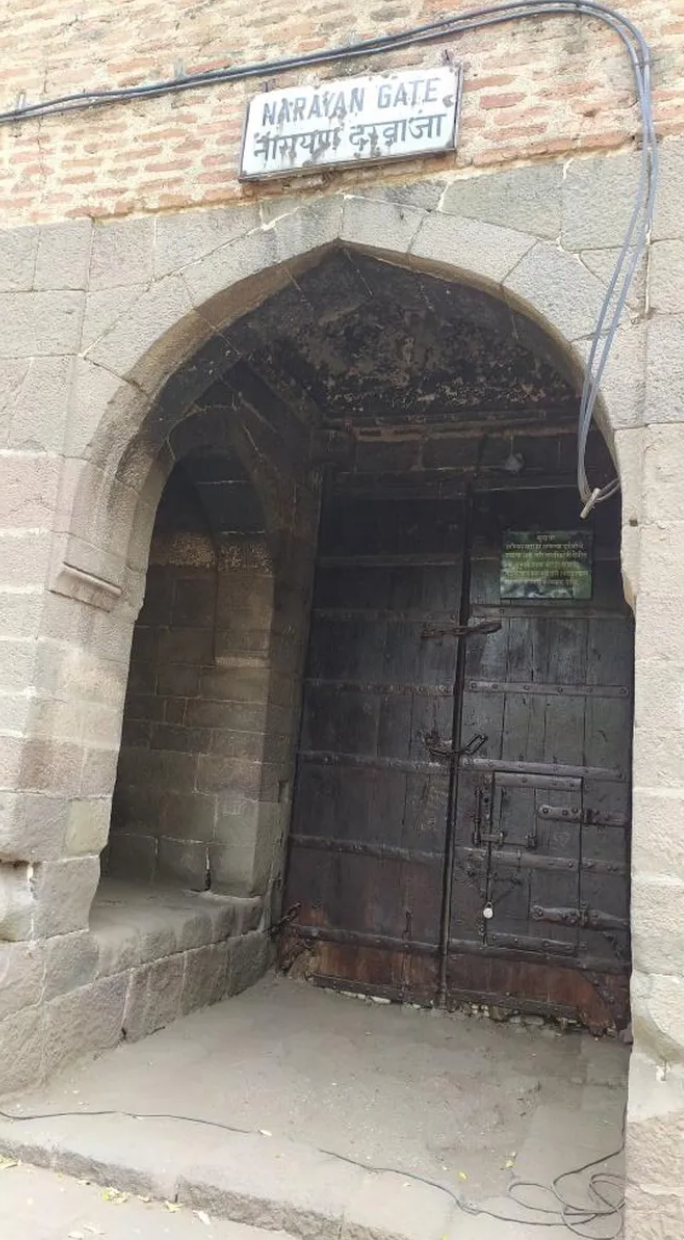
![A 1922 anonymous sketch of Narayanrao’s assassination.[66]](/media/culture/images/maharashtra/pune/cultural-sites/a-1922-anonymous-sketch-of-narayanraos-as_Ky2NcW6.jpg)
This tragic event is believed to haunt the premises to this day. Visitors are prohibited to enter Shaniwar Wada after sundown, while residents living around the fortress claim to hear the distressed cries of the young Peshwa during the night.
Shinde Chhatri
Shinde Chhatri in Wanawadi, is a memorial dedicated to Mahadji Shinde, a leading commander of the Maratha Empire. Mahadaji Shinde, noted for his role in the Third Battle of Panipat (1761), served as the commander of the Maratha forces under the Peshwas for two decades. He died in Wanawadi in 1794, and a memorial was erected at the site of his funeral pyre the same year. The present form of the complex was completed in 1965 under the patronage of Madhavrao Scindia, a descendant of the Scindia dynasty.
![The Samadhi of Mahadji Shinde within the complex in Wanawadi, Pune.[67]](/media/culture/images/maharashtra/pune/cultural-sites/the-samadhi-of-mahadji-shinde-within-the-_LbWLwRZ.jpg)
The site consists of two principal structures, a Shiv Mandir, built in black stone with a carved sandstone spire which was commissioned to be built by Shinde, and the chhatri, both of which incorporate elements of Rajasthani and colonial architecture.
![A rear view of the Shiv Mandir, which was built by Mahadji Shinde before his death.[68]](/media/culture/images/maharashtra/pune/cultural-sites/a-rear-view-of-the-shiv-mandir-which-was-_GPMi1z7.jpg)
The Chhatri is set within a large paved quadrangle, surrounded by 15 ft. high cut-stone walls. The imposing eastern entrance features a dindi darwaza or iron gate with an upper gallery and pavilions resting on vividly painted elephant sculptures, each holding a cannonball in its trunk. Above the gatehouse lies the Naubatkhana, where drums were traditionally played at midnight and twice daily to honour Mahadaji Shinde.
The interior of the chhatri is richly decorated with a marble floor, fluted pillars painted to resemble marble, and a vibrantly coloured ceiling in shades of blue, yellow, and green. Crystal lamps and gilded chandeliers illuminate the space, which also houses Mahadaji Shinde’s ceremonial items, including his palkhi, umbrella, and long-handled fans.
![The interior of the Shinde Chhatri is a unique blend of Anglo-Rajasthani architecture.[69]](/media/culture/images/maharashtra/pune/cultural-sites/the-interior-of-the-shinde-chhatri-is-a-u_LbC02h7.jpg)
![A seated statue of Mahadji Shinde in the Chhatri.[70]](/media/culture/images/maharashtra/pune/cultural-sites/a-seated-statue-of-mahadji-shinde-in-the-_jPZXnE0.jpg)
![A sculpture of Devi Saraswati playing the veena.[71]](/media/culture/images/maharashtra/pune/cultural-sites/a-sculpture-of-devi-saraswati-playing-the_0ah1A61.jpg)
Recognised as a Grade I heritage site by the PMC, Shinde Chhatri stands as a tribute to Mahadaji Shinde’s legacy and a reflection of architectural brilliance. Its unique blend of Anglo-Rajasthani styles, along with its historical significance, makes it a cherished landmark in Pune.
Shivkalin Peshvekalin Amruteshwar Mandir Samuh
The Shivkalin Peshvekalin Amruteshwar Mandir complex is located in Shaniwar Peth, near Shaniwar Wada. It was established by Bhiubai Baramatikar, Peshwa Bajirao II’s sister, in 1760. While the main Mandir is dedicated to Bhagwan Shiv, the other mandir are devoted to Bhagwan Vishnu, Ram, and Maruti.
![The kalash of the Amruteshwar Mandir in Shaniwar Peth, Pune.[72]](/media/culture/images/maharashtra/pune/cultural-sites/the-kalash-of-the-amruteshwar-mandir-in-s_gDH4yVi.png)
The stone Mandir complex is situated on an elevation above ground level to protect it from Mutha river floods. This Mandir is deemed a Grade I heritage site by the PMC. Mahashivratri (February-March) is the biggest festival celebrated here.
Shivneri Fort
Shivneri Fort is a hill fort located in Junnar taluka of Pune district. It holds a central place in Maratha history as the birthplace of Chhatrapati Shivaji Maharaj. Rising over 300 metres above the surrounding plains, Shivneri was strategically positioned to guard key trade routes between the Deccan plateau and the Konkan coast. The fort is currently designated as a Centrally Protected Monument under the Archaeological Survey of India (ASI).
![Shivneri Fort in Junnar taluka, known as the birthplace of Chhatrapati Shivaji Maharaj.[73]](/media/culture/images/maharashtra/pune/cultural-sites/shivneri-fort-in-junnar-taluka-known-as-t_VuzFcsq.png)
Shivneri has a long and layered history. It is noted in the district colonial Gazetteer (1885) that the region may have been a prominent Buddhist center during the first three centuries CE. The nearby Shivneri Caves, with their rock-cut architecture, are indicative of this early phase. By the medieval period, Shivneri's strategic location drew the attention of regional powers. Notably, it is mentioned in the district Gazetteer that the fort was likely used for military purposes by the Yadava dynasty of Devagiri (12th–14th century), reflecting a shift from its earlier religious significance to a fortified role in regional defense. It is also mentioned there that much of Shivneri’s current structure was built or modified during the rule of the Bahmani and Ahmadnagar Sultanates, as seen in the arches and gateways.
In 1443, the fort was captured by Malik Ul Tujar, a general of the Bahmani Sultanate. After a brief period of instability, it was retaken in 1470 by another Bahmani officer, Malik Mahammad. Following his death in 1446, the fort came under the control of the newly formed Nizam Shahi dynasty. Shivneri remained an important administrative center under Ahmad Nizam Shah I, the founder of the dynasty and Sultanate. In 1565, Sultan Murtaza Nizam Shah I (ruler of the Nizam Shahi dynasty during the mid–late 16th century) imprisoned his brother Kasim Nizam Shah (younger brother and rival claimant) at Shivneri, using the fort as a secure detention site.
![The Kamani Masjid was constructed within Shivneri Fort either during the Bahmani period or Ahmednagar Sultanate.[74]](/media/culture/images/maharashtra/pune/cultural-sites/the-kamani-masjid-was-constructed-within-_X3Dgkgq.jpg)
In 1595, the fort was granted as a jagir to Maloji Bhosale (grandfather of Shivaji Maharaj and a Maratha noble in service to the Ahmadnagar Sultanate). It is said that he was given Shivneri, along with Pune and Supa as a reward for his military service. Under Bhosale’s administration, the fort was maintained and fortified. His daughter-in-law, Jijabai (mother of Shivaji Maharaj and wife of Shahaji Bhosale), was brought to the fort for safety during her pregnancy, and it was here that Shivaji Maharaj was born on 19 February 1630. Fascinatingly, according to local tradition, it is said that Jijabai had vowed to name her child after Shivai Devi whose Mandir lies within the fort.
![The Mandir of Shivai Devi, the Devi after whom Shivaji Maharaj is said to have been named.[75]](/media/culture/images/maharashtra/pune/cultural-sites/the-mandir-of-shivai-devi-the-devi-after-_kQxF7e6.jpg)
![Jijabai’s palace within Shivneri Fort where Shivaji Maharaj was born.[76]](/media/culture/images/maharashtra/pune/cultural-sites/jijabais-palace-within-shivneri-fort-wher_IolZpoJ.jpg)
By the 17th century, the Nizam Shahi dynasty had weakened, and the Mughal Empire (16th–19th century) sought to absorb its remaining territories. In 1637, Shivneri Fort was surrendered to Mughal forces following a siege. Shahaji Bhosale (father of Shivaji Maharaj and a military leader who had served both the Nizam Shahi and Bijapur Sultanates) subsequently entered the service of the Bijapur Sultanate (15th–17th century).
Shivneri remained under Mughal control for several decades. In 1673, Shivaji Maharaj attempted to negotiate with the fort's commander Ajijkhan (a Mughal officer), and surrounded the fort, but the attempt to capture it was unsuccessful.
In 1716, the fort came under the control of Shahu Maharaj (grandson of Shivaji Maharaj and ruler of the Maratha Empire after Aurangzeb's death) and was subsequently incorporated into the Maratha Empire (17th–19th century). It was later administered by the Peshwas (18th–19th century). Following the Third Anglo-Maratha War, British forces (18th–20th century) took control of the fort in 1819. By this time, the fort's strategic significance had diminished.
Today, Shivneri Fort stands as a significant heritage site with several landmarks still intact. These include the Shivai Devi Mandir, a prayer hall, and the Badami Talav, a small lake within the fort. Visitors enter through a steep approach leading to a tall, fortified gateway, then pass through seven gates, one of which is fitted with iron spikes designed to deter elephants. The fort’s layered history, from ancient religious site to a stronghold of empire, in many ways, continues to make it a powerful symbol of Maharashtra’s cultural and historical identity.
Shree Adeshwar Maharaj Mandir (Gotiwala Dhada)
The Shree Adeshwar Maharaj Mandir is located in Shukrawar Peth and was founded in the 19th Century. It is locally known as Adeshwar Maharaj Panch Dasha Oswal Sirohiya Gotiwala Mandir after Oswal Sirohiya Gotiwala who is said to have restored and renovated the Mandir.
![Front view of the Shree Adeshwar Maharaj Mandir, Shukrawar Peth, Pune.[77]](/media/culture/images/maharashtra/pune/cultural-sites/front-view-of-the-shree-adeshwar-maharaj-_oeqWPML.png)
The Mandir is three-storeys high and contains ornate carvings in stone and marble. The architecture follows Maru-Gurjara or Solanki style, found in Gujarat and Rajasthan in the 11th and 13th centuries. The exterior is lined with shikharas (small domes) of different sizes, sharply carved statues in niches. There are elephant motifs carved into the Mandir as well.
The interior is decorated with ‘flying’ arch-like elements and engraved columns. Its mandap resembles the one in Ranakpur Jain Mandir in Rajasthan. Some prominent festivals celebrated here are Mahavir Jayanti, Paryushan Parv, and Ayambil Oli. The daily prayers are conducted in Prakrit, Sanskrit and Gujarati languages.
Shree Balaji Mandir
Shree Balaji Mandir is located in Ketkawale, near Narayanpur, along the Pune-Bangalore Highway. It is a modern site dedicated to Bhagwan Venkateswara and is often referred to as Prati Balaji due to its architectural resemblance to the historic Mandir at Tirumala in Andhra Pradesh.
![Gopuram of Shree Balaji Mandir in Katkewal, Pune district, designed as a replica of the Tirumala Mandir of Andhra Pradesh.[78]](/media/culture/images/maharashtra/pune/cultural-sites/gopuram-of-shree-balaji-mandir-in-katkewa_w3cmS8h.png)
The complex was developed by the Venkateshwara Charitable Trust between 1996 and 2003. The design closely follows the Dravidian style, incorporating elements such as the gopuram (gateway tower), vimana (tower above the garbhagriha), and granite sculptures that echo those of the Tirumala site.
The central garbhagriha houses an image of Bhagwan Balaji (Venkateswara), and the larger complex includes dedicated mandirs for Padmavati Devi, Bhagwan Hanuman, and Bhagwan Lakshmi Narasimha. Ritual practice follows Vaikhanasa Agama tradition (a South Indian tradition of temple ritual and worship), and daily pujas, archanas (name-recitation rituals), and abhishekams (ceremonial bathing of the deity) are conducted by pujaris.
Devotees visiting the site are offered prasad and can participate in various services. The location serves as a regional alternative for those unable to travel to Tirupati and has become a popular destination for darshan, particularly on weekends and festival days.
Shree Laxminarasinha Mandir
The Shree Laxminarasinha Mandir is located in Sadashiv Peth and was built in 1774. The area in which it is located was known as Karkolpur in ancient times. The Mandir has been there even before the area of Sadashiv Peth was set up. The origins of the Mandir are tied to Ganesh Bhatt Joshi, a pujari who had earlier served at the Narasimha Mandir in Sangameshwar, Chiplun, before settling in Pune during the Peshwa period.
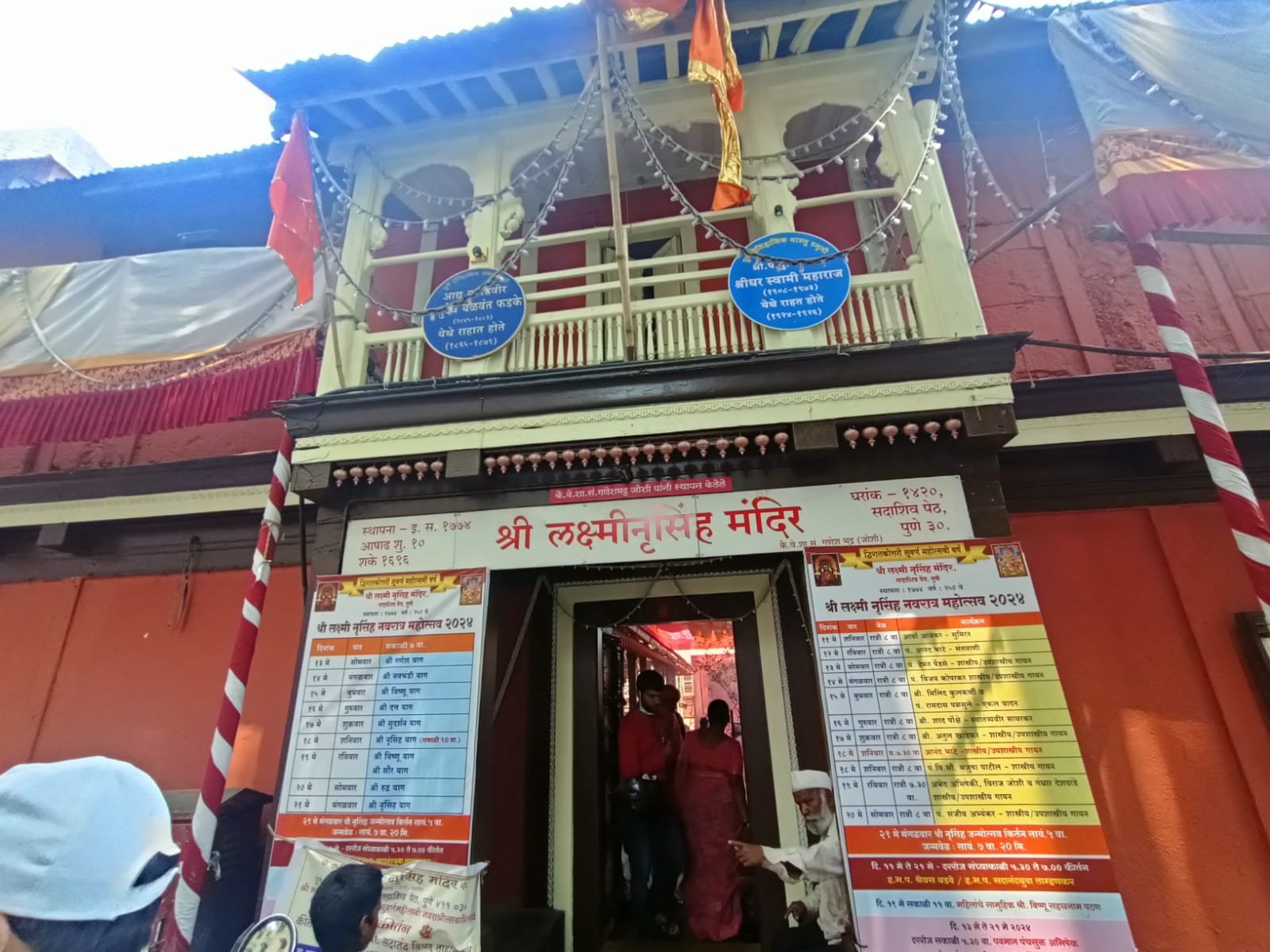
It is said that after leaving his post, Ganesh Bhatt felt deep remorse for having stepped away from the Devta’s service. Shree Narasimha is believed to have appeared to him in a dream, instructing him to retrieve a murti from Kashi if he truly wished to return to service. Around 1693, he and his wife journeyed to Kashi in search of the murti. Soon after, a large cactus (nivdunga) fell in his path, a sign he took as divine. Near it, he discovered a 2.5 ft. marble murti of Shree Narasimha seated in Padmasana, with Devi Laxmi on his lap.
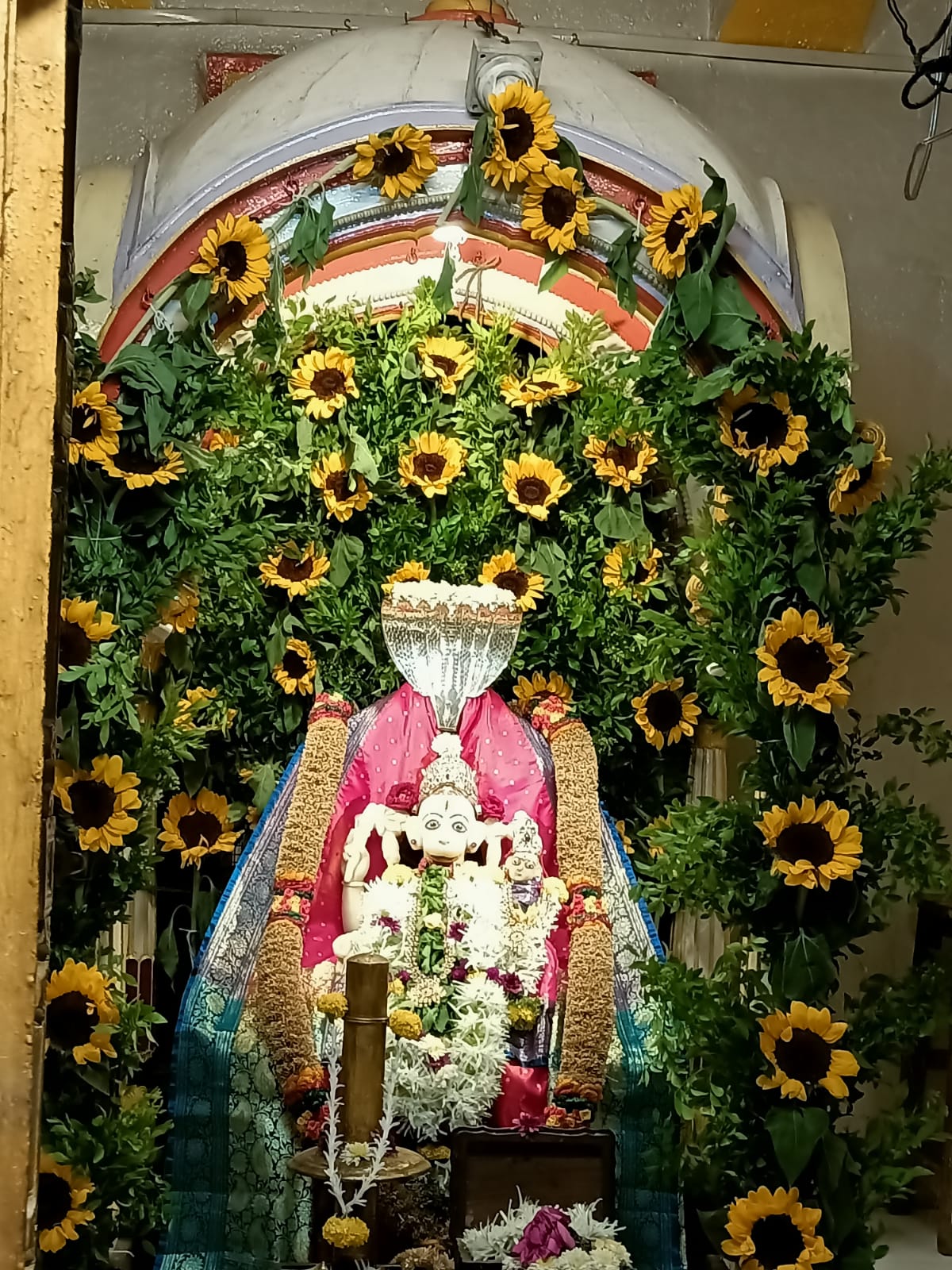
Ganesh Bhatt carried the murti back to Pune on his shoulder. On the way, the murti was first kept at the Kashi Vishweshwar Mandir, where a ceremonial abhishek was performed. From there, it travelled through Puri, Indore, and Nashik before reaching Pune. Its arrival was welcomed by the Peshwas, who commissioned the construction of the current mandir. Ganesh Bhatt was appointed as its first pujari, and the construction was completed in 1774 by an architect named Naik.
Narasimha Navratri is the Mandir’s main annual festival, celebrated here during the month of Vaishakh (April–May).
Shree Siddhivinayak Mandir, Sarasbaug
Shree Siddhivinayak Mandir, located within the Sarasbaug complex near Swargate, Pune, is one of the city's most important Ganesh mandirs. The site dates back to the 18th century and holds both religious significance and a unique place in the political history of the Maratha period. Also known as Talyatla Ganpati (Ganpati of the lake), the Mandir was originally built between 1750 and 1784 during the Peshwa period under the orders of Balaji Bajirao Peshwe, commonly known as Nanasaheb Peshwe.
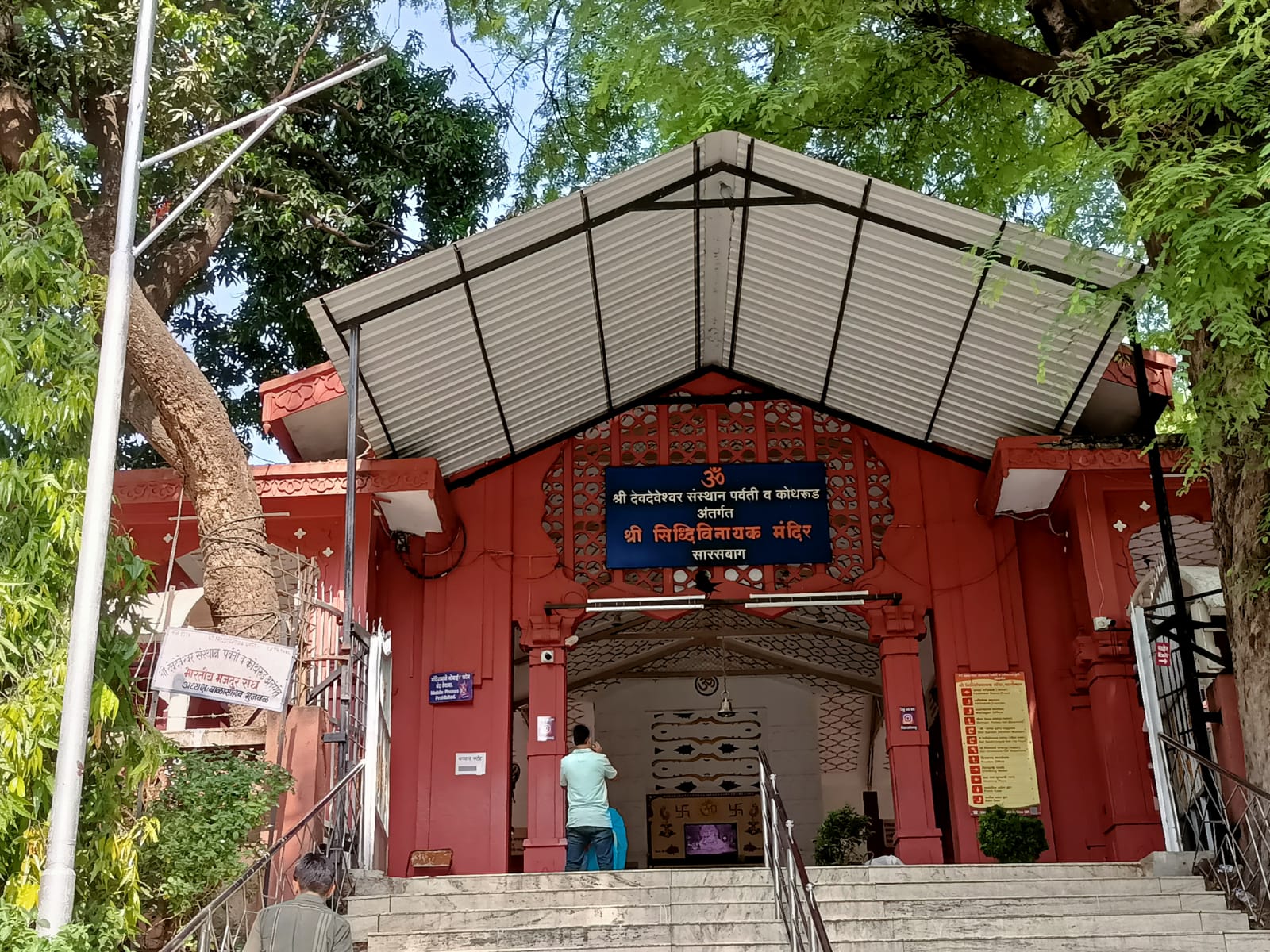
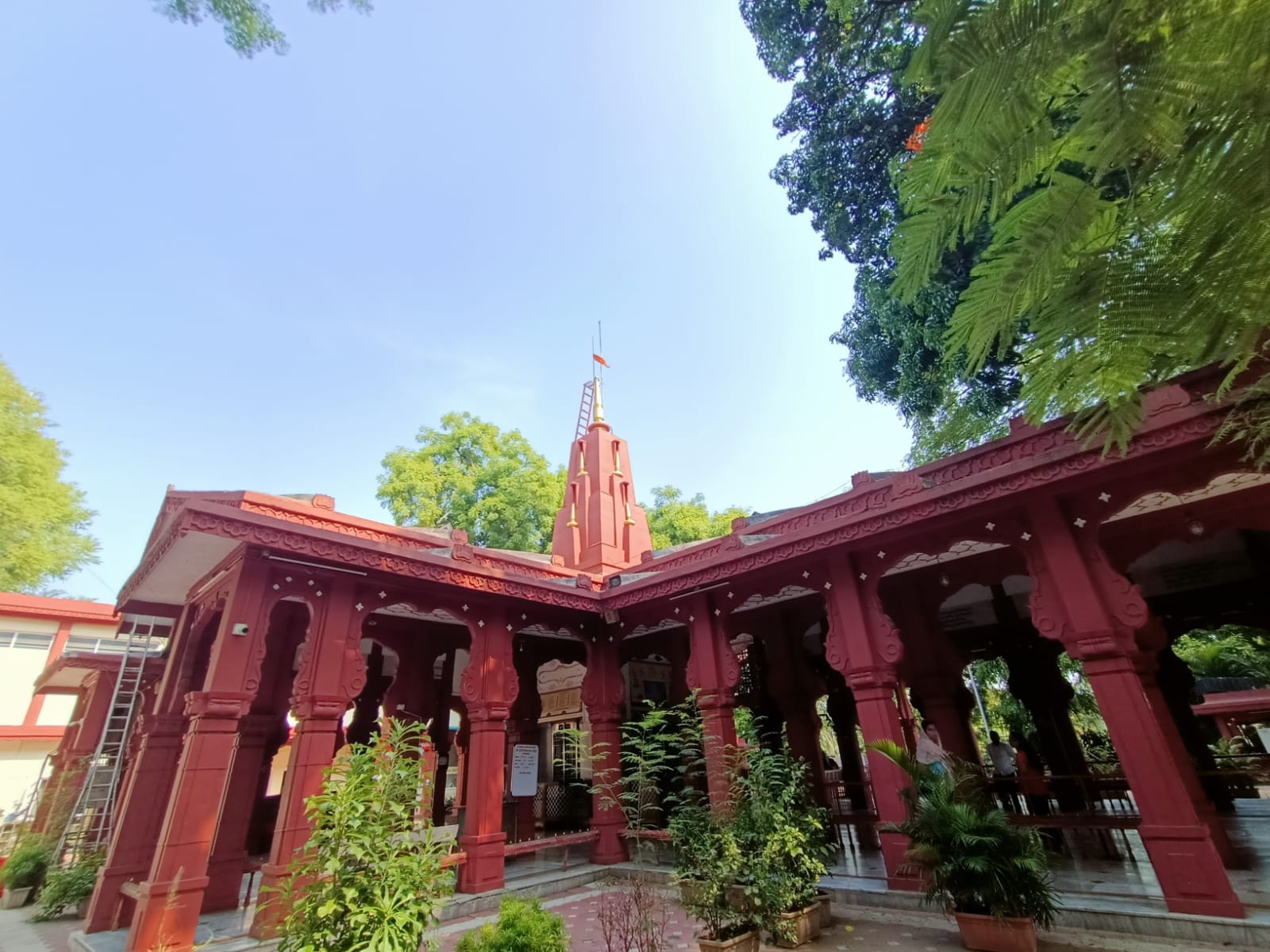
The lake was part of a broader Maratha strategy, used not only for water management but also as a discreet location for strategic meetings. It is said that the Peshwa and his advisors travelled by boat to the island to hold confidential discussions. The boatmen, often brought from outside the region (such as from Africa), could not understand Marathi, helping to preserve secrecy.
The lake eventually dried up, and the island became part of what is now known as Sarasbaug—a 25-acre public park maintained by the Pune Municipal Corporation. The mandir has undergone several phases of renovation, during British rule in 1842, and again in 1969, under the supervision of Mahadev Kumthekar and Anandrao Mane, which included the creation of the now-defunct Peshwe Park Zoo nearby.
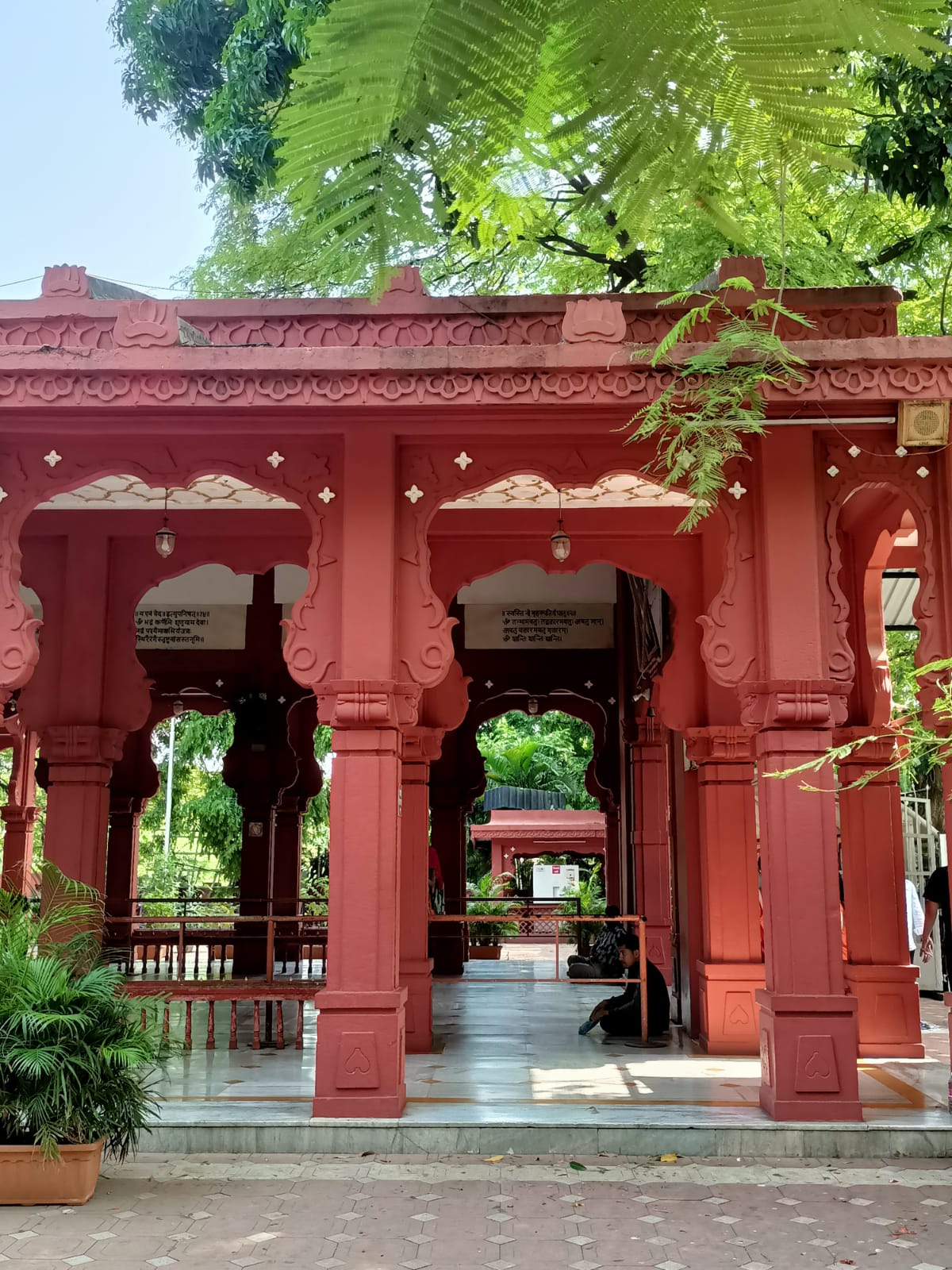
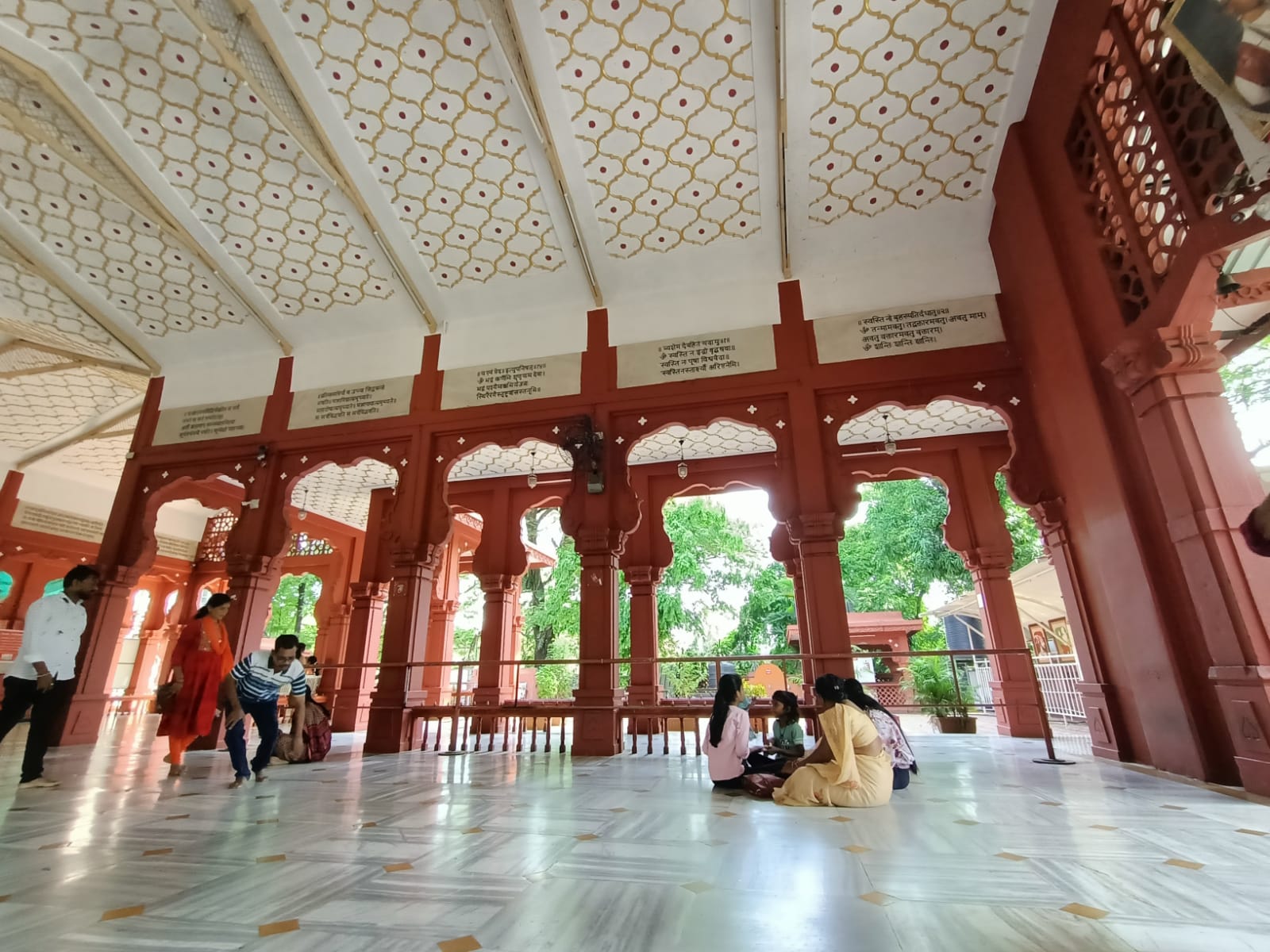
Inside the garbhagriha, a white marble murti of Siddhivinayak stands as the focal point of worship. The space often draws over 10,000 devotees daily, with numbers rising to 30,000 on special days such as Ganesh Chaturthi. A long-standing local belief holds that devotees who offer sincere prayers here for 21 consecutive days will have their wishes fulfilled.
In 1995, a museum was added behind the Mandir to display over 100 artistic representations of Bhagwan Ganesh in different forms and styles.
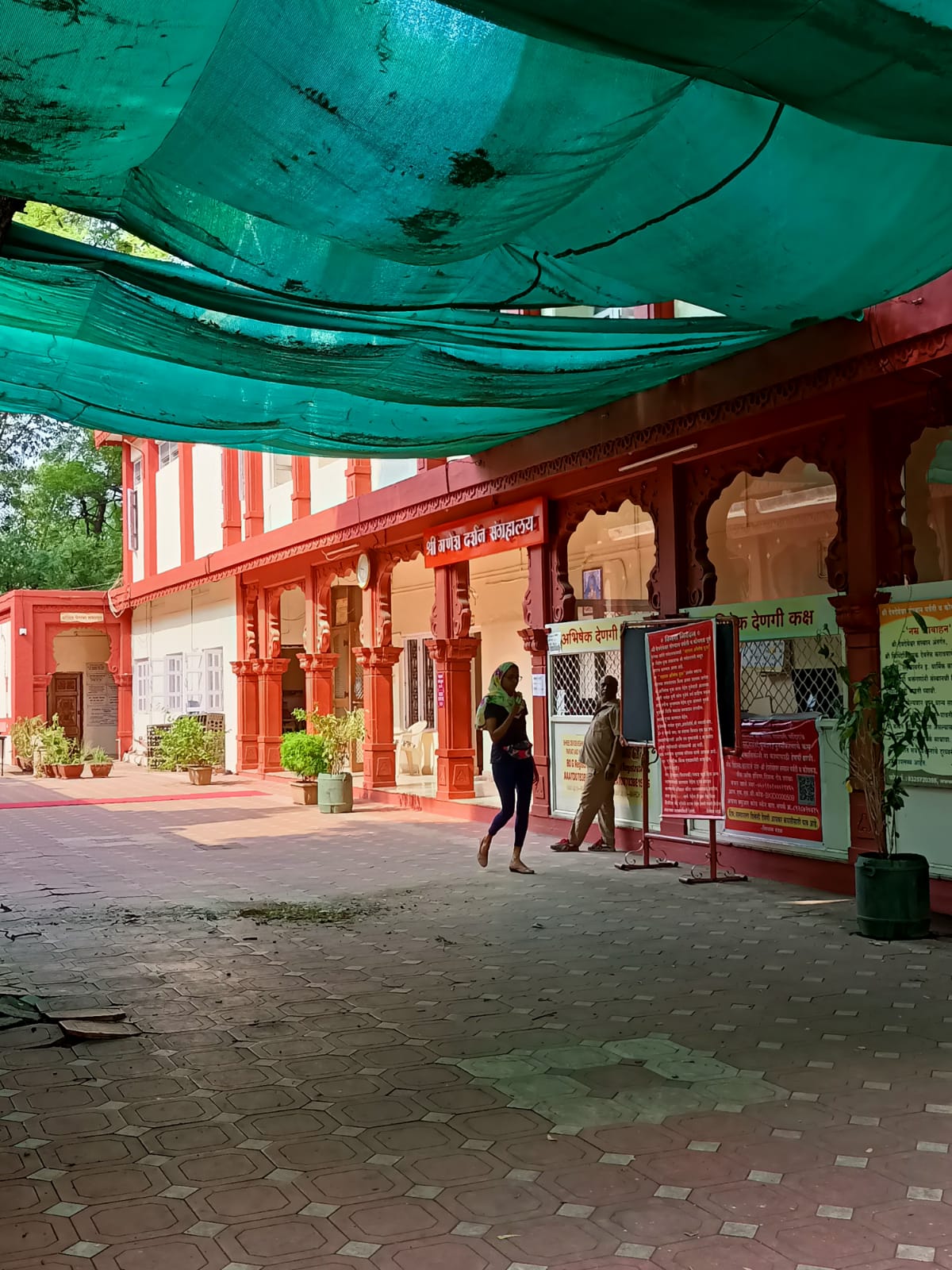
Each year, Sarasbaug hosts a grand Deepotsav, during which the complex is decorated with thousands of oil lamps and flower rangolis. Chinese lanterns float into the night sky, creating a magical atmosphere. Puja ceremonies begin in the evening and often continue till early morning.
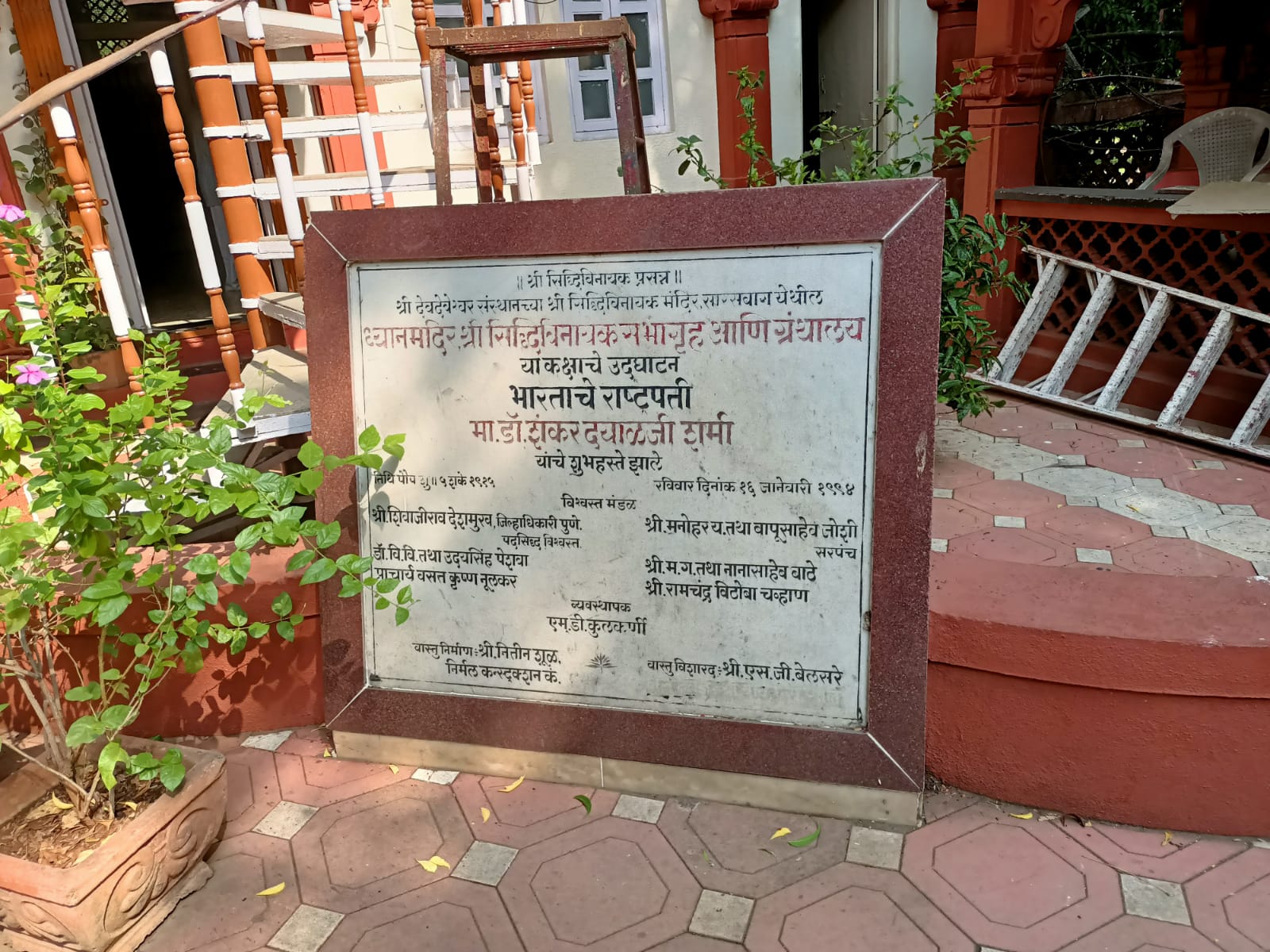
While the Mandir remains the religious focus, the surrounding Sarasbaug garden contributes to its popularity as a public destination. It features open lawns, the Phulrani mini train, and a pond that houses turtles, fishes, and lotuses.
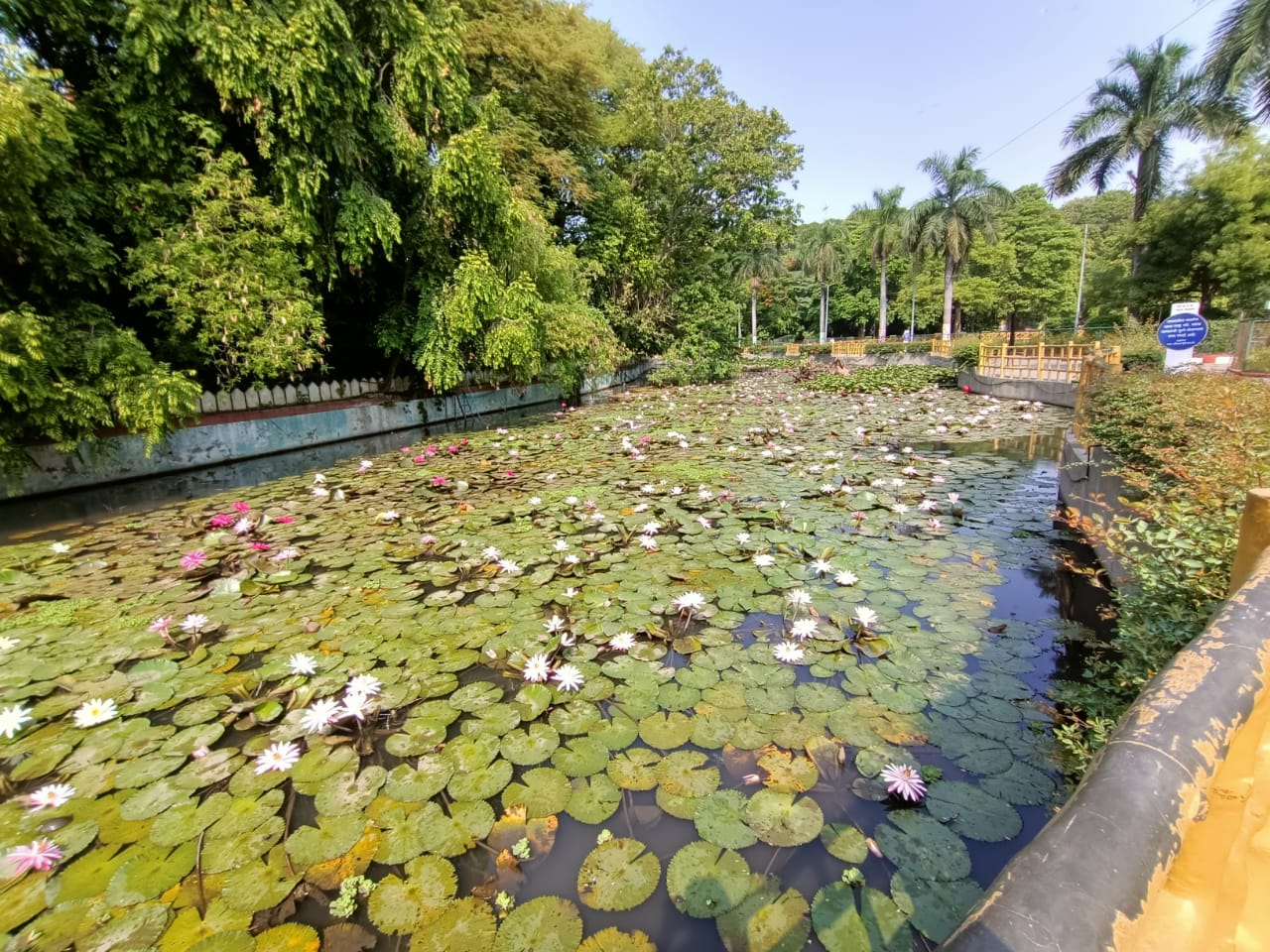
Shri Chattushringi Devi Mandir
The Shri Chattushringi Devi Mandir is located on Senapati Bapat Road, believed to have been built during Chhatrapati Shivaji Maharaj’s rule. The Mandir’s presiding Devi is Maa Chaturshrungi, also referred to as Ambareshwari, who is regarded as Pune's ruling devi. The Mandir is 90 ft high and one has to climb 170 steps to reach it. Chaturshrungi means four and the Mandir premises contain four other shrines devoted to other Devtas. These smaller mandir are located on four separate hillocks.
![Chattushringi Devi Mandir, Senapati Bapat Road, Pune.[79]](/media/culture/images/maharashtra/pune/cultural-sites/chattushringi-devi-mandir-senapati-bapat-_FPG9nEc.png)
According to one story, during the Peshwa period around 250 years ago, a bhakt named Durlabhsheth Pitambardas Mahajan, a moneylender and mint owner in Pune, was known for making an annual yatra to the Saptashrungi Devi Mandir at Vani. As he grew older and could no longer make the journey, he prayed to the Devi in distress. It is said that the Devi appeared to him in a dream and instructed him to dig at a specific hill in the northwest of Pune. When he followed her directions, he discovered a swayambhu form of the Devi and built a Mandir at the site. This is believed to be the origin of the present-day Chattushringi Mandir.
The Mandir is renowned for its grand Navratri celebrations, attracting thousands of people from Pune and nearby areas. A fair is held on the eve of Navratri, with the Mandir beautifully decorated with lights and flowers. Cultural programs, including classical music and dance performances, add to the festivities.
Shri Chhatrapati Sambhaji Maharaj Samadhi, Vadhu Budruk
The Shri Chhatrapati Sambhaji Maharaj Samadhi, located in Vadhu Budruk, a village in Shirur tehsil of Pune district, is a memorial site widely regarded as the final resting place of Chhatrapati Sambhaji Maharaj, the second ruler of the Maratha Empire and son of Chhatrapati Shivaji Maharaj. Following his execution by Mughal forces at Tulapur in 1689, it is believed that his remains were brought to Vadhu Budruk, where this samadhi was later established.
![The memorial complex at Vadhu Budruk, Pune district. The site includes the samadhi of Chhatrapati Sambhaji Maharaj, widely regarded as his final resting place, and of Kavi Kalash, his close associate who was executed alongside him in 1689.[80]](/media/culture/images/maharashtra/pune/cultural-sites/the-memorial-complex-at-vadhu-budruk-pune_3dcdVB7.png)
According to an article in eSakal (2023), the samadhi and vrindavan at Vadhu Budruk are said to have been constructed under the patronage of Chhatrapati Shahu Maharaj, the successor of Chhatrapati Sambhaji Maharaj. The site also includes a separate memorial for Kavi Kalash, a poet and close confidant of Sambhaji Maharaj, who was executed alongside him.
It features a small pictorial display depicting events from Sambhaji Maharaj’s life. Among the exhibits is a letter believed to have been written by Sambhaji Maharaj to Ram Singh, offering insight into his views during the period of Mughal-Maratha conflict.
Today, the samadhi continues to serve as a site of remembrance and historical interest, drawing both his followers and many visitors.
Shri Khandoba Mandir
Shri Khandoba Mandir is located in Jejuri, about 49 km southeast of Pune. It is the main place of worship for Bhagwan Khandoba, a warrior form of Shiva, revered as a kuldaivat by many communities across Maharashtra, Karnataka, and Telangana. The Mandir stands atop a hill at about 718 meters and can be reached by climbing nearly 200 stone steps.
![Yatris gathered around the turmeric-covered Shri Khandoba Mandir, Jejuri, Pune district which is a major religious and cultural site in Maharashtra.[81]](/media/culture/images/maharashtra/pune/cultural-sites/yatris-gathered-around-the-turmeric-cover_JlDL4DL.png)
Khandoba is regarded as a guardian deity and kuldev by many communities, including Dhangars, Marathas, Malis, and others. He is typically depicted riding a white horse, armed with a khadga (sword), and accompanied by his consort Mhalsa Devi and a dog.
The Mandir stands atop a hill known as Jejurigad, and is reached by climbing close to 200 stone steps. Along the way, yatris pass under arched gateways, stone mandirs, and ancient deepmalas—tall stone lamp towers that are among the oldest of their kind in the region. The climb offers wide views of the surrounding plains and leads to a large fortified courtyard housing the main shrine.
One of the most distinctive features of worship at Jejuri is the ritual use of turmeric powder (bhandara). Devotees shower the shrine and one another with it, turning the entire complex bright yellow. This visual transformation has earned Jejuri the nickname “Sonyachi Jejuri” (Golden Jejuri). The act is accompanied by collective chants of “Yelkot Yelkot Sadanandacha”, invoking Khandoba’s name in joy and devotion.
A central narrative associated with the site tells of Malla and Mani, two asurs said to have terrorized the earth. Bhagwan Khandoba, in his form as Martanda Bhairava, is believed to have vanquished them after a prolonged battle. Malla was slain and his head thrown onto the steps of the Mandir, while Mani, who surrendered and offered his service to humankind, was spared. This story continues to shape the rituals and oral traditions associated with the Mandir.
![An archival image of Jejuri, showing the village in the foreground and the Khandoba Mandir crowning the hill in the background, dated between 1855 and 1862.[82]](/media/culture/images/maharashtra/pune/cultural-sites/an-archival-image-of-jejuri-showing-the-v_wOQpEi8.png)
The structure of the Mandir includes with black basalt stonework, a fortified courtyard, and a large assembly hall (mandap). Notable features include tall deepmalas, ceremonial weapons, and a large brass-sheathed tortoise embedded in the floor. In the 18th century, it is said that significant renovations were carried out here under the patronage of Ahilyabai Holkar and her general Tukoji Rao Holkar.
There are many interesting events and legends that are tied to the Mandir. In 1662, it is believed that after many years of separation, Shivaji Maharaj and his father Shahaji Raje met here. Another local account mentions that during a Mughal campaign, after attempting to destroy the Mandir, Aurangzeb and his forces were disrupted by a swarm of bees near the shrine, after which he is said to have donated a diamond to the Devta.
Today, Jejuri remains a key tirtha yatra destination, especially during Champa Shashti, Dasara, and other punyatithis. One of the unique and eduring customs practiced at Jejuri involves newly married couples, where the groom carries the bride up the steps to the sanctum. The act, often completed amid laughter and encouragement from fellow yatris, is considered a gesture of devotion and strength.
With its mix of folk worship, regional history, and active ritual life, Shri Khandoba Mandir remains a deeply rooted part of Maharashtra’s religious and cultural landscape.
Shri Mrutyunjayeshwar Mandir
![Front view of the Mruntyunjayeshwar Mandir, Karve Road, Pune.[83]](/media/culture/images/maharashtra/pune/cultural-sites/front-view-of-the-mruntyunjayeshwar-mandi_AUAYJI6.png)
The Shri Mrutyunjayeshwar Mandir is located on Karve road, Kothrud. It was built in the 19th century, during the Peshwa reign. Bhagwan Shiv is worshiped here and a grand Shivling is enshrined in the Mandir. The Mandir’s walls have carvings of Bhagwan Shiva and Devi Parvati and the walls narrate stories about the two.
The Mandir is believed to have been built by Sardar Ballal Phadke, a key figure in the Peshwa army and an associate of Nana Fadnavis. The Mandir holds strong historical associations with the Peshwas and is often linked to Mastani, the second wife of Peshwa Bajirao I. It is said that Mastani once lived in the vicinity of the Mandir after Bajirao built her a separate residence in Kothrud in 1734, following growing tensions with his family over their marriage. The Mandir stood next to her residence and it is widely believed that Mastani may have visited it. In 1940, remnants of her palace were discovered near the Mandir.
The Mandir draws bhakts from across the country and abroad. Several festivals are observed at the Mandir, including the Shravan Utsav festival, which occurs in the fifth month of the Hindu calendar (mid-July to mid-August according to the Gregorian calendar). Deep Utsav, a festival of lights, and the festival of Maha Shivratri, which is dedicated to Bhagwan Shiv are also celebrated here. The Shri Mruntyunjayeshwar Mandir has been declared a Grade II heritage site by the PMC.
Shri Sant Dnyaneshwar Maharaj Samadhi Mandir
Shri Sant Dnyaneshwar Maharaj Samadhi Mandir is located in Alandi, on the banks of the Indrayani River, about 21 km from Pune. It marks the final resting place of Sant Dnyaneshwar (1275–1296), a 13th-century Marathi sant, poet, and philosopher renowned for his commentary on the Bhagavad Gita, known as the Dnyaneshwari.
![The Samadhi Mandir of Sant Dnyaneshwar in Alandi, a prominent site of Warkari yatra.[84]](/media/culture/images/maharashtra/pune/cultural-sites/the-samadhi-mandir-of-sant-dnyaneshwar-in_ka3GUiS.png)
At the age of 21, Dnyaneshwar is believed to have taken sanjeevan samadhi (a yogic form of consciously leaving the body) beneath the spot where the Mandir now stands. The structure was later developed and expanded by followers and patrons, including figures from the Maratha period. Inside the sanctum are his paduka (symbolic sandals), which are the focus of daily puja and seva.
Alandi is a key center in the Wari tradition, particularly during the annual Ashadhi Wari, when thousands of Varkaris walk in yatra from Alandi to Pandharpur. They carry Sant Dnyaneshwar’s paduka in a ceremonial palkhi, singing abhangas (devotional verses) along the way. The Wari covers more than 200 km and takes several weeks.
![The Indrayani River ghat at Alandi, where Varkaris gather during the annual Palkhi procession as part of the Wari to Pandharpur.[85]](/media/culture/images/maharashtra/pune/cultural-sites/the-indrayani-river-ghat-at-alandi-where-_FIBsD4w.png)
The Mandir remains active throughout the year, especially during major observances such as punyatithis (death anniversaries of sants) and ekadashis (ritual fasting days observed on the eleventh day of the lunar cycle), both of which hold special importance in the Varkari tradition.
Sinhagad Fort
Sinhagad Fort, formerly known as Kondhana, is located 49 km southwest of Pune, atop a 2,490 ft. hill in the Sinhagad–Bhuleshwar range. It is accessible by two main routes, the steep Pune Gate to the northeast and the more gradual Kalyan Gate to the southeast.
![An aerial view of the top of Sinhagad Fort on a cliffside.[86]](/media/culture/images/maharashtra/pune/cultural-sites/an-aerial-view-of-the-top-of-sinhagad-for_weemoZm.jpg)
The fort has passed through the hands of various rulers over the centuries. In 1328, Muhammad bin Tughluq’s forces captured Kondhana after an eight-month siege against Nag Naik, a local Koli chieftain who led the fort’s defense. Notably, Nag Naik’s role, in many ways, reflects the fort’s deep connection to local power structures before it became a battleground for larger dynasties.
In 1486, according to the district colonial Gazetteer (1885), Kondhana was among several forts in the Pune region that came under the control of Malik Ahmad, the founder of the Ahmadnagar Sultanate. During the early 17th century, Shahaji Bhonsale, father of Shivaji, held Kondhana as part of his administrative domain under the Ahmadnagar rulers, although it later passed into Bijapur’s possession following a political compromise in 1637.
A decade later, in 1647, Chhatrapati Shivaji Maharaj, then still consolidating his base, secured the fort through negotiation and a significant bribe to the Muslim commandant. The Gazetteer emphasizes this moment as a formative step in Shivaji's assertion of autonomous power in the Pune region.
In many ways, Sinhgad was more than a symbol, it became a tactical base during Shivaji’s campaign against the Mughals. In 1662, as Shaiste Khan, a Mughal general, advanced into the Deccan, Shivaji launched a daring night raid on his residence in Pune. He and his small party managed to injure Khan, severing his thumb, before escaping. It is noted in the colonial Gazetteer that after that incident, “The Marathas retired, lighting torches and burning bonfires as they went up Sinhgad hill in derision of the The attackers managed to injure Khan, severing his thumb, before escaping.
However, in April 1665, a large Mughal army under Mirza Raja Jai Singh (Rajput noble of the Kachwaha dynasty of Amber and a commander in the Mughal Empire under emperors Shah Jahan and Aurangzeb) laid siege to Purandar Fort and blockaded Sinhgad, where Shivaji's wife and other family members had taken refuge. Unable to break the siege or secure their rescue, Shivaji initiated negotiations. The Gazetteer reports that "7000 persons, men, women, and children came out of Sinhgad fort" following the agreement. As part of the resulting Treaty of Purandar, Shivaji ceded Sinhgad, along with 22 other forts, to the Mughals.
It was not until February 1670 that Shivaji mounted a campaign to retake Sinhgad, assigning the operation to Tanaji Malusare, whose actions during the battle became legendary. This, in many ways, marked the beginning of a renewed Maratha offensive in western Maharashtra.
The Battle of Sinhagad in 1670
In 1670, the fort became the site of one of the most well-known battles in Maratha history. Tanaji Malusare, military commander of the Maratha Empire and close companion of Shivaji Maharaj, led a force of around 300 Maratha soldiers in a surprise night assault against a much larger Mughal garrison commanded by Udaybhan Rathod, a Rajput officer serving the Mughals. Interestingly, it is said that the Marathas scaled the fort’s steep cliffs with the help of a trained Bengal monitor lizard, also known as ghorpad, to secure climbing ropes.
In the battle that followed, both Tanaji and Udaybhan succumbed to their grave injuries in a violent duel, but the former’s sacrifice inspired the Marathas to continue their attack. Under the leadership of his brother Suryaji, the Marathas captured the fort. Upon learning of Tanaji’s death, according to legend, Shivaji Maharaj expressed his sorrow by uttering the phrase, “Gad aala, pan sinha gela” meaning “We won the fort, but lost the lion”. It is said that in Tanaji’s honor, the fort was thus renamed ‘Sinhagad’ meaning ‘Lion’s Fort’, and his memory lives on with his Samadhi installed at the site.
![The Samadhi of Tanaji Malusare at Sinhagad.[87]](/media/culture/images/maharashtra/pune/cultural-sites/the-samadhi-of-tanaji-malusare-at-sinhaga_IZKluJg.jpg)
![A bronze bust of Tanaji has been erected at Sinhagad to honour his ultimate sacrifice and bravery.[88]](/media/culture/images/maharashtra/pune/cultural-sites/a-bronze-bust-of-tanaji-has-been-erected-_otb4BGI.jpg)
18th-20th Century Conflicts
Sinhgad changed hands multiple times in the ongoing struggle between the Marathas and Mughals. In 1703, Aurangzeb besieged the fort and eventually secured it by bribing the commandant. The Mughal emperor renamed it Bakshindabaksh, meaning “God’s Gift.” However, the Marathas retook the fort shortly afterward under Shankraji Narayan, who managed the surrounding territory. Notably, the Gazetteer notes that “the loss of Sinhgad was a great grief to Aurangzeb and aggravated the illness of which in the next year he died.”
During the Second Anglo-Maratha War (1802–1805), Sinhgad briefly served as a refuge for Peshwa Baji Rao II following his defeat at the Battle of Poona in 1802. In the subsequent conflict (the Third Anglo-Maratha War) British forces under General Pritzler launched a formal siege of the fort in February 1818. After several days of bombardment, Sinhgad was captured and later looted.
The Poona District Gazetteer (1885) records that significant quantities of treasure were discovered within the fort, including a golden murti (idol) of Bhagwan Ganesh concealed in a masonry pillar, reputedly valued at £50,000. It further notes that a ransom of £15,000 was offered for its return.
Following its occupation by the British, Sinhgad was used briefly as a place of detention. Among those confined was Babaji Pant Gokhale, implicated in the Talegaon killings, who remained there until his death in 1835.
Today, Sinhgad Fort stands as a prominent trekking destination known for its panoramic views of the surrounding Sahyadri hills and forests. Visitors can see the samadhi (memorial) of Tanaji Malusare, the tomb of Chhatrapati Rajaram I (Shivaji Maharaj’s grandson), remnants of military barracks, an old brewery, a Mandir dedicated to the goddess Kali, and several historic gateways. As both a military landmark and a site of remembrance, Sinhgad continues to hold a prominent place in Maharashtra.
Sir Jamsetjee Jejeebhoy Agiary
![Front view of the Jamsetjee Jejeebhoy Agiary in Camp, Pune.[89]](/media/culture/images/maharashtra/pune/cultural-sites/front-view-of-the-jamsetjee-jejeebhoy-agi_BC8rke8.png)
The Sir Jamsetjee Jejeebhoy Agiary is located on Dastur Meher road in Camp. In 1842, groups of Zoroastrians living in Pune asked Sir Jamsetjee Jejeebhoy, a Parsi merchant and philanthropist, to build an agiary (a Zoroastrian fire Mandir) in Pune. He approved the purchase of a good piece of land for development and promptly granted the request. The agiary was opened to Parsis in 1844 and was named after him.
Over the years, the agiary and nearby structures have undergone a number of expansions, modifications, and restorations. The agiary's main hall, prayer hall, dadgah (a seat of law), and muktad rooms were fully renovated for the 175th-anniversary festivities held on 29 November 2019.
A sizable garden surrounds the agiary. The city's Parsis frequent this garden, which hosts 30 to 40 marriages and Navjot rites each year. The garden is accessible to everyone, however, entrance to the agiary for worship is restricted. Five times a day, priests tend to the eternal fire in the agiary, which symbolizes Ahura Mazda, the Zoroastrian god. Devout Zoroastrians perform a rite to purify themselves before engaging in prayer. Gatha, a collection of hymns from the sacred Avesta scripture, is recited by the mobed (priest).
Someshwar Mandir
Someshwar Mahadev Mandir is an ancient Mandir located on the banks of the Ramnadi, between Baner and Pashan in Pune. The Mandir was built in black stone in the Hemadpanti style and is believed to be over 900 years old. According to local accounts, Rajmata Jijabai, mother of Chhatrapati Shivaji Maharaj, is said to have commissioned the Mandir around 1640. However, its current structure is said to have been constructed later and commissioned during large-scale renovations in the 18th century.
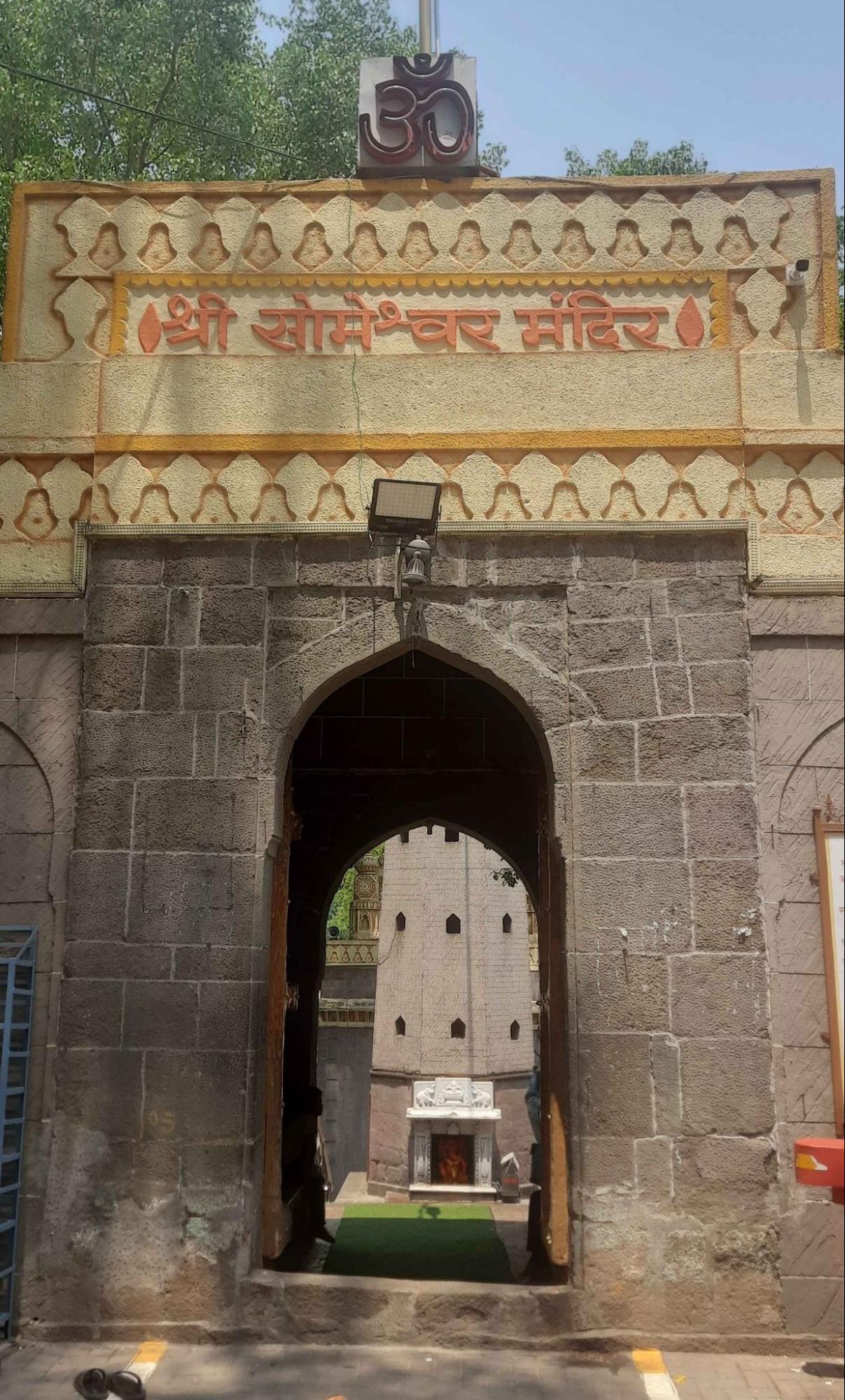
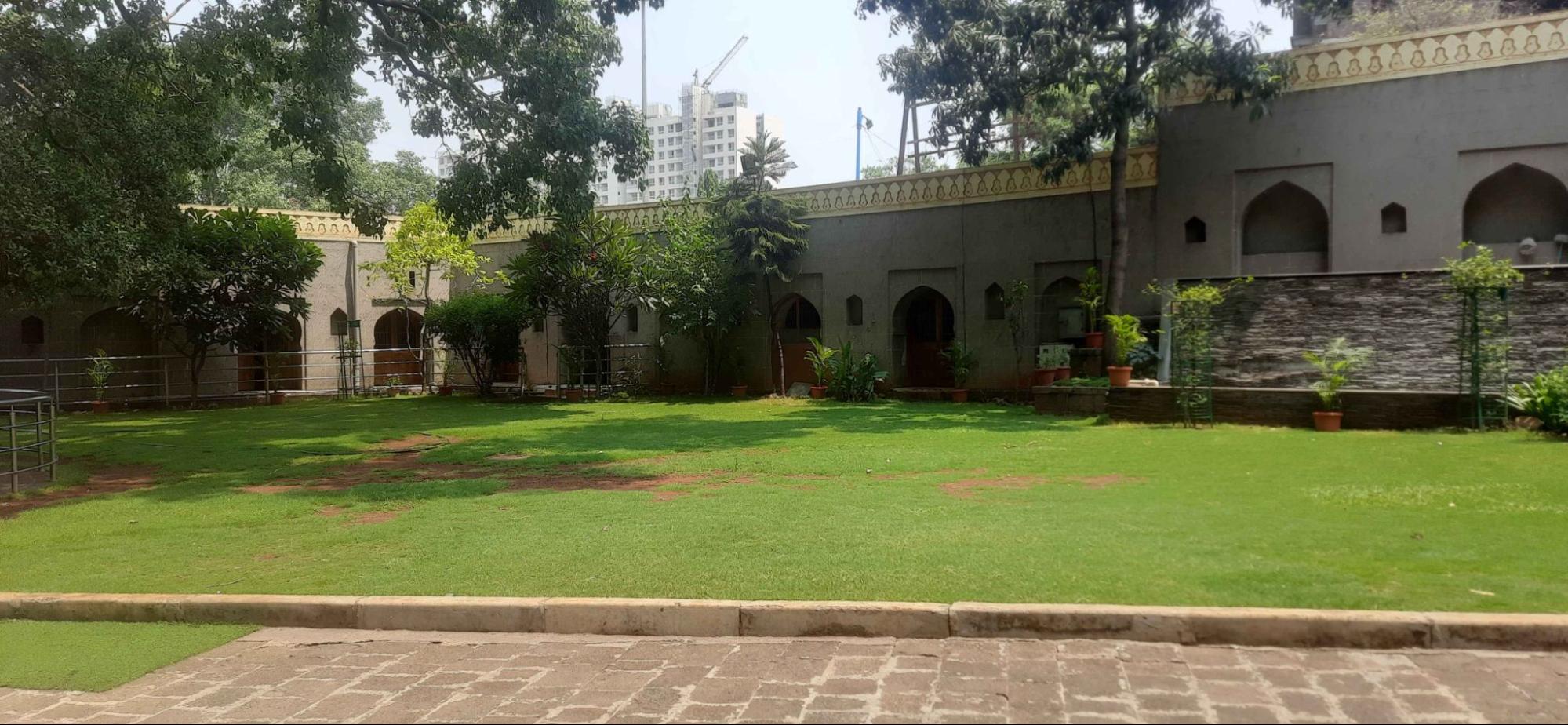
The Mandir’s origins are closely tied to a local legend. According to local legends, a cowherd once had a cow that never gave milk. One day, he realised the cow was sprinkling its milk over an ant hill and was trying to feed a snake. On digging up the ant hill, he found five ‘Shivlings’ and understood that the land was holy. He built a devasthan at the spot, named it ‘Someshwar’, and became the caretaker. This simple devasthan eventually developed into the Mandir complex seen today.
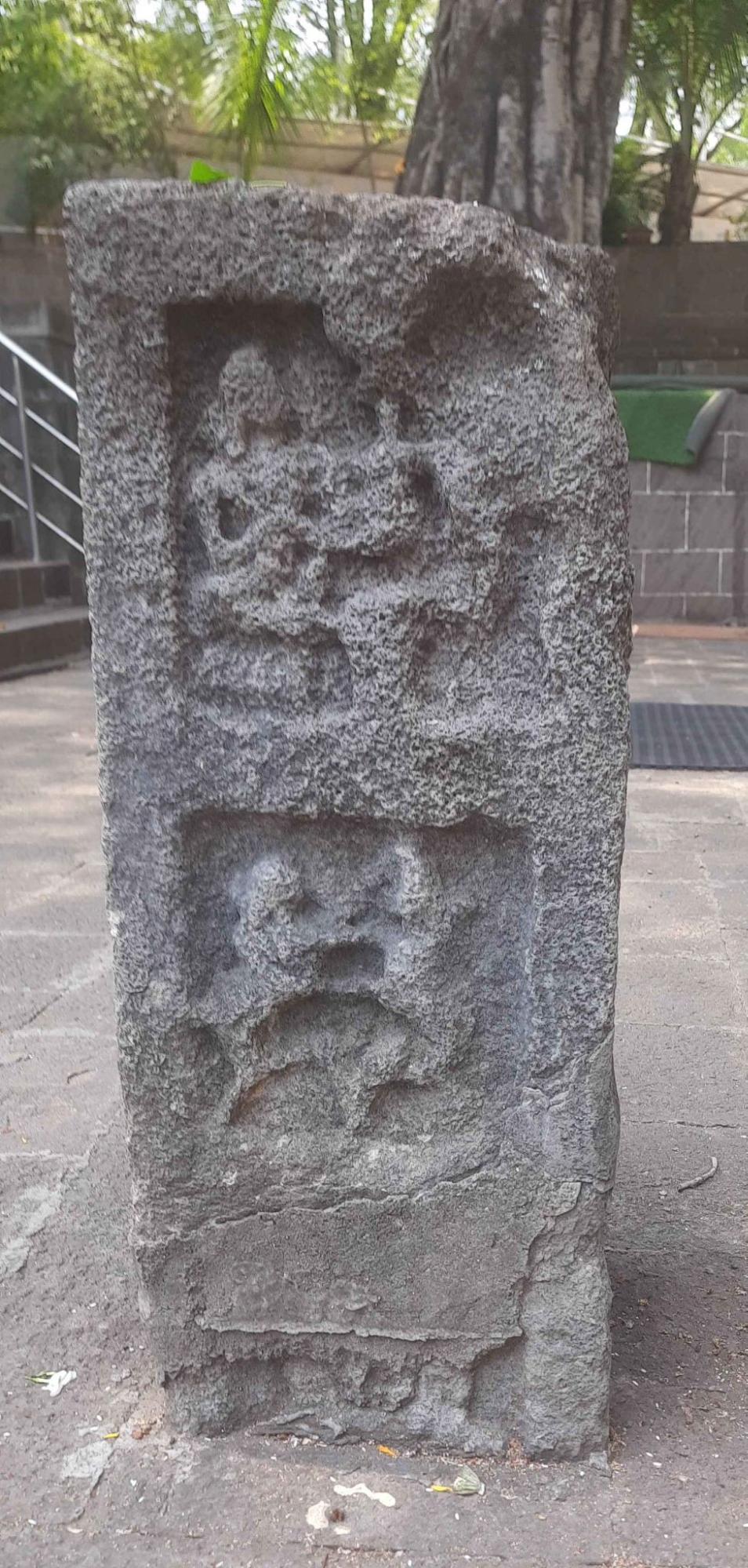
During the Maratha period, the Mandir grew in religious importance. Local accounts suggest that Rajmata Jijabai and Shivaji Maharaj visited and prayed at the site. The samadhi of Hanumante, a minister in Shivaji Maharaj’s court, is located within the complex.
Extensive renovations were undertaken in the 18th century. Yasubai, mother of Shahu Maharaj, is said to have appointed Shivrambhat Chitrav to oversee the reconstruction. One popular account mentions that Chitrav discovered a bag of gold coins during the renovation work, which he donated to the Mandir. His samadhi is also located on the premises.
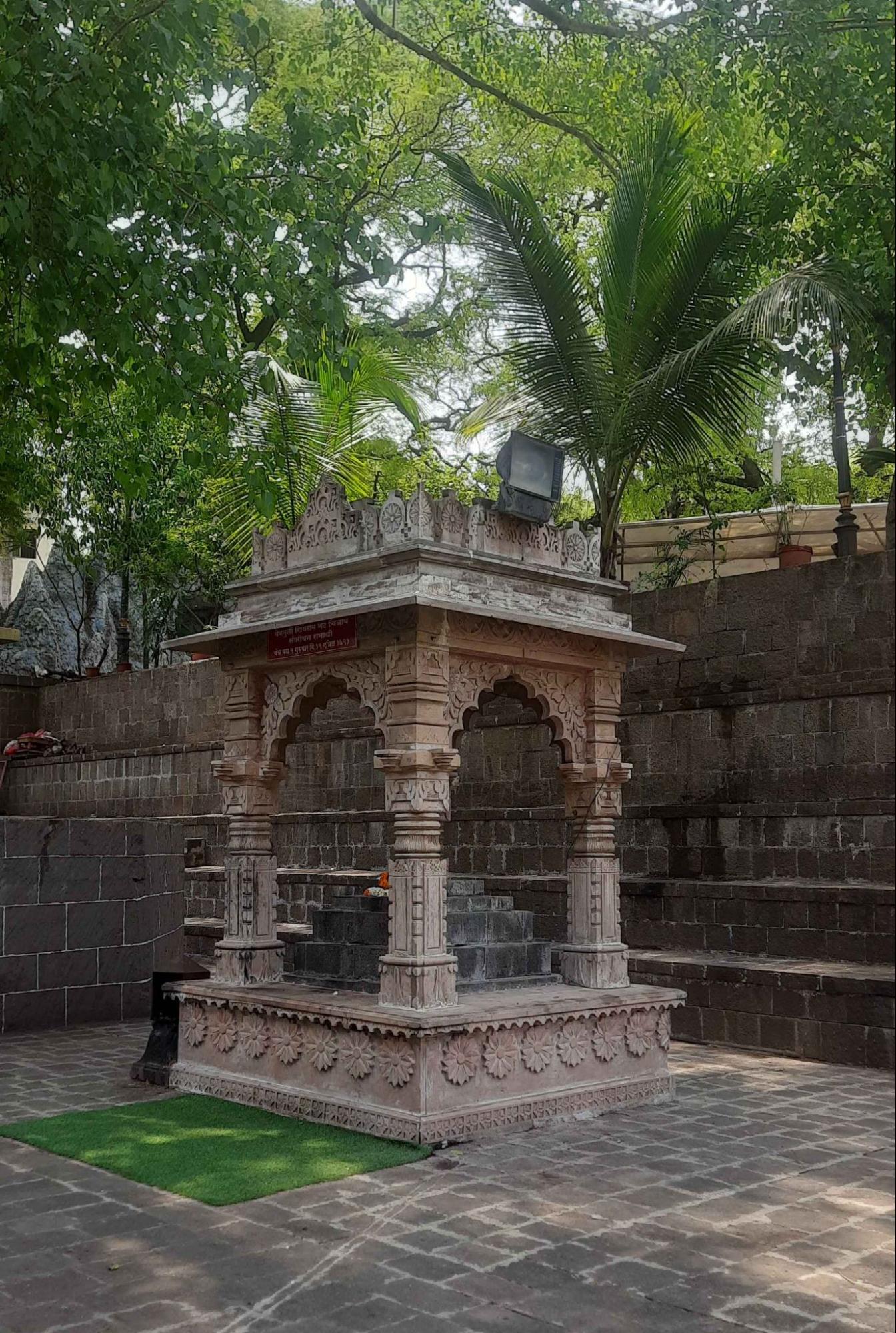
Local narratives also connect the Mandir to the Mughal period. According to these accounts, the structure narrowly escaped destruction through divine intervention. Shahiste Khan, a Mughal general, is believed to have built the sabhamandap as an act of atonement.
Interestingly, the mandap’s ceiling includes detailed stone carvings, and paintings within the Mandir depict scenes of battle between the Marathas and Mughals. These murals are present on all four sides of the inner structure, standing out as being something very unusual.


The Mandir also includes a naubatkhana (music room), a homkund for havans and pujas, and a 40-foot-tall deepmala. The Mandir complex houses a palkhi with intricately carved woodwork, and inside the palki is a panchdhatu (five metal alloy) murti of Bhagwan Shiv. During Shivratri and Dussehra, palkhi processions are organised on a large scale.
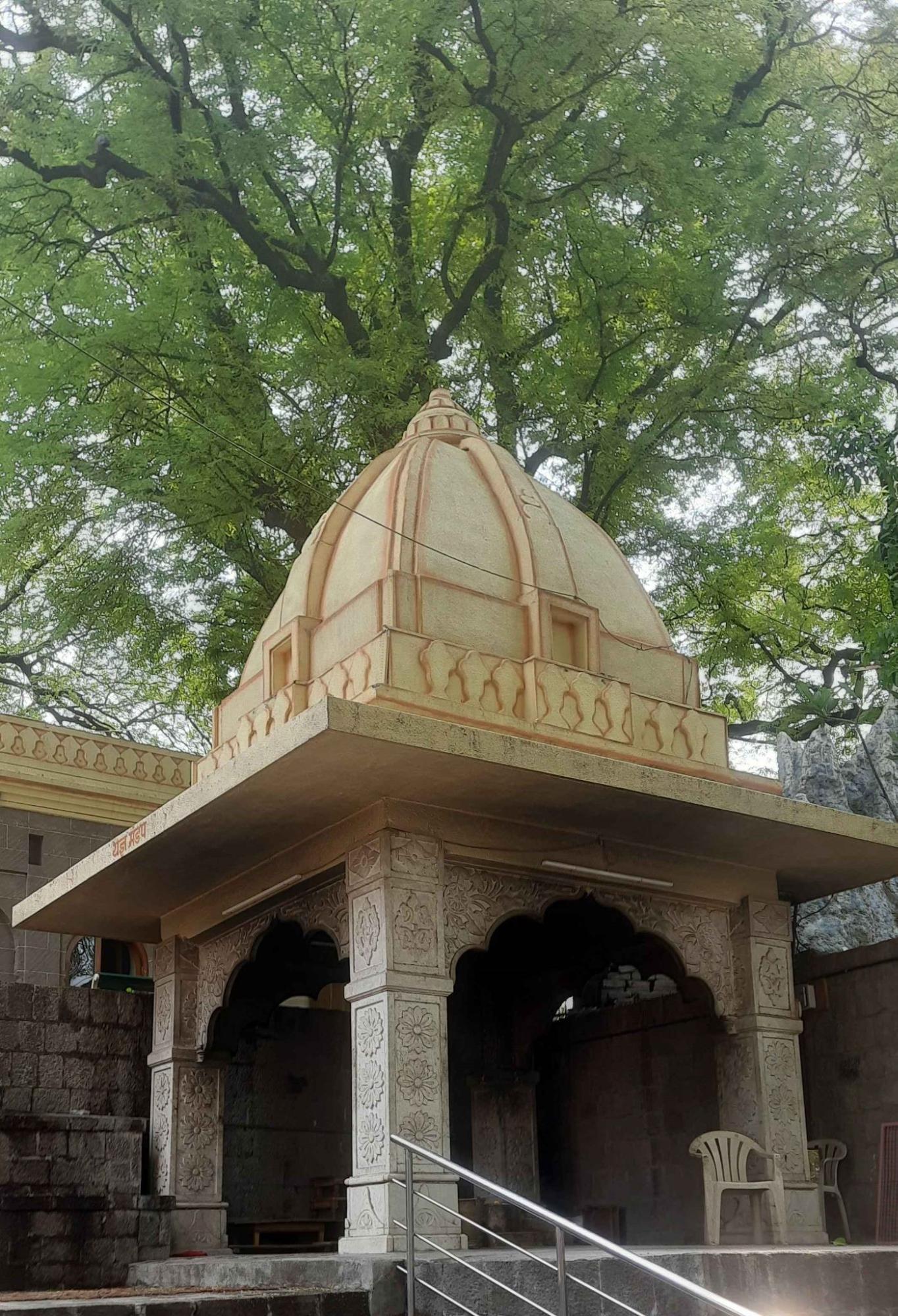
On the riverbed lies a ‘chakra tirth’, a square bathing place fed by a natural spring. It is not used for bathing anymore due to pollution in the Ramnadi, but many people still come here to spread ashes or offer prasad to ancestors as part of pind daan during Pitru Paksha (16-lunar day period in the Hindu calendar when Hindus pay homage to their ancestors which usually takes place in August or September).
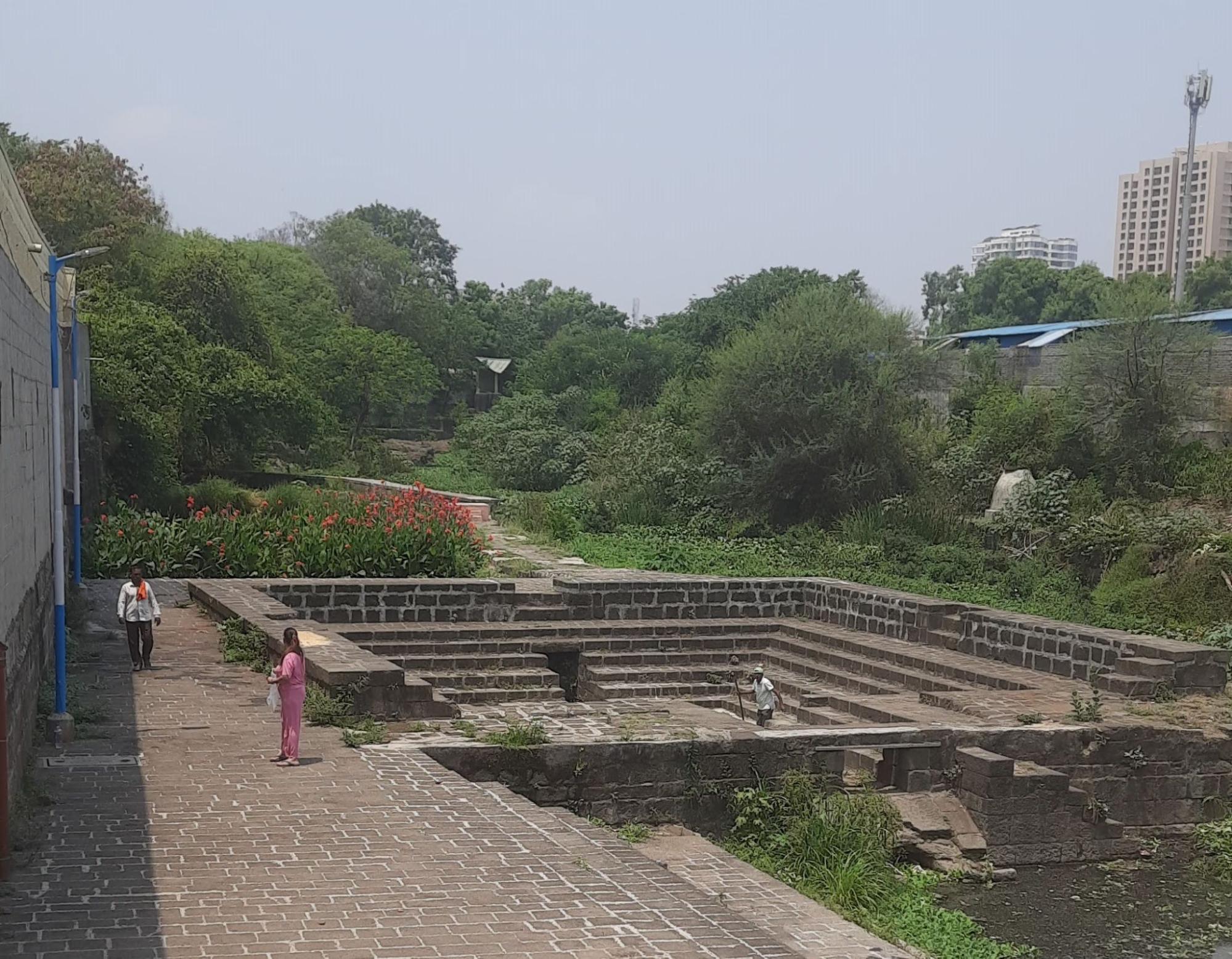
St Patrick's Cathedral
![Front view of the St Patrick’s Cathedral, Ghorpadi, Pune.[90]](/media/culture/images/maharashtra/pune/cultural-sites/front-view-of-the-st-patricks-cathedral-g_qD8G957.png)
St. Patrick’s Cathedral is one of the oldest churches in Pune, located in Ghorpadi near Empress Garden. The church was founded in 1849, but it became a cathedral only in 1886, after Pune was established as a Diocese. It was originally built for Irish soldiers and other Catholics in the area. As its first congregation mainly consisted of Irish soldiers, the church was named after the patron saint of Ireland, St. Patrick.
The exterior is white with a bell tower and a verandah. The roof contains pinnacled buttresses. It is constructed in a Neo-Gothic style and has a unique carved roof, built after the original one collapsed in 1984.
St Xavier’s Church
![A front view of the St Xavier’s Church in Camp, Pune featuring Gothic architectural style.[91]](/media/culture/images/maharashtra/pune/cultural-sites/a-front-view-of-the-st-xaviers-church-in-_17VEXqt.png)
St Xavier’s Church is Pune’s first Catholic church, built in 1864 in the Camp (Cantonment) area. The idea for the church was first proposed by Father Leitao in 1846 as a dedicated space to conduct mass. In the absence of a church building, he initially conducted services in his bungalow. In 1850, Father Steins and Mr. Loughnan applied for a plot of land to build a Roman Catholic chapel and school. Brother Schmidt served as the main architect of the church, and in 1860, Magistrate Bonnand (then Vicar-Apostolic of Pondicherry) blessed the foundation stone. The church is currently managed by Jesuit priests.
The church follows the Gothic architectural style with cobblestone exterior, stained glass windows and high ceilings and arched entrances. The prayer hall is filled with paintings of Jesus Christ, and if viewed from above, the hall looks like a cross, with the altar at its head. The murals are painted by the renowned artist Angelo Da Fonseca.
St. Crispin's Home
St. Crispin’s Church is a Roman Catholic church located in Erandwane, Pune. It was established in 1901 by the Society of Saint John the Evangelist, an Anglican religious order active in Pune during the British period. The church was named after St. Crispin, who was born in 1668 in Viterbo, Italy. He worked as a cobbler and shoemaker before joining the Capuchin Brotherhood, a Catholic monastic order. In 1806, Pope Pius VII beatified him for his religious service.
![St. Crispin’s Church, Erandwane, Pune featuring early Gothic architecture.[92]](/media/culture/images/maharashtra/pune/cultural-sites/st-crispins-church-erandwane-pune-featuri_jRlThIg.png)
The church was designed by British architect John Ninian Comper, who was known for restoring and adapting religious buildings. Built in the early Gothic architectural style, it was completed and opened for worship on October 24, 1907, the eve of St. Crispin’s Day.
The hymns, psalms, and melodies sung at the church are taken from the Marathi prayer book Upasana Sangeet, which contains lyrics by renowned Marathi poet and Christian convert Narayan Waman Tilakand. Easter, Christmas, and All Saints' Day are festive occasions observed by the church. PMC has declared it as a Grade I historic site.
St. Mary’s Church
St. Mary’s Church is located in the Pune Cantonment area and is among the earliest established churches in western India. It was constructed in the early 19th century to serve the British garrison stationed in the city and was consecrated in 1825. The church was designed by Lieutenant Nash of the East India Company’s Engineers, and the foundation stone was laid by Bishop Reginald Heber, then Bishop of Calcutta.
![Exterior of St. Mary’s Church in Pune Cantonment area, established in 1825 for the British garrison in the region.[93]](/media/culture/images/maharashtra/pune/cultural-sites/exterior-of-st-marys-church-in-pune-canto_rfmn5kZ.png)
The church was built to accommodate Anglican worship during the period of British colonial administration. Over time, it became known as the “Mother Church of the Deccan” due to its prominence in the region and its historical role in serving military and administrative personnel.
Inside, the church contains memorial tablets dedicated to British soldiers, officers, and administrators who served in colonial India. These include Sir Robert Grant, former Governor of Bombay, and Sir Edward West, Chief Justice of the Supreme Court at Bombay. The church’s interior features 19th-century stained glass, wooden pews, a pipe organ, and regimental flags that reflect its colonial heritage.
St. Mary’s Church remains active and continues to hold regular Anglican services. It is part of the Church of North India and serves a local congregation while also attracting visitors interested in the historical and architectural legacy of the colonial period in Pune.
St. Matthew’s Tamil Church
St. Matthew’s Tamil Church, located on Dr. Babasaheb Ambedkar Road in Pune, is one of the city’s oldest Anglican churches, established primarily to serve the Tamil-speaking Christian community. Its construction began in 1893 under the auspices of the Church Missionary Society (CMS), and the foundation stone was laid by Appaji Bapuji Yardi, Yardi, a priest at the time. The church was originally known as the CMS Church and was accompanied by a divinity school intended for the training of local preachers.
![A side view of the St. Matthews Tamil Church, Dr. Babasaheb Ambedkar Road.[94]](/media/culture/images/maharashtra/pune/cultural-sites/a-side-view-of-the-st-matthews-tamil-chur_8hLMPb8.jpg)
Architecturally, the church exhibits a distinct Visigothic style, influenced by early Spanish ecclesiastical design. Notable elements include horseshoe (rounded) arches used in doorways and windows, a rectangular exterior apse, and ashlar masonry constructed from dressed rectangular stone blocks. These features reflect a simplified and elegant approach characteristic of Visigothic architecture. Interestingly, the structure also bears signs of Irish influence, such as the Celtic cross at the entrance.
Notably, the church houses several historical artefacts. It houses a Pancha Dhatu bell, which weighs approximately 40 kg. and is composed of a five-metal alloy, which is interestingly, believed to have been a gift by Queen Victoria. Though cracked today, it is preserved as part of the church’s heritage. The church also retains a Mason and Hamlin organ, dating from 1858, which predates the building itself and was likely imported from London. Services at the church are conducted in Tamil and Marathi, and St. Matthew’s Day is celebrated annually on 21 September.
St. Paul’s Church
St. Paul’s Church, located on Agarkar Road in Pune, is a historic Anglican church built during the British colonial period. Its foundation stone was laid on 29 August 1863 by Sir Henry Bartle Frere, the then Governor of Bombay. The establishment of the church addressed a longstanding need, first voiced in 1840 by Bishop Thomas Carr, for a second Anglican place of worship in Pune to accommodate the city’s growing civilian Christian population.
The church was consecrated on 5 March 1867 and became the second Anglican church in the Bombay Presidency after St. Mary’s Church in Pune. It is dedicated to St. Paul, the patron saint of missionaries, evangelists, and writers, who is commemorated annually on 29 June.
![The building of the St. Paul’s Church, Agarkar Road.[95]](/media/culture/images/maharashtra/pune/cultural-sites/the-building-of-the-st-pauls-church-agark_Ng3maAu.jpg)
Architecturally, St. Paul’s Church reflects early English Gothic influences and is noted to draw much inspiration from the famous Sainte-Chapelle in Paris. Its interior is distinguished by a 50-foot-high nave, offering an unobstructed view of the altar from all corners. The marble reredos behind the altar, depicting the Ascension of Christ, was donated by a Bishop of Bombay in memory of his wife, Lucy.
![The spacious interior of St. Paul’s Church.[96]](/media/culture/images/maharashtra/pune/cultural-sites/the-spacious-interior-of-st-pauls-church9_QaPd8q8.jpg)
Today, St. Paul’s Church is part of the Church of North India and the Pune Diocesan Council. It remains an active place of worship and publishes a monthly magazine called Hosanna with church news and announcements. The church celebrated its 150th anniversary in 2017 and is listed as a Grade I heritage site by the Pune Municipal Corporation.
Succath Shelomo Synagogue
Succath Shelomo Synagogue, located in Rasta Peth, Pune, is one of the city's oldest Jewish places of worship. Built in 1921, it was originally intended to serve as an auxiliary prayer hall for the Ohel David Synagogue to accommodate the growing Jewish community. The name ‘Succath’ derives from Hebrew, meaning ‘temporary shelter’, reflecting the hall’s initial function.
![Succath Shelomo Synagogue at Rasta Peth, Pune.[97]](/media/culture/images/maharashtra/pune/cultural-sites/succath-shelomo-synagogue-at-rasta-peth-p_dw9ya6M.jpg)
Its construction was overseen by a building fund committee comprising notable members of the community, including Shalom Bapuji Wargharkar (who served as Prime Minister of the Sidi state of Janjira) and Khan Saheb Reuben Samson Bhonkar (who served in the army). The project, completed within four years, was funded through small contributions from the local Jewish community.
A dedicatory plaque, known as the ‘shadai’a’, is placed at the entrance, which devotees touch before entering the prayer hall as part of a tradition. Succath Shelomo continues to serve as an active synagogue and is listed as a Grade II heritage structure by the Pune Municipal Corporation.
Thorla Sheikh Salla Dargah
Thorla Sheikh Salla Dargah, located in Kasba Peth, Pune, is one of the city's oldest Islamic shrines, dating to the 14th century. It remains an active place of worship with daily prayers conducted in Urdu and Hindi and is recognised as a Grade I heritage site by the Pune Municipal Corporation.
The etymology of the site’s name is particularly interesting. Notably, the dargah, in local tradition, is often referred to as senior Sheikh Salla and the word ‘Thorla’ which means ‘elder’ in Marathi indicates that. A second, smaller shrine nearby in Kumbharwada is known as Dhakta Sheikh Salla, or the junior shrine. Both sites continue to be important markers of Pune’s early Islamic history.
![A view of the Thorla Sheikh Salla Dargah from Shivaji Bridge, Kasba Peth, Pune.[98]](/media/culture/images/maharashtra/pune/cultural-sites/a-view-of-the-thorla-sheikh-salla-dargah-_2iCssrM.jpg)
Two historical accounts trace the origins of these dargahs. One account is recorded in the Marathi manuscript Pune Peth Kaifiyat, preserved at the Government Oriental Manuscripts Library in Chennai. It details the journey of two sheikhs, Sheikh Salahuddin Auliyah and Sheikh Ismauddin Auliyah, who travelled from Basra, Iraq to India with 12 followers. They settled in Pune during the Yadava period (9th-13th centuries) and camped near the historic Puneshwar and Narayaneshwar Mandirs which stood along the Mutha riverbank. The locals, believing in their divine healing abilities, allowed them to stay and practice their faith. These sheikhs were later buried there, leading to the establishment of the dargahs.
Another version attributes the dargahs to Sheikh Salahuddin Gazi Chishti and Sayyed Hisamuddin Kattal Zanjani. The legend suggests that after the capture of Fort Kondhana (now called Sinhagad) Muhammad bin Tughlaq appointed Commander Bariyah Arab to oversee the area. During this period, it is said that the Sufi saint Sheikh Salahuddin Gazi Chishti was active in Pune, preaching Islam among the local population. He passed away in 1358, and a shrine (the Thorla Sheikh Salla Dargah) was built to honour him.
Several decades later, another Sufi preacher, Sayyed Hisamuddin Kattal Zanjani, arrived in Pune with a similar mission. Following his death in 1390, a second shrine, the Dhakta Sheikh Salla Dargah, was established nearby. Together, these two dargahs mark the early Sufi presence in Pune and remain important cultural and religious landmarks.
Torna Fort
Torna Fort, also known as Prachandagad, is a historic hill fort located in Velhe taluka of Pune district. It is notable as the first fort captured by Chhatrapati Shivaji Maharaj in 1646, when he was just sixteen years old. The name Prachandagad, meaning ‘massive fort’ in Marathi, reflects its scale and natural strength.
![Torna Fort atRajgadtaluka, Pune offers a view of in-built lakes and guard walls within its ruins.[99]](/media/culture/images/maharashtra/pune/cultural-sites/torna-fort-atrajgadtaluka-pune-offers-a-v_5FRquDT.jpg)
The fort’s earliest structures are believed to date back to the 13th century, possibly during the rule of the Yadavas of Devagiri. It later came under the control of the Bahmani Sultanate and subsequently the Adilshahi dynasty of Bijapur. After the Treaty of Purandar in 1665, Torna was briefly ceded to the Mughal Empire but was recaptured by Shivaji Maharaj in 1670 during a phase of renewed Maratha expansion.
Torna is known for its extensive fortifications, ancient gateways such as Bini Darwaza and Kothi Darwaza, and defensive outposts like Zunjar Machi and Budhla Machi. Within its walls are mandi’s, water reservoirs, and ruins of old administrative structures, which hint at the fort's strategic and residential use.
![One of the secret passageways within Torna Fort.[100]](/media/culture/images/maharashtra/pune/cultural-sites/one-of-the-secret-passageways-within-torn_D0eoyns.jpg)
Today, Torna Fort remains a challenging but popular trekking destination. From its summit, trekkers can view nearby forts such as Rajgad, Lingana, and, on clear days, Sinhagad. Torna continues to be valued not only for its historical significance but also for its commanding views over the Sahyadri mountain range.
![A view of Torna Fort from the nearby Rajgad Fort.[101]](/media/culture/images/maharashtra/pune/cultural-sites/a-view-of-torna-fort-from-the-nearby-rajg_OyOcjBm.jpg)
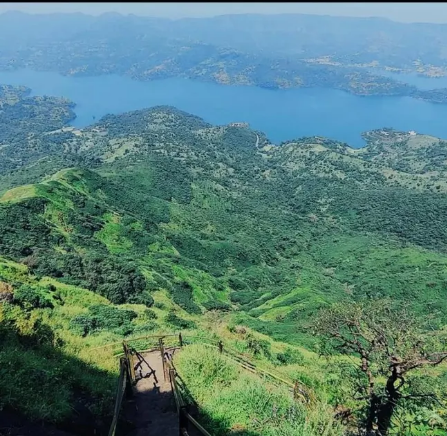
Trishund Mayureshwar Ganpati Mandir
The Trishund Ganpati Mandir is located near Kamala Nehru Hospital Chowk, Somwar Peth. One of the three inscriptions in the garbha griha of the Mandir indicates that its construction began on August 26, 1754. It was overlooked by Bhimjigiri Gosavi, an artisan from Dhampur. However, it took an additional 16 years, until 1770 for the Mandir’s construction to be finished.
![The entrance of the Trishund Mayureshwar Ganpati Mandir, Somwar Peth, Pune.[102]](/media/culture/images/maharashtra/pune/cultural-sites/the-entrance-of-the-trishund-mayureshwar-_D4x4PLQ.png)
The entrance to the Mandir contains carvings of a pair of dwarpals, one on each side. Above these dwarpals, there are carvings of Devi Laksmi and elephants. The Mandir is made of Deccan basalt. Numerous images of animals and mythological creatures are carved on the Mandir’s walls and pillars. The mandir's design combines elements of South Indian, Malwa, and Rajasthani architecture. In the garbhagriha, Bhagwan Ganesh is depicted with six arms and three trunks, sitting on a peacock - a depiction which is atypical. An inscription from the Bhagwad Gita is inscribed in the garbhagriha.
Tukai Mata Mandir
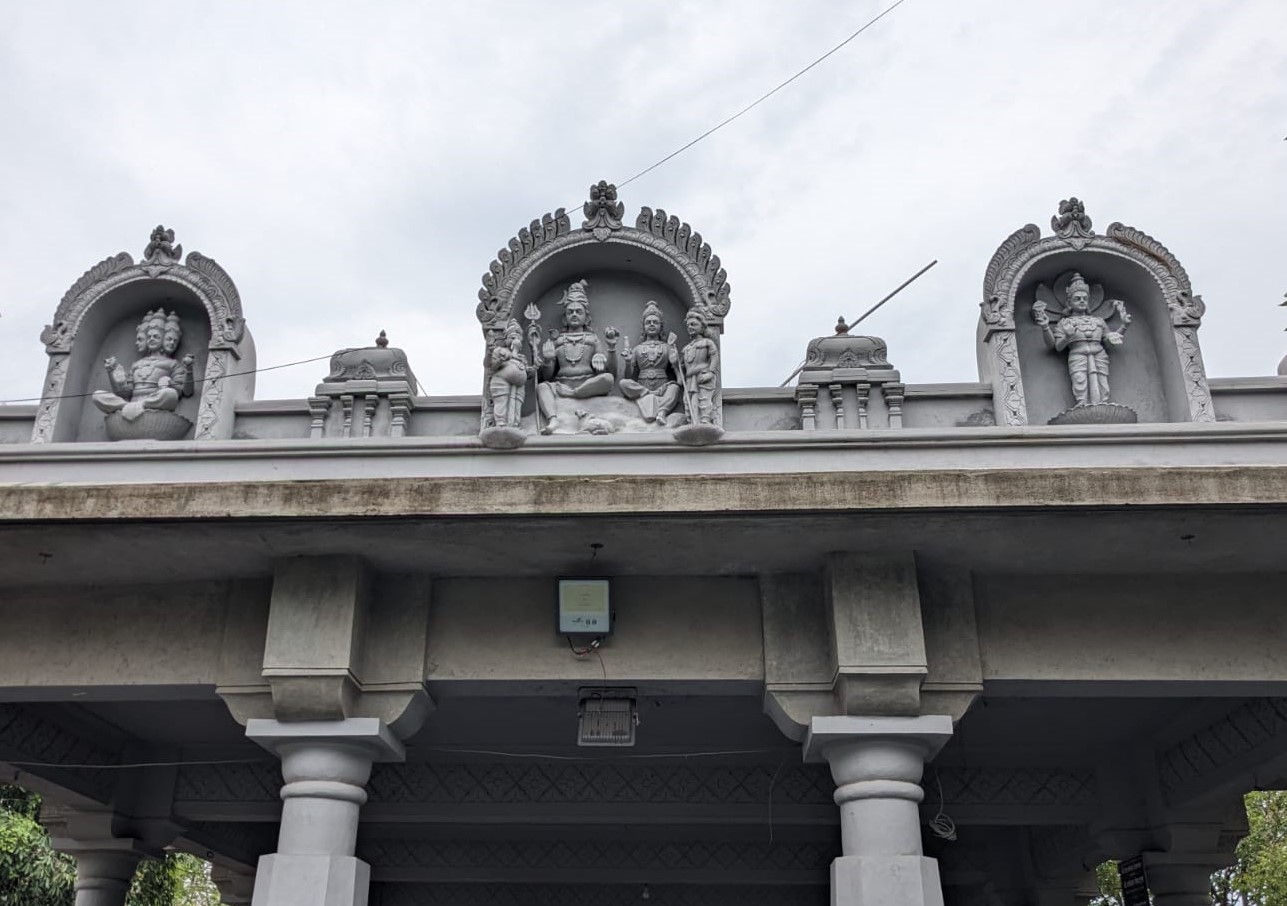
The Tukai Mata Mandir is situated atop the Baner Hill. It was built around 400 years ago by Kavaji Kalamkari, a member of the Kalamkar family from the Mali community, who became the local rulers of Baner. This 17th century construction provides breathtaking views of the city skyline and surrounding landscape. It can be accessed from Baner Gaon via a series of steps, the Pashan Hill trail, or the Baner-Pashan link road. As part of the Baner-Pashan biodiversity park, the Mandir attracts many visitors who come for walks, hikes, or runs. Morning and evening are peak times for visitors, especially during the Navratri festival, which draws large crowds.
The climb from Baner Gaon has sturdy steps and wooden benches for resting while enjoying the scenic surroundings. The Mandir complex features a spacious main hall, a breezy balcony, and an open 'angan' area for events such as bhajans, poojas, gatherings, and weddings. With balconies on all sides offering stunning views, it provides a peaceful escape from the bustling city below. What makes Tukai Mata Mandir unique is that it is the only Mandir complex in the district painted white. However, it faces challenges due to ongoing construction on Baner Hill, which has led to an increase in pollution.
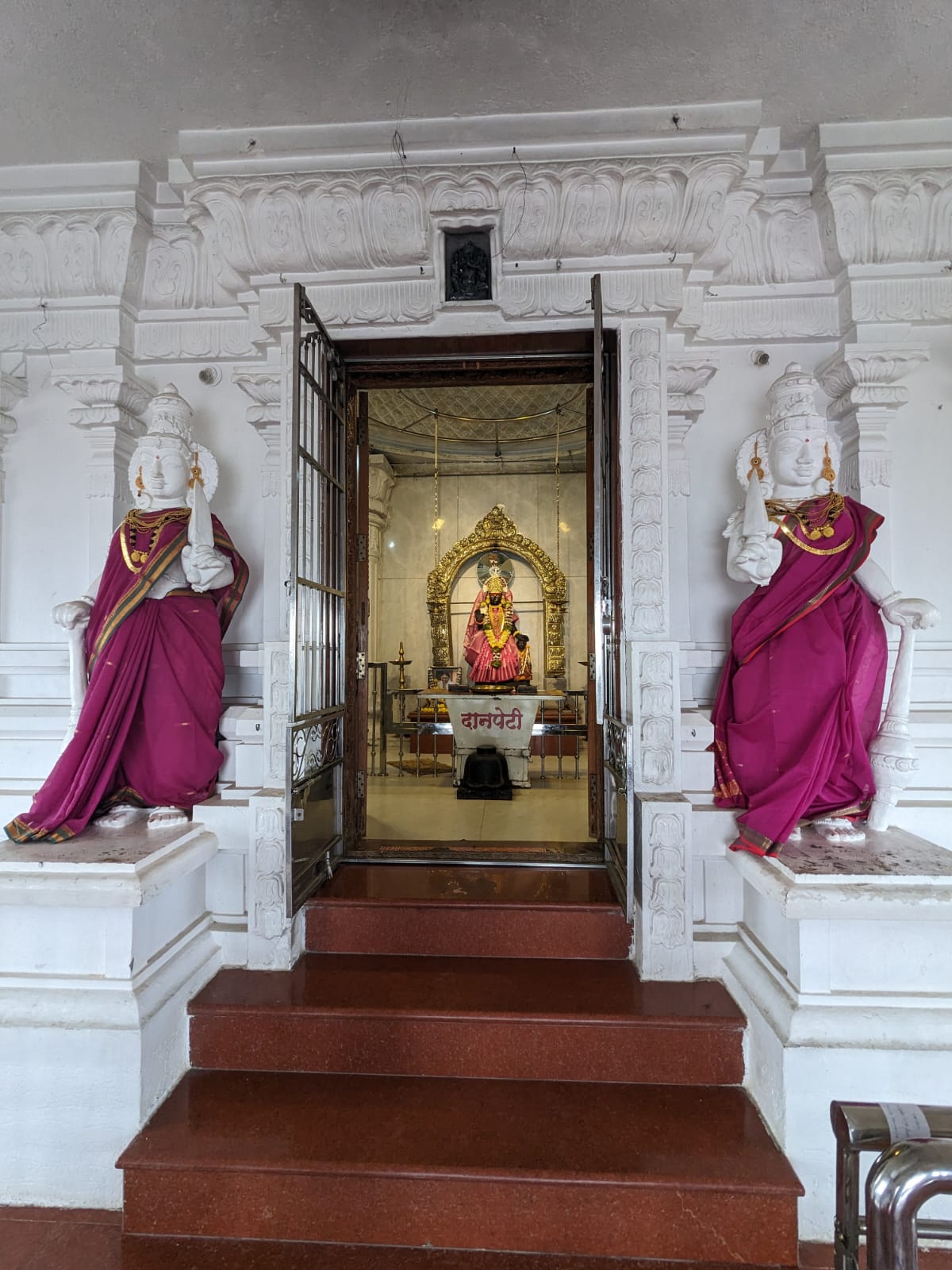

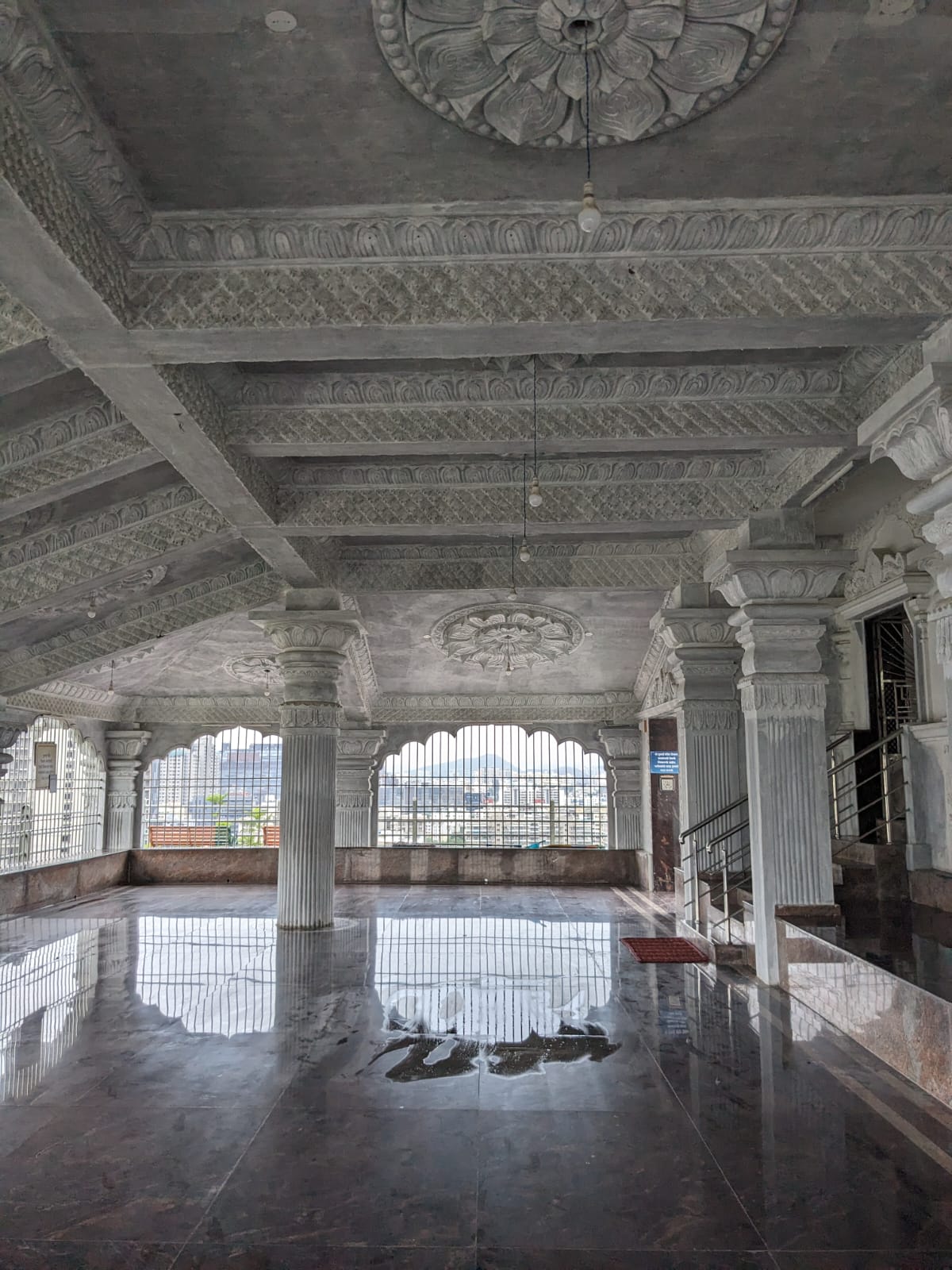
Twashta Kasar Kali Mandir
![Side view of the Twashta Kasar Kali Mandir, Kasba Peth, Pune.[103]](/media/culture/images/maharashtra/pune/cultural-sites/side-view-of-the-twashta-kasar-kali-mandi_YcikPJV.png)
The Twashta Kasar Kali Mandir was established in 1893 in Kasba Peth by Twastha Kasar, a group of Hindu coppersmiths residing in Maharashtra. They believed themselves to be Bhagwan Vishwakarma’s descendants.
The architecture of the Mandir follows traditional wada-style. It is made of brick and mud, and the entire building was renovated in 1906. It is solely dedicated to Devi Kali, an important Devi in Hinduism’s Shakti sect. The auspicious festivals celebrated at the Mandir are Navratri and Devi Prakat Din (a day when it is believed the Devi manifested). The Mandir honours the ritual of Homa during Ashtami (celebrated on the eighth day of the lunar month and associated with Devi Durga).
Vishrambaug Wada
Vishrambaug Wada is a historic residential mansion located on Shrimant Thorle Bajirao Peshwa Road in Pune. Constructed in 1807, it served as the residence of Peshwa Bajirao II and is regarded to be one of the most well-preserved examples of traditional Maratha Wada architecture.
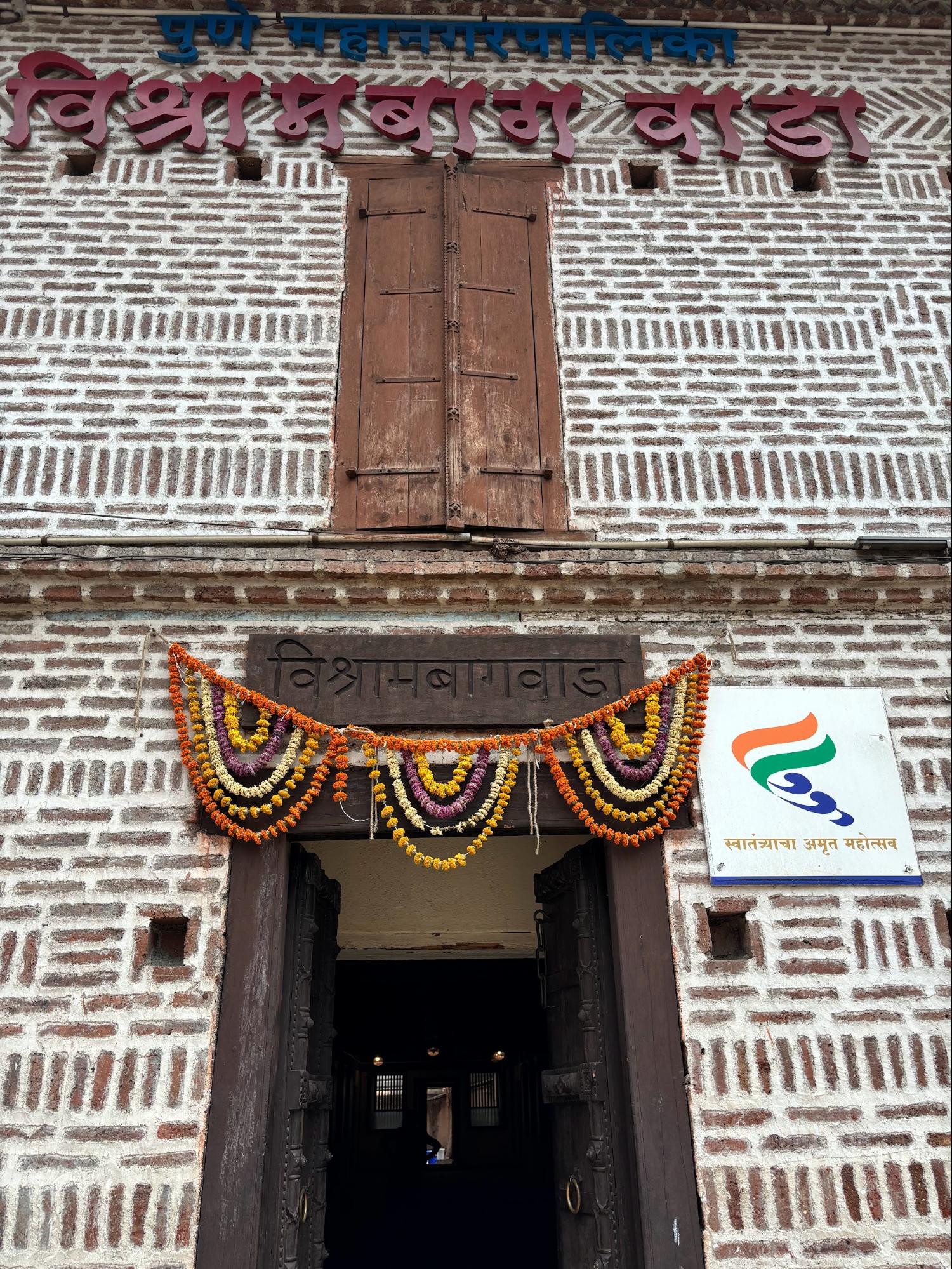
The plot was acquired by Bajirao II from Haripant “Bhau” Phadke, a Peshwa courtier after whom Phadke Haud and the local market are named. The Wada was designed to reflect the grandeur associated with the last ruling Peshwa, though his occupancy was short-lived.
After the British defeat of the Maratha Confederacy in the Third Anglo-Maratha War (1818), the property was seized and repurposed as an educational institution. Subjects such as the Vedas, law, science, medicine, and the arts were taught on-site during the early colonial period.
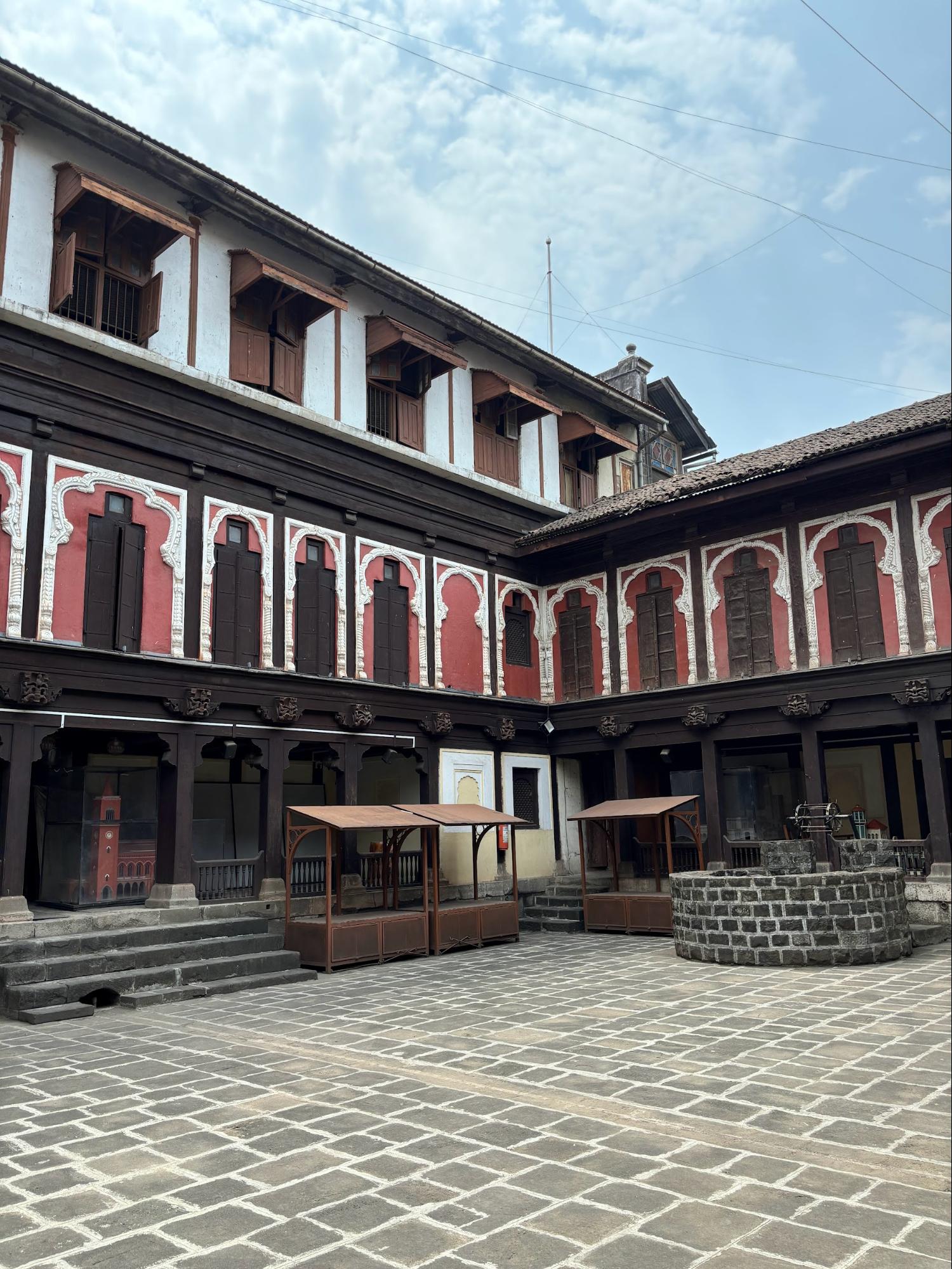
The institution thrived under the administrative reforms of Major Thomas Candy (1804–1877), a British educator and philologist known for standardizing Marathi orthography. Candy, along with his twin brother George, co-authored an English-Marathi dictionary and played a significant role in shaping regional education policy.
In 1842, the study of the Vedas was stopped and English classes were substituted. This was probably the effect of Lord Thomas Macaulay’s famous Minute of 1834 and the subsequent English Education Act of 1835 passed by the British Parliament. This mandated the promotion of English as a medium of instruction and encouraged higher education in the same.
Soon the study of Shastras was also stopped in 1856 and the Deccan College was started with an attached preparatory school within the premises.
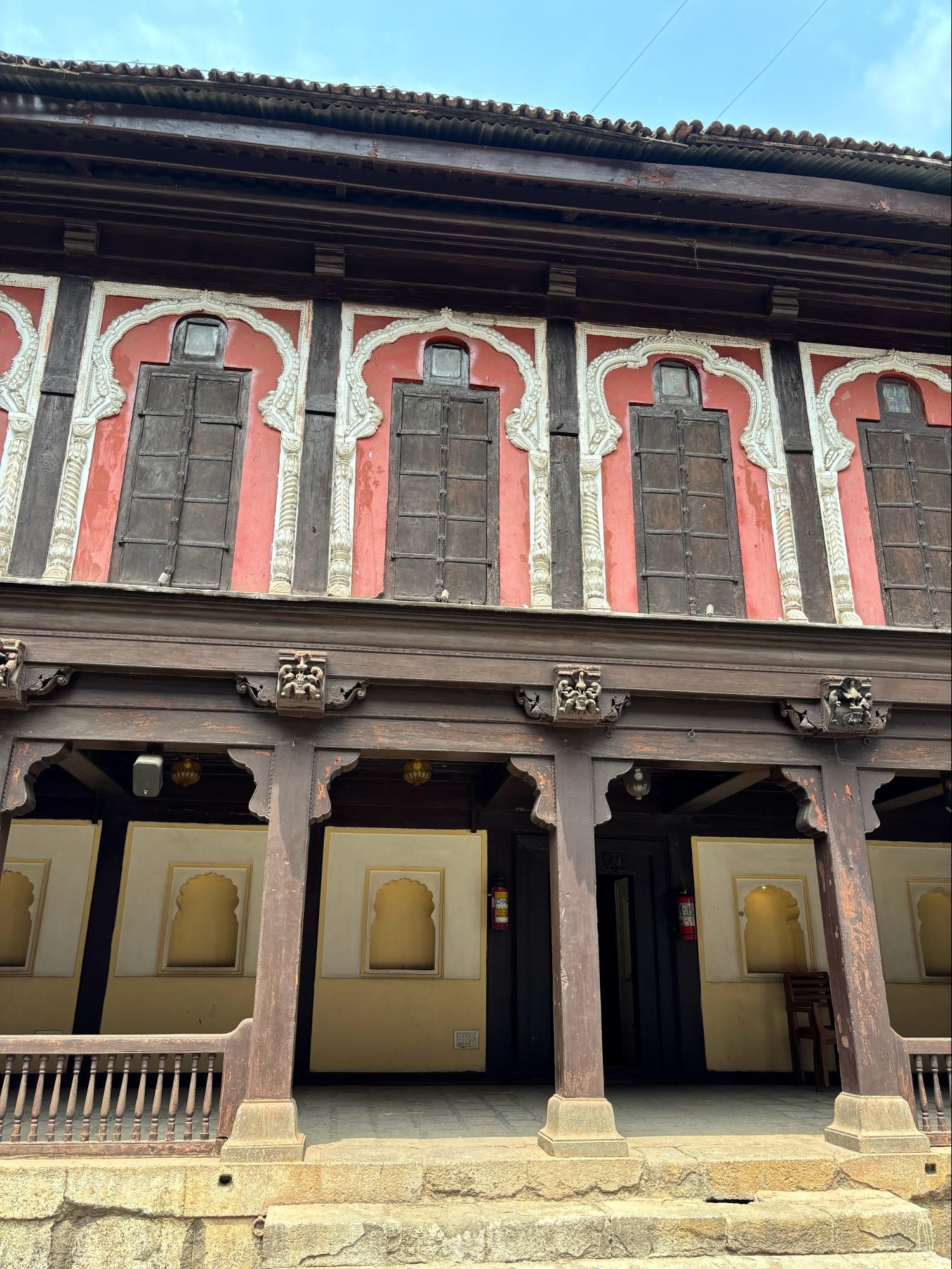
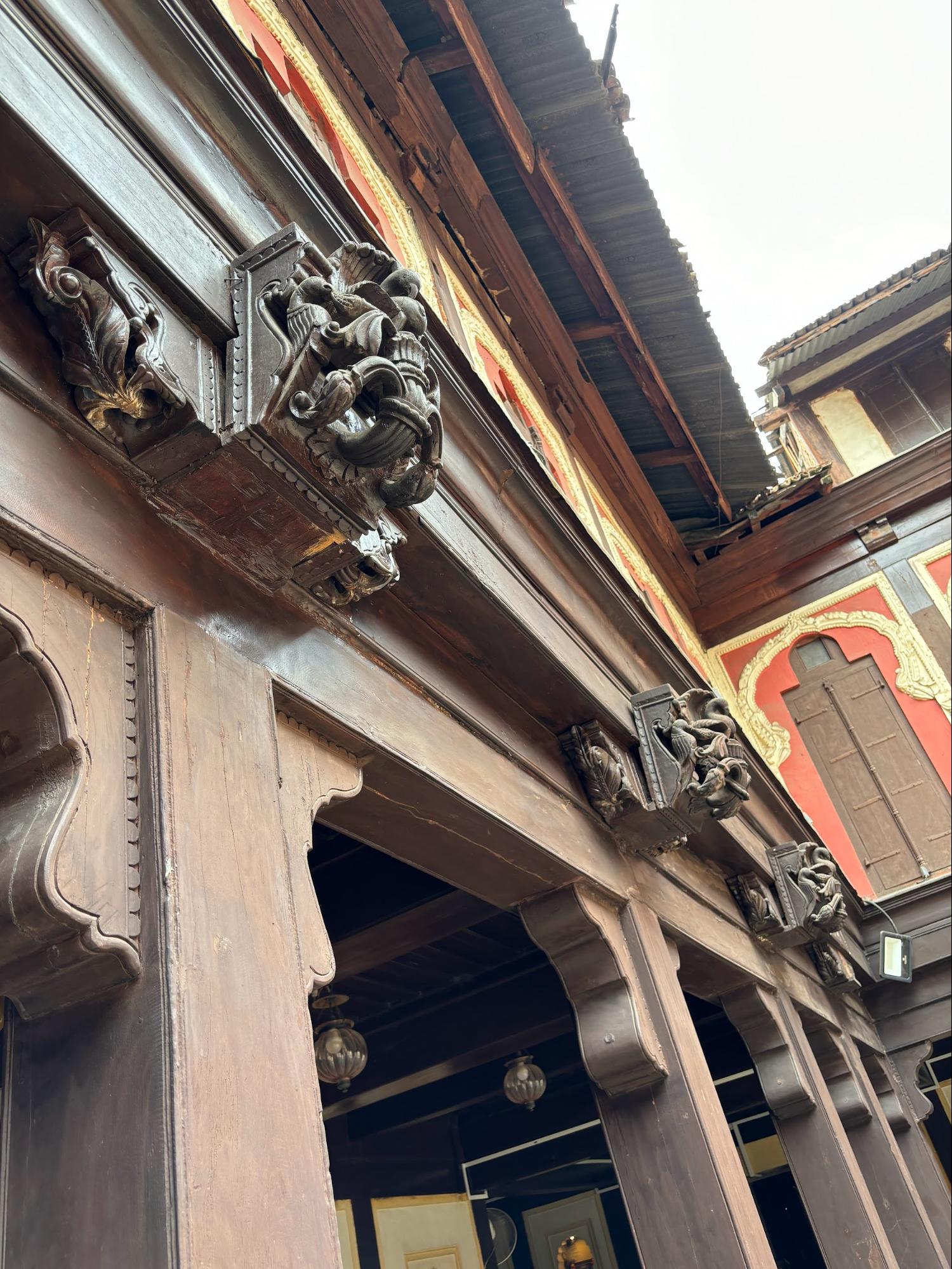
In 1879, a fire destroyed a substantial part of the Wada. Reconstruction efforts began in 1885, closely following the original architectural elements. Later, in 1933, the Pune Municipal Corporation (PMC) added a second storey and operated from the building until relocating in 1959.
The building was restored in 2003 under the guidance of PMC’s heritage cell, using architectural drawings made in 1984 by students of Bharatiya Kala Prasarini Sabha’s College of Architecture. Today, the structure partially functions as a Business Post Centre operated by the India Post Department.
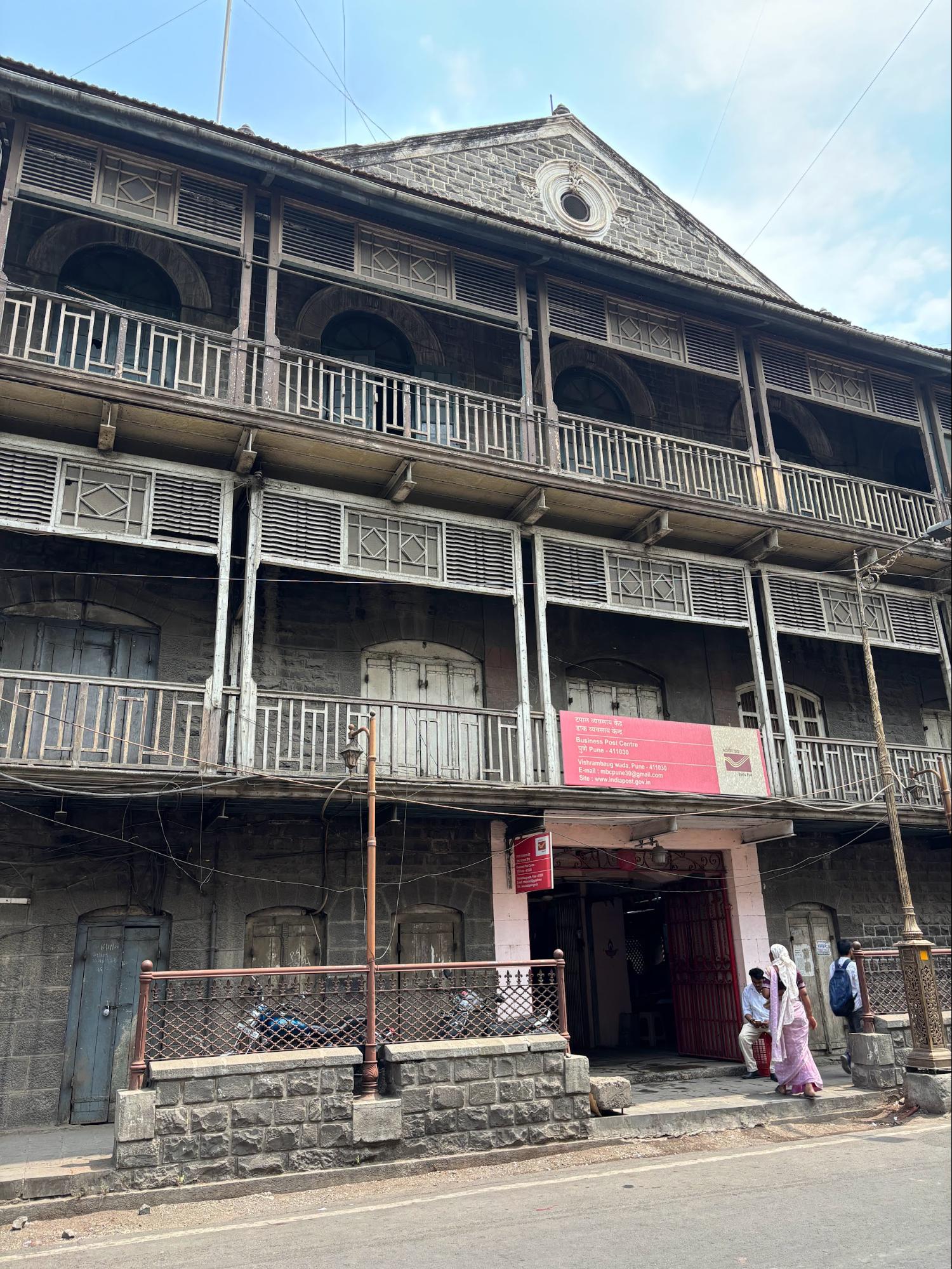
Wakeshwar Vitthal Devasthan
Wakeshwar Vitthal Devasthan is located in Pashan Gaon. It was established in 1762 by Laxman Chintaman Dadphale and is considered a locally significant place. For much of its history, it functioned as an open site where residents of the area could gather informally.

The Mandir follows a long-standing practice of not accepting offerings, no money, food, flowers, or other items are brought in. Entry is open, and no formal rituals are held. A family residing on the premises looks after the space and its day-to-day upkeep.

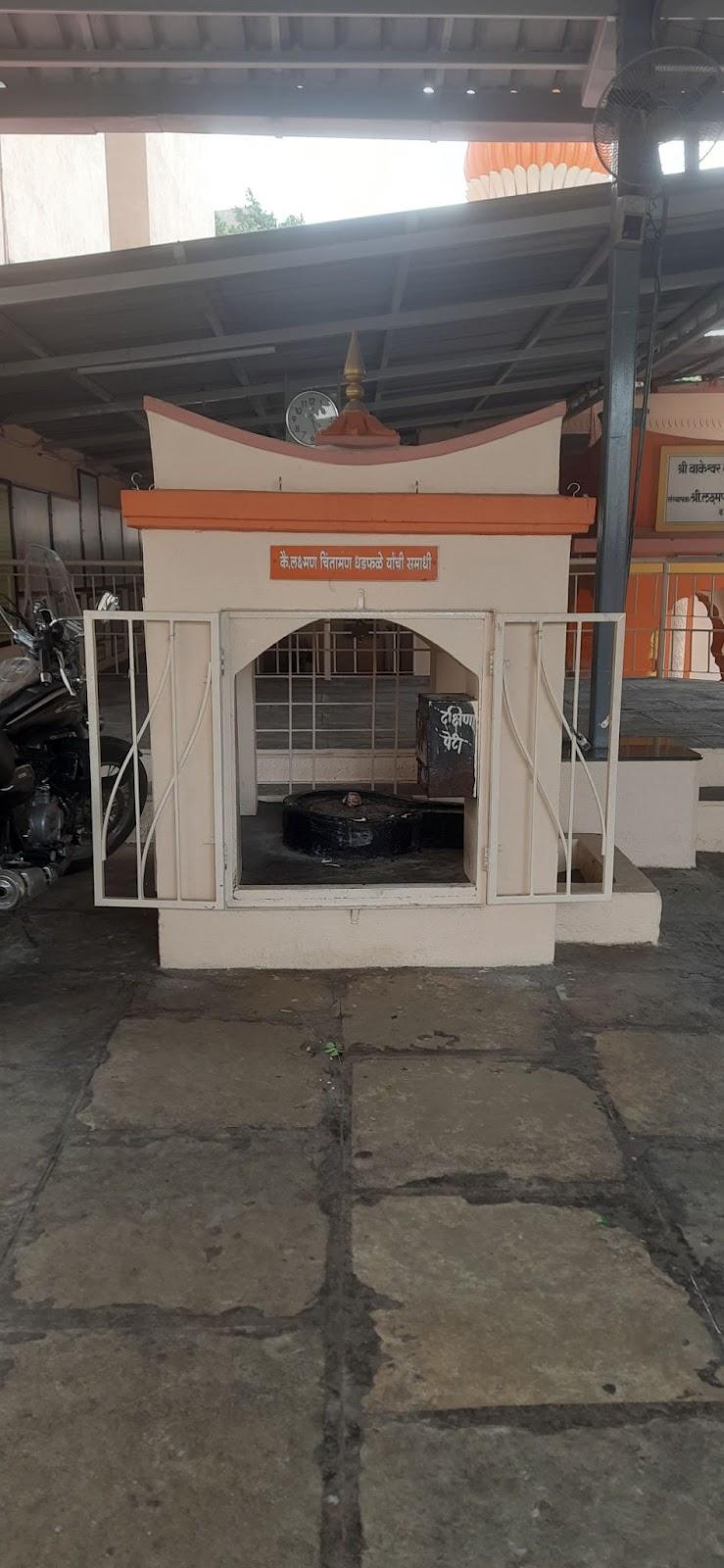
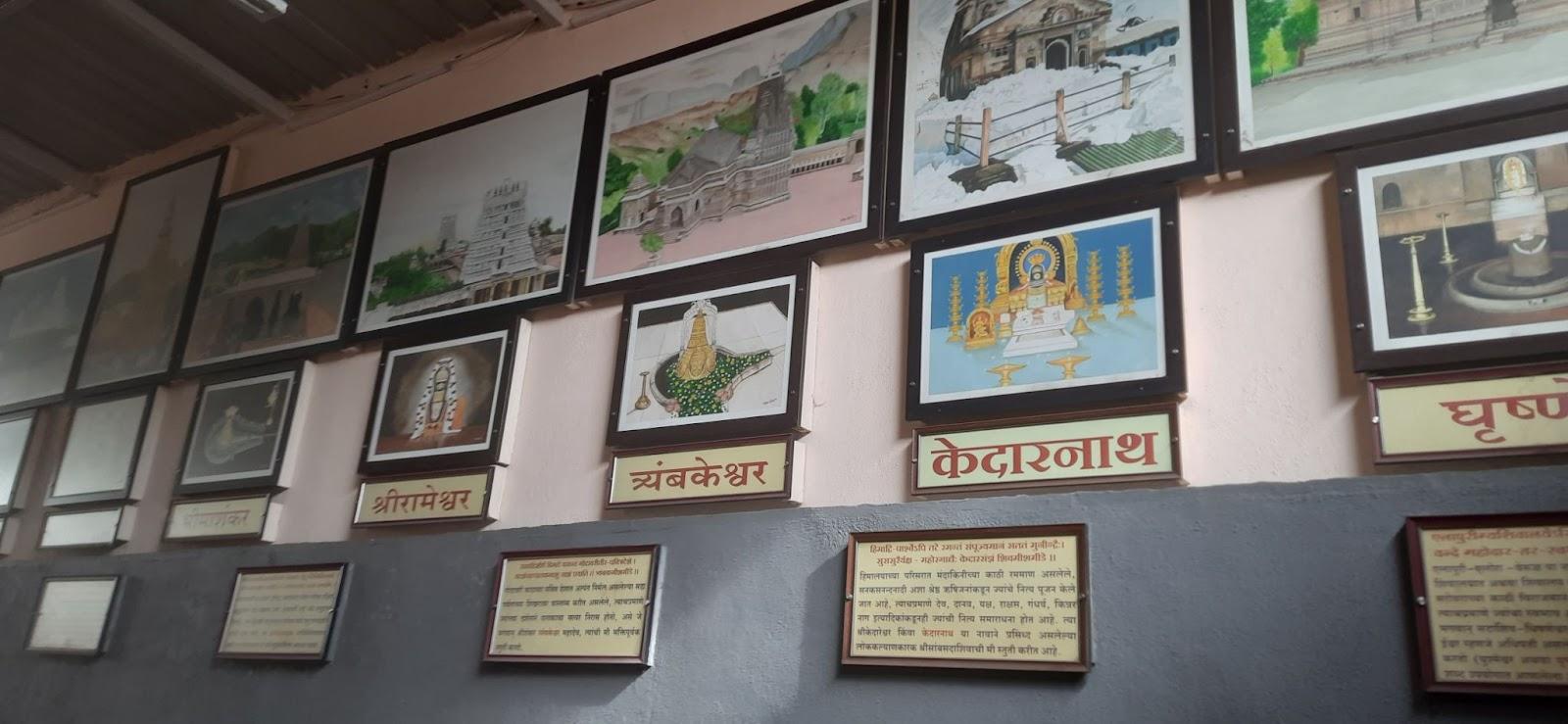
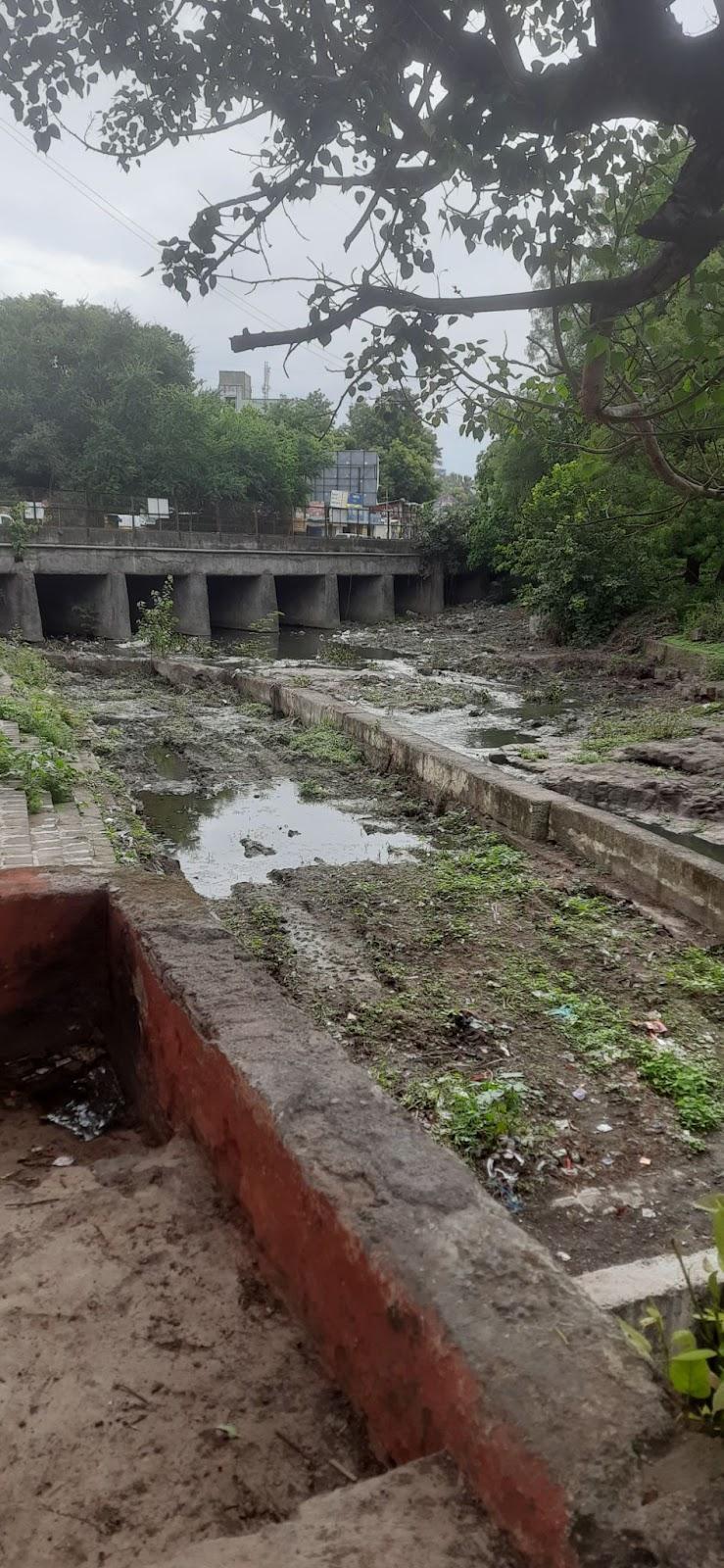
Sources
Aditi Dixit. 2024. ‘Naneghat – The Royal Mountain Pass’,Puratattva.https://puratattva.in/naneghat-the-royal-mou…
All Saints’ Church. About Us. All Saints’ Church, Khadki.https://allsaintschurchkhadki.com/about
Ambika Gulati. 2023. Karla Caves: Marvels of Ancient Indian Rock-Cut Architecture. Queen of Treasures.https://queenoftreasures.com/2023/10/10/karl…
Amit Chandra. Explore The Enchanting Beauty Of Someshwar Temple Pashan. Travel Triangle.https://traveltriangle.com/blog/someshwar-te…
Amit Chandra. Pataleshwar Cave Temple In Pune Is A Wonder Carved Out Of A Single Rock. Travel Triangle.https://traveltriangle.com/blog/pataleshwar-…
Anandashram Sanstha. Anandashram Sanstha. GracesList Pune.https://pune.graceslist.org/directory/listin…
Anjali Kalamdani. 2023. “गुंडाचा गणपती.”eSakal.https://www.esakal.com/saptarang/anjali-kala…
Anuradha Mascarenhas. (updated 2025)“St Mary’s Church, Pune: First Woman Priest Joins Historic Church.”The Indian Express.https://indianexpress.com/article/cities/pun…
Anushka Tapshalkar. “Why Aurangzeb Could Not Destroy Jejuri: History of Khandoba.”eSakal Web Story.https://www.esakal.com/ampstories/web-story/…
Azadi ka Amrit Mahotsav.https://amritmahotsav.nic.in/digital-distric…
Bhagwat, Shalmali. 2023. Theosophy, Annie Besant and a Forgotten Lodge in Pune. Indian Express.https://indianexpress.com/article/cities/pun…
Chandrashekhar Shirur. 2020. ‘Unsung Warrior’,Smithsonian Magazine.https://photocontest.smithsonianmag.com/phot…
Chinmay Damle. 2023.“Mahatma Phule’s Fight for Equitable Water in Pune.”Hindustan Times.https://www.hindustantimes.com/cities/pune-n…
Dheeraj Bengrut. 2019.“Know the Temple Town of Jejuri During the Reign of Peshwas.”Hindustan Times.https://www.hindustantimes.com/pune-news/kno…
Dipanita Nath. 2022.“How Osho’s Arrival Changed Koregaon Park.”The Indian Express.https://indianexpress.com/article/cities/pun…
Drifter Advait. 2023. Bedse Caves. Drifter Advait.https://drifteradwait.com/bedse-caves/
eSakal. 2025. “निरगुडे येथील हनुमान मंदिरावरील शिलालेखांचा उलगडा.” eSakal.https://www.esakal.com/pune/todays-latest-di…
Garima Rakesh Mishra. 2015. Grave of Mastani: Hindus call it samadhi, Muslims mazaar. The Indian Express.https://indianexpress.com/article/cities/pun…
Gazetteers of the Bombay Presidency. 1885 (Reprinted in 1992, e-Book Edition 2006).Gazetteers of the Bombay Presidency: Poona District, Vol XVIII. Gazetteer Department, Government of Maharashtra, Mumbai.
Himanshu Damle. 2023. Bedse Caves (aka Bedsa Leni), Bedse Village, Maval Taluka, Pune District, Maharashtra. Himanshu Damle.https://hdheritagewalks.wordpress.com/2023/0…
History of Bappa -Dagdusheth Ganpati.https://www.dagdushethganpati.com/history-of…
Incredible Temples. “Ekvira Mandir.”Instagram.https://www.instagram.com/incredible_temples…
Indian Islamic Heritage. Dargah Hazrat Babajan. Indian Islamic Heritage.https://www.theislamicheritage.com/detail/Da…
Karla. 2016. Chaitya Hall at Karla Caves.http://www.karlacaves.com/blog/chaityahall-a…
Karla. 2020. All about Chaitya Griha! Karla Caves.https://www.incredibleindia.gov.in/en/mahara…
Kevin Standage. 2016. Bhaja Caves. Kevin Standage.https://kevinstandagephotography.wordpress.c…
Kevin Standage. 2016. “Pune – Baneshwar Mahadev Mandir Cave Temple.”Kevin Standage, Wordpress.https://kevinstandagephotography.wordpress.c…
Kevin Standage. 2017. “Jejuri – Khandoba Temple.”Kevin Standage, Wordpress.https://kevinstandagephotography.wordpress.c…
Kevin Standage. 2019. Chaturshringi Temple – Pune. Kevin Standage.https://kevinstandagephotography.wordpress.c…
Kevin Standage. 2022. “Alandi – Home to a Marathi Saint, Dnyaneshwar Maharaj.”Kevin Standage, Wordpress.https://kevinstandagephotography.wordpress.c…
Kevin Standage. 2024. Pune – Tukai Mata Mandir. Kevin Standage.https://kevinstandagephotography.wordpress.c…
Kevin Standage. 2024. Someshwar Temple – Pune. Kevin Standage.https://kevinstandagephotography.wordpress.c…
Leo Patnaik. 2024. ‘The Haunting of Shaniwar Wada: Echoes of Betrayal and a Desperate Cry’,Folklore Chronicles.https://folklorechronicles.com/the-haunting-…
Maharashtra State Gazetteers. 1954.Gazetteers of Bombay State: Poona District, Revised ed.Gazetteers Department, Government of Maharashtra, Mumbai.
Maharashtra Tourism. Caves. Maharashtra Tourism.https://aai-portal.maharashtratourism.gov.in…
Mahi Shah. Trishund Mayureshwar Ganpati Mandir. The India Centre, FLAME University.https://indiacentre.flame.edu.in/student-pro…
Mansi Solanki. “Pataleshwar Cave Temple, Pune.”Re-thinking The Future.https://www.re-thinkingthefuture.com/case-st…
Museums of India. Chapekar Museum.https://shop.museumsofindia.org/node/546
Photozincography, meanings, etymology and more.Oxford English Dictionary.https://www.oed.com/dictionary/photozincogra…
Photozincography: Definition & Meaning.Dictionary.https://www.dictionary.com/browse/photozinco…
Prachi Bari. 2019. ‘A temporary structure in Pune that withstood the test of time’,Hindustan Times.https://www.hindustantimes.com/pune-news/a-t…
Prachi Bari. 2022. Residence of Chapekar brothers to present stories of 2,000 freedom fighters. Hindustan Times.https://www.hindustantimes.com/cities/pune-n…
Prasad Pawar. 2020. “नागझरीकाठचा दगडी नागोबा.”Maharashtra Times.https://marathi.indiatimes.com/maharashtra/p…
Precious Rongmei. 2023. Bhaja Caves, the rock-cut wonders in Lonavala, Maharashtra. The Times of India.https://timesofindia.indiatimes.com/travel/d…
PTI. 2016. “Sculptor B R Khedkar Passes Away.”Business Standard.https://www.business-standard.com/article/pt…
Pune Cultural Mapping Team. 2021. Amruteshwar Mandir. Sahapedia.https://map.sahapedia.org/article/Amruteshwa…
Pune Cultural Mapping Team. 2021. Aryabhushan Bhavan. Sahapedia.https://map.sahapedia.org/article/Aryabhusha…
Pune Cultural Mapping Team. 2021. Brother Deshpande Memorial Church. Sahapedia.https://map.sahapedia.org/article/Brother-De…
Pune Cultural Mapping Team. 2021. Holkar Chhatri. Sahapedia.https://map.sahapedia.org/article/Holkar-Chh…
Pune Cultural Mapping Team. 2021. ISKCON NVCC Temple. Sahapedia.https://map.sahapedia.org/article/Jangali-Ma…
Pune Cultural Mapping Team. 2021. Jangli Maharaj Samadhi Mandir. Sahapedia.https://map.sahapedia.org/article/Jangali-Ma…
Pune Cultural Mapping Team. 2021. Khunya Murlidhar Mandir. Sahapedia.https://map.sahapedia.org/article/Khunya-Mur…
Pune Cultural Mapping Team. 2021. Mamledar Kacheri. Sahapedia.https://map.sahapedia.org/article/Mamledar-K…
Pune Cultural Mapping Team. 2021. Pataleshwar Mandir. Sahapedia.https://map.sahapedia.org/article/Pataleshwa…
Pune Cultural Mapping Team. 2021. Raste Wada Complex. Sahapedia.https://map.sahapedia.org/article/Raste-Wada…
Pune Cultural Mapping Team. 2021. Rokdoba Mandir. Sahapedia.https://map.sahapedia.org/article/Rokdoba-Ma…
Pune Cultural Mapping Team. 2021. Sarasbaug. Sahapedia.https://map.sahapedia.org/article/Savarkar-S…
Pune Cultural Mapping Team. 2021. Savarkar Smarak. Sahapedia.https://map.sahapedia.org/article/Savarkar-S…
Pune Cultural Mapping Team. 2021. Shri Guru Nanak Darbar. Sahapedia.https://map.sahapedia.org/article/Shri-Guru-…
Pune Cultural Mapping Team. 2021. Someshwar Temple and Ghats. Sahapedia.https://map.sahapedia.org/article/Someshwar-…
Pune Cultural Mapping Team. 2021. St. Crispin’s Home. Sahapedia.https://map.sahapedia.org/article/St.-Crispi…
Pune Cultural Mapping Team. 2021. St. Xavier’s Church. Sahapedia.https://map.sahapedia.org/article/St.-Xavier…
Pune Cultural Mapping Team. 2021. ‘Aga Khan Palace’,Sahapedia.https://map.sahapedia.org/article/Aga-Khan%2…
Pune Cultural Mapping Team. 2021. ‘Photo Zinco Graphic Press’,Sahapedia.https://map.sahapedia.org/article/Photo-Zinc…
Pune Cultural Mapping Team. 2021. “Bhide Wada.”Sahapedia.https://map.sahapedia.org/article/Bhide%20Wa…
Pune Cultural Mapping Team. 2021. “Osho International Meditation Resort.”Sahapedia.https://map.sahapedia.org/article/Osho-Inter…
Pune Cultural Mapping Team. 2021.‘Joshi’s Museum of Miniature Railways’,Sahapedia.https://map.sahapedia.org/article/Joshi's-Mu…
Pune Cultural Mapping Team. 2021.‘Maharshi Karve Memorial’, Sahapedia.https://map.sahapedia.org/article/Maharshi-K…
Pune Cultural Mapping Team. 2021.‘Ohel David Synagogue’,Sahapedia.https://map.sahapedia.org/article/Ohel-David…
Pune Cultural Mapping Team. 2021.‘Parvati Hill Temple Complex’,Sahapedia.https://map.sahapedia.org/article/Parvati-Hi…
Pune Cultural Mapping Team. 2021.‘Pasodya Vithoba Mandir’,Sahapedia.https://map.sahapedia.org/article/Pasodya-Vi…
Pune Cultural Mapping Team. 2021.‘Pune Archives’,Sahapedia.https://map.sahapedia.org/article/Pune-Archi…
Pune Cultural Mapping Team. 2021.‘Shinde Chhatri Complex’,Sahapedia.https://map.sahapedia.org/article/Shinde-Chh…
Pune Cultural Mapping Team. 2021.‘Shri Dagdusheth Halwai Ganapati Mandir’,Sahapedia.https://map.sahapedia.org/search/article/Shr…
Pune Cultural Mapping Team. 2021.‘St. Matthew’s Tamil Church’,Sahapedia.https://map.sahapedia.org/search/article/St.…
Pune Cultural Mapping Team. 2021.‘St. Paul’s Church’,Sahapedia.https://map.sahapedia.org/article/St.-Paul's…
Pune Cultural Mapping Team. 2021.‘Thorla Sheikh Salla Dargah’,Sahapedia.https://map.sahapedia.org/article/Thorla-She…
Pune Cultural Mapping Team. 2021.‘Tribal Cultural Museum’,Sahapedia.https://map.sahapedia.org/article/Tribal-Cul…
Pune Mirror Bureau. 2022. Varad Gupchup Ganpati, a less known Ganesha Temple of Pune. Pune Times Mirror.https://punemirror.com/pune/others/Varad-Gup…
Pune Tourism. Gurudwara Guru Nanak Darbar Pune. Pune Tourism from Holidays India.https://punetourism.co.in/gurudwara-guru-nan…
Questraveler. 2020. Shree Laxmi Nrusinh Temple, Pune. Questraveler.https://questraveler.com/2020/05/06/shree-la…
Raja Dinkar Kelkar Museum. About Us.https://rajakelkarmuseum.org/about-us-2
Rajesh Pathak. 2021. “Savitribai Phule: Pioneer of Women’s Emancipation.”The Times of India – Readers' Blog.https://timesofindia.indiatimes.com/readersb…
Rhythm Hospitality. n.d. Unveiling the Ancient Karla Caves: A Glimpse into History. Rhythm Hospitality.https://www.rhythmhospitality.com/resorts/rh…
Sahapedia. 2021. ‘Bharat Itihas Sanshodhak Mandal’,Sahapedia.https://map.sahapedia.org/article/Bharat-Iti…
Saili K Palande-Datar. 2021. Sutradhara’s Tales: A tale of Pune’s other village deities; steeped in tradition alive today. Hindustan Timeshttps://www.hindustantimes.com/cities/pune-n…
Saili K Palande-Datar. 2021. “Sutradhara’s Tales: A Gao-kus Organises Pune to Form a Medieval Kasba.”Hindustan Times.https://www.hindustantimes.com/cities/pune-n…
Saili K Palande-Datar. 2021.“Sutradhara’s Tales: Killa Hissar, the Forgotten Stronghold of Medieval Pune.”Hindustan Times.https://www.hindustantimes.com/cities/pune-n…
Saili K Palande-Datar. 2021.“Sutradhara’s Tales: Pune Rises from Ashes as Young Shivaji Enters the Scene.”Hindustan Times.https://www.hindustantimes.com/cities/pune-n…
Sakal Contributors. 2023. “Vadhu Budruk-Tulapur: History, Information and Travel Guide.”eSakal.https://www.esakal.com/pune/places-to-visit-…
Sandeep Paranjpe. 2021. ‘Narayangad’,Marathi Vishwakosh.https://marathivishwakosh.org/54912/
Saurabh Saxena. 2024. Bedse Caves – A Unique Buddhist Vihara. Puratattva.https://puratattva.in/bedse-caves-a-unique-b…
Shiladitya Pandit. 2016. “A 195-Year-Old Church Steeped in Pre-Independence History.”The Times of India.https://timesofindia.indiatimes.com/city/pun…
Shoumojit Banerjee. 2018.The Legend of the 1818 Battle of Bhima Koregaon.”The Hindu.https://www.thehindu.com/news/national/other…
Shri Chatushrungi Devi Mandir. n.d. Shri Chatushrungi Devi Temple History. Shri Chatushrungi Devi Mandir.https://chatushrungidevi.com/Pages/History.h…
Shruti. n.d. All Saints’ Church. Little Black Book.https://lbb.in/pune/all-saints-church-f3296e/
Sonu Sharma. 2020. “Strange Story of Khandoba Temple in Maharashtra.”Amar Ujala.https://www.amarujala.com/bizarre-news/stran…
St. Patrick’s Cathedral. About Us: Our Church History. St. Patrick’s Cathedral, Pune.https://lbb.in/pune/all-saints-church-f3296e/
The Ismaili. 2018. ‘Living history: The Aga Khan Palace in India’,The Ismaili.https://the.ismaili/in/en/news/living-histor…
Torna -Department of Tourism Maharashtra.https://maharashtratourism.gov.in/fort/torna/
Vivek Gadre. 2022. Anandashram Sanstha. Atlas Obscura.https://www.atlasobscura.com/places/anandash…
Vivek Gadre. 2022. Nana Wada. Atlas Obscura.https://www.atlasobscura.com/places/nana-wada
Wikipedia Contributors. “Vadhu Budruk.”Wikipedia.https://en.wikipedia.org/wiki/Vadhu_Budruk
Wikipedia. 2025. Kali. Wikipedia.https://en.wikipedia.org/wiki/Kali
Wikipedia. 2025. National War Memorial Southern Command.https://en.wikipedia.org/wiki/National_War_M…
Wikipedia. 2025. Pataleshwar Caves. Wikipedia.https://en.m.wikipedia.org/wiki/Pataleshwar_…
Wikipedia. 2025. Sarasbaug. Wikipedia.https://en.wikipedia.org/wiki/Sarasbaug
“Narayangad, Pune.”Durg Bharari..https://durgbharari.in/narayangad-pune/#:~:t…
“Pataleshwar Cave Temple.”Tripzygo.https://www.tripzygo.in/blogs/pataleshwar-ca…
“Thomas Candy.”Wikipedia.https://en.wikipedia.org/wiki/Thomas_Candy
“महागणपती (रांजणगाव).”Wikipedia (Marathi).https://mr.wikipedia.org/wiki/%E0%A4%AE%E0%A…
Last updated on 5 November 2025. Help us improve the information on this page by clicking on suggest edits or writing to us.